FEATURING 304 Industry-First Reviews of Fiction, Nonfiction, Children’s, and YA Books


FEATURING 304 Industry-First Reviews of Fiction, Nonfiction, Children’s, and YA Books

The author reflects on his new novel, Vera, or Faith, and a long career


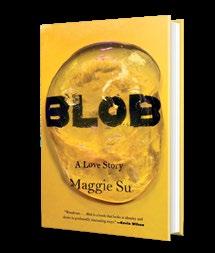
FROM THE EDITOR’S DESK
HUMOR GETS NO RESPECT.
Funny novels aren’t easy to write— you try keeping the jokes coming for a few hundred pages—but when they succeed, they give readers unrivaled delight. Occasionally, awards juries surprise everybody and reward such books: Paul Beatty’s provocative satire about race in America, The Sellout, won the National Book Critics Circle Award for Fiction 2016, and in 2018, Andrew Sean Greer took home a Pulitzer Prize for Less, about a midlist gay novelist having a midlife crisis. More often these books are championed by booksellers and book clubs, passed from hand to hand by passionate readers in the know.
Gary Shteyngart, who appears on the cover of this issue, has been writing funny novels (and one uproarious
memoir) since The Russian Debutante’s Handbook in 2001. His latest is Vera, or Faith (Random House, July 8), narrated by a precocious 10-year-old whose observations of the dysfunctional adult world around her are both comic and touching. Shteyngart’s best-known novel, Super Sad True Love Story (2010), took home the Bollinger Everyman Wodehouse Prize, a U.K. award given to a book that’s “captured the comic spirit of P.G. Wodehouse.” In that madcap vein, the winner receives a jeroboam of champagne, a set of books by Wodehouse, and a Gloucestershire Old Spot pig named for the winning book. Just Google “Gary Shteyngart pig.”
Six of Shteyngart’s seven books to date have received Kirkus stars (pigs not
Frequently Asked Questions: www.kirkusreviews.com/about/faq
Fully Booked Podcast: www.kirkusreviews.com/podcast/
Advertising Opportunities: www.kirkusreviews.com/book-marketing
Submission Guidelines: www.kirkusreviews.com/about/publisher-submission-guidelines
Subscriptions: www.kirkusreviews.com/magazine/subscription
Newsletters: www.kirkusreviews.com
For customer service or subscription questions, please call 1-800-316-9361
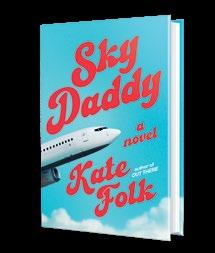
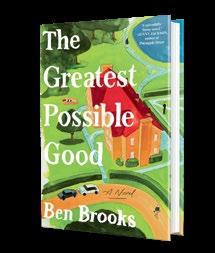
included)—a pretty good track record. On page 16, he reflects on his career with contributor Marion Winik and teases some upcoming projects. Until his next book comes along, here are some recent comic novels that will keep readers laughing.
Blob: A Love Story by Maggie Su (Harper/ HarperCollins, January 28): The premise of this debut novel tells you all you need to know: A college dropout on the rebound from a failed relationship finds a pile of goop in the alley behind a bar, brings it home to her apartment, and discovers that it’s sentient. Why can’t it be molded into the perfect boyfriend? Our reviewer calls it a “funny, tender, unexpected— though somewhat flimsy—bildungsroman.”
Sky Daddy by Kate Folk (Random House, April 8): If romance with a sentient blob isn’t bizarre enough for you, the narrator of this first novel (“Call me Linda,” she begins) loves airplanes. I mean really loves airplanes—longing for “whichever plane would
finally recognize my worth and claim me as his bride in orgasmic catastrophe”— what regular folks “‘vulgarly’ refer to as a ‘plane crash.’” Our starred review calls it an “utterly confident and endearing portrait of a woman unlike anyone readers have met before.”
The Greatest Possible Good by Ben Brooks (Avid Reader Press, July 15): As this dryly funny novel opens, the lives of the Candlewicks are about to go pear-shaped. A package addressed to 15-year-old Emil is discovered to contain LSD and MMDA, while 17-year-old Evangeline, deep in a book about “effective altruism,” finds her well-off parents falling short. Then dad Arthur imbibes the drugs, reads the book, and decides to give away their fortune—much to the dismay of all concerned. “The pleasures of this novel’s writing, characters, and plot are fully equal to its good intentions,” according to our starred review.



ISBN: XXX-X-XX-XXXXXX-X

Co-Chairman
HERBERT SIMON
Publisher & CEO
MEG LABORDE KUEHN mkuehn@kirkus.com
Chief Marketing Officer
SARAH KALINA skalina@kirkus.com
Publisher Advertising & Promotions
RACHEL WEASE rwease@kirkus.com
Indie Advertising & Promotions
AMY BAIRD abaird@kirkus.com
Author Consultant
KEELIN FERDINANDSEN kferdinandsen@kirkus.com
Lead Designer KY NOVAK knovak@kirkus.com
Magazine Compositor
NIKKI RICHARDSON nrichardson@kirkus.com
Director of Kirkus Editorial ROBIN O’DELL rodell@kirkus.com
Kirkus Editorial Senior Production Editor
MARINNA CASTILLEJA mcastilleja@kirkus.com
Kirkus Editorial Production Editor
ASHLEY LITTLE alittle@kirkus.com
Copy Editors
ELIZABETH J. ASBORNO
LORENA CAMPES
NANCY MANDEL
BILL SIEVER
Mysteries Editor
THOMAS LEITCH
Co-Chairman
MARC WINKELMAN
Editor-in-Chief TOM BEER tbeer@kirkus.com
President of Kirkus Indie
CHAYA SCHECHNER cschechner@kirkus.com
Fiction Editor
LAURIE MUCHNICK lmuchnick@kirkus.com
Nonfiction Editor
JOHN McMURTRIE jmcmurtrie@kirkus.com
Young Readers’ Editor
LAURA SIMEON lsimeon@kirkus.com
Young Readers’ Editor
MAHNAZ DAR mdar@kirkus.com
Editor at Large
MEGAN LABRISE mlabrise@kirkus.com
Senior Indie Editor
DAVID RAPP drapp@kirkus.com
Indie Editor
ARTHUR SMITH asmith@kirkus.com
Senior Editorial Assistant
NINA PALATTELLA npalattella@kirkus.com
Senior Indie Editorial Assistant
DAN NOLAN dnolan@kirkus.com
Indie Editorial Assistant
KATARINA YERGER kyerger@kirkus.com
Contributing Writers
GREGORY McNAMEE
MICHAEL SCHAUB

Contributors
Nada Abdelrahim, Colleen Abel, Jill Adams, Mahasin Aleem, Reina Luz Alegre, Jeffrey Alford, Autumn Allen, Paul Allen, Jenny Arch, Kent Armstrong, Mark Athitakis, Kit Ballenger, Audrey Barbakoff, Carole Bell, Nell Beram, Elizabeth Bird, Ariel Birdoff, Christopher A. Biss-Brown, Elissa Bongiorno, Sally Brander, Jessica Hoptay Brown, Kevin Canfield, Tobias Carroll, Sonia Charales, Alec B. Chunn, Amanda Chuong, Adeisa Cooper, Jeannie Coutant, Kim Dare, Michael Deagler, Cathy DeCampli, Dave DeChristopher, Elise DeGuiseppi, Suji DeHart, Lisa Dennis, Amanda Diehl, Anna Drake, Robert Duxbury, Jacob Edwards, Gina Elbert, Elaine Elinson, Lisa Elliott, Lily Emerick, Chelsea Ennen, Brooke Faulkner, Eiyana Favers, Rodney Fierce, Katie Flanagan, Catherine Foster, Cynthia Fox, Mia Franz, Ayn Reyes Frazee, Jenna Friebel, Jackie Friedland, Roberto Friedman, Omar Gallaga, Jackie Garcia, Laurel Gardner, Cierra Gathers, Sydney Geyer, Chloé Harper Gold, Carol Goldman, Emily A. Gordon, Michael Griffith, Vicky Gudelot, Sean Hammer, Peter Heck, Ralph Heibutzki, Mara Henderson, Shannan Hicks, Loren Hinton, Zoe Holland, Natalia Holtzman, Abigail Hsu, Kathleen T. Isaacs, Darlene Ivy, Matt Jakubowski, Jayashree Kamblé, Deborah Kaplan, Marcelle Karp, Lavanya Karthik, Ivan Kenneally, Colleen King, Katherine King, Priti Krishtel, Susan Kusel, Christopher Lassen, Tom Lavoie, Judith Leitch, Seth Lerer, Elsbeth Lindner, Corrie Locke-Hardy, Barbara London, Patricia Lothrop, Sawyer Lovett, Georgia Lowe, Wendy Lukehart, Michael Magras, Joan Malewitz, Mitu Malhotra, Thomas Maluck, Michelle H Martin, Gabriela Martins, J. Alejandro Mazariegos, Zoe McLaughlin, Don McLeese, Cari Meister, Carol Memmott, Clayton Moore, Andrea Moran, Gary Moskowitz, Molly Muldoon, Liza Nelson, Randall Nichols, Dan Nolan, Tori Ann Ogawa, Hannah Onstad, Mike Oppenheim, Nick Owchar, Emilia Packard, Andrea Page, Nina Palattella, Hal Patnott, Bethanne Patrick, Deb Paulson, Tara Peck, Alea Perez, John Edward Peters, Jim Piechota, Christofer Pierson, Shira Pilarski, Cathy Poland, Margaret Quamme, Carolyn Quimby, Kristy Raffensberger, Matt Rauscher, , Stephanie Reents, Sarah Rettger, Nancy Thalia Reynolds, Jasmine Riel, Amy Robinson, Lizzie Rogers, Soumi Roy, Lloyd Sachs, Bob Sanchez, Julia Sangha, Caitlin Savage, Gretchen Schulz, Jerome Shea, Madeline Shellhouse, Linda Simon, Laurie Skinner, Leena Soman, Margot E. Spangenberg, Andria Spencer, Allison Staley, Daneet Steffens, Mathangi Subramanian, Deborah Taylor, Ella Teevan, Lenora Todaro, David L. Ulin, Bijal Vachharajani, Francesca Vultaggio, Audrey Weinbrecht, Kimberly Whitmer, Wilda Williams, Vanessa Willoughby, John Wilwol, Marion Winik, Adam Winograd, Jean-Louise Zancanella

WITH SUMMER REACHING its peak, maybe what you need is a short book— something you can read in a weekend or even a long, languorous day—to give you a feeling of accomplishment. A sense of humor would help, too. Here are a few suggestions.
Bring the House Down by Charlotte Runcie (Doubleday, July 8): Set in Edinburgh during the annual arts festival, Runcie’s novel centers on a negative review—so maybe I’m the target audience? When Alex Lyons writes a scathing takedown of a one-woman show, he doesn’t think twice about sleeping with the performer, whom he meets in a bar later that night. Of course,
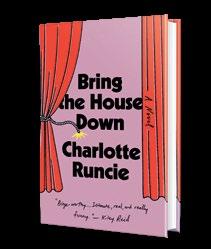
she hasn’t read the review yet, and once she does, she’ll rename her show The Alex Lyons Experience and devote herself to taking him down. But there’s much more to the book than that, and “the clarity of Runcie’s narration and her ability to consider both sides of an argument…[make] for an unusual, thought-provoking, multilayered read.”
Vera, or Faith by Gary Shteyngart (Random House, July 8): Vera Bradford- Shmulkin is an intensely smart 10-year-old with a Russian Jewish immigrant father, a New England WASP stepmother, a long-gone Korean mother, and an anxious need to hold her family together. The book is set in a
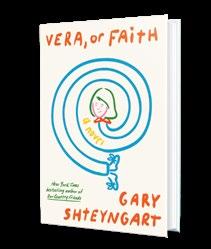
near-future where a proposed constitutional amendment would give an “enhanced vote” to “those who landed on the shores of our continent before or during the Revolutionary War but were exceptional enough not to arrive in chains.” Our starred review says that “Shteyngart is doing his most important work ever, illuminating the current tragedy with humor, smarts, and heart.” (Read our interview with the author on p. 16.)
Maggie; or, a Man and a Woman Walk Into a Bar, by Katie Yee (Summit, July 22): The narrator and her husband have two young children, so she’s excited when he suggests they get a babysitter and go out for dinner at an all-you-can-eat Indian buffet. But then he tells her he’s having an affair, and a few days later,
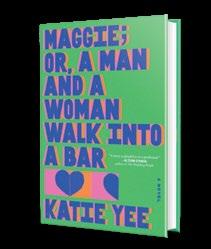

she’s diagnosed with breast cancer. In between she tries to console herself by listing everything she finds annoying about her husband (“If he’s not in his work button-downs, he’s always wearing his Ivy League college sweatshirt”) and trying to make her kids think she’s funnier than he is. “The comedy here is never dark or desperate or manic,” our starred review says. “Instead, the narrator’s dignity and strength make this a novel that crackles with heartfelt intelligence and wit.”
An Oral History of Atlantis by Ed Park (Random House, July 29): This collection of short stories by Pulitzer finalist Park plays literary games with password prompts (“First time you had sex and did it count”), DVD bonus commentary, and other minutiae of contemporary life. “But Park isn’t just playing with unusual premises for their own sake,” according to our review.
“He’s looking for the ways that human idiosyncrasies manage to poke up to the surface even while technology tries to keep us tidy and algorithm friendly….A collection that revels in its quirks, smart and sensitive in equal measure.”
Laurie Muchnick is the fiction editor.
Two young Indian writers discover their conjoined destinies by leaving home, coming back, connecting, disconnecting, and swimming in the ocean at Goa. Sonia’s grandfather, the lawyer, and his friend, the Colonel, are connected by a weekly chess game and a local tradition of families sharing food, “paraded through the neighborhood in tiffin carriers, in thermos flasks, upon plates covered in napkins tied in rabbit ears.” Shortly after Desai’s magnificent third novel opens, the two families are also connected by a marriage proposal. Upon hearing that Sonia is feeling lonely at college in Vermont— loneliness? Is there anything more un-Indian?—and unaware that she is romantically involved with a much older, very famous painter, her elders deliver a hilariously
lukewarm letter proposing that she be introduced to Sonny, the Colonel’s grandson. Sonny is living in New York working as a copy editor at The Associated Press, and he, too, has a partner no one knows about. Sonny’s family feels they are being asked to give up their son to balance out some long-ago bad investment advice from the Colonel; on the other hand, they would very much like to get the other family’s kebab recipe. The fate of this half-hearted arranged marriage unfurls over many years and almost 700 delicious pages that the author has apparently been working on since the publication of The Inheritance of Loss (2006), which won the Booker Prize and National Book Critics Circle Award. You can almost feel the decades passing as the novel becomes increasingly

concerned with the process of novel-writing; toward the end, Sonia can’t stop thinking about whether, if she writes all the stories she knows, “these stories [would] intersect and make a book? How would they hold together?” Desai’s trust in her own process pays off, as vignettes of just a page or two (Sonia’s headspinning tour of a museum with the great artist; Sonny’s
lightning-strike theory that only people who have cleaned their own toilet can appreciate reading novels) intersect with the novel’s central obsessions—love, family, writing, the role of the U.S. in the Indian imagination, the dangers faced by a woman on her own—and come to a perfectly satisfying close. A masterpiece.
Residents of a dingy apartment building grapple with the meaning of life.
Ackerman, Elliot | Knopf (304 pp.) $29 | August 5, 2025 | 9780593803851
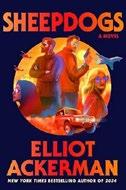
Sheepdogs boost a jet in the service of America’s off-thebooks armies. What’s in a name? asked Shakespeare. Quite a bit, apparently. Take sheepdogs, for example. As a man named Cheese explains to his wife, there are three types of people in the world: sheep, who don’t believe in evil; wolves, who prey upon them, and sheepdogs, who “understand violence, except they use that understanding to protect others.” He’s a sheepdog: an Afghan and a skilled pilot who works for a shadowy organization known as the Office and hopes to settle with his pregnant wife in America. He partners with Skwerl, an ex-Marine whose name would be Squirrel except that “Marines can’t spell for shit.” Nicknames are all assigned to them, and their real names don’t much matter anyway. The capital S Sheepdog hires them to go to Uganda and repossess—or steal, depending on one’s viewpoint—a Challenger 600 luxury jet and fly it to Marseille in exchange for a $1 million commission. Strangely, the main characters don’t know Sheepdog’s identity. Plenty of action ensues, of course, but the story is more caper than thriller, and protecting innocent lambs hardly seems the main thrust here. Don’t expect lots of gore or high body counts, even though the Russia-Ukraine war lurks in the background. A grizzly bear, a dominatrix named Mistress S, and a set of
plates commissioned by Marie Antoinette keep the tone relatively light. Those fancy plates might be worth more than the plane even after they’ve broken a few, but not everyone is motivated by money. All Cheese really wants is not to have to work at the Esso station anymore. All that Ali Safi wants is to find the man responsible for his brother’s death. There are vivid images: “Just Shane” comes out of a shower wearing just a towel and a ski mask; Mistress S has tattoos on her wrist that record— ahem— how far she’s gone with clients. Author Ackerman is a skilled storyteller, weaving an unlikely set of details and making them look like they belong together. Compare this to the deadly serious 2034, which he co-authored with Admiral James Stavridis in 2021. A fun read, loony in spots.
Kirkus Star
Adrian, Emily | Little, Brown (224 pp.) $28 | August 12, 2025 | 9780316584517
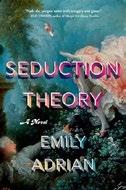
A pretentious academic couple engenders the wrath of a jealous grad student at an elite college in upstate New York. This terrifically inventive matryoshka doll of a novel opens with a title page indicating we are reading the thesis project of Roberta Green, MFA candidate. Yet the narrative blending that follows is so layered that even by the end it begs an unraveling of which fiction is which. The outline is simple: Simone is an
anomaly—a glamorous academic—and happily married to Ethan, a fellow English professor. Though Ethan worships his wife, he has a fling with the rumpled Abigail, the department’s secretary. Meanwhile, Simone is having an emotional entanglement with grad student Roberta. As her advisor, Simone should be guiding Roberta on this MFA project we are reading, but instead they are training for a marathon and wandering around Simone and Ethan’s house in states of sweaty undress. When Simone discovers Ethan’s affair, the couple embarks on an impromptu cross-country journey. The work has two remarkably distinct registers: It’s a tender portrait of an enviable marriage balanced by a delightfully smarmy tone with laugh-out-loud passages of humor. As Roberta dates a girl on campus while fantasizing about Simone and the revenge she will be taking in the form of this novel, Ethan and Simone are left wondering what their marriage means. But what is the truth? A novel that makes authorial control so visible— Roberta’s comically biased character portraits; the midpage shifting between third- and first-person narration; the conclusion rewritten to first reflect Roberta’s fantasy and then the “reality”—could have left the whole enterprise as simply a jewel to be admired. Happily, it is all much more than a Borgesian experiment: It is a finely observed work on love. A masterful exploration on the varieties of truth, and the stories we craft about ourselves.
Aeschbacher, Tobias | Trans. by Andrew Shields | Helvetiq (128 pp.) | $24.95 June 3, 2025 | 9783039640874
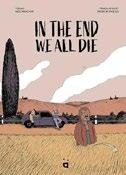
Residents of a dingy apartment building grapple with the meaning of life as violence unfolds in this pulpy noir tale. A family urn is stolen and three armed gangsters set off to retrieve it.
They trace the urn back to two thieves who live in a three-story, six-unit apartment building in a small town, but complications quickly arise, and what could have been a simple task quickly spirals out of control. As they drive into town, the three armed men should be organizing their strategy, going over their plan to get the urn back. But instead they argue about trivial things: Why would you name your gun after your first girlfriend? Why does the youngest of the three always have to sit in the back seat like a child? Violence is coming, but they’re blissfully distracted by completely irrelevant side topics. The distractions continue as they enter the building. Each resident they encounter steers them away from their task by posing simple yet existential questions like: What is good and what is evil? When bad decisions are made, who deserves to die? When is it okay to end a life? What does it mean to be a good neighbor? As the gangsters and tenants debate these issues, bullets quickly start to fly and the blood flows. Everyone in the apartment building finds themselves on one end of a gun barrel. And before the triggers get pulled, each person reckons with essential notions of fairness, righteousness, and loneliness. Aeschbacher draws the story like a modern-day Adventures of Tintin, with scrappy, hand-drawn lines; subdued shades of mahogany and aubergine maintain the deadpan gloom of the tale. He takes a Richard Scarry approach to detail: His sketches of the apartment building include small elements of ceilings and furniture that fill each panel. There are no new beginnings for the people in the apartment building. Death—and perhaps a brief moment of enlightenment—beckons for them all.
A comic—and esoteric—gangster story, full of bad choices and inevitable violence.

Appelbaum, Lauren | Forever (352 pp.) | $17.99 paper September 16, 2025 | 9781538757864

An unexpected inheritance invites a reluctant heroine to step out of her shell. At her grandmother Lottie’s funeral, sad and sticky in the Florida heat, Mallory Rosen can’t wait to get back to her comfortable and very routine life in Seattle. But shortly after she returns, she learns that Lottie willed Mallory a house in Reina Beach along with a request to look after Gramps, now alone in an independent living community. Mallory is avoidant and at first tries to handle property ownership and grandparent connection long distance, but a friend talks sense into her, convincing her to appear in person. A few days turns into a week, then longer, as she builds a sweet relationship with the delightful and believable Gramps and a potentially steamy one with her property manager, Daniel. Given how small she has kept herself and her life in Seattle, Mallory is surprisingly game to meet new people and try new things—shuffleboard, kayaking, an exercise class with the retirees that is quite funny. She even, after a bit of resistance, proves a dab hand at home improvement. So it’s slightly mystifying why she seems so dedicated to returning to the Pacific Northwest. Nonetheless, the slow burn of her falling for Daniel as well as Florida is full of lush and lovely scenes, and
Mallory is a pleasurable narrator who readers will root for.
Like a good soak in a hot tub near the beach.
Kirkus Star
Banville, John | Knopf (320 pp.) | $30 October 7, 2025 | 9780593801161

A trip to Venice takes a dark turn for a British writer and his American wife. Evelyn Dolman introduces himself to the readers of Banville’s latest, set in the late Victorian era, as “a man of letters,” initially hoping for a career that will cement him as “a lord of language,” regarded more highly than Tolstoy and Shakespeare. Alas, the Briton has become a mere “Grub Street hack,” with one bright spot in his life: He has recently married Laura Rensselaer, the daughter of an American oil magnate who has hired Evelyn to write his biography. After Laura’s father dies in a riding accident, Evelyn learns that she was disinherited, and he and his bride go to Venice so that she might recover from her loss. Shortly after arriving at an apartment in the city, Evelyn, at Laura’s suggestion, pays a visit to a cafe, where he runs into a man named Freddie, who claims to have been a schoolmate of Evelyn’s. Evelyn is skeptical, but his doubts are cast aside when he meets Freddie’s beautiful sister, Francesca, with whom he is instantly taken. Evelyn returns to the apartment, drunk, and sexually assaults his wife;
An inheritance invites a reluctant heroine to step out of her shell. AN INTROVERT’S GUIDE TO LIFE AND LOVE
the two had seldom been intimate before, and Evelyn regards the attack as an act of revenge. The next morning, Laura is gone, and Evelyn suspects he’s either losing his mind or the victim of a mysterious scam: “Everything was a puzzle, everything a trap set to mystify and hinder me.” Banville once again proves himself a master of suspense, and he captures a noir version of Venice perfectly. Evelyn is a fascinating character: monstrous, certainly, but is he really being manipulated? Is he manipulating the reader? It’s an open question, and a testament to Banville’s considerable skill as a storyteller. Dark, twisty, and consistently smart: vintage Banville.
Bowen, Rhys | Lake Union Publishing (399 pp.)
$28.99 | August 5, 2025 | 9781662527180

As the winds of war blow over Europe, an English woman embarks on a nostalgic trip to the French Riviera.
Ellie Endicott, who has two grown sons she rarely sees, has spent her entire married life catering to the needs of her husband, a pompous banker. So she’s flabbergasted when Lionel tells her he wants a divorce. Now that he’s met a younger woman he wants to marry, he thinks he can bulldoze Ellie into a settlement favorable to him. Standing up for herself, she obtains a fair settlement, plans a trip to France, and encourages Mavis Moss, the cleaning lady whose husband beats her, to come along. They’re joined by Miss Smith-Humphries, a pillar of the community, who’s dying and wants to revisit the happy places of her youth. Taking Lionel’s Bentley, they set off for France. Ellie’s fluent French proves especially useful when, while stopping for gas, they rescue Yvette, a pregnant girl who claims she’s being kidnapped. Forced to stop in the tiny seaside village of Saint-Benet when the Bentley
develops problems, they stay at Pension Victoria, which is owned by an English couple. They’re aided by handyman Louis and Nico, a mysterious, roughly attractive fisherman, and welcomed by other villagers and a resident gay English couple. Ellie is so intrigued by the shabby, mysterious Villa Gloriosa that she asks the owner to rent it to her. After much work, they’re ready to move in. When Yvette leaves with her baby, she takes some of their jewelry. In general, though, they enjoy several halcyon years until eventually the Nazis descend on the village. Can they survive and keep the dangerous secrets threatening members of the community hidden? A delightful story of a heroine whose inner strength triumphs over adversity.
Boyne, John | Henry Holt (496 pp.) | $29.99 September 9, 2025 | 9781250410368

Boyne’s ambitious novel powerfully explores the devastation of sexual abuse from four different perspectives.
“The elements— water, earth, fire, air—are our greatest friends, our animators. They feed us, warm us, give us life, and yet conspire to kill us at every juncture,” says Vanessa Carvin, who has fled to a remote island off the west coast of Ireland in the wake of a sex abuse scandal that led to her husband’s imprisonment, her alienation from her daughter, and public condemnation. Troubled Evan Keough, with his mother’s help, escapes this same island in the hopes of making a new life as a painter in England but instead finds himself on trial as an accomplice in the rape of a young woman. A juror on that trial, Dr. Freya Petrus, is a successful burn surgeon who deals with her childhood trauma by inflicting her pain on new victims. And her former resident–turned–child psychologist, Aaron Umber, seeks to heal his own damaged psyche by embarking on a life-changing journey back to Ireland
with his teenage son. Originally published in the U.K. as separate novellas (Water, Earth, Fire, Air), these four interconnected stories pack a wallop when combined in one volume. If the format at times feels too tidy and contrived (especially in the final section), it doesn’t lessen the emotional impact of deeply wounded characters struggling to overcome their guilt and find redemption in the wake of catastrophic trauma. Book clubs will find plenty to discuss in this meaty and challenging read.
Chaon, Dan | Henry Holt (288 pp.) | $28.99 September 23, 2025 | 9781250175236
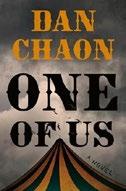
Twin siblings run off to join the circus, which proves to be a dark carnival indeed. Bolt and Eleanor, the teenage twins at the center of Chaon’s brilliant fifth novel, are orphans who’ve fallen under the watch of “Uncle Charlie,” a con man and serial killer. They escape Charlie’s clutches with the assistance of a mysterious Mr. Jengling, who operates a circus and recruits them for his sideshow—which includes a strongwoman, dog-faced boy, and, most creepily, Rosalie, a woman with a second head growing out of the side of her neck and who can predict how and when you will die. For all that darkness, the brother and sister find a welcoming ersatz family; interstitial chapters explore the background of each performer and the unique talents Jengling detected in them. (Bolt and Eleanor’s own talents—telepathy and telekinesis—are only just emerging.) Chaon is focused on how we find our identities outside the ones the world wants to apply to us; as the title suggests, Chaon takes inspiration from Tod Browning’s 1932 film, Freaks, in which the sideshow performers chant
“one of us” as a sign of acceptance. Meanwhile, Chaon has also delivered a sharp thriller, as Uncle Charlie attempts to chase down the twins, leaving a bloody path along the way. Set mainly in 1915, the novel captures a vanished vaudeville world that Chaon resurrects in thoughtful detail, down to the era’s slang (ziggety, conflustered, woofits). But in its latter chapters, the novel is also powerfully otherworldly, deliberately warping assumptions about life, death, and the nature of souls. Bolt and Eleanor take divergent paths once they’ve joined the circus, but Chaon suggests that any path rooted in consideration of others is a valid one. A magic trick: a novel that’s both deeply unsettling and tenderhearted.
Kirkus Star
Chou, Elaine Hsieh | Penguin Press (352 pp.) $29 | August 19, 2025 | 9780593298381

A clutch of stories that starkly question assumptions about our identities.
Chou’s debut collection—following the novel Disorientation (2022)—is built on premises where characters’ sense of self is rattled. In “Carrot Legs,” a young woman discovers that her family tree doesn’t branch in ways she was raised to believe. In “Featured Background,” a man is determined to connect with his estranged daughter, an acclaimed movie director, by taking on an actor’s persona. “Happy Endings” imagines a future where sex work is outsourced to technology, with hellish consequences for one john. Chou is gifted at storytelling with a surrealistic bent: “The Dollhouse” plays with Barbie tropes, zooming into the plastic world of toys and back out into reality to expose how women are objectified, while “You Put a Rabbit on Me” is a variation on a doppelgänger story, as a
A magic trick: a novel that’s both deeply unsettling and tenderhearted.
ONE
US
young woman in France working as an au pair meets a woman bearing an unsettling resemblance to her. Chou can play these premises for laughs: “Mail Order Love®” turns on a man who’s disappointed with the purchase of the title. Is his new wife glitching, or just in possession of an independent mind, and how has technology fuzzed the line between the two? The closing novella, “Casualties of Art,” at first seems straightforward, almost blandly conventional—its setup involves four artists at a retreat and their flirtatious hothouse relationships. But Chou uses her lead character to play with the meaning of autofiction and the way we rewrite history to serve our most self-flattering images. The collection’s title is a classic microaggression—a way to box people as foreign or other. Nobody in the book actually utters the question, but throughout Chou cleverly exposes just how difficult humanity is to simplify, whatever our provenance. Sharp storytelling that bends and blurs genre expectations.
Church, Wendy | Severn House (256 pp.)
$29.99 | August 5, 2025 | 9781448315659

Murder is the least of the disruptions in Jesse O’Hara’s latest barnstormer. Giving a presentation at the International Conference on Law Enforcement and Investigation isn’t a first choice for Jesse, a forensic accountant with a “million-dollar brain and ten-cent personality.” But the scenic
location is certainly an enticement. So is her growing certainty that her mortal enemy Svetlana Ivashchenko, the ruthless head of Rusgaprom, knows that she’s been staying with her best friend, Salbatore “Sam” Hernandez, and could strike at any moment. So Jesse, Sam, and their partner, computer nerd Gideon Spielberg, take off for Greece, where they’re recruited by Eleftherios Karadimitropoulos, head of Special Projects for the Ministry of Citizen Protection, for a routine job that quickly morphs into another job, then another and another. The escalating stakes will draw Jesse—or Dr. O’Hara, as she’s constantly introducing herself—into an uncomfortably extended face-off with Platon, head of the antigovernment group the Megali Titans, who whisks Gideon away, summons Jesse and Sam to his hushhush retreat, and suavely forces them to break his valued associate Apollo out of a Turkish prison. The biggest treat here is Jesse’s yadda-yadda first-person voice as she reacts with impatience and annoyance but never fear to the bombing of her hotel, the improbable plot to rescue Apollo, the ritualistic juggling of allegiances, and the repeated return from the shadows of Svetlana and Jesse’s own father, whom she’s tuned out ever since his drunk driving killed her mother. So there’s no downtime, just one jolt after another, including a couple of murders, until readers are likely to feel just as overstimulated as the heroine. Part battle to the death, part tour guide.

A contemplative study of colonialism’s collapse, and its enduring legacy.
THE CARTOGRAPHER OF ABSENCES
Cook, Jeannine A. | Amistad/ HarperCollins (256 pp.) | $25
September 23, 2025 | 9780063430952
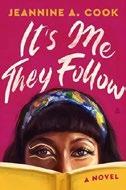
In this bildungsroman of middle age, an aspiring bookseller wrestles her fears for love and professional fulfillment. The aspiring Philadelphia bookstore proprietor at the center of this dreamily lyrical debut struggles with a phobia of touch that has long stymied her deepest desires. As the 40-year-old heroine—known only as “The Shopkeeper” for most of the novel—confesses to her writing-group classmates, she has never been kissed. And she’d like to change that. But more pressingly, the Shopkeeper—like the author, who is the proprietor of the real Harriett’s Bookshop in Philadelphia—is on the verge of fulfilling a lifelong dream of opening a bookstore named after her guide and inspiration, the legendary abolitionist and freedom fighter Harriet Tubman. But a shopkeeper who can’t come near her customers for fear of passing out is at a disadvantage. Since childhood, the Shopkeeper’s condition—haphephobia—has been so severe that a simple touch can cause her to feel a shock of electricity and lose consciousness. So she’s lived in her head, taking refuge in books—so much so that at times it’s hard for her (and for the reader) to distinguish what’s really happening from imagination. Now though, on the cusp of a new year, the Shopkeeper is determined; she has “declared this her year to conquer fear” and finally
open the doors of the store. Joining that purposeful writing group “designed to help slowly bring trauma to the surface in a controlled manner” is part of the plan. Falling for a mysterious bearded man who says he, too, can’t be touched because he’s in training to be a monk is not. But he keeps popping up like magic. With his help and that of family and friends, change is finally within reach. Romance is only part of the payoff in this quirky yet humane story of a lonely shopkeeper conquering her fears.
Cosby, S.A. | Flatiron Books (352 pp.) $25.99 | June 10, 2025 | 9781250832061
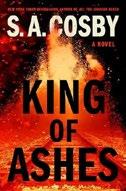
Deadly trouble awaits Roman Carruthers in his corrupt hometown when the Black wealth management whiz attempts to outwit a murderous drug gang threatening his family.
The Atlanta-based Roman’s weakwilled, strung out younger brother, Dante, and an ill-fated crony have incurred a sizable drug debt by consuming rather than dealing most of the Molly and heroin they obtained from the notorious Black Baron Boys. Led by the ruthless Torrent and his cooler-tempered sibling, Tranquil, the BBB have expressed their displeasure with Dante by running his father, founder of a family-run crematorium, off the road, leaving him in a coma. Having never encountered a situation he couldn’t wheel and deal his
way out of, the self-regarding Roman offers to cover the debt and much more by reinvesting the BBB’s money. Their immediate answer is to knock his teeth out. But with visions of using the crematorium (Dante’s inferno?) to burn up their victims, they go along with him—to a point. Roman, like his brother and sister, Neveah, is haunted by the disappearance of their mother when they were teens. To expiate his pain, he visits a dominatrix while Neveah—who increasingly believes rumors that her jealous father did her mother in—sleeps with a crooked cop. In making the transition from slick operator to coldblooded instigator of violence himself, Roman becomes the latest in a long line of fictional Southerners to strike a deal with the devil (as in the film Sinners, fire plays a big role). The plot sometimes wobbles—Roman pursues an unlikely romance with Torrent’s smart and warmly appealing half sister. But Cosby keeps things tense, making great use of the crematorium and freshening the genre with lofty philosophizing: “To Roman, it felt like life, existence, was a stygian wheel that had spun on a bitter axis.” Rarely has a crime fiction family been given a more bitter spin than this one.
Another strong outing by a modern noir master.
Couto, Mia | Trans. by David Brookshaw Farrar, Straus and Giroux (320 pp.) | $14.99 paper | September 30, 2025 | 9780374616311

A writer returns to his native Mozambique to reckon with his father’s history there.
The latest novel by veteran Mozambican author Couto is inspired by his own father, a journalist and poet who witnessed the abuses of Portugal’s colonial regime before the country gained independence in 1975. Here, the lead narrator is Diogo, who in 2019 is visiting the country as an honored poet.
The host, Liana, takes the opportunity to share with him a cache of files belonging to her grandfather Óscar, an agent of the colonial state police. Óscar detailed Diogo’s father, Adriano, under the pretext of collaborating with the anticolonial movement. But the story Couto unspools is more complicated than trumped-up accusations of plotting against the state. It is a story of racist state violence, centered on the 1973 massacre of Blacks in the town of Inhaminga by security forces. It is a story of the event’s consequences, particularly the death of Liana’s mother, alternately deemed a murder or suicide. It’s a story of Diogo sorting through the complexities of his father’s history, from poorly disclosed infidelities to attempts to counter the racist colonial forces. And as Liana and Diogo find their own relationship deepening, it’s an exploration of the possibilities for reconciliation. Couto’s narrative alternates between scenes in 2019, as Diogo revisits locations of his family’s past, and documents from Óscar’s archives that slowly reveal the truth about Inhaminga, Liana’s background, and his own conflicted feelings about state power. The formality of the documentation gives the novel a certain stiffness, and an approaching cyclone is a heavy-handed metaphor. But Couto’s storytelling is rich, while delivering a straightforward message: “When a regime starts arresting poets it is because that regime has lost its way.”
A contemplative study of colonialism’s collapse, and its enduring legacy.
Cranor, Eli | Soho Crime (384 pp.) | $29.95 August 5, 2025 | 9781641296977

freshman who’s backing up Matt Talley, a white star thrust to nationwide prominence by his success last season. So it’s not very likely that Moses will see much playing time—at least until Matt, fresh from his team’s latest victory, takes a header from a rooftop that ends his career, his life, and, thanks to the bag of money scattered around him, maybe his reputation. Mississippi state congressman Harry Christmas, whose years-long scheme to revitalize the region and incidentally enrich himself by paying to recruit and control top talent on the field, is furious that a distracted Matt didn’t throw the game, as Harry’s bagman, Eddie Pride Junior, had ordered him. But not so furious that he can’t turn on a dime and tender a similar deal to Moses. When the kid turns down the money, Harry threatens to call in Eddie’s crippling debts unless he persuades his daughter Ella May, who was with Matt on that roof moments before his hard landing, to offer herself to Moses, who’d resigned himself to losing that competition to Matt, too. Meanwhile, computer expert Rae Johnson, a rookie FBI agent whose father was a legendary football coach, is determined to look more closely into the star quarterback’s death, even though her much older partner, Frank Ranchino, keeps reminding her that their job description includes financial crimes, not murder. Cranor expertly keeps the pot simmering until a pervasive stench settles over virtually all parties. A powerful case for the proposition that “college football wasn’t a game at all; it was a business.”
Dang, Catherine | Simon & Schuster (288 pp.) $27.99 | August 12, 2025 | 9781668065570
Now that college athletes are finally getting paid, Cranor takes a deep dive into the days when they weren’t.
The University of Central Mississippi Chiefs quarterback Moses McCloud is a Black
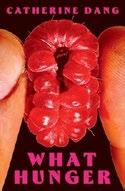
An act of violence leaves a teenage girl hungry for more than revenge. Veronica “Ronny” Nguyen and her brother, Tommy—the family’s golden child—are embarking on what Tommy calls
“The Big Summer” as they get ready to enter high school and college, respectively. Americanized children of Vietnamese refugees, the siblings are pushing boundaries with their parents, M ẹ and Ba. When Tommy is killed in a car accident, the family is devastated and the gulfs among them—already filled with secrets and silences—begin to widen. When Ba’s brash and distant sister, Cô Mỹ, comes to stay, she brings with her stories from M ẹ and Ba’s past, as well as urban legends from Vietnam. While navigating unimaginable loss, Ronny tries her best to be a normal teenager by excitedly and nervously attending her first high school party. Unfortunately, this rite of passage turns into a nightmare when a classmate sexually assaults her—and something that had been dormant inside her awakens. As rumors swirl at school about Ronny, she finds it harder and harder to tamp down her rage and insatiable hunger for vengeance…and the sharp, salty, metallic taste of raw meat. As secrets about her parents and Tommy come to the surface, Ronny has to grapple with the realization that she has never seen the fullness of their lives: “I could only see them as what they showed me.” When Ronny embarks on her final act of revenge, she unexpectedly sets off a chain of events that brings her closer to her mother than she ever imagined. To move forward, they must do something they’ve never done before: unbury the past. Bound together with new understanding and tenderness, their relationship is forever changed. Balancing vulnerability, rage, horror, and compassion, the novel explores identity as both a blessing and curse. Brutal and poignant; Dang writes beautifully about the complexity of adolescence and generational trauma.

Dunic, Nina | Invisible Publishing (240 pp.) $17.95 paper | September 9, 2025
9781778430695

The second book by Canadian author Dunic is a story collection centered on people who get tripped up while just trying to go about their lives.
Dunic’s characters are all different sorts, at all different stages of life, dealing with tragedies, indignities, and other wild cards that cause them to lose their footing. In “The Apartment,” the persistent seen-through-the-window nudity of a woman living in the apartment across the street alters the relationship of the narrator and his platonic male roommate. In “Bodies,” a boy becomes something of a celebrity at his school after he discovers a dead body in a neighborhood park. In “Divorce”— with its ending worthy of O. Henry, it’s one of the collection’s standouts—a cash-strapped young couple’s purchase of a small oil painting has unforeseen significance. Some recurring motifs bring an organic-seeming cohesion to the collection: Several key characters have been on the receiving end of violence. Others have been widowed. Several protagonists are children. Dunic’s people discover that they are at a loss to make human connections or otherwise find meaning; as the subject of one story thinks at one point, “Her predicament now was the life she had left.” A few of the stories don’t completely gel—they seem to end a page too early, or maybe a page too late—but all the pieces are beautifully etched thanks to Dunic’s flair for the power-packed chiseled sentence. As the widow from whose perspective the story “Youth” is told thinks about the teenagers she has taken to observing, “There was something pure about them, like elements…hot and bright or dark and cold, sparking off each other, reactive and explosive.”
These stories give literary realism a good name.
Kirkus Star
Faulkner, Katherine | Scout Press/ Simon & Schuster (384 pp.) | $28.99 August 26, 2025 | 9781668024812
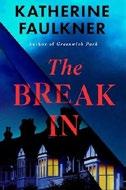
The aftereffects of a break-in chafe on a London mother, leading to her stubborn pursuit of unanswered questions in this hair-raising thriller. When a frightening man breaks into her London kitchen one evening, Alice Rathbone leaps into action. She’s hosting a playdate for her daughter and two other families, and when the intruder grabs a large kitchen knife and moves toward the room with the children in it, Alice goes into serious defense mode, grabbing a stool the man had kicked at her and fatally whacking him on the head. While waiting to hear from the police about whether she’ll be charged or cleared of any wrongdoing, Alice grapples with the randomness of the break-in, wanting to know more about her attacker. By all appearances, he was visibly under the effects of drugs or alcohol—or perhaps both—and had forced his way into a high-value home in a still-gentrifying neighborhood bent on destruction. But Alice can’t shake the desire to find out more about the person she killed, who turns out to be 18-year-old Ezra Jones. When, against her bail conditions, she wends her way into the life of Ezra’s family, things go spectacularly awry, even as Alice fends off anonymous phone calls and bitter, threatening online comments. The people closest to her—her husband, Jamie, a high-powered executive, and fellow school-focused mothers—beg her to move on, though one friend, Stella, a journalist, reluctantly agrees to assist with Alice’s investigation. Small items from Alice’s household go missing, the once-perfect nanny gives notice, and Alice’s life continues to fall apart. Skillfully spinning a taut, surprise-filled tale enlivened by multiple compelling characters, Faulkner keeps this highly
charged guessing game going until the final page.
A psychological thriller rife with pretzel-like twists, gaslighting galore, and revenge-fueled machinations.
Kirino, Natsuo | Trans. by Lisa Hofmann-Kuroda Knopf (352 pp.) | $29 | September 9, 2025 9780307267580
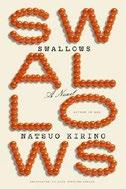
Riki Ōishi still doesn’t know who she is or what she wants to do with her life. Will surrogacy be the answer? Without skills or a degree from a prestigious university, 29-year-old Riki is finding it hard to succeed in Tokyo, although she was keen to move there from her small town in rural Hokkaido. Working as a temp, lonely and broke, she’s living on boiled eggs and marked-down convenience food. So the idea of becoming an egg donor at a fertility clinic has its financial attractions. But Riki bears a close physical resemblance to Yuko Kusaoke, wife of ballet dancer Motoi. Because the couple can’t conceive, Riki is asked to become their surrogate through artificial insemination using her own eggs, in exchange for 10 million yen. Celebrated Japanese author Kirino’s dryly observed novel carefully considers the peculiarity of surrogacy: Is it just business, or exploitative, a transaction that takes advantage of “poor women selling their uteruses”? Over time, the characters all seem in two minds about the arrangement. Since surrogacy is illegal in Japan, Motoi and Yuko must divorce (on paper) and Motoi must marry Riki for the plan to go ahead. On a brief trip home, Riki ends up sleeping with an old lover. Then, back in Tokyo, she sleeps with another friend, so when she becomes pregnant (with twins), doubts arise over paternity. Yuko and Motoi start to grow apart, not least because Yuko has no interest in children that aren’t related to her. Motoi feels compromised about plans to raise infants if they’re not his. Multiple conversations ensue—sometimes
repetitively—about the options and ethics of the situation. Class, morality, obligation, and gender all come up for scrutiny as Kirino moves her figures through further emotional responses once the babies are born. The sifting concludes with Riki, who has matured (and suffered) enough, making a decision for all involved.
A curiously compelling debate about inequality and the complexity of choice.
Kraus, Chris | Scribner (320 pp.) | $29 October 7, 2025 | 9781668098684
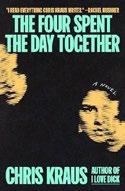
The latest work of autofiction by an iconic Los Angeles writer. Kraus’ first novel in more than a decade meditates on her childhood in 1960s Connecticut and her middle age in LA and northern Minnesota, pinning down, in their contrasts and humming throughlines, “trace elements of a lost Americana.” Kraus records her days at these distinct points in her life, occasionally assuming the points-of-view of those close to her and, in the final portion, strangers. In the first section, “Milford,” Jasper and Emma Greene and their daughters, Catt and Carla, move from the Bronx to Milford, Connecticut, where Emma struggles to connect with her new community and parent Carla, who has a developmental disability, and Jasper works long hours and cultivates Catt’s literary sensibilities. The lens eventually shifts to Catt, the protagonist, as she tumbles into an adolescence of truancy, hitchhiking, and huffing office supplies. “Balsam” picks up four decades later, in Minnesota’s Iron Range. Catt is a well-regarded writer, living in Los Angeles. After a few summers spent in Minnesota, writing and escaping the claustrophobia of the art world, Catt and her partner, Paul Garcia, buy a cottage on a lake in Balsam to live in part-time. The Trump years bring personal as well as
political turmoil, as Catt and Paul face issues in their marriage and Catt confronts a wave of media attention from a new generation when her cult-classic first novel is adapted for TV. Then, in 2019, a shocking, meth-fueled murder near the cottage reels Catt into obsession with the four young people involved. “Harding” alternates between Catt’s life as she reaches for answers to this senseless crime and a fictionalized account of the events leading up to the real-life murder, based on Kraus’ research and interviews with those close to the case. Kraus’ deftness in planting events and swirls of thought in their respective places and times, revealing the rhythms of life with a subtle hand, transforms a series of anecdotes and a true-crime fixation into a stirring narrative of class, addiction, and the question of forgiveness in a cultural landscape increasingly hostile toward empathy and nuance. Kraus’ relentless curiosity is a gravitational force.
Lethem, Jonathan | Ecco/ HarperCollins (400 pp.) | $29.99 September 23, 2025 | 9780063388840
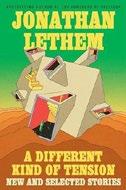
A late-midcareer retrospective, 30 stories spanning 35 years of work by a talented and celebrated writer. New-andselecteds tend to be miscellanies, and that can seem the case here: The stories vary widely
by genre, tone, and length (and to some extent by quality). But “miscellany” implies a catch-as-catch-can looseness that’s absent. These stories show off a versatility that rarely feels like randomness, because no matter where they go, they’re tethered to Lethem’s familiar nexus of themes (failure of connection, rivalry, the threats and depredations of technology, for a few examples) and techniques (mashup, flights of surrealism, talking animals, metafiction, humor, wordplay). As always, Lethem is broadly curious, genre-promiscuous, and genuinely unpredictable; he ranges, so his stories do, too. Highlights include “The Dystopianist, Thinking of His Rival, Is Interrupted by a Knock at the Door,” in which the title character conceives of a new peril, the Sylvia Plath Sheep, a despair-haunted creature that appears to be dangerous only to itself but is contagious, gradually “unwrapping its bleak gift of global animal suicide ”…and then he answers the door to find his ovine creation at the threshold; “Sleepy People,” in which we start with a narcoleptic spy affiliated with a bar (named “Quick’s Little Alaska” after its hyperactive AC) and proceed bewilderingly to a war involving marauding bands of talking dinosaurs…all within the frame of what feels like a psychological portrait of post-marriage loneliness; and “Access Fantasy,” which starts with the Julio Cortazar premise of a permanent traffic jam and then keeps doubling down. The spectacular “Pending Vegan” tells the story of a father, trying to kick antidepressants, who’s negotiating the moral and physical terrors of parenthood as exemplified by a trip with his wife and his fearful young
A compelling debate about inequality and the complexity of choice.
daughters to SeaWorld: flamingos, overpriced food, shark tanks, gift shops, hypocrisy, orcas, dispiritedness. Inventive, unpredictable fun.
Kirkus Star
Masad, Ilana | Bloomsbury (304 pp.) | $28.99 September 23, 2025 | 9781639737000

Three gripping narratives entwine as supernatural encounters and personal revelations transform lives in the 1960s and the present. This transporting novel brings multiple times and places to life through the storytelling of a researcher called the Archivist, whose nongendered pronouns are deployed gracefully. They’re consumed by two troves of records, both beginning in 1961 but radically different in detail and tone. In one, Barney and Betty Hill, rational civil servants in an interracial marriage, are astonished to see a spaceship as they’re driving down a dark highway. The sighting—and the encounter that follows—alters the course of their lives as they become ambivalent public figures amid a rising din of UFO spotters and disbelievers. (The Archivist knows something about alien visitors, too, but is even more reluctant to claim the association.) Through the second set of historical files, the Archivist tracks the life of Phyllis Egerton, a young writer driven from home when her parents discover her romance with her best friend, Rosa. Her new life in Boston is thrilling—Masad paints an electric picture of Phyllis’ double life as a newspaper copy
editor and a lesbian finding her people, sartorial style, and science-fiction writing voice—but necessarily clandestine, since this is the very real world of the ’60s: Public homosexuality is a criminal act. We get Phyllis’ story firsthand through her yearning, then defiant, letters to Rosa. In contrast, the Archivist takes more liberties with Barney and Betty Hill’s story, since their records are less personal. Without apology, the historian fills in the gaps for the reader, telling us both the facts and their elisions or outright inventions. It’s an education—they know the histories of civil and gay rights, and from experience, they “have always felt drawn to those who are ridiculed, misunderstood, shamed.” Miraculously, Masad makes this dense braid of stories easy to follow, elegantly blending serpentine sentences, endearing and intimately observed characters, natural dialogue, and playful, generous asides to keep the reader in enthralled suspense.
A dazzlingly original testament to companionship, curiosity, and faith in ourselves in times of fear and loneliness.
McAndrew, Tyler | Mad Creek/Ohio State Univ. Press (160 pp.) | $19.95 paper September 4, 2025 | 9780814259511
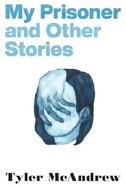
A collection reckons with big legal and moral questions. Just over halfway through McAndrew’s collection comes a story called “Crime and Punishment,” a title that would
accurately describe most of these tales, which often reckon with incarceration, guilt, and the aftereffects of violent acts. Sometimes that reaches baroque heights, as in “The Storyteller,” about a couple named Wayne and Nancy who buy “the house that had been the site of the famous Hobson murders.” The violent acts that took place there don’t return to the surface until the pair has divorced, with the house’s potential for supernatural visitations something Wayne taps into in conversations with his children. The young narrator of the title story sees an arm waving from a nearby prison and starts to wonder what its owner’s story might be: “at bedtime, my imagination unraveled like a scroll of every crime I’d ever heard of.” McAndrew has sympathy for many of his characters; Maria, protagonist of “The Familiar Dark,” has a penchant for casual burglary but winds up helping an older woman, Ania, who’s in the midst of a complicated grieving process. Late in the collection, McAndrew uses questions of crime and guilt to raise the stakes, placing his characters in places where they must try to understand the people in their lives—whether it’s a relative who committed a terrible act in “Letters From Toby” or a man with a penchant for unusual pets living in a halfway house in “How I Came To See the World.” McAndrew doesn’t shrink from asking big moral questions, and his fiction abounds with lived-in touches and a sense of scale.
Philosophical stories and memorable characters sure to spark debate.
McGinty, Patrick | Univ. of Wisconsin (286 pp.) $18.95 paper | September 23, 2025 9780299354244

An elusive young man struggles with the meaning of success.
Early on, McGinty says of his protagonist Kurt Boozel’s hometown that it’s “small, and there are eyes everywhere.” As the title
suggests, this is a story told in four parts as it follows Kurt from awkward adolescence to a degree of material success. Kurt’s academic skill prompts a coach at his high school to ask him to tutor TJ, an athlete whose grades are suffering. There’s a growing sexual tension between the two young men, which further isolates Kurt. He hasn’t come out to his family or friends, and his hesitancy to do so is one of the book’s ongoing threads. The novel follows Kurt to college, where he becomes enmeshed in fraternity life, and then to a career in finance, when he becomes obsessed with a Bitcoin purchase: “It took 24 whole minutes to walk to work, and in that time, Kurt missed an entire crypto opera.” The story is set in the recent past; McGinty references both the Occupy movement and Barack Obama’s 2012 reelection. We follow Kurt as he becomes more aware of his own desires and, later, develops a penchant for boxing. The prose style neatly evokes Kurt’s penchant for mental shorthand: “His brown eyes widening = I need you. Or = I’m dumb. Or = leave me alone.” But there’s a cautionary element there as well: Kurt is an ambitious young man drawn to the idea of success without understanding what it might cost; by the time he drives through a winter landscape to a family gathering, he’s on the brink of a crisis or a revelation— even if he hasn’t quite figured that out. An emotionally complex coming-ofage story.
McGuane, Thomas | Knopf (192 pp.) $26 | October 14, 2025 | 9780385350235

Nine stories of dead-end lives and wide-open spaces, set mainly in the American West. This slim collection from the Montana master seems like kind of a coda to his prolific career. It provides plenty
of bleak comedy, as morally compromised characters face mortality and determine that their lives haven’t amounted to much of anything, their existence seems as barren as the landscape surrounding it. In the opening “Wide Spot,” a cynical politician offers a first-person narrative in which a reunion leads to an inappropriate seduction attempt. In “Balloons,” a physician with a dying patient offers another firstperson narrative about the surprising retribution he faces for an affair that ended long before. From there, the perspective in these stories generally shifts to third person, but there’s nothing approaching omniscience. The protagonists, usually male, on the downside of middle age, are typically careless and often clueless. The natural splendor of their American West has been undermined by grifters: “Life in the West was a beautiful idea, best left in that state, a conviction not easily conveyed.…The place was infested with land speculators: house flippers, ranch flippers, and river flippers.” Two of the stories feature protagonists who have achieved some financial success, a good distance from Montana, and both are as miserable as the drifters and losers in the rest. In “Thataway,” a chain-store furniture magnate living in Palm Springs returns home for the funeral of one of his all-but-estranged sisters. The disastrous visit makes him realize that he has no home, and on the return trip to California “he had a fleeting hope that the plane would stay up in the air.” The concluding title story is the longest and perhaps the darkest, as a river trip fraught with tension and peril reveals the dysfunction of a tycoon’s family. Flinty and sharp-edged, these stories show no sign that the octogenarian McGuane is softening up.

Moss, Sarah | Farrar, Straus and Giroux (304 pp.) | $28
September 9, 2025 | 9780374609016

An elderly British emigrant in the west of Ireland narrates the birth of her nephew more than 50 years earlier. Edith, a woman in her early 70s, has made an enviable life for herself in County Clare. She lives alone in a cottage there, financially secure after getting divorced and selling property near Dublin. She has a lover and a cadre of friends, including Méabh, a local with whom Edith has found a deep rapport. And she’s found an even deeper rapport with Ireland itself, though she hails from a farm in Derbyshire in the north of England, raised by her farmer father and her “glamorous” French Jewish mother, whose own parents and sister were sent to Belsen during the war. Edith’s status as an outsider in Ireland means she has “learnt, as immigrants do…by keeping quiet, standing back, observing.” This sense of life on the periphery also connects her in memory to her past when, on the brink of attending Oxford, a 17-year-old Edith is sent to stay at a villa near Lake Como with her older sister, a ballerina. Elegant and cosmopolitan like their mother, Lydia is everything cerebral Edith feels she isn’t. Lydia is also eight months pregnant and opaque about the baby’s paternity, determined to give the baby up for adoption and return to her demanding life as a dancer. Moss switches back and forth between Edith’s present, told in close third person, and the past, told in first person and addressed to the baby that Edith and her sister await. Through these parallel narratives, and with her characteristically sinuous style, Moss is able to explore the idea of belonging: What does it mean to belong to a place? To a lineage? A family? A home? Moss directs her keen and graceful sensibility toward modern-day Ireland and 1960s Italy with equal aplomb.
At midcareer, the author has written his shortest—and sweetest—novel yet. It may also be his best.
BY MARION WINIK
TWENTY-FOUR YEARS AGO, a novel with the charmingly off-kilter title The Russian Debutante’s Handbook appeared in bookstores, announcing the arrival of what reviewers like to call a “bold new talent”: Gary Shteyngart, born Igor Semyonovich, who came to the U.S. from the Soviet Union at the age of 7. That ambitious, funny, intelligent debut, which featured a 20-something immigrant protagonist very much like the author, earned Shteyngart his first starred review from Kirkus.
At 53, Gary Shteyngart has just received his sixth star in seven books, this time for his shortest novel ever and his first with a child protagonist: Vera, or Faith. Vera is set in a dystopian near future, focusing on the trials of Vera Bradford-Shmulkin, a 10-year-old New Yorker with a lot on her plate as she tries to keep her Russian-born father and American stepmother together, learn what happened to her Korean-born mom, make her first real friend, prepare for a debate at school, and much more. The topic of the debate: a new anti-immigrant law decreasing the voting power of any American with a non-WASP background.
Our critic writes, “As the political situation in the United States evolves, Shteyngart’s particular flavor of black humor—Russian wry?—reconnects with its roots in sorrow and resistance and becomes essential and lifesaving.”
On a recent Zoom call, we asked Shteyngart to reflect on his career so far, and give us a hint of what’s to come.
As Shteyngart sees it, he began with two themes. “One is all the immigrant
Having a kid, being responsible for another human softenedbeing, me.

stuff,” he explains. “I was the first of my generation of Russian Americans to start getting published, and I wanted to get that experience down in the most interesting and entertaining way possible.” He continued this project in the novels that followed: 2006’s Absurdistan (“my funniest book,” he suggests) and 2010’s Super Sad True Love Story (“my biggest book”), in which the second theme, a fascination with speculative fiction and dystopias, fully emerged.
“Let me show you something,” he says, disappearing for a moment, then returning with a fanned-out stack of vintage Asimov’s Science Fiction magazines. “By the time I was Vera’s age, I was already in love with Nineteen Eighty-Four, Brave New World, and The Handmaid’s Tale, which was just coming out around then.” The future that he imagined in Super Sad, an authoritarian corporate regime driven by equal parts evil and stupidity, is a close relative of the world he gave Vera, “who is the same age as I was when I started reading Asimov’s.”
Shteyngart’s fourth book, the memoir Little Failure (2014), he sees as a watershed, the endpoint and “fire sale” of his Russian American immigrant experience: “Everything must go!” The sadder and more painful aspects of this adjustment, which he met with caustic humor in the novels, he faced directly and dead on.
The three books since occupy what his editor, David Ebershoff, half-jokingly calls his “middle period.” While the early novels have the feel of what Shteyngart calls “an angry young person waving at the sky,” these books possess a gentler soul, one he relates to becoming a father. (Shteyngart and his wife, Esther Won, welcomed a son in 2013.) “Having a kid, being responsible for another human being, softened me,” he says.
Lake Success (2018) is set during the lead-up to Trump’s first electoral victory. It follows hedge fund manager Barry Cohen on a cross-country Greyhound bus trip, fleeing, among other things, his conflicted feelings about fatherhood. Our Country Friends (2021), Shteyngart’s pandemic novel, is all about family, both biological and chosen.
And then comes Vera, featuring a “sensitive, intelligent kid, suffused by
anxiety,” not unlike the author at that age. By now it was clear that the “middle period” was marked not only by a change in tone but a change in process as well. Before Little Failure, says Shteyngart, “I had an idea, I wrote it. I took my time, and I got there. But each of the last three books was preceded by a 200-page draft of some other book that completely failed.”
He continues, “Before Vera, it was a spy novel. I did tons of research into the three different spy agencies in Moscow; my protagonist was a Russian spy planted in New York. I gave my editor the first 200 pages and he told me, ‘This is terrible.’” By now, Shteyngart knew the drill and thus he had a backup idea at the ready.
“On a long flight home from Tokyo, I rewatched Kramer vs. Kramer. I knew I wanted to do a divorce thing, but from the perspective of the child, like Henry James’ What Maisie Knew.” Shteyngart’s Vera is desperately trying to keep her warring parents together, delivering lists titled “Ten Great Things About Daddy and Why You Should Stay Together with Him,” and “Six Great Things About Mom.”
“I just started typing away—lately I seem to do all my best work on planes— and it came out really fast,” he says. “By the time I landed, I had finished the first chapter and started the second. In the first chapter you’re just trying to capture the voice, and it either works or it doesn’t. If you don’t capture the voice, then it’s back to square one. This time, there weren’t even many edits. I had it.”
Fifty-one days later, the draft was done—with a vestige of the original spy novel buried inside it, though stripped of all the research. “My usual process involves quite a bit of meandering,” he says, “but with Vera, I worked harder than I’ve ever worked in my life—so hard I began to get dizzy and went to the doctor to see if I’d developed some kind of vertigo. But when I finished the book, it immediately went away.”
There was just one problem. The completed draft was more than 100 pages shorter than any book he’d written before. “I was shocked, to the point where I felt super guilty,” he recalls. “Was this even a novel? I literally Googled, How long does a novel have to be? According to E.M.

Shteyngart, Gary
Random House | 256 pp. | $28 July 8, 2025 | 9780593595091
Forster, it’s 50,000 words minimum. My Word document was 50,022.”
Hard work and long flights have fueled two other works in progress. Coming next year is a collection of his much-loved essays from the New Yorker, the Atlantic, and elsewhere—his hilarious week on the world’s largest cruise ship; his encounters with capybaras the world over; his love letters to martinis, watches, and perfectly tailored suits.
“What’s most important to me is to live a good life, to find things I enjoy,” he says. “Of course it doesn’t always go well, and I write about that, too. The circumcision piece will be in there. That was the worst year of my life. As my wife put it, ‘I never thought that you would lose your sense of humor. But you have.’”
That much-discussed 2021 essay, about the botched procedure performed on him as a 7-year-old and a series of more recent treatments, inspires a downcast look from the writer. But he brightens as he explains that the other project is his first work for children, a chapter book about capybaras.
More about the snub-nosed, barrel-bodied South American rodent? There can never be too many capybaras, he assures me. “In a world of horrific human beings, I want to showcase the sweetest, kindest animal there is.”
Marion Winik is the author of The Big Book of the Dead and hosts the Weekly Reader podcast on NPR.

The author was known for his books chronicling the lives of gay men.
Edmund White, who wrote about the lives of gay men in more than a dozen novels, has died at 85, the New York Times reports.
White, a native of Cincinnati, Ohio, was raised in the Chicago suburb of Evanston, Illinois. He studied Chinese at the University of Michigan and worked as a journalist before making his literary debut in 1973 with the novel Forgetting Elena, followed five years later by Nocturnes for the King of Naples. In 1982, he published one of his best-known books, the autobio graphical novel
A Boy’s Own Story, now considered a classic of LGBTQ+ literature. That novel was the first in a trilogy that continued with The Beautiful Room Is Empty and The Farewell Symphony. His other novels include The Married


Man, A Saint From Texas, and The Humble Lover
He was the author of several works of nonfiction, including The Joy of Gay Sex, co-written with with Charles Silverstein; States of Desire ; The Burning Library ; and Genet: A Biography His memoirs include My Lives, City Boy, and, most recently, The Loves of My Life: A Sex Memoir, which was published in January by Bloomsbury.
White’s admirers paid tribute to him on social media. On the platform X, author Joyce Carol Oates posted, “Edmund White—the most gracious & witty of conversationalists whom Oscar Wilde himself would have much admired.”
—MICHAEL SCHAUB

For reviews of Edmund White’s books, visit Kirkus online.
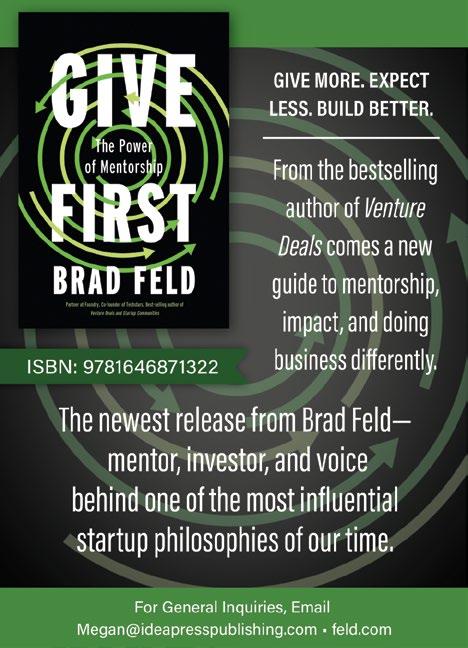
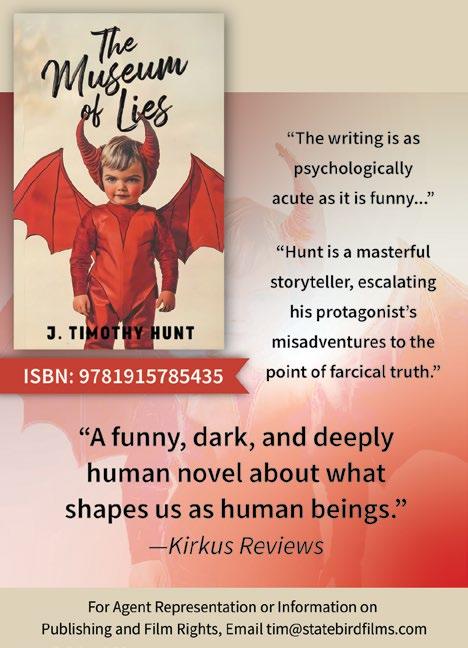

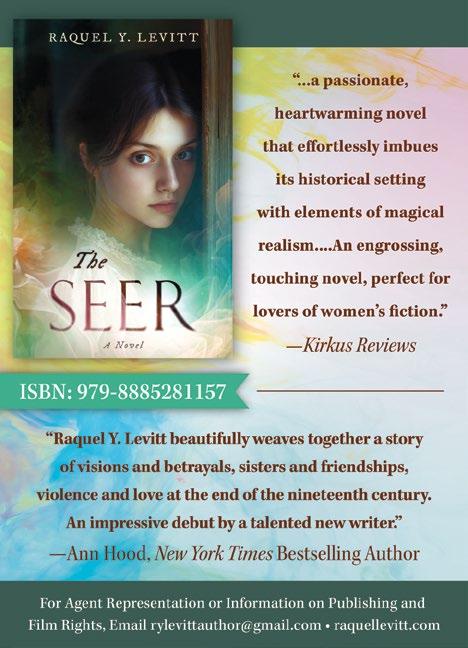

The author was honored for “her transformative impact on literature.”
The Women’s Prize Trust announced that Bernardine Evaristo has won its Outstanding Contribution Award, a special one-off prize given in honor of the 30th anniversary of the Women’s Prize. The award, the trust said, “celebrates Bernardine’s body of work, her transformative impact on literature and her unwavering dedication to uplifting under-represented voices across the cultural landscape.” It comes with a cash prize of about $135,000.
Evaristo’s books include the novels The

For reviews of Bernardine Evaristo’s books, visit Kirkus online.
Emperor’s Babe, Soul Tourists, Blonde Roots, and Mr. Loverman, as well as the memoir Manifesto: On Never Giving Up. Her 2019 novel Girl, Woman, Other won the Booker Prize alongside Margaret Atwood’s The Testaments
In 2023, the Booker Prize launched a naming contest for the award’s trophy, and the name “Bernie”—a tribute to Evaristo—got the most votes. She declined that honor, and the trophy was named “Iris,” after author Iris Murdoch, instead. In a statement, Evaristo said, “Over the last three decades, I have witnessed with great admiration and respect how the Women’s Prize for Fiction has so bravely and brilliantly championed and developed women’s writing, always from an inclusive stance. The financial reward comes as an unexpected blessing in my life, and given the mission of the Women’s Prize Trust, it seems fitting that I spend this substantial sum supporting other women writers; more details on this will be forthcoming.”—M.S.

Muharrar, Aisha | Viking (336 pp.) | $30 August 12, 2025 | 9780593655849

A woman from LA heads to London in search of her on-again, off-again lover’s possessions after his untimely death.
Julia and Gabe meet in a summer arts program in Barcelona right before they head to college, after his mother, Leora, a poet who’s teaching in the program, introduces them, and they have a summer fling. However, the book opens with Julia at Gabe’s funeral, 12 years in the future. She has a successful jewelry-design business, and he is—well, was—an indie star known as Separate Bedrooms. She also tells us that just one month before Gabe died, they slept together, long after their first fling and unbeknownst to Gabe’s recent ex-girlfriend, Elizabeth, who lives in London and manages a bespoke floral studio as well as a hip restaurant. Readers will learn all of this as Julia sets off for London, prodded by Leora to rescue the older woman’s cherished guitar. At first Julia tries to appear blasé with Elizabeth, but after a series of blunders, they decide to join forces and find the three things Leora wants: the guitar, a baseball cap, and a piece of sheet music. Julia tries not to let on what she wants to find for herself: a medical bracelet she once made for Gabe, who had “situs inversus,” meaning his internal organs were reversed. Author Muharrar seems to want to show that Julia’s feelings are reversed, but it doesn’t work in the brief window the women have, just a couple of days until Julia’s return to the U.S. There isn’t enough time for us to understand Julia’s adult self, even with flashbacks to other times her life intersected with Gabe’s. Nor is there enough space for Elizabeth to come to life beyond her chic exterior. Muharrar’s fluid writing promises interesting future work, but this book might have remained a short story.
Poignant and well written, but with a slim premise and insufficient character development.
Mushtaq, Banu | Trans. by Deepa
And Other Stories (192 pp.) | $19.95 paper April 8, 2025 | 9781916751163
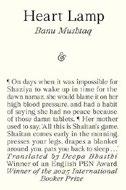
Sterling collection of short stories by South Indian writer Mushtaq. The first book of short stories to win the International Booker Prize, Mushtaq’s collection is also the first prizewinner to have been translated from Kannada, an Indian language whose flavor comes through in Bhasthi’s fluent translation, as when, in the first story, a newlywed woman ponders how to introduce her husband: “If I use the term yajamana and call him owner, then I will have to be a servant, as if I am an animal or a dog.” An attorney, activist, and sometime journalist, Mushtaq often writes of Muslim women in unhappy relationships. In one story, a woman returns home, facing shame for leaving an unfaithful husband forced on her in an arranged marriage, and chides her relatives for their role in her unhappiness: “I begged you not to make me stop studying. None of you listened to me. Many of my classmates aren’t even married, and yet I have become an old woman.” With five children to support, she desperately seeks a way out, with surprising consequences. In another story, a woman, maddened by a houseful of boisterous children on summer vacation, decides that the only way to get some peace and quiet is to enforce bedrest on the older boys—and that means enrolling them in a mass circumcision that is euphemistically billed as a celebration for the Muslim prophet Ibrahim, “a collective exercise in which children look forward to an event but end up screaming loudly together.” Mushtaq’s characters are
frequently at odds, and several have strange foibles, as with a religious teacher who becomes addicted to gobi manchuri, a cauliflower dish, which leads to some decidedly unsaintly behavior. The book is not without its flashes of sharp-edged, ironic humor, as when a woman seemingly caught in the throes of dementia is offered a Pepsi as “the drink of heaven,” but more often Mushtaq writes in near-documentary style of lives lived in constant struggle.
A memorable introduction to a gifted writer from whom we should hope to hear more.
Peck, Geoff | Univ. of Iowa (288 pp.) | $19 paper September 23, 2025 | 9781685970260
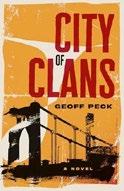
A young man reckons with some difficult truths. When this debut novel begins, the year is 2009. Nineteen-year-old Jeremy has just moved into his first apartment in Pittsburgh, which he shares with his film buff friend Scott. Jeremy struggles with his self-esteem; his old friend Kat is attending Carnegie Mellon University while he studies at community college. Jeremy’s relationship with his father, a former player for the Pittsburgh Pirates, has been strained ever since Jeremy quit playing baseball. A mysterious—and possibly sexual—encounter between Scott and Jeremy one night leaves the latter confused about his sexuality and his place in the world. His worldview is also expanding, with his coursework leading him to writers like B.H. Fairchild, John Steinbeck, and Thomas Bell. Kat’s growing political activism also has an effect on him, though her idealism sometimes manifests in statements like “Twitter’s going to change the world,” which may have been accurate in 2009 but feels more fraught in hindsight. Gradually, Jeremy becomes increasingly aware of Scott’s disdain for others and his racism—leading him to further question his life and his bonds
ZONE ROUGE
with others. A revelation late in the novel casts a new light on several scenes and makes Jeremy’s inner conflicts more complex. But other elements of the novel can feel heavy-handed, like Kat’s penchant for saying things like, “It’s about the fact that we live in a police state where the First Amendment can be beaten down with a riot baton.” Peck taps into a host of big themes—including generational legacies, trauma, and the Great Recession—but the execution isn’t always smooth.
An earnest but flawed coming-of-age tale.
Plunkett, Michael Jerome Unnamed Press (250 pp.) | $28 September 2, 2025 | 9781961884557

Plunkett’s polyphonic novel details the lingering effects of war.
It’s a bold choice to begin a novel with the image of cows swallowing shrapnel, but it illustrates just how this book juxtaposes the martial and the quotidian. Large sections are narrated collectively by the démineurs, who are responsible for cleaning up ordnance from World War I in the fields around modern-day Verdun, France. “We recover dozens of shells every week. Every month: hundreds. Every year: tens of thousands,” they say—and gradually, Plunkett clarifies the physical and psychological effects of this work. One of the book’s narrative threads focuses on démineur Ferrand Martin, who is being treated for lymphoma that he almost certainly
developed from exposure to military hardware: “Every shell we pull from this earth has a secret. Powder. Ball. Chlorine. Mustard. Arsenic.” The discovery of a bone among the ordnance provides another facet of the region’s history, as a number of outside experts are brought in to investigate the scene. The dead man’s identity, and the question of whether he fought on the French or German side of the conflict, both complicate matters further. Certain subplots feel slightly underdeveloped, including some interludes with the town’s trysting mayor, but the sections narrated in the first person plural give a powerful sense of the weight of the work carried out to reverse the damage done to the local landscape a century ago. This is a book that ably balances philosophical musings with passages describing life in an ailing body, and the way that it evokes the effects of war long after the last shots were fired is deeply felt. An unconventional exploration of the aftereffects of war.
Kirkus Star
Under
Pourciau, Glen | Four Way (200 pp.)
$19.95 paper | September 15, 2025 9781961897601
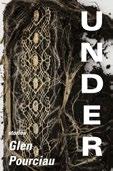
A compendium of 41 casually brief stories about characters who perceive sinister intentions in every word, look, and gesture.
A woman is drawn into a disagreement with a stranger over the stigma of narcissism. A man grows threatened by his neighbor’s
newly raised Gadsden flag—the kind that says “Don’t Tread on Me”—and decides to confront him. A couple enacts a scheme to prevent a man from parking his truck in front of their house. These are some premises of Pourciau’s fourth collection of short stories, mostly depicting the first-person perspectives of aggrieved, suspicious, emotionally isolated people obsessing over others’ hidden thoughts. Pourciau’s oeuvre focuses almost exclusively on minor disruptions to our daily routines that have the potential to drive us mad. The longest story—one of the best and most complete entries, “Invade”— describes a woman incessantly pestering her new neighbors for an invitation to help them redecorate, eliciting increasingly curt and hostile evasions. Averaging around four pages each, most of the entries are incredibly slight and largely absent of closure, suspending readers in emotional purgatory. Trying to read just one at a time has the addictively insubstantial effect of eating a single potato chip. But beware: Attempting to ease the irresolution by binging a bunch in quick succession can be downright nauseating from ingesting such unrelenting paranoia. Steeping oneself in Pourciau’s world of lunatic anxiety and claustrophobic discourtesy can be overwhelming, but the cumulative impact is hard to dismiss—and the familiarity of the situations he explores is a sign of the times. One character summarizes a core truth connecting the vignettes: “Society is based on the premise that we remain civil and make the best of our proximity to others.” And another adds a corollary: “Liberating suppressed thoughts can stress the veneer that holds us together.”
An amusing, unsettling, discomfitingly resonant collection.

For more short fiction, visit Kirkus online.
Qudan, Rie | Trans. by Jessie Kirkwood Summit/Simon & Schuster (224 pp.)
$27 | September 2, 2025 | 9781668094129

An architect considers the power and limits of language in this slim novel. Sara Machina has doubts about her latest project. The Tokyo architect is designing a prison that’s not technically a prison—it’s a tower intended to house “Homo Miserabilis,” a euphemism for criminals, meant to evoke sympathy for the unhappy lives they led before they took to crime. “Come on, let’s be real: my entire being was instinctively screaming no, telling me the tower shouldn’t exist,” she thinks. “Every inch of my body was repelled by the incursion of the Sympathy Tower.” Sara is a rape survivor with an abiding interest in words; she worries that rebranding criminals, and other forms of euphemisms, will destroy the Japanese language: “We had begun to abuse language, to bend and stretch and break it as we each saw fit, so that before long no one could understand what anyone else was saying.” Qudan’s novel follows Sara, as well as her younger boyfriend, Takt, as they consider the tower, which is not popular with some of the public, who protest with signs reading “Sympathy for the Victims, not the Criminals!” and “Save Tokyo, Stop the Tower!” Both use an artificial intelligence chatbot regularly to try to come to terms with language— Qudan has said that AI actually wrote the chatbot’s responses in the book, which is apparent. This is a baffling novel, one that seeks to reckon with our relationship with language, but it never really gets there: It’s full of philosophical navel gazing, more a thought experiment than a story. The dialogue between Sara and Takt is stilted, at times sounding like a conversation between two stoners in a dorm room. Qudan is clearly intelligent and curious, but she can’t make this tedious novel work.
Disappointingly plodding and ponderous.
Rankin, Zoë | Berkley (384 pp.) | $30 September 16, 2025 | 9798217188093

The New Zealand bush is the backdrop in this tale of survival and family secrets. Half-starved and covered with blood, a young girl stumbles into a grocery store in a remote village on the outskirts of the unforgiving, heavily forested bush. She can’t speak, but she looks just like a girl who went missing in the bush 20 years before. This explosive opener is just the first of many shocking scenes in a nature-centric, highly satisfying crime drama that is perfect for fans of Emma Donoghue’s Room (2010) and other tales of survival. After the girl’s discovery, the plot segues roughly 11,000 miles north to where Effie, the girl who went missing decades before, is working and living on Scotland’s Isle of Skye. Effie doesn’t know the newly found girl, but their shared physical traits—red hair and green eyes—and the community where she was discovered are enough to pull Effie back to the place she hoped she would never see again. Returning to the bush cracks open the story of Effie’s harrowing and heartbreaking childhood of isolation and deprivation, and, as it’s slowly revealed, the story of the girl, whose name is Anya, who has endured far worse. When Anya runs away, Effie must return to the bush to rescue her and in the process discover the fate of her long-missing family and reckon with her past. Rankin deftly reveals Effie’s and Anya’s experiences in parallel storylines that eventually meld into one. Neither Effie nor this novel’s hypnotized
readers can be prepared for what she finds. As rich as Rankin’s entrancing and skillfully developed plot are her immersive descriptions of the bush country: “A world of a thousand greens, where trees rose to the sky like gods.” It’s like being there yourself.
You’ll get lost in the wilds with this gripping debut.
Redel, Victoria | SJP Lit/Zando (304 pp.)
$28 | September 30, 2025 | 9781638932062

The story of two Dutch Renaissance artists, one who struggles to achieve fame despite her gender, the other her servant, who must struggle against both her gender and her class to succeed.
Inspired by the actual artist Maria van Oosterwijck, Redel has written a novel that combines a 17th-century atmosphere with a 21st-century sensibility. While Redel’s Maria is drawn with intriguing complexity, this story belongs to her maid, Gerta, who narrates. When Gerta was 7 years old, her impoverished family disguised her as a boy named Pieter and sent her to work for Maria’s family as a servant. Already a still-life painter at 14, Maria enjoys secretly sketching the servant boy as a model, even though women are not allowed to draw the human body. The child idolizes Maria. When Maria recognizes that the servant boy has grown into an adolescent girl, she takes Gerta as her maid to Utrecht. Both talented and ambitious, Maria must feign piety to avoid the encumbrance of marriage. Gerta
A deep dive into the life and faith of one devout yet contrary everywoman.
RUTH
becomes not only her domestic servant but also her closest companion. Maria teaches Gerta to paint, and Gerta becomes her apprentice, whose paintings are signed by Maria. Gerta is also adept at purchasing and mixing pigments, a difficult, important aspect of painting at the time. Gerta’s still-fluid gender identity proves useful; she reverts to Pieter when she needs to visit the docks to bargain for supplies among male merchants. At the height of her career, Maria grows physically incapacitated and increasingly unable to paint. Gerta serves as Maria’s instrument, eventually painting all of Maria’s commissions under Maria’s name. Maria and Gerta are also lovers. While continuing their public roles as master and servant, they intertwine on multiple levels of secrecy and closeted identity, a situation that becomes increasingly difficult. Redel’s commentary on art and sexual politics is predictable; her characters’ nuanced, complex relationship is terrific.
Riley, Kate | Riverhead (256 pp.) | $29 August 19, 2025 | 9780593715949

A woman maintains her independence and questioning spirit while walking the narrow “tightrope of obedience” required by membership in an insular religious sect.
Ruth Della Scholl is born into a Michigan branch of the Brotherhood, a fictional Anabaptist community, in 1963. With a strict, austere communalism, the group eschews materialism and competition and puts its members’ love of God above all else, but Ruth defies any stereotype of a fundamentalist. While other members come and go—including Ruth’s brother, whose disappearance is never discussed by their parents—Ruth tries her best to be a good Brotherhood “sister.” When a friend she’s made at a community
college offers to help her escape the Brotherhood, Ruth is shocked. She doesn’t want to leave. Yet she scrutinizes every resentment and frustration she experiences, as well as occasional joy. With humor and barely suppressed passion, she describes her life from infancy through middle age through a very close third-person narrative. The novel is an accumulation of random moments: her distress when her 8th-birthday presents are packed away because she eats a candy bar her mother tells her to put down; the realization that the Bible doesn’t exactly describe the world—“leprosy still existed, pharaohs did not”; the discovery that a boy she secretly loves is marrying someone else. Along the way, Ruth sketches in an abundance of minor characters, too many to keep track of, from a young teenager who had to leave her previous community for “thoughts and deeds of impurity” to an older convert who rejects his former political activism as ego-driven. Ruth’s eventual marriage to an irritating but endearing husband rings all too true. Mothering her three children, especially the unruly son in whom she sees herself, is difficult. The Brotherhood seeps into every corner of her life, and readers will learn a lot about Anabaptist sects. But cheeky, inquisitive, and a delightful pain in the neck, Ruth carries the novel with aplomb.
A charming deep dive into the life and faith of one devout yet contrary everywoman.
Rio, M.L. | Simon & Schuster (400 pp.) $29 | September 9, 2025 | 9781668070024

T he daughter of a mysterious rock icon flees her present to untangle the tragedies in her past.
Rio follows her successful venture into dark academia (If We Were Villains , 2017) with a novel about rock ’n’ roll and life on the
road. In alternating narratives called “A Side” and “B Side,” we meet Suzanne on two sides of a 30-year divide. In 1989, she’s a precocious 10-year-old living with her mother in Baltimore; her father is on the road pursuing fame and fortune with his band, Gil and the Kills. She works her way into an unpaid job helping out at a record store in the mall and is ready to roll when her mom remarries and leaves on a long honeymoon, sending her on tour with her dad and his band. In the second narrative, Suzanne is 41, trapped in a boring suburban life with a man named Rob. When she learns that her long-estranged father has died and left her his car and some memorabilia down in Florida, she’s once again more than ready to hit the road. Before long, she is part of a throuple with an itinerant pair who hunt and resell vintage clothing. With their Airstream attached to her father’s old Ranchero, they are on their way cross-country so Suzanne can talk to her dad’s widow—with a furious Rob hot on her trail.
Ominous threats of violence in both time frames keep the pages turning to a double-barreled bloody climax. Along the way, much ink is devoted to the on and offstage dynamics of Gil; his guitar player, Eric “The Hands” Skillman; their band; and other musicians: It has the feel of a mockumentary like This Is Spinal Tap, but played with deadly seriousness rather than humor. While it’s a bit hard to accept that Suzanne went from being the coolest 10-year-old in the world to a totally shut down mouse, it’s satisfying to watch her refind her freak flag.
A bit of a hellride, but metal band–loving readers (hopefully not an oxymoron) may enjoy the scenery.

Saunders, Paula | Random House (304 pp.)
$29 | August 26, 2025 | 9780593978290
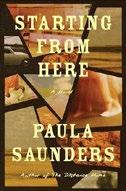
A teenage girl from South Dakota leaves home in hopes of reaching her potential as a ballerina, but her path is littered with obstacles. René and her brother, Leon, are both wonderful dancers, but their father can’t stomach the idea of a boy “traipsing around in a tutu.” Instead, he and his wife, Eve, put all their hopes and dreams into René. They realize she can never become a top ballerina if she trains only in their hometown in South Dakota, so Eve finds a family in Phoenix willing to take her in. René joins the ballet school of a master, but the other girls don’t accept her. Even when she limits herself to just a few hundred calories a day and sheds too many pounds, she can’t fit in. When she’s not invited back the following year, her mother finds her another placement in Denver. Unfortunately, she keeps getting herself into compromising situations with older men, perhaps because she has no guardians looking out for her. It becomes less and less certain whether René will ever make it as a ballerina or even survive the period of her training. Told in the third person but following René throughout, the story is equal parts entertaining and maddening. While René’s parents continually complain about the sacrifices they are making to pay for her dance education, they also utterly neglect her and allow her to fall into one unpleasant or dangerous situation after another. Similarly, though Leon may have been a wonderful dancer, the author drops that thread without exploring it sufficiently. Even so, the book does explore issues of self-doubt, identity, and ambition with a depth that surpasses any of the characters’ abilities to understand their own struggles. A coming-of-age story that doesn’t live up to its potential.
Schlesser, Thomas | Trans. by Hildegarde Serle | Europa Editions (432 pp.) | $30 August 26, 2025 | 9798889661115
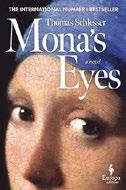
A French art historian’s English-language fiction debut combines the story of a loving relationship between a grandfather and granddaughter with an enlightening discussion of art.
One day, when 10-year-old Mona removes the necklace given to her by her now-dead grandmother, she experiences a frightening, hour-long bout of blindness. Her parents take her to the doctor, who gives her a variety of tests and also advises that she see a psychiatrist. Her grandfather Henry tells her parents that he will take care of that assignment, but instead, he takes Mona on weekly visits to either the Louvre, the Musée d’Orsay, or the Centre Pompidou, where each week they study a single work of art, gazing at it deeply and then discussing its impact and history and the biography of its maker. For the reader’s benefit, Schlesser also describes each of the works in scrupulous detail. As the year goes on, Mona faces the usual challenges of elementary school life and the experiences of being an only child, and slowly begins to understand the causes of her temporary blindness. Primarily an amble through a few dozen of Schlesser’s favorite works of art—some well known and others less so, from Botticelli and da Vinci through Basquiat and Bourgeois—the novel would probably benefit from
being read at a leisurely pace. While the dialogue between Henry and the preternaturally patient and precocious Mona sometimes strains credulity, readers who don’t have easy access to the museums of Paris may enjoy this vicarious trip in the company of a guide who focuses equally on that which can be seen and the context that can’t be. Come for the novel, stay for the introductory art history course. A pleasant if not entirely convincing tribute to the power of art.
Star
Schweblin, Samanta | Trans. by Megan McDowell | Knopf (192 pp.) | $27 September 16, 2025 | 9780593803103

St artling, otherworldly encounters reveal universal emotions in six fierce short stories. Schweblin, who writes both novels and short stories, proves once again here how urgent and efficient fiction can be. The six tart slices that make up this bitter dark-chocolate orange are a provocative answer to the Beatles’ question: “All the lonely people / Where do they all belong?” The book’s lonely people include a woman who tries to drown herself; estranged friends on the phone reliving an accident; a 2-year-old boy who has lost the ability to speak; a writer at a residency in Shanghai; the grown daughter of a dementia patient; and two young sisters determined to rehabilitate a shattered poet. These are
A family drama with touches of magic unfolds in a Greek village.
UNTIL THEY SLEEP
forces of nature with powerful intellects, internationally situated (Schweblin is from Buenos Aires and lives in Berlin), conversant in upheaval and despair, who make startling leaps of time and circumstances. In these stories, each person hungry to connect has a counterpart who can’t or won’t respond. Attempts at closing the gap create guilt, foreboding, or a sharper awareness: We love others but are ultimately alone. And yet each story sings with meaning the reader gleans from witnessing. As one of the young sisters notes of a mysterious house: “You had to stand there for a moment, very still, and get used to that even darker darkness, before you could finally see anything.” These stories, too, require an adjustment of the eyes, so that just after we are shocked by an eerie threat (a ghostly cat, a telepathic neighbor, a violent guest), we realize we have been party to a central human truth. Some revelations come in the form of body horror, and the gore can be hilariously goofy—a welcome lightness to the more somber scenes of tender caretaking (or unapologetic cruelty).
Schweblin and veteran translator McDowell trace the slim barrier between perception and reality with masterful narration, piercing dialogue, stealthy wit, and psychological precision. Outrageously original and deeply felt stories with an indelible effect.
Silver, Marisa | Simon & Schuster (288 pp.) $28 | September 2, 2025 | 9781668078969
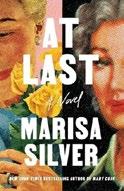
T hree generations of women are tied by blood, marriage, and a slow-burn disappointment in life.
A kind of existential crisis simmers in each of these 12 chapters— which could be read individually as short stories—traversing nearly a century of American life. The book begins in Omaha, Nebraska, in 1971 with Helene Simonauer and Evelyn Turner, uncomfortable in-laws-to-be, at the marriage of
their children Tom and Ruth. Their silent ride to the flower shop for the wedding bouquet sets the tone for decades of a relationship based on competition and mutual disapproval. Flashes of their girlhoods, affluent and tragic for Helene, hardscrabble and transgressive for Evelyn, offer a backstory to their middle-aged unhappiness: “They are widows who lie in bed terrified that they are lost in their noisy days and their noisy, pointless lives and that they are missing everything that matters.” Ruth and Tom’s only child, Francie, brings some flashes of joy, but Francie is troubled by anxiety, which progresses to drug addiction. Much of the sadness of the novel comes from the characters’ inability to access their own selves—Helene and Evelyn seem trapped in performing a womanhood they have no interest in, and then the pain of such strangled identities is passed on through the generations in the form of perpetual criticism to the querulous and underachieving Ruth and painfully self-conscious Francie. There are some arresting vignettes: Evelyn develops a friendship with a neighbor’s child, who steals small, inconsequential things from her apartment; Helene attends a self-help class but is so discomfited at sharing in the circle that she invents a more interesting self to present. The novel ends with Francie approaching middle age, and finally happy—a triumph for all of the women before her. Masterful portraits of women’s lives, only half lived.
Staikos, Nadia | Guernica Editions (250 pp.) | $21.95 paper | October 1, 2025 9781771839839

troubled by her many appetites and guilty about the reproving looks she thinks are given to her by the family icon of Mary and Jesus. Betrothed at 14, she moves at 18 to a new village with the stranger who will be her husband, the ugly but kindhearted Kimon, and discovers a “troubling enthusiasm over her husband’s body,” an enthusiasm that leads in quick succession to six children, who follow her around the village like ducklings. Frona befriends newcomer Ligia, who is forced into marriage with an abusive drinker and gambler. When it becomes clear that Ligia won’t be able to have the children she desires, Frona comes up with a plan that has unfortunate repercussions through the years. As the decades pass, focus shifts to Frona’s sweet herbalist daughter, Galena, and her best friend, the damaged mechanic and blackmailer Rouvin, and to a crafty plot to subdue the bored and increasingly violent soldiers who have occupied the town and led its residents toward starvation. While grounding her tale in the intimate details of village life, Staikos also ventures into the supernatural, most notably in the case of a character who wakes up from a violent death to a surprising afterlife as a ghost and finds himself “stuck in a world he had never let himself enjoy.” An exploration of guilt and the liberating effects of casting off shame, the novel regards even its most benighted characters with sympathy, and offers hope to those who would seem most entrenched in destructive patterns of thought and action.
A family drama with touches of magic unfolds in a Greek village in Staikos’ lush debut.
In the early 20th century, Frona grows up as the responsible oldest daughter in a hardworking family,
An ultimately comforting fairy tale that doesn’t ignore life’s seamier sides.

For more family dramas, visit Kirkus online.
Kirkus Star
The Old Man by the Sea Starnone, Domenico | Trans. by Oonagh Stransky | Europa Editions (160 pp.) | $17 paper | August 19, 2025 | 9798889661306
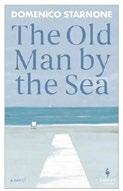
An old man reflects on his life, his mother, the women he’s loved.
If Starnone’s latest work to appear in English bears certain parallels to a Hemingway novella with a strikingly similar title, that’s intentional—right down to the narrator’s casual remarks to a young boy about the sea monster just out of sight. Starnone’s narrator, Nicola, is an 82-year-old storyteller quietly passing time in a seaside town south of Rome. He sits by the beach, reads, writes, and observes the few townspeople who pass by. “Old age,” he thinks, “offered an even better view on meaninglessness.” If, at least at first, there is a certain tepidity to Nicola (who appears to bear certain similarities to Starnone himself), he is soon roused to a quiet simmering. Lu, a young woman who works in a clothing boutique, inexplicably reminds him of his mother, herself once a dressmaker. Nicola is prompted to reflect not only on his childhood—his life as a whole—but also on the way that he has deliberately constructed that life for himself with the only material available: language. In Starnone’s hands, this book is as much about the futility of writing as it is about anything else. Nicola comments on his own narration—often unimpressed—as he proceeds. “What an incongruous simile,” he thinks, after comparing anchovies swimming with the current to ice. “I just don’t know how to do it anymore, maybe I never did.” Throughout the book (beautifully translated by Stransky), Starnone’s sensitivity, nuance, and subtlety are wonderful to behold— but he doesn’t seem to take himself
too seriously, either. Page after page is imbued, alongside everything else, with an achingly sweet humor. A deceptively simple work and an exquisite addition to Starnone’s oeuvre.
Stein, Leigh | Ballantine (320 pp.) | $18 paper | August 26, 2025 | 9780593983645

A 39-year-old woman tries to reclaim her life by becoming a social media producer at a hype house in Los Angeles. Dayna Lev is sitting in her car, stuck in LA traffic behind a moving truck containing all her possessions, when a friend sends her a link to a Reddit post clearly written by her boyfriend—and that’s how she discovers that he doesn’t really want her to move in. Oh, and she’s currently unemployed. She calls Craig Deckler, a former mentor, who offers her a job at his crumbling family home in the Loz Feliz hills. Dayna gives Craig’s address to the moving van and commits herself to overseeing social media content created by the young adults in what is now a hype house. Olivia Dahl from North Dakota, a newly orphaned 19-year-old, applies for a position at the house, and shows up with her bags and a crushing desire to find out what happened to a former resident— Becca Chambers, a tarot card reader—who mysteriously disappeared months earlier. The other residents include Morgan Bokelberg, makeup aficionado and stylist; Piper
Bliss, who was kicked out of her first hype house, and her boyfriend, Sean Knight, who together focus on creating nonspeaking, dance-related couples content; and Jake Cho, who focuses on content designed to make middle-aged women feel cozy and loved. At the pinnacle of the house is Craig, whose family has owned the famous Deckler House for a century. His goal is to raise enough money to renovate the house so it can stay in the family. Author Stein adeptly captures the messiness and contradictions of being human and creating content, portraying the blurred lines between reality and online personas and the unhinged emotional toil that creating such content can take. Gothic horror meets the glitz of 21st-century Los Angeles in this surreal and bingeable story.
Stone, Nic | Simon & Schuster (272 pp.) $28 | October 14, 2025 | 9781668056271
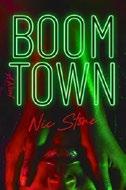
Two dancers go missing from Atlanta’s premier Black strip club two years apart. When exotic dancers Lyriq and Lucky strutted on stage, Boom Town would be hopping. The two women not only danced, they also drew record requests for private sessions. And in secret, they were madly in love. But that was before—before Micah “Lyriq” Johanssen noticed the lump in her breast and pushed her lover away, and before Felice “Lucky”
A deceptively simple work and an exquisite addition to Starnone’s oeuvre. THE
Carothers disappeared. When a young woman named Damaris Wilburn walks into the club almost two years later looking for a job—the club now managed by Micah, who’s had a mastectomy and can’t yet afford reconstructive surgery—her resemblance to Felice is so pronounced that Micah is overcome. But when the new dancer stops showing up for her shifts, Micah begins to look into what truly happened to Felice. A business card kept by both women suggests that there could be a link: Thomas J McIntyre. The novel unfolds in chapters shared mostly between Felice in the past and Micah in the present, and slowly, we learn about their secrets and regrets, their pride and shame. We learn how and where they feel empowered in their bodies and their jobs, and we learn the things that men do that make them feel cheap or worthless or in danger. Most of all, this novel celebrates Black women, women who lift each other up, who acknowledge beauty, strength, and sexiness, who become family in all the ways they show up for one another. From a doctor who helps both Micah and Felice to the community of Boom Town dancers, the women in this novel run the world. Already known for her YA fiction, in her adult debut Stone explores the ways systemic power is destructive, but love, especially between women, empowers and saves.
A captivating blend of lyrical writing and incisive social commentary.
Kirkus Star
Sacrament
Straight, Susan | Counterpoint (352 pp.)
$28 | October 28, 2025 | 9781640097131
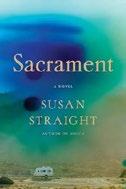
A Covid-19 novel but also so much more. Opening during the spring of 2020, this book refracts the early days of the pandemic with the acuity of a laser, not unlike Straight’s previous novel, Mecca (2022). But if this is the situation of the narrative,
A captivating blend of lyrical writing and incisive social commentary.
BOOM TOWN
its story is the complexity of love and longing, the edgy insistence of the human heart. Straight begins by focusing on three Covid nurses—Cherrise, Larette, and Marisol—who for the safety of their families have been moved to a small trailer park erected near the hospital where they work in the ICU. “They say we’re gonna get it under control. I’ll be back to get you in August,” Cherrise tells her 15-year-old daughter, Raquel, after leaving her with relatives. And yet, it is impossible to read this exchange without recalling the fear and trembling of that moment, in which time felt as if it had lost its shape. Straight makes this idea explicit by reintroducing Highway Patrol officer Johnny Frias, a major character in Mecca, who comes to play a significant role in this new work after Raquel disappears. Don’t be misled, though: This is no mere sequel, but what we might imagine as a parallel text, an adjacent set of stories taking place in a world where linearity, chronology, have become words from a different lexicon. This simultaneity makes the relationship between the novels nuanced and compelling, a broadening rather than a lengthening. It’s an astonishing move, one that feels true both to the moment of the action and the moment in which we are reading, the aftermath of a crisis, or a series of crises, that has not fully gone away. Straight reminds us of where we have been and where we are going without once looking away.

For more by Susan Straight, visit Kirkus online.
Vazquez, Laura | Trans. by Alex Niemi
Dorothy (296 pp.) | $19 paper
September 30, 2025 | 9781948980272
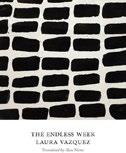
A family tragedy anchors this absurdist first novel by French poet Vazquez. In an unnamed city, teenage siblings Salim and Sara live with their father, who cleans compulsively. The family is broke. The kids skip school and don’t have jobs. They sometimes look for their absent mother, visit their terminally ill grandmother, or post poems and videos online. Seeming traumatized and aimless, they scroll on their phones and hang out with a pill-popping friend, Jonathan, whose family died in a suicide cult, and a man called the roommate who burns things and fights a lot. Vazquez mingles their thoughts, conversations, emotions, and backstory, mirroring the frenzied brain rot and beauty of online life, forming an unreal but gripping portrait of digital-age despair and existentialism. Niemi’s translation speeds along terse and dense with endless chatter and poetic turns—“Do dead people have internet?” “For nature, time is nothing,” “Reality wasn’t fair, it wasn’t normal”—set against a backdrop of gruesome, real-world mortality, including many scenes of torture, disease, and bodily decay. The kids have no adult support or role models. The siblings’ father acknowledges he’s letting their grandmother die and offers useless life advice: “If you throw a cake in the forest, when you go back to the forest, you will
WOMEN, SEATED
find a cake. Share.” It’s a rigorously unsettling reading experience, without plot, tension, or character development. But the details and countless vignettes deliver an immense range of emotion. When the roommate asks Jonathan, “Do you actually have a religion, other than taking pictures of yourself?” he’s genuinely curious, not mocking. Amid so much emptiness, with immense appetites for meaninglessness, these young people are at least always talking and keeping a small circle of people close.
Grotesquely inventive and amusing, like a corner torn from a Hieronymus Bosch painting.
Yagoda, Ben | Paul Dry Books (279 pp.) | $18.95 paper September 16, 2025 | 9781589882065
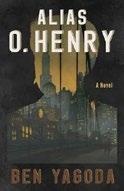
A famous writer’s hunt for a blackmailer plays out against the corruption and colorful characters of turn-of-the-century New York City.
“My past is a locked book and I vow it will remain so,” declares William Sydney Porter, better known as short story master O. Henry, in Yagoda’s novel of the writer’s later years. Porter might want to keep his past hidden, but an anonymous blackmailer threatens to reveal it (Porter served prison time for embezzlement) unless he pays him the ungodly amount of $50 a week. (Yagoda notes that $1 back then would equal $36 today.) Though a
fellow former inmate suggests he shouldn’t hide his past but instead write about the bad living conditions behind bars, Porter is worried that his secret will ruin his rising literary reputation. “The prison label is worse than the brand of Cain,” he says. “If the world once sees it, you are doomed.” The editor of an acclaimed edition of O. Henry’s stories for the Library of America, Yagoda brings his research skills, knowledge of the author, and love of the era to this tale of turn-of-thecentury Manhattan, evoking its crowded streets, many vices, and colorful (and often dangerous) citizenry, not to mention the lucrative world of freelance writing at a moment when short stories reigned supreme. He weaves in a second story of a young artist named Anna, who struggles to support herself and gets enmeshed in the blackmail plot against Porter, who happens to live in the same building. With a dubious detective acting as a middleman between Porter and the blackmailer, the writer soon seeks help from a wide-ranging crew—including a street urchin named Bernie and legendary lawman Bat Masterson— to identify the malicious figure. What they discover provides a surprise twist reminiscent of any O. Henry story. And yet, the blackmail plot isn’t nearly as interesting or suspenseful as other aspects of the story, including, for instance, the convoluted (and heartbreaking) circumstances that landed Porter in jail, and the reason he hardly said a word in his own defense. Yagoda paints an interesting portrait of a rapidly changing metropolis of 4 million rife with opportunity, especially for a writer. “Each of the
four million is a person,” Porter tells an antiprostitution crusader, “with his own sadness, aspirations, occasional joy or triumph. I want to do right by them.”
Gotham might be a perilous place for most, but it’s the perfect spot for a writer in need of material.
Zhang Yueran | Trans. by Jeremy Tiang | Riverhead (208 pp.) | $29 August 12, 2025 | 9780593851920

A tight modern thriller about monied elites and corruption in mainland China also gives us a window into the life of a nanny to a privileged couple’s young son. When 7-year-old Kuan Kuan wants something, he gets it. His gym-rat father, Hu Yafei, and artist mother, Qin Wen, lavish the boy with material goods even as they leave him largely in the care of his nanny, Yu Ling. As the book opens, Yu Ling and her lover Donghu have taken Kuan Kuan on a promised spring outing when they chance upon a man with a cargo of geese that Kuan Kuan insists are swans. His threatened tantrum might derail the day’s plans, so the duo buys him one goose that he names Swan. The fowl’s appearances throughout the rest of the book seem funny and in keeping with a spoiled child’s obsession. However, toward the finale, someone’s goose will be cooked because of Swan, and that’s not a hint about what’s for dinner— rather, it shows how carefully Zhang has planned the action. Yu Ling knows that the parents have disappeared, temporarily or not, due to charges leveled against Qin Wen’s father and the rest of the family by officials. She also believes that Qin Wen has information that keeps her tied to this position as nanny. Most important, and despite Kuan Kuan’s imperious ways, Yu Ling loves the
little boy and doesn’t want him to come to any harm, so she tries to watch him with special care when a woman named Huang Xiaomin, who claims to be Hu Yafei’s mistress, arrives at the house and settles in for a long stay. From this point on savvy readers may be able to work out the very sudden and very odd ending, yet the real reward of the novel lies in how we pay attention: A portrait may be just a picture of a person, but the painter leads our eyes. These characters may live in your head for some time due to Zhang’s fine pacing and quirky scenes.
Zhao, E.Y. | Astra House (304 pp.) | $27 September 23, 2025 | 9781662603266

A quietly devastating novel about the world of competitive table tennis.
Zhao’s debut novel opens with a memorial service: 24-year-old Ryan Lo is dead, and his parents are waiting for his coach, Kristian, who has never once been late, to arrive. “No way,” his mother thinks, “no way this is happening, no, how, no.” But it is, and from here the novel spins back in time, introducing one character after another whose lives touch Ryan’s both directly and indirectly—exhuming not just Ryan’s world as a top-ranked table tennis player but the culture of competitive athletics, where the line between abusing young athletes and motivating them too often blurs. The first four chapters—told from the perspectives of
A
one of the boys that Ryan trains with as a kid, a table tennis referee, a girl who is a mediocre player, and a boy who quit the game quite early—are slow going, the plot weighed down by the dizzying number of characters introduced and not a lot of action. But patient readers will be rewarded as stray details from the opening return with new resonance and seemingly minor characters step into more important roles later on. Midway through the book, it becomes apparent that Zhao is a master of careful plotting and mystery—the real kind that cottons to morally complex situations. Kristian excels at coaching because he’s both kind and cruel, distant from his athletes and too intimate with them, wounded himself and wounding. It’s almost impossible to like him until he appears in his own voice in one of the final chapters. A poet of table tennis, Zhao turns this underappreciated sport into a nimbly described choreography of Tomahawk serves, switch-handed chops, and forehand and backhand loops. A smart novel that examines the impact competitive sports have on kids without assigning winners or losers.
Zumas, Leni | Algonquin (224 pp.) | $28 September 16, 2025 | 9781643756578

A young girl and her autistic cousin seek refuge in an intergenerational community.
In the house her greatgrandfather built, Caz, a musician, runs a home for the elderly, where she
devastating novel about the world of competitive table
also invites young people to live rent-free in exchange for household chores and company for the senior citizens, who include her own ailing mother. In her youth, she fronted a popular punk band, and now she teaches music classes in the community. One night, one of her students, Nola, appears on Caz’s doorstep with her disabled cousin, James, in tow. James’ mother has lost custody of them again, and Nola can’t bear for them to be in foster care anymore. Her mission is to keep James safe and ensure they’re not separated. But she’s just a child herself and exhausted by this responsibility. James is nonverbal, requires diapers, and has specific dietary needs, which is to say, he needs a lot of support. Understanding this, the residents of the Island of Misfit Toys that is Caz’s community offer Nola and James safe harbor as best they can. From the first sentence, you know you’re in the hands of a novelist with the ear of a very good poet. More than that, Zumas seamlessly balances the novel’s lyricism with character building, backstory, and forward momentum. Sometimes the bickering among the residents devolves from comic relief into schtick, but other than that, this novel is a delight to read. It stands out as a book that features the interior voices of children, middle- aged women, and an elderly woman with equal verve. Zumas also finds a way to capture the way James experiences the world with creativity and care. The ensemble comes together to great effect.
A tender and well-told story about the meaning of family.




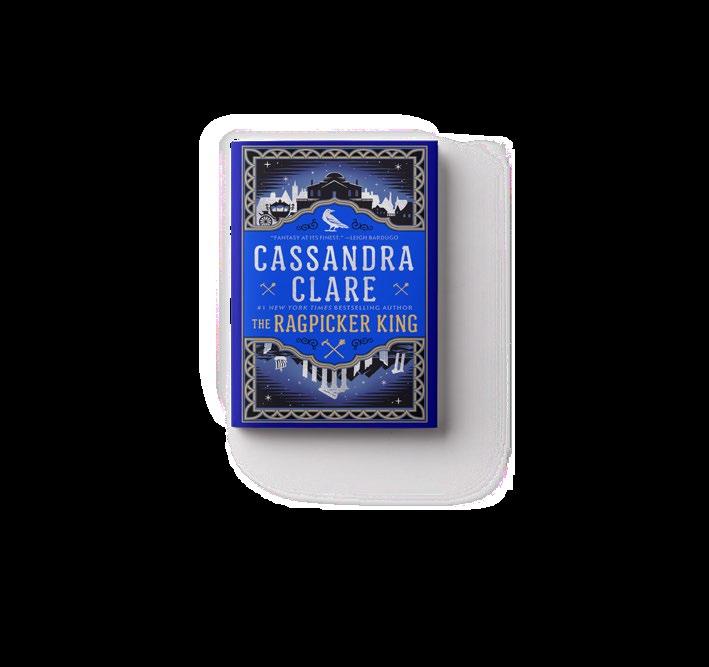
Veronica Roth
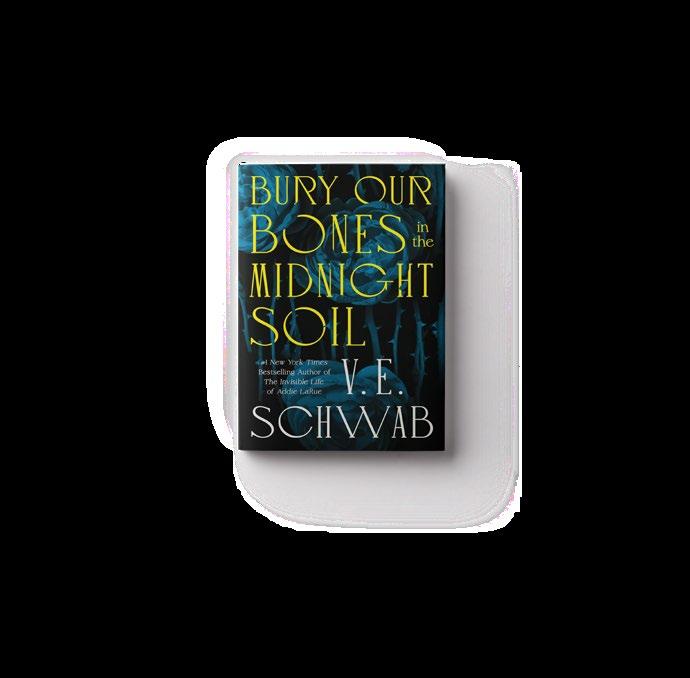
V.E. Schwab
Louis Sachar
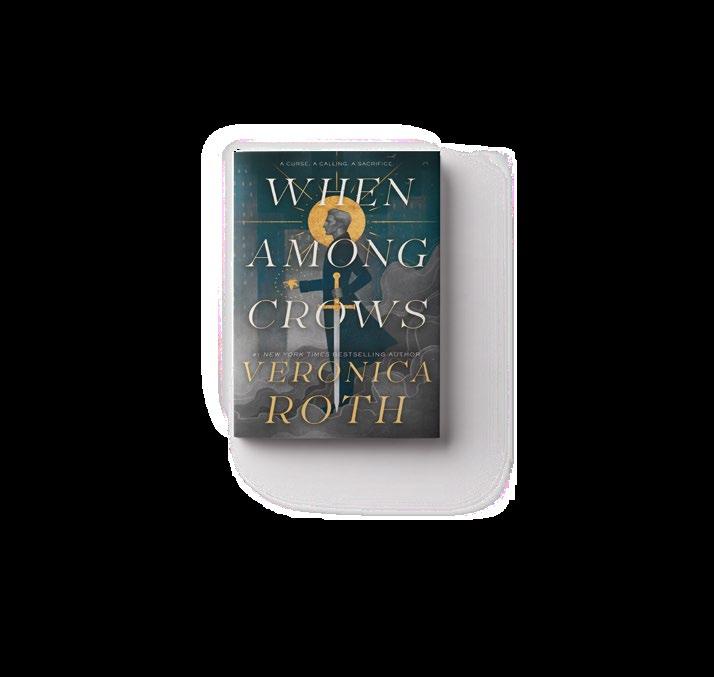






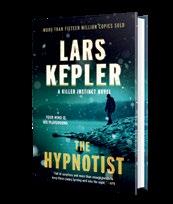
Liev Schreiber will star in the show based on the author’s crime novels.
Lars Kepler’s Joona Linna novels are headed to the small screen.
Apple and A+E Studios are developing a series based on Kepler’s series of crime novels


featuring police detective Linna, Deadline reports.
Kepler, a pseudonym for the Swedish husband-and-wife team Alexandra Coelho Ahndoril and Alexander Ahndoril, launched the series in 2009 with The Hypnotist, which was translated into English by Marlaine Delargy and published in the U.S. two years later. The novel introduced readers to Linna, a determined investigator with a complicated past.
Eight more books featuring Linna followed, including The Sandman and Stalker, both translated by Neil Smith, and, most recently, The Spider, translated by Alice Menzies
and published in the U.S. in 2023.
The series adaptation will be set in Pennsylvania and star Liev Schreiber (The Manchurian Candidate, Spotlight) as the detective, renamed Jonah Lynn. Zazie Beetz ( Joker, Deadpool 2) will play Saga Bauer, an FBI agent, and Stephen Graham (Gangs of New York, This Is England ) will play serial killer Jurek Walter.
The showrunners are Rowan Joffe and John Hlavin. They’ll be joined by the authors, Schreiber, and Beetz as the series’ executive producers.

For reviews of Lars Kepler’s novels, visit Kirkus online.

The show will be the second screen adaptation of Kepler’s work. The Hypnotist was adapted into a 2012 film directed by Lasse Hallström and starring Tobias Zilliacus, Mikael Persbrandt, and Lena Olin. —M.S.


“Rich
a

“A
Hallett, Janice | Atria (448 pp.) | $30
September 23, 2025 | 9781668083536
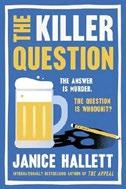
A quintessential British pub, an escalating quiz-night rivalry, and a deeply personal mystery unfold in this clever epistolary tale.
Making a pitch to a Netflix documentary producer, Dominic Eastwood promises a doozy of a yarn when he outlines the first part of the story of his aunt and uncle, Sue and Mal Eastwood. The couple runs The Case is Altered, a cozy Hertfordshire pub known for its community spirit and beloved Monday Quiz. Trivia lovers, including the Plucky Losers, the most regular regulars, treat the quiz with endearing gravity, mirroring Mal’s pride in crafting each week’s questions to be obscure, fair, and challenging. But the arrival of a new team, the enigmatic Shadow Knights, upends the pub’s gentle rhythms. Led by a mysterious figure known only as the General, the Knights dominate quiz night with eerie precision, raising eyebrows among the regulars. Mal is intrigued—can anyone really get every answer right?—while the Plucky Losers’ Chris grows increasingly obsessed with either beating the Shadow Knights or unmasking them. After all, why cheat for a prize that rarely tops £19? Dominic’s pitch to producer Polly takes a darker turn as a text exchange between Mal and a local police officer reveals that a body’s been found in the local waters. The victim, it turns out, was known for cheating at local pub quizzes—a detail that rattles Mal and Sue, especially as deeper ties to their past come to light. As Dominic’s emails unfold, what began as a quirky pub tale steeped in trivia is transformed as repeatedly as a chameleon on steroids.
A masterclass in plotting. Warning to readers seeking emotional footing: The rug will be yanked again and again.
Ramsay, Caro | Severn House (256 pp.)
$29.99 | August 5, 2025 | 9781448314096
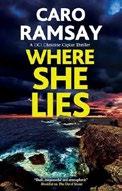
DCI Christine Caplan is flummoxed by an investigation into a family even more dysfunctional than her own.
When Caplan’s daughter Emma’s boyfriend announces the couple’s engagement over dinner, her unemployed son Kenny’s response is to ask his prospective brother-in-law for “a loan of ten grand.” A call about a possible fatality at Torsvaig Castle, an hour or so from her cottage on the coast of Scotland, offers Caplan an escape from the awkward conversation, but not before Kenny’s girlfriend, Jade, chimes in with an excoriating critique of Police Scotland. Once at Torsvaig, Caplan finds a scene that’s hard to process. Famous model Koi McQuarrie has lived there with her husband, photographer Gabriel Samphire, and five adult children, who’d been celebrating the recent success of the castle as a wedding venue. After an evening of drink and dancing, Koi retreated to the castle’s ramparts and vanished. Caplan and her team are faced with the classic police triad: fell, jumped, or pushed? Their inquiry is vastly complicated when Koi’s body, after appearing briefly on the rocks below, disappears. The complex dynamics of Koi’s blended family threaten to eclipse the police procedural, as the mental health needs of her grieving brood thwart all attempts to establish a coherent account of what
happened that night. Ramsay’s richly detailed descriptions of the physical landscape of Torsvaig and of the private landscape of the McQuarrie-Samphires’ inner lives project a brooding melancholy, but the investigation doesn’t really get into gear until the last third of the book. The police turn out to be not at all as inept as Jade claims, though not for want of trying.
For fans who like their mystery with a major dose of misery.
Shimada, Soji | Trans. by Ross MacKenzie & Shika Mackenzie | Pushkin Vertigo (320 pp.)
$17.95 paper | August 5, 2025 | 9781805335153

An eager amateur sleuth solves a series of baffling murders that have confounded Tokyo for more than 40 years. The prolific career of acclaimed Japanese detective novelist Shimada began with this stand-alone whodunit, first published in 1981 and packed with tropes that influenced the genre, in Japan and elsewhere, in the subsequent decades. The theatrical flair possessed by both the killer and the fledgling author is evidenced by the story’s presentation in acts and scenes rather than chapters, along with entr’actes that put an additional spin on the kaleidoscopic plot. (Two of these even features Shimada himself.) The lengthy prologue that introduces the reader to the crimes is the “last will and testament” of a man who says he’s
For fans who like their mystery with a major dose of misery.
THE TOKYO ZODIAC MURDERS
possessed by the devil and who outlines a fiendish serial murder plan. His corpse is discovered in a locked room, but, incomprehensibly, someone implements his plan. The case remains unsolved until it’s tackled decades later by a dynamic duo. Kazumi Ishioka serves as wide-eyed Watson to the Holmes of his pal, astrologer and armchair detective Kiyoshi Mitarai. The Dramatis Personae listing characters in both 1936 and 1979 will help readers keep everyone straight. The overused metaphor of a puzzle is completely appropriate here, since the pieces include multiple first-person accounts across several decades as well as many illustrations: maps, charts and, chillingly, a series of body diagrams that depict the legacy of Azoth in the course of unraveling the mystery. An ebullient mystery classic that foreshadows the subgenre of intricate “how-dunits.”
The Witch’s Orchard
Sullivan, Archer | Minotaur (320 pp.)
$28 | August 12, 2025 | 9781250338686

A private investigator from Louisville, Kentucky, reluctantly takes a job that may be the death of her. Annie Gore has hocked her watch again to pay her bills, so when a young man wants help finding his long-vanished sister, she’s glad to take on the job. Max Andrews has long been saving up for Annie’s retainer, and although her resume mentions Air Force service, college degrees, and private security,
when he meets her, she’s not what he imagined. Max comes from a small North Carolina mountain town; Annie’s own experiences with a battered mother in a similar town make her well aware of small-town secrets and grudges. Max’s sister, Molly, was one of three girls abducted years ago. In each case, an applehead doll was left at the scene. When Jessica Hoyle, the child of a poor family, vanished, her case aroused little interest. A second girl, Olivia Jacobs, was returned two weeks after being kidnapped, perhaps because she’s autistic. Once Molly was taken, an all-out hunt was launched, and the FBI got involved, but neither she nor Jessica was ever found. Annie doesn’t get a warm greeting in Quartz Creek, and poking around doesn’t increase her popularity. The sheriff, who’s Olivia’s uncle, is hostile, but his deputy is willing to help. One of the first people Annie meets is Susan McKinney, who makes potions and reads cards. Some of the townsfolk think she took the girls because she was moved by the tale of a witch who traded apples to the starving mother of two girls and then turned them into birds. Eventually, Annie turns up so many suspects that she’s almost killed in a meth lab fire and narrowly escapes serious injury from a shooter. A tough heroine who refuses to quit uses her own troubled background to crack the case.

The Game Is Murder
Ward, Hazell | Berkley (464 pp.)
$30 | July 29, 2025 | 9780593952443

For more gripping mysteries, visit Kirkus online.
Move over, Anthony Horowitz. First-timer Ward has entered with a whodunit just as playfully meta as yours, though in very different ways. Back in 1974, banker-turned-gambler Lord John Verreman, faced with financial ruin and divorce, sneaked into the basement of his estranged wife’s home and attacked Lady Antonia Verreman with a lead pipe, only to discover that the woman he’d killed in the dark was actually his sons’ nanny, Sally Gardner. At least that’s the story David Verreman tells the guests assembled at the Berkeley Club half a century later to determine once and for all whether or not David and Daniel’s father, who vanished before he could be brought to trial, was really guilty. The 13 guests include DCI Nicholas Blake; coroner Ronald Knox; pathologist Cameron McCabe; Sally’s husband, merchant seaman Stanley Gardner; Antonia’s sister, Carolyn Keene-Wade; and others whose names, like Ward’s chapter titles, pay tribute to the authors and classics of the detective story’s Golden Age. After kicking off with an elaborate contract between The Author and The Reader, Ward keeps interjecting pop-up games along the way and changing the rules of her big game, so that A.N. Author, King’s Counsel, the prosecuting attorney in one part of the story, turns into a witness for the defense in another part. Clues like the putative murder weapon will be analyzed to within an inch of their lives and all parties in attendance will stand accused, singly and jointly, of crimes and misdemeanors before the author pulls one last rabbit from her hat in a denouement likely to be hailed with both surprise and exhausted relief. Hardcore fans entranced by all those Easter eggs may well turn the last page wondering if they’ve missed even more.
A LAND SO WIDE
Craig, Erin A. | Pantheon (368 pp.) | $28 September 9, 2025 | 9780593686805

A gothic historical romantasy that takes place in an imaginary North American coastal region and features frontier-esque hardships, feminist concepts, and truly frightening supernatural creatures.
When you grow up in a town named Mistaken, things don’t always go as planned. Greer Mackenzie is 27 and more than ready for this year’s Hunt, a kind of 18th-century Sadie Hawkins Day in which Mistaken’s unmarried people find future mates. Greer and her longtime beau, Ellis Beaufort, heir to the local bakery, can’t wait for their marriage. Unfortunately, Greer’s father, Hessel Mackenzie, owner of the lucrative lumber mill, has other plans—and, unbeknownst to Greer, so does Ellis. There’s hardscrabble survival aplenty, whether it’s Greer’s friend Louise catching rabbits for her underserved family’s stew or Greer heading off beyond the town’s Warding Stones with a canvas sack containing deer jerky, hand-knit socks, and other provisions to keep her safe in the land of the Bright-Eyed and the Gathered. The Bright-Eyed turn out to be shape-shifting, blood-sucking beasts; the Gathered an isolated group of zombified survivors. No one seems to fully understand this new world, even if the Bright-Eyed have managed to instill fear in both Indigenous people and European settlers. Toward the end, Greer learns more about the origin of the Bright-Eyed. She’s told they’re ruled by a queen who was “intrigued by the idea of a new world, a new continent to see, to explore, to feast upon. She had an insatiable hunger for
more.” Unfortunately, Greer’s story and the background information on Mistaken take so long to tell that once the violence and battles for the souls of humans versus demons begin, it’s difficult to remember that at one point the novel centered on the cruel inequality women in early colonial societies faced. Instead, the action turns to teeth, talons, and turncoats, with an intriguing but strangely unsatisfying strand about how evil came to the shores of a land so bounteous and yet unexplored. Fascinating worldbuilding with a strong and surprising feminist twist.
Haynes, Clarence A. | Legacy Lit/ Hachette (240 pp.) | $29 June 17, 2025 | 9781538768518

A superstar publicist has to contend with the literal ghosts of her past when they attempt to ruin her life in this debut novel.
Gwendolyn Montgomery has it all: the nice apartment, the fancy clothes, the perfect job, and she’s just recently begun dating James H. Watson, who just might be the man of her dreams. So when terrible things start happening at all of her events, with a clear message that they’re intended for her, she knows the past she’s been running from might have caught up with her. Across town, Fonsi Harewood, shop owner and medium, is informed of a breach between the world of the living and the world of the dead that will come to a head very soon. In order to stop it, he needs to find help from someone more powerful, someone who can manipulate the worlds
themselves, while also dealing with the love triangle he’s found himself in with his ex-boyfriend and an attentive ghost. Together, Gwendolyn and Fonsi might be either the team that can save the world or just watch as it burns. Haynes has created a mystical, sensuous, dangerous world of spirits and power while also making characters that feel three-dimensional and knowable. Friendships feel real; family problems have the weight of generations of fights and secrets behind them. Like the best fantasy novels, there is room for a million more stories to be told, to see how things progress after the last pages with both the characters and the world itself. There are twists and turns, but everything is grounded in a sense of reality, impressive for a world steeped in spirits. This is a strong debut for a new, interesting voice with things to say.
A smart, sexy story filled with ghosts, history, and resilience.
Morgan, Louisa | Redhook/Orbit (528 pp.) | $19.99 paper September 16, 2025 | 9780316585118
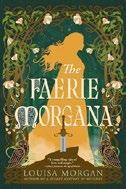
The great sorceress Morgana takes center stage in Morgan’s retelling of the legend of King Arthur. When Morgana’s mother, the queen of Lloegyr, remarries after the death of the king, Morgana is sent away to be raised on the Isle of Apples with the mysterious priestesses called “the Nine.” Morgana is one of many acolytes, young girls who are sent as tribute to live with the Nine and taught to make medicinal products and magical charms to help the people who come to the temple for help. Few of them have any real magical ability, but Morgana is different. Objects move at her demand; her potions and charms are potent; her ability to scry into the future is more impressive than any of the Nine. The Blackbird, a powerful sorcerer and the only man who works with the Nine, and Braithe, a young acolyte with no
magical talent of her own but a fierce loyalty to Morgana, are Morgana’s only friends, as everyone else fears her for her prodigious magical talent. Morgana’s greatest ambition is to help her half brother, the kind and benevolent Arthur, reign as true king of Lloegyr. But when Arthur brings home his bride, the beautiful Gwenvere, Morgana knows something about the new queen is very, very wrong. Gwenvere seems to have some kind of dark magical ability to confound the men around her, and when it becomes clear that there is more to Gwenvere’s violent temper than just human cruelty, Morgana will have to stop her before she destroys Arthur’s reign. Morgan’s atmospheric writing is well suited to retelling this ancient legend. The long novel sets a clear character arc for Morgana as she learns the value of working with her allies and trusting the wisdom of others instead of relying on her own power. Morgan sticks to Arthurian legend and European mythology, but both those wells are so deep and varied that readers have no way of knowing how Morgana’s mission to save Arthur will turn out.
An effective King Arthur retelling that focuses on an often neglected female character.
Rodriguez, Jose M | Flare Books/ Catalyst Press (384 pp.) | $21.95 paper October 7, 2025 | 9781963511215

A woman kidnapped by invaders dreams of angels, demons, and more otherworldly creatures.
Debut novelist
Rodriguez unloads a truckload of nightmares in a baker’s dozen worth of stories, enveloped in a weird, circular narrative. When Betty Hill is abducted by little gray men, she’s sure she’s gone around the bend and will wake up back in the 1960s. To her horror, she learns that they’re really hyperevolved humans who left Earth to travel through space
and time. Unfortunately, her recruitment as savior of the human race opens her up to all sorts of alternative stories playing out across dimensions and, as it turns out, in her mind. Leaning mostly into science fiction, questions of faith, and the nature of humanity, the stories that spin out in Betty’s mind are shocking, imaginative, and messy. Many deal with societal conflicts, ranging from sexuality and identity in the opener, “Gender Reveal,” to a creepy caste system for teens in “Five Hives.” You wouldn’t go amiss thinking you’re watching TV under the influence via several stories about cops where past and future police officers tackle everything from the horror of confronting human evil in “Crazy Shark” to takes on racism and authoritarianism in “Sunday Funday” and even a shot at Minority Report in “RCPD: Reincarnation Pre-Crime Division.” Most of the stories lean pretty dystopian, but the heightened absurdity provides a welcome break in the tension. “Untitled YouTube Commercial” is one of these throwaway gems, satirizing web grifters and hustle culture, while “The Council” uses biblical and epistolatory tradition to Behind the Music the Bible. After a grand tour of fantasized futures, Rodriguez eventually brings us back around to Mrs. Betty Hill—yes, that Betty Hill, for you alien abduction truthers—and closes the circle with one more reveal.
Let’s twist again: a chaotic first effort laced with surreal shades of Philip K. Dick and other unusual suspects.
Wong, Michelle | Harper Voyager (464 pp.) $34 | August 5, 2025 | 9780063446250

Wong debuts with a dark and unpredictable story, valiant worldbuilding, and a troubled protagonist who fights like hell.
Alma Ben is the rage-filled bastard child of an aristocrat of House
Avera—one of the four noble lineages in Kugara possessing the abilities of the gods. But Alma, raised by her outcast single mother in the countryside, doesn’t know of her station, and has a lonely and isolating childhood, often conjuring an imaginary friend for comfort. When her mother falls terminally ill, Alma manages to send word to her unknown father begging for help, and is met with a powerful vessel of the Dread Beast—the god of death. In exchange for her mother’s healing, Alma agrees to serve House Avera in support of her father’s ascension to First Hand of the Beast, and the girl is whisked away by her father while her mother lies dying. Unaware of nearly everything about the gods and the families bound to them, she discovers the first step in service to the House and its deity is severing her arm in sacrifice to the Beast. Despite her actions, her mother dies, but Alma is forced to continue serving her father’s ambitions anyway. As her grief rages and her father’s betrayal is palpable everywhere in the Avera estate, the flames of revenge are fanned by her once-imaginary friend, Aster, who reveals himself to be so much more—a spirit that’s taken on human form. With Aster as proof of her strong connection to the Dread Beast, together they devise a plan to prove her worthiness as a vessel of the Beast and challenge her father’s rank. All that’s required is that she train for a Pilgrimage to the umbral plane—a twisted alternate dimension filled with monsters and terror—to kill a star and rise in rank to become the First Hand of the Beast herself. From the opening pages, with Alma’s arm strapped to a fountain and her father standing overhead with a sword ready to give her limb as an offering, the prose strikes hardest when Wong writes visceral body horror. This page-turning epic continually exposes the monster within each character, pushing them to confront it head-on and fight relentlessly for the good they possess deep within.
An impassioned story about rage, revenge, and how love can lay it to rest.
Kirkus Star
See You at the Finish Line
Hammett, Zac | Zando/Slowburn (336 pp.) | $18 paper | September 2, 2025 | 9781638933311

Lucas wants to land the boy of his dreams. George wants people to see him as more than a hot jock. They’re not exactly enemies, but despite sharing a boat on the Cambridge University rowing team, they don’t quite see eye to eye, either. After they lose an important race due to George’s bad call, Lucas is overheard criticizing his teammate, an American student imported for his athletic prowess, saying he’ll never be able to pass his exams. Unfortunately for George, that’s true. And unfortunately for both of them, they’re the only two rowers studying economics. Lucas has no motivation to help George until the hapless himbo stops a very drunk Lucas from embarrassing himself in front of Amir, the boy he’s been crushing on all year. With his defenses down, Lucas proposed a deal: He’ll help George pass his exams if George helps Lucas land Amir. Initially, Lucas assumes they’ll have to cheat, but as the two grow closer he realizes that George has been underestimated and is smarter than anyone gives him credit for. As George is teaching a very shy Lucas the art of seduction, the two men share a kiss that changes their relationship from one of near hostility to a more intimate friendship. Lucas’ cynicism and sharp edges work well to complement George’s sweet nature, like a cup of strong coffee with a sugary pastry. This sweet, slow-burn romance will appeal to readers who loved Casey McQuiston’s Red, White & Royal Blue (2019), but the dynamic setting and crisp banter in Hammett’s impressive debut are totally his own. A swoony, unputdownable story with an unconventionally satisfying happily-ever-after.
Maura, Catharina | Forever (320 pp.)
$32 | October 28, 2025 | 9781538772973

In this Beauty and the Beast –inspired dark fantasy romance, a princess who possesses dangerous magic is forced into marriage by a cursed emperor to save his kingdom.
Theon Felix Osiris, known as the Shadow Emperor of Eldiria, is desperate to save his kingdom from doom. With her dying breath, Felix’s mother cursed him and his father’s lands, having been forced into marriage and kept captive. Black, poisonous veins spread across his body, a sign that he may suffer his father’s fate—to slowly rot away. As he fights to stave off the encroaching ice and darkness that threatens to starve and freeze his citizens, his only hope rests in a prophecy that a union between him and the Princess Arabella of Althea will break the curse. There’s only one catch: The union must be made for love. Ignoring that little detail, Felix forces Arabella into marriage by threatening to conquer Althea. Arabella’s father is all too happy to marry her off. Magic is forbidden in Althea, and Arabella’s mysterious powers have made her a pariah. There’s a dark undertone to this romance; Arabella is very much a prisoner, and Felix is repeating his father’s mistakes. Consent is dubious at best. The worldbuilding and character development start out strong; the supporting cast enlivens the frozen wasteland setting and adds depth to Felix’s singular goal, making the perfect fodder for future installments. Sadly, though, the momentum stalls, halting a promising start. Felix’s boasts about the
A
danger and violence he’s capable of become rote once they surpass a dozen. The romance, while steamy and possibly tempting for fans of alpha heroes, is ultimately uneven and tedious. A dark and mysterious tale that winds up spinning its wheels with repetition.
McFarlane, Mhairi | Avon/ HarperCollins (384 pp.) | $18.99 paper October 7, 2025 | 9780063292574
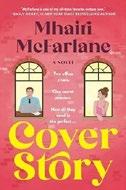
An investigative reporter and her office’s new intern must pose as a couple to get the scoop of a lifetime. Award-winning podcaster Bel Macauley recently joined the staff of a prominent British newspaper, but she’s tucked away at its small Manchester office. Her only coworkers are fellow journalist Aaron Parry and a rotating cast of interns. Things quickly sour with newest intern Connor Adams, who’s in his early 30s and is looking for a career pivot from finance to journalism. Bel is surprised that they’re around the same age, and her dealings with Connor often make him feel patronized. Meanwhile, Connor writes Bel off for her unprofessional outfits and has a chip on his shoulder when it comes to women due to his crumbling relationship. When Bel uncovers evidence that Manchester’s mayor is exhibiting predatory behavior toward young women and Connor accidentally jeopardizes her surveillance operation, she’s forced to do some quick thinking and introduce him as her boyfriend. With Connor now officially roped in, the two take on the assignment together while maintaining their fake romance. Both
COVER STORY
characters are prickly, which leads to some sizzling banter and adds an enemies-tolovers element to the story, but there are times when things skew more mean than moody. Connor’s early judgments about Bel feel indicative of a larger distaste toward women, an off-putting introduction to the character that takes quite a bit of time to redeem. McFarlane’s romances, such as You Belong With Me (2024), tend to feature darker elements, and this is no exception, with themes including suicide and stalking. The journalism story adds great tension, and the scenes of Bel and Connor working to collect evidence are some of the most compelling in the book—more so than the romance. That being said, readers may feel disappointed that not everything in that plotline wraps up neatly.
A slow-burn romance with some topical, though unfulfilling, suspense.
The Princess and the P.I. Payne, Nikki | Berkley (480 pp.) | $19 paper September 16, 2025 | 9780593817360

The obedient daughter of a Ghanaian church leader teams up with a Maryland private eye to beat a murder charge. Normally diffident Fiona Addai wants to exact revenge on the company that stole her late brother’s tech invention. But her attempt goes awry almost immediately as the company’s owner is murdered in her vicinity and she is caught with damning evidence. Enter Maurice Bennett, an ex-cop and current private investigator who has been haunted by an unsolved case involving Fiona’s father’s
megachurch. Is Maurice bailing Fiona out to help her or to find dirt on her dad? Payne’s foray into romantic suspense starts with a high-stakes tech event and a backstory about Fiona’s family dynamics and the cultish church she has been serving. Add to it Maurice’s demons about his failure to help a young woman escape that church, plus the ugly end of his police career, and the narrative feels like it’s being pulled in several different directions. The plot gets further crowded with other characters and connections between the corporate espionage plot and the religious Mafia one. Villains abound, including Fiona’s sister, her brother’s former lover, the publicist for the tech firm, a second-in-command at the church who keeps leering at Fiona, and Maurice’s ex–best friend on the force. There is also a scene at a sex party, a break-in at the tech office, a fight on a yacht, and a confrontation during a church service. The sequence and timeline of the scenes is confusing and the trail of murders, suspects, and motives hard to follow. Erotic in parts but the suspense plot lacks narrative coherence.
West, Kasie | Saturday Books (368 pp.) | $19 paper | September 16, 2025 | 9781250349149

Can a meet-cute happen on a dating app?
At 27, Margot Hart has had her fair share of dating-app fails. As the assistant to Robert Bishop, Los Angeles’ top literary agent, all she wants is to work with
romance novels, but her own last memorable date was three years ago with a software engineer named Oliver. After an awkward dinner and unforgettable make-out session in a car, Margot and Oliver continue to find each other on the apps and swipe right to joke about their terrible date and harmlessly flirt. Margot hasn’t been completely celibate since then; in fact, she’s been occasionally sleeping with her divorced yet emotionally unavailable boss. While her secret relationship with Rob weighs on her conscience, she can’t help craving this excitement in her otherwise lame dating life. Yet seeing Rob has its major lows—especially since she’s spent years without a promotion and opportunities to be an actual agent. When Margot finally works up the courage to confront Rob and he shoots her down, she takes a leap of faith and quits her job in hopes of starting her own agency. And if that wasn’t courageous enough, she decides to offer Oliver a second chance and turn their intermittent flirting into the real thing. It turns out that Oliver’s gotten better with age: He’s sweet, put-together, and undeniably hot, but Margot can tell something from his past is holding him back from taking their relationship to the next level. Can Margot balance the unknown trajectory of her career while falling hard for Oliver, or will she face yet another failure? YA author West has made a successful transition into adult fiction, maintaining all the charming, quirky qualities of YA while upping the romance factor. Margot is the likable sort of hot mess, and readers will empathize with her underdog sense of self-deprecation and root for her success. And of course, Oliver is a mix of swoon-worthy, shy, and sexy—every main character’s dream love interest. West’s adult debut is everything— vulnerable, spicy, funny, and squeal-out-loud romantic.



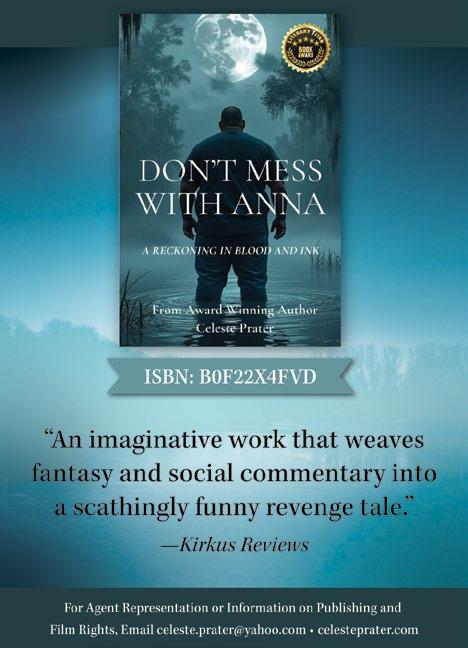



EDITORS’ PICKS:
Then There Was One by Wendy Cross (Puffin/Penguin Random House UK)
The Burning Season by Caroline Starr Rose (Nancy Paulsen Books)
Is a River Alive? by Robert Macfarlane (Norton)
The Doorman by Chris Pavone (MCD/Farrar, Straus and Giroux)
THANKS TO OUR SPONSORS:
Chemistories by Maya Mourshed
Beyond Australia by Lee Forrest
The Three O’Clock Calls by Tom Smith
Fully Booked is produced by Cabel Adkins Audio and Megan Labrise.

To
A debut novelist artfully depicts the slings and arrows of young adulthood. BY MEGAN LABRISE
On this episode of Fully Booked , Naomi Xu Elegant joins us to discuss Gingko Season (Norton, May 20), the story of a 25-year-old woman trying to find her footing—socially, politically, romantically—in modern-day Philadelphia. Kirkus calls Elegant’s heady debut “beautifully wrought.”
Elegant is a writer and journalist living in New York City. Her work has appeared in Monocle, Fortune, Atlas Obscura , Nikkei Asia , The Drift and elsewhere. She is the co-editor of the independent literary magazine Gully and writes the monthly newsletter luanqibazao
Here’s a bit more from our review of Gingko Season : “Penelope Lin, who grew up in Beijing, loves Philadelphia, the city she calls home. She’s passionate about her job at a museum, where she gets to research foot-binding practices and handle historical relics. Some good friends from college live nearby, and she has roommates she likes as well. By chance, she meets a young man she’s drawn to, but even as their connection deepens, she pines for another chance with her ex-boyfriend. It’s the fall of 2018, two years into the first Trump administration, and the midterm elections are coming up.… Penelope and her close friends don’t always agree on politics or what they should be doing with their lives as they approach their mid-20s, but they share their points of view and grapple with choices around careers and dating.…The story is narrated by Penelope, and debut author Elegant writes long, rhythmic, fluid sentences. She and her protagonist are tuned into the five senses, making the book’s descriptive paragraphs a pleasure to read.”



Elegant, Naomi Xu Norton | 264 pp. | $19.99 May 20, 2025 | 9781324086147
Elegant and I dig into the experience of writing her first novel, how she developed Penelope’s voice, and why she chose to endow her protagonist’s best friends with big personalities. She talks about drawing inspiration from personal experience, as well as from research—including a college course in which she and her fellow students visited the Penn Museum and handled Qing Dynasty artifacts. We discuss Gustave Flaubert, Marcel Proust, Liang Sicheng, Lin Huiyin, and Elegant’s abiding love of Philadelphia. Then editors Laura Simeon, Mahnaz Dar, John McMurtrie, and Laurie Muchnick share their top picks in books for the week.
Editor-at-large Megan Labrise hosts the Fully Booked podcast.
WHEN EUROPEANS arrived in North America in the 16th century, one-fifth of the continent was covered by grasslands. Roaming the treeless Great Plains, Spanish troops routinely got lost in what they called a “sea of grass.” The name stuck. But those grasslands are threatened today. The sea of grass has largely become a “sea of crops,” write Dave Hage and Josephine Marcotty in their superb exploration of the region, Sea of Grass: The Conquest, Ruin, and Redemption of Nature on the American Prairie (Random House, May 27). “The western shortgrass prairie, in states such as South Dakota, Montana, and western Kansas, is disappearing at the rate of one million acres a year as farmers plow up grass to plant corn, wheat, and soybeans,” they explain. “That’s an area the size of Connecticut disappearing every three and a half years. With little notice, these grasslands are vanishing faster than the Amazon rainforest.” Sea of Grass also documents how multinational food manufacturers and agrochemical corporations have been polluting the land. In fact, agriculture
has supplanted industry as the country’s leading source of polluted river water. “As a result,” the authors write, “hundreds of communities across the Corn Belt have water that is unsafe to drink.”
Several other new books take the measure of an often-overlooked America—areas not unlike those that William Least Heat-Moon toured in his celebrated 1982 travel book, Blue Highways James Dodson, who has written numerous books about golf, walks far longer than any 18-hole course in his latest work, The Road That Made America: A Modern Pilgrim’s Journey on the Great Wagon Road (Avid Reader Press, July 1). The Great Wagon Road is a

centuries-old trail that extends from Pennsylvania to Georgia. “The Great Wagon Road is probably the least known historic road in America,” Dodson writes. Once a Native American trail, it later served immigrants moving out of Philadelphia. The author encounters a historian who speaks of new arrivals to the region: “The good news,” he says, “is that many of the migrants we see coming here from Central and South America are hardworking folks eager to make a living.…This is a place that has welcomed immigrants for hundreds of years.”
In his first book, Stephen Starring Grant hits the road for work. A graduate of the Iowa Writers’ Workshop, Grant chronicles his life as a Blacksburg, Virginia, letter carrier in Mailman: My Wild Ride Delivering the Mail in Appalachia and Finally


JOHN McMURTRIE
Finding Home (Simon & Schuster, July 8). Grant celebrates the landscape and takes pride in providing a public service: “When I carried the mail I was never just me, but something much larger.”
On the other side of the country, first-time author Josh Jackson makes a pilgrimage to what some call “leftover lands.” While many flock to California’s national parks, often forgotten are the state’s 15 million acres that are managed by the Bureau of Land Management. Jackson writes about them thoughtfully—and includes his lovely photographs—in The Enduring Wild: A Journey Into California’s Public Lands (Heyday Books, June 24). Campers don’t need reservations to stay on the land, and this book just might have readers packing their gear: The great outdoors awaits.
John McMurtrie is the nonfiction editor.


A prize-winning writer’s anguish.
Thomas bravely recounts the pain he suffered as a young victim of violent crime and the “madness” that befell him after the publication of his first novel. He was 7 when he was raped near his Boston home. He burned the clothes he was wearing, then shouldered the emotional scars in secret, cutting himself “to feel and to bleed.” As a literature professor, words are his tools, but being raped is “something I can neither interpret nor render. There’s nothing metaphorical. It is real: sweat, semen, and blood.” Without self-pity, he recounts his “self-medication” and alcoholism and recalls being targeted by
racist police, his arms damaged by “violent handcuffings: walking while Black, driving while Black.” (Thomas now regards his debut Man Gone Down , about a Black man beset by bad fortune, as a sort of “suicide note.”) After it received the International IMPAC Dublin Literary Award in 2009 and earned him “quasi-celebrity,” Thomas, grieving his father’s death and managing a fraught relationship with a brother he’d bailed out of jail, felt “confused” and “helpless.”
He retreated from the world, spending two weeks in a “dark, cramped” crawl space in his Brooklyn house and later seeking help at a psychiatric hospital. In a masterfully understated

Thomas, Michael | Grove | 380 pp. $28 | August 5, 2025 | 9780802120144
scene, an encounter with a stranger in need proves crucial: “I knew I had to live.” Elsewhere in this gutsy book, Thomas uses Fenway Park as a backdrop for a discussion of bigotry in Boston in the 1970s and ’80s. “My country wants me dead,” but our racial problems are much deeper.
“Most American notions” about race “are insane.” Thomas believes that one way to keep “from falling into darkness” is to try “to make something beautiful.” This book hits the mark.
A powerful memoir of childhood trauma, literary success, and mental illness.
Agha, Hussein & Robert Malley | Farrar, Straus and Giroux (272 pp.) | $30 September 16, 2025 | 9780374617127

Hard lessons from decades of Middle East diplomacy. Reflecting on their long-term efforts to reduce violence between Israelis and Palestinians, Agha, a scholar who has represented the latter in peace talks, and Malley, a veteran of the last three Democratic presidential administrations, pen a doleful epitaph for the so-called two-state solution. The authors started their careers hoping to help establish “a single entity in which Jews and Arabs would coexist as equals.” Eventually, they yielded to “what appeared at the time the more realistic and pragmatic objective”—a Palestinian state bordering Israel. But Hamas’ Oct. 7, 2023, attacks on Israel—and Israel’s ongoing counterattacks in Gaza—have muted such ideas. The best the authors hope for today is that peace negotiators consider “a departure from convention,” one that would neither accept the current carnage nor impose one- or two-state compromises doomed to failure. They offer several alternatives. Among the most concrete are a truth and reconciliation process and the establishment of “a Jordanian-Palestinian confederation.” Such a link “has historical antecedents” and might help address an otherwise intractable dispute: “What Israelis would not hand over to a Palestinian state, they might grant a joint entity headed by Jordan.” While looking ahead, the authors offer a riveting insiders’ account of high-stakes statesmanship. Then–Secretary of State John Kerry brought unequaled “passion and enthusiasm” to the negotiations, but his work was for naught, in part because his boss—President Obama—didn’t leverage the billions of dollars in U.S. military aid that goes to Israel to forge lasting peace. Past Palestinian leaders were often
chided for “never miss[ing] an opportunity to miss an opportunity,” but the authors, looking closely at peace talks since the 1990s, demonstrate that this is a major oversimplification.
A fascinating postmortem of failed statesmanship in a fraught region— and a guarded plea for new ideas.
Andrew, Mari | Penguin Life (256 pp.)
$29 | July 15, 2025 | 9780593831663

Of mice and men. This book at first appears to be a catalog of anthropomorphisms, the assigning of human qualities to animals they don’t necessarily possess. Indeed, the author freely engages in this practice throughout. Up front, the author admits she took “liberties” with facts, “blending timelines, reimagining figures, and walking the line between fact and myth.” She says she wrote the book to focus on humans’ similarities with animals because this is rarely done. But entire fields have, for decades, focused on human similarities with other animals. (See the science of genetics, primatology, anthropology, evolutionary psychology, cognition, et al.) Even so, the book is strewn with surprisingly luminous pearls of wisdom, given that they were gleaned from a life, it transpires, filled with loss and illness. In her 20s, a death and a breakup sent her reeling. To cope, this author/artist began posting online a doodle a day. Quirky and earnest, her art and words went viral, leading to a book. In this, her latest work, the new focus on animals does become clear. When she served as a lay chaplain to the dying, it was only when she stopped trying to help them, and just sat with them, that she succeeded. “The role of the chaplain is to hold hands in the dark, not to search
around for a flashlight.” She grasped viscerally, then, why the nonverbal feedback of sensitive, quietly accepting animals like horses can heal traumatized patients. She came to admire many animals—including, notably, rats. By the end, she convinces us with the power of her own story. Animals and humans share key qualities, including, despite the hardships of life, an enduring capacity to take joy in it.
An engaging book that offers life tips many readers will find inspirational.
Andrews, Kehinde | Bold Type Books (352 pp.) $30 | September 9, 2025 | 9781645030706

An extended argument on Malcolm X’s teachings as a template for Black liberation. British academic and activist Andrews holds that Malcolm X has been subjected to mythical treatment from the time of his assassination on: He has been portrayed as “dangerous Malcolm made safe” by virtue of, among other things, his rejection of some of the Nation of Islam’s more extreme tenets, including its unbending view that white people were incapable of redemption, while he “did leave open the possibility of White people being involved in the struggle.” Andrews paints with a broad brush in condemning the authors of the myths surrounding Malcolm, among whom he names Black intellectuals and writers, including Spike Lee, Manning Marable, Cornel West, and Alex Haley. Similarly, he scorns the Civil Rights Movement as led by Martin Luther King Jr. and Bayard Rustin, holding that revolutionary struggle for liberation alone could achieve equality: “Malcolm didn’t believe we should rely on White people (e.g., affirmative action) because the Western system was incapable of providing justice for Black people.” Andrews’ disdain for the civil rights
approach extends to such efforts as the New York Times’ 1619 Project, calling lead editor Nikole Hannah-Jones “a witness, and so we should not embrace the solutions she has offered, especially when they involve draping yourself in the American flag—as though this could ever offer some kind of protection.” Andrews’ ad hominem observations make this a slog. He can also be repetitious, hitting several times, for instance, on Malcolm’s views of race less as biological fact than as a political construct. (As Malcolm said, “White is an attitude....”) This diminishes the author’s project of identifying the enduring lessons of Malcolm X’s legacy and how to put them into action. Of some value as a treatise on Black revolutionary thought.
Kirkus Star
Gales of November:
Bacon, John U. | Liveright/Norton (432 pp.) $35 | October 7, 2025 | 9781324094647

Remembering the Mighty Fitz , half a century later. Bacon, author of The Great Halifax Explosion, offers a superb education in geography, seamanship, and history to tell the story of the gigantic Great Lakes ore carrier that sank in a 1975 storm, killing all 29 crew members. He opens with an overview of the Great Lakes, whose waves and currents turn out to be as nasty as those in salt water. Between 1875 and 1975, they claimed at least 6,000 ships and 30,000 sailors—averaging one shipwreck a week. As Bacon writes in arresting prose, “These freighters battled waves twenty feet or more, faced eighty-mile-per-hour winds, and crashed into lighthouses, ports, piers, bridges, shoals, jagged shores, and each other. They faced fires and explosions onboard, hundreds of tons of ice weighing their ships down, water flooding into their pilothouses and cargo holds, and fog, the
one element that could make even the most seasoned mariner stop in his tracks, praying for luck.” Narrowing his focus, Bacon describes the mines of Minnesota and Wisconsin that required massive carriers to transport their ore south to refineries in Chicago and Buffalo and points in between. The carriers were designed primarily for profit (carrying the maximum load) and to pass through narrow locks leading from Lake Superior to Lake Huron. Designers paid less attention to their ability to handle the Great Lakes on bad days. Since no crewman survived, details of the disaster are spotty, but Bacon makes the most of them, delivering biographies of crewmen, their duties, descriptions of the storm, increasingly fraught messages from the Fitzgerald before they ceased, interviews with victims’ families, and a discussion of the lessons learned. The author makes the Fitzgerald the centerpiece of a broad account of Great Lakes shipping, the careers and daily lives of the crews—and the industries, cities, and bars that feed them—and tales of other sinkings. A gripping account of a maritime disaster.
Ballard, Maddie | Illus. by Emma Dai’an Wright | Tin House (144 pp.) | $19.99 October 21, 2025 | 9781963108484
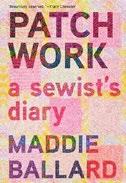
Fashioning a self. In her lyrical book debut, journalist Ballard gathers 17 essays reflecting on the pleasures and challenges of sewing. Illustrated by Emma Dai’an Wright, each chapter recounts Ballard’s construction of a specific garment, from her first try at making a simple shift to more complicated pieces: pants with a fly, a turtleneck, a slinky, bias-cut slip dress, and a modernized version of a cheongsam (a traditional Chinese dress). Noting the kinds of fabrics, threads, and patterns she uses, Ballard considers “hard questions” about sustainability, questions
that too often are ignored when buying ready-made clothing: “Where, how, and by whom was the fibre grown or produced? Who dyed and finished the textile, and did the process compromise their health? How did the fabric get to me? How many times will I wear the garment I’m making?” Choosing what to sew leads her to think about her body, about beauty, and about her identity as a young biracial—Chinese and white— woman. When she decides to make her own cheongsam, she feels uncomfortable, as if she is performing an inauthentic self. Life changes alter her connection to sewing—a bout with Covid-19, a breakup, quitting her job. Raised in New Zealand, she is living with a partner in Auckland; when that relationship ends, she moves in with her beloved grandmother. Then she leaves for Wellington to take a master’s degree in creative writing. Throughout, her sewing sustains her: “Like gardening,” she writes, “sewing is an investment in the future,” in the physical and emotional transformations she is bound to undergo. Sewing serves as “a kind of productive daydreaming: Maybe I could feel this way, if I made this garment for my body. Maybe I could be this kind of person.”
A graceful meditation on creativity.
Belson, Ken | Grand Central Publishing (336 pp.) $30 | October 14, 2025 | 9781538772553
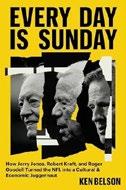
The league that’s too big to fail. Football diehards and casual fans alike will find plenty of interest in this dexterous blend of analysis, character study, and behind-the-scenes color. The New York Times ’ Belson opens with a stunning fact: “Seven players from the 2001 New England Patriots”—Tom Brady’s first Super Bowl season—“died
while generating ever-greater revenue.
EVERY DAY IS SUNDAY
before they passed fifty years old.” The long-term impact of the game’s violence causes public relations nightmares for the NFL, but as Belson shows, Patriots’ owner Kraft, Dallas Cowboys’ owner Jones, and league commissioner Goodell have become adept at weathering scandal while generating ever-greater revenue. “Social chameleon” Kraft and Jones, who employed his “haphazard speaking style” when likening negotiations with the players’ union to an owl and a chicken having sex, shared a goal. “The league’s two most powerful owners” were “desperate” to settle big debts incurred when buying their teams, Belson writes. Jones built a showcase stadium and aggressively sold marketing rights, urging other owners to follow. Kraft, “the closer” in a pivotal labor deal with players, also cleaned up messes. After the league botched its reaction to player protests about police violence against Black people, Kraft burnished the NFL’s image by forging a high-profile partnership with Jay-Z. “Once again,” Belson writes, the league fixed “a crisis by throwing its money and marketing muscle around.” The NFL’s cash grabs can be brazen. One stadium has been renamed eight times by a parade of companies that bought the rights. By 2027, the league could meet Goodell’s annual revenue goal of $25 billion. Run by self-styled free marketeers, the NFL resembles “a socialist collective,” with TV deals guaranteeing each owner $400 million a year. Alongside user-friendly financial reporting, Belson shares funny anecdotes about owner pettiness, vanity, and arrogance. A knowledgeable, entertaining account of a sport’s seemingly unstoppable growth.
Bonét, Sasha | Knopf (320 pp.) | $30 September 16, 2025 | 9780593536087

Honoring Black matriarchs. Cultural critic Bonét makes her book debut with a fervent homage to Black women— grandmothers, mothers, sisters, and cousins—who have instilled an indelible life force in their families. “I was surrounded by reliable women,” Bonét writes. “The men were peripheral—inefficient and fickle.” Central to her history is her grandmother Betty Jean (b. 1933), the great-granddaughter of enslaved people, who migrated to Houston from Louisiana in 1955 and eventually had 11 children with nine different men. One of those children was Bonét’s mother, Connie (b. 1956), who grew up poor and angry, resenting each new baby who arrived to deplete what little the family had. She fled Houston as soon as she could, landing in Manhattan, where she was a stern, uncompromising mother to her own children. Besides recounting the lives of the women in her family, Bonét looks at other Black women: Betty Davis, enslaved seamstress of George and Martha Washington, whose daughter, Ona Judge, escaped and lived in the north as a fugitive; Marian Robinson, Michelle Obama’s mother, who moved into the White House to care for her granddaughters; and activist Recy Taylor: Raped by white men in 1944, she contributed—along with Rosa Parks and other women—to forming the Committee for Equal Justice, an inspiration for the Civil Rights Movement. There’s Iberia Hampton, who feared for
her outspoken son, Fred; he became a Black Panther and was assassinated. There’s artist Camille Billops, who rejected motherhood in favor of pursuing her art. “Each of us are the sum of our grandmother’s prayers,” Bonét writes, “the sum of many moments, of all the care and cruelty we have absorbed.” At times tender, furious, selfish, and sacrificial, these were “complicated women,” whom Bonét portrays with compassion. A fresh contribution to Black history, rooted in the author’s past.
Bottum, Roddy | Akashic (272 pp.) | $27.95 November 4, 2025 | 9781636142692

A n alt-rock sideman recalls navigating queerness, heroin, and a now-vanished San Francisco bohemia. Bottum could easily have delivered a memoir heavy on name-dropping and celebrity dish: He was a songwriter and keyboardist in Faith No More, a funk-punk outfit that enjoyed unusual success in the late ’80s, as MTV segued from hair metal to the punk revival. The band toured heavily, and Bottum was close friends with Hole frontwoman Courtney Love (who briefly fronted Faith No More) and her husband, Nirvana’s Kurt Cobain. Instead, Bottum opts to tell a more intimate and much richer story, where details about fame are secondary to his desperate search for a found family. Growing up in Los Angeles, he chafed against middle-class convention, a feeling that intensified once he acknowledged he was gay. Moving to San Francisco, he found a community and a band, and much of the book’s best writing reflects an urge to capture the disappeared landmarks of his youth, from group houses to hole-in-the-wall clubs. (“Names like these no longer exist. These spaces don’t exist. The impetus to create them doesn’t exist.”) But it’s also where he discovered heroin, and his habit only intensified as Faith
No More’s fortunes increased. So Bottum’s predominant feeling about success is revulsion: He witnessed rampant misogyny when his band opened for Guns N’ Roses and saw how the stress of fame fed Cobain’s drug habit and led to his eventual suicide. There are places where Bottum is overly strenuous about avoiding rock-memoir convention (he seems allergic to sharing last names), and the prose is sometimes clotted and pretentious. (“We heralded loudly in a cacophony of strength and powerful prowess.”) But Bottum’s candor is refreshing, and the book serves as a vibrant snapshot of a time when San Francisco was better known as a creative haven than a tech-bro bunkhouse. A melancholy tribute to punky, grassroots community-building.
Bradford, Richard | Bloomsbury Caravel (384 pp.) | $32 September 9, 2025 | 9781448218097
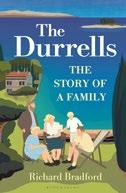
Portrait of a dysfunctional bunch. Bradford’s biography refers to the eponymous family most familiar to Americans for the bestselling book and subsequent TV series, My Family and Other Animals. Set on 1930s Corfu, it offers a cozy portrait of an eccentric family through the eyes of a 13-year-old boy in love with zoology. No animal, snail, or bug, however, crawling from beneath a slimy rock, can match the repugnance of the family as depicted by Bradford. Originally from colonial India, the family struggles with the modern, egalitarian world. The mother, Louisa, was placed in mental institutions when not retiring to her bed with a bottle of gin. Leslie, the middle brother, became a farmer in Kenya before skipping the country after embezzling money from fellow settlers. He died alone, in dismal circumstances, having no contact with his two writer siblings. The bulk of the
biography concerns Lawrence Durrell, best known for The Alexandria Quartet. He was once considered a contender for the Nobel Prize for Literature, but Bradford faults the writer for his modernist pretensions and self-aggrandizement. Bradford portrays the author as a spoiled, alcoholic wife beater, whose daughter hanged herself because of his sexual predations. Gerald, the more popular author, worked to promote a more enlightened view of animal rights. His wildlife trust, funding a zoo on the island of Jersey, was opened by David Attenborough, but the trust almost bankrupted Durrell. This book’s thesis is that Gerald’s invention of the perfect paradise on Corfu was a complete fiction and that, for all of their cosmopolitan travels, the family was both apolitical and self-obsessed. Alongside Lawrence’s dabblings in British intelligence in Egypt and later Argentina, there always seems to be a scotch to be started or a marriage to be ended. No wonder, perhaps, that Gerald found animals more pleasant than people. They didn’t write books about you, nor count the bottles. More than you wanted to know about a famous literary family.
Buchdahl, Angela | Pamela Dorman/Viking (352 pp.) | $32 October 21, 2025 | 9780593490174

Seeing each other as part of the “same family.”
Buchdahl is the senior rabbi of Central Synagogue in Manhattan. A leading figure in Reform Judaism, she has led prayer services for two American presidents. She is also the daughter of a Jewish man and a Korean woman, each of whom brought family tradition and the power of faith to her upbringing. Buchdahl’s eloquent memoir braids a narrative of growth and discovery with sermonic reflections on biblical texts. This is a book about finding
a calling, but it is also a book about inclusion. Throughout her journey— from training as a cantor known for a magnificent voice, to ordaining as a rabbi famous for her close readings of holy words—she asks: Am I really Jewish? What is Judaism, now, in a 21st century of mixed-race families, of resurgent orthodoxy, and of challenging Israeli political, social, and military action? One answer comes from her father. “My father’s Judaism wasn’t about a deity or dogma. It was a series of actions played out every day.” Another answer comes from her mother, the real hero of this book. Raised in wartime Japan, returning to wartime Korea, marrying an American Jewish man, moving to Tacoma, Washington, Angela’s mother is more than a survivor. She is the creative spirit of her family and of this rich narrative. In one telling moment, we read that her mother put kimchi on the Passover plate to represent the bitter herbs of exile. Such a move teaches us that every culture has its passages and pains, that families and faith should be built out of welcome rather than on walls, and that out of bitter tastes come sweet memories. Amid the noise of current conflict, Buchdahl’s voice invites us all to sing along. An inspiring life story of believing and belonging, told by one of the most influential figures in modern American Judaism.
Burney, Lawrence | Atria (256 pp.)
$29.99 | July 8, 2025 | 9781668051856

A spry application of pop-culture criticism to “path-altering episodes” in the author’s life. Working out of Baltimore, Burney begins this set of essays with a thoughtful piece on activistin-song Gil Scott-Heron, who earned a master’s degree in creative writing
at Johns Hopkins. By Burney’s account, Scott-Heron resented the fact that although he was still very much alive, by the turn of the 21st century he had been “conveniently relegated to the past tense,” even though he still had much to say. Exploring Scott-Heron’s life leads Burney to his own family, his mother a former singer and his grandfather a guitarist who once opened for Scott-Heron. That in turn leads Burney, in a winding narrative that never loses focus, to his experiments with bohemianism among “people who performatively smoked cigarettes, obnoxiously ate vegetarian crepes, and went to see seventy-yearold movies at the art-house theater.” Burney’s essays explore his falling away from organized religion, working with “no interest in excelling” in a stultifying desk job at the Social Security Administration (where, he confesses, he passed his time watching episodes of The Wire on his phone), and visiting South Africa, whose Black population “are the only ones on this landmass who constantly interact with white people at every level of society,” giving them a point in common with American Blacks. While celebrating Black culture and icons (including the pre-deranged Kanye West), Burney dismisses Black supremacist claims such as the notion, advanced in a documentary film, that Japanese ninja culture originated in Africa, a bit of cultural appropriation about which he remarks, sagely, “It’s a hard pill to swallow that we’ve been fucked over, but the answer to that dilemma isn’t to go around and do it to other people.”
Fluent, sometimes nerdy, and often funny observations about the power of art to add meaning to one’s life.
Davenport, Christian | Crown Currency (384 pp.) $32 | September 16, 2025 | 9780593594117

Magnates look to the moon and Mars.
Elon Musk’s SpaceX and Jeff Bezos’ Blue Origin are competitors run by men who have publicly feuded. But in this well-sourced account, one company is far ahead. Some of SpaceX’s rockets have been eye-popping failures, prompting the company to make an explosion highlight video set to the Monty Python theme. Yet in Davenport’s telling, Musk’s hard-diving management has propelled his company to preeminence. Musk started employee meetings at 11 p.m. and “barely sleeps.” Conversely, Bezos sometimes worked only Wednesdays at Blue Origin, trying to make it an Amazon-esque “‘Everything Company’ for space.” Davenport, a space-industry reporter for the Bezos-owned Washington Post, doesn’t ignore Musk’s controversial tenure with the second Trump administration or Bezos’ recent attempts to win favor with the president. But his focus on pre-2025 events makes for a long-view perspective on what he calls a new era of space travel, which will not only take humans back to the moon but “allow movement through space”— someday, maybe to Mars. Davenport interviewed both men and scores of their employees. SpaceX won the biggest government contracts to ferry satellites and astronauts to space, but after Musk smoked pot on Joe Rogan’s podcast, the
A long-view perspective on a new era of space travel, led by two very different magnates.
ROCKET DREAMS
company had to submit to a time-consuming NASA investigation of its workplace culture. Though Bezos talked about “expand[ing] out into the solar system” to find new energy sources, by 2021 his company “had yet to even reach Earth orbit,” while SpaceX had launched almost 2,000 satellites.
Davenport goes off course only once, recounting a third space mogul’s vain effort to wrest the spotlight. But much more often, he deftly blends nuanced portraits of his principals with accessible explanations of the relevant technology and fascinating space lore.
Timely, thorough reporting on the companies vying for supremacy in the final frontier.
Diagne, Souleymane Bachir | Trans. by Dylan Temel | Other Press (128 pp.) | $24.99 September 23, 2025 | 9781635423938
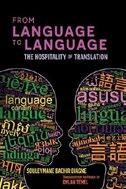
A broad and vital philosophy of translation as a decolonizing force that serves to build a common humanity. Starting from the premise that all human languages are of equal value, noted Senegalese philosopher Diagne sets out to demonstrate the far-reaching consequences of translation and how it can foster a common humanity. He writes, “Through the work of translation, languages come to know each other. From language to language.” Recognizing and pushing against ideas of cultural dominance, Diagne looks at how the legacy of colonialism has been embedded in texts, as translations, even in “translations” of visual language. Exploring the example of appropriation of African artifacts in modernist art—from Matisse, Picasso, and other avant-garde artists—he concludes that “primitivism is a Eurocentric and lazy concept.” Other asymmetries between languages and cultures have resulted in
the predominance of certain philosophical concepts that have implications for the grammar of philosophy, the metaphysics of being, and logic. For example, Arabic grammarians have criticized translators of Aristotle for trying to “pass off categories of thought in a broad sense, [when they were] merely categories inherent in the language spoken by the Stagirite.” In another example, he unpacks how a metaphysical “notion of being would be entirely different” in the West African tonal language Ewe. The book itself is intertextual, emphasizing the collaborative act of knowledge building, as Diagne traces the evolution and lineage of his thinking in elegant prose. The author cites numerous late cultural theorists and philosophers, including Henri Bergson, Gottfried Wilhelm Leibniz, and Léopold Sédar Senghor, as well as present-day figures, among them Kwame Anthony Appiah, Philippe Dagen, and Sandra Laugier. Alongside George Steiner’s After Babel, a seminal work that furthers translation scholarship.
Ernaux, Annie | Trans. by Alison L. Strayer Seven Stories (96 pp.) | $17.95 paper September 23, 2025 | 9781644214879
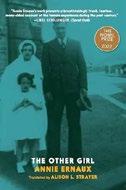
Ghost story. Invited to contribute to a collection of imagined letters, Nobel Prize winner Ernaux addresses the sister she never knew. She was 10 when she overheard her mother disclose to a friend that Annie was not her first child. There had been another daughter, who died of diphtheria in 1938 when she was 6. “She died like a little saint,” her mother said. And “she was nicer than the other one.” The other one being the daughter born two years later: Annie. The idea of her dead sister haunted Ernaux throughout her childhood and haunts her still. Growing up, she never asked her
parents, relatives, or family friends about the girl, whose name, she learned, was Ginette. She saw no photos of her until, when she was 18, she found a cache hidden in the attic, in a box accidentally left open. Because her parents were clear that they wanted only one child, she understood that her existence had depended on her sister’s death. “I was aware of my advantages as an only child,” she admits, “a child born after the death of another, the pampered object of a worried solicitude.” She had been a delicate child, and when she was 5, a cut from a rusty nail gave her tetanus. Her mother, frantic, dosed her with water from Lourdes. “I had to come to terms with this mysterious contradiction,” she reflected later: “you, the good girl, the little saint, were not saved, and I, the demon, survived. Not only survived, was miraculously saved.” Ernaux sees her letter to Ginette, then, as a way to “repay an imaginary debt by giving you, in turn, the existence your death gave me”—or to exorcise a spirit. A moving reflection on a profound loss.
French, Howard W. | Liveright/ Norton (512 pp.) | $39.99 August 26, 2025 | 9781324092452

Wide-ranging study of the life and thought of Kwame Nkrumah, the first president of independent Ghana.
As former New York Times foreign correspondent French observes, Kwame Nkrumah was a brilliant man who, during a sojourn in Depression-era America, “earned four degrees, in sociology, theology, education, and philosophy.” Closely studying the work of African and African American writers, he also formulated the doctrine of Pan-Africanism, which held that the African continent would
never be free of the aftereffects of colonialism until its nations, along with new nations and federations, had forged a common cause that would mark a new world order and “remedy the curse of Balkanization…that colonialism had inflicted upon them.” Pan-Africanism is not widely remembered today; this is due in part to the continent’s leaders neglecting to shake off its colonial past and instead allowing themselves to be swayed by corruption and privilege. Nkrumah spent his early years in office steering a careful course between the U.S. and USSR during the peak years of the Cold War; although Ghana appeared to be far friendlier to the U.S., its nonalignment led to confrontation with Lyndon Johnson’s “you’re either for us or against us” mentality, so Ghana effectively dropped off the map. At the same time, French writes, Nkrumah, having built a roster of political enemies and feeling paranoid about being assassinated—for good reason, it happens—began to succumb to the temptations of authoritarianism, so that “in its panic, the regime had begun to commit autophagy, cannibalizing itself,” evidenced by Nkrumah’s firing the country’s chief justice so that three prominent foes could be found guilty and imprisoned for opposing him. In the end, Nkrumah was overthrown in a coup, his Pan-African dream thwarted, and died in exile. A fluent exploration of an important if often overlooked political leader whose ideas still bear consideration.
Fujimura, Makoto | Yale Univ. (232 pp.) $30 | October 21, 2025 | 9780300273656

The faith and philosophy behind one artist’s craft. Much of this book is devoted to Fujimura’s practice, a classical Japanese technique called Nihonga, which involves painting
with a prismatic substance created by grinding rare minerals into a binding glue. The pigments refract light, and the minerals change over time, resulting in a meditative experience that’s unique to each observer. Fujimura (Art and Faith, 2021, etc.) calls these paintings “slow art” and explains that they require “more than a hundred layers before I start to paint any movement or images, and then the surface will sometimes rest over years before the images reveal themselves.” Fujimura explores other historical Japanese practices like tea ceremonies and ceramics and traces their influence on his work. While these digressions shine, Fujimura falters in his many attempts to articulate the Christian philosophy behind his life as an artist. The author claims to feel “God’s sacred Presence in the studio” and recounts a moment while painting where he was “forced to kneel to pray” after being overwhelmed by higher powers. He reminisces about spiritual energy that coursed through him while painting at age 3, and he proudly hangs a childhood artwork in his home today: “I did not know what to call that experience, which I assumed everyone had.” “God, the only true Artist, lovingly crushed me over the years,” he bombastically proclaims, “so I can now be fully God’s ‘material,’ to be invited to participate in the Spirit’s prismatic prayer to the darkest corners.” Passages like these, as well as repetitive vague references to contemporary “culture wars,” reveal an underlying lack of direction to the book. There’s little here for art aficionados to latch onto, as ideas about creativity are consistently obscured by Fujimura’s boastful sense of enlightenment. Those looking for a light, spiritual read will have more success with the author’s urges to “see the infinite in the grain of sand,” but ultimately the book is consumed by a conspicuous sense of self-importance. A conceited misfire.
The Jazz Barn: Music Inn, the Berkshires, and the Place of Jazz in American Life
Gennari, John | Brandeis Univ. (254 pp.) $35 | October 15, 2025 | 9781684582853
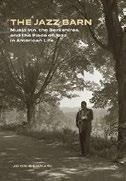
How jazz found a new audience in the Berkshires.
In 1950 a well-off married couple, Philip and Stephanie Barber, opened Music Inn in Lenox, Massachusetts, in the Berkshires, a historically white area of deep cultural significance. They later fashioned a carriage house as a performance center for all kinds of music, lectures, and tutorials grounded in the Lenox School of Jazz. A “wellspring of American vernacular music” was born with first-class musicians like Duke Ellington, Billie Holiday, Stan Getz, and the Modern Jazz Quartet during a powerful postwar movement for racial equality. Lenox is Gennari’s hometown, and in this book, the University of Vermont professor writes of “learning to see jazz, the Berkshires, race, culture, and America itself in new ways.” After providing some historical background about the region, Gennari notes that jazz “may be singular in the strength of its attachment to place…and movement.” For Black “jazz pianist and Brooklynite Randy Weston, Lenox figured as nothing less than a life-defining experience.” He got a job at Music Inn and was encouraged to play piano in the front lounge. Jazz writer Marshall Stearns created influential jazz roundtables showcasing Black artists and writers and was a founder of the School of Jazz. Music Inn’s opening event featured folk singers Alan
How a barn in the Berkshires became a hub for music lovers and performers.
THE JAZZ BARN
Lomax, Pete Seeger, and Woody Guthrie while still fostering blues, African, and Afro-Caribbean music. Gennari writes about eminent photographer Clemens Kalischer, whose photos of many Music Inn participants are included throughout the book. In time, Music Inn’s musical performances “mediated between the local and the national.” The author profiles a number of the jazz school’s outstanding students, including Ran Blake, Ornette Coleman, and Don Cherry. Dave Brubeck’s Time Out and Miles Davis’ Kind of Blue, among other albums, all had a “deep connection to Music Inn.” Its liberal and multicultural ideology was key to the changes in jazz music throughout the pulsating 1950s. Jazz lovers will relish this exploration of a crucial place in jazz’s development.
Goldberg, Ryan | Algonquin (288 pp.) $28 | November 4, 2025 | 9781643755564

A primer on New York City birds for experts and beginners alike. Goldberg, an independent journalist whose work has been featured in the New York Times, has been watching birds since only 2016, yet it didn’t take long for it to become an obsession. The author goes birding almost every day near his home in Brooklyn, and these experiences serve as jumping-off points for a wide range of birding topics. An early chapter covering house sparrows and European starlings delves into the history of these invasive species and how to consider their place among native species. A later chapter on fall migrants covers how the artificial lights of cities draw birds in and cause them to collide with buildings. This is an informative and easy read, and Goldberg’s experience as a journalist stands out. He succinctly and expertly renders the colorful birds and birders he comes across, such as the secretive Owl Whisperer, the controversial Birding Bob, and New York’s
celebrity owl, Flaco. In addition to a wealth of information, he doesn’t shy away from poetic descriptions, such as this one about a peregrine falcon: “Her dark helmet matched the gunpowder color of the cross, and she sank her yellow talons into the pigeon as she tore it apart. Twenty minutes later, all that remained of the pigeon was a skeleton, which the peregrine unceremoniously flicked off the cross. Then she faced the cold wind and kept watch over the neighborhood the rest of the day, flying away at dusk.” The book rarely leaves New York, so Goldberg’s experiences might not appeal as much to birders in other parts of the world. But his enthusiasm for birds makes this an enjoyable read for anyone looking to learn about urban birding. An informative read for any birder, and a must-read for New York City ones.
Graff, Garrett M. | Avid Reader Press (624 pp.)
$35 | August 5, 2025 | 9781668092392
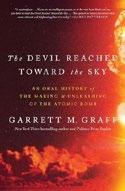
The human stories behind the atomic bomb. With a scope never seen before or since, the Manhattan Project—to develop and build the first nuclear weapons—was a major scientific and industrial undertaking. This is the story of the people who made it happen. As journalist and author Graff writes in this excellent oral history, published on the 80th anniversary of the bombings of Hiroshima and Nagasaki, the three-year project was “a crash wartime effort…with whole new cities and facilities carved out of mountains and deserts to employ hundreds of thousands of people…inventing new technologies in a matter of just weeks and months in the hope of building a bomb more powerful than any before out of materials that at the start of the war existed only in microscopic amounts, and all of it… classified and cloaked in silence and
mystery.” The book tracks the major facilities created for the project: Oak Ridge, Tennessee, center of the uranium refinement effort; Hanford, Washington, focused on plutonium production; and Los Alamos, New Mexico, where hundreds of scientists and engineers designed and built the bombs that brought an end to World War II. The 500 voices who make up the oral history include famous and less-known figures, such as members of the crew who created the first controlled nuclear chain reaction; farmers whose land was needed to build massive complexes to produce enriched uranium and plutonium for the bombs; “project spouses” at all three locations raising families under difficult living conditions; politicians and military men involved in planning and executing the bombing of Hiroshima and Nagasaki; and Japanese survivors of the bombings. Tohru Hara, a sixth-grade student, poignantly recalled that Hiroshima, “burning steadily for a day and a night, presently became a city of death. All that was left was a hell. People who had lost the last energy to live were lying with the railroad tracks for their pillow.”
A comprehensive and engrossing account of the atomic bomb’s creation—and its effects.
Graves, Lisa | Bold Type Books (368 pp.) $32 | September 30, 2025 | 9781645030676

An analysis of the most powerful jurist in the land, seen as a veritable wolf in sheep’s clothing.
John Roberts makes it a point of practice to appear mild mannered, reasonable, and affable. Yet, writes Graves, former advisor to the Senate Judiciary Committee, when George W. Bush nominated Roberts to the high bench, “I was
certain he would devote himself to advancing a right-wing political agenda through the judiciary.” An obvious central plank was abortion and the overturning of Roe v. Wade, the centerpiece of “Roberts’s reactionary docket.” Others were reshaping the nature of executive power, most blatantly demonstrated by declaring that Donald Trump (and future presidents) are immune from prosecution for crimes committed in office; using the free expression of religion to nullify equal rights for gay Americans; and “sabotaging voting rights and permitting illegitimate and undemocratic electoral maps that have all but eliminated incentives to seek compromise, fueling extremism and division.” Graves considers the worst offense, however, to be Citizens United v. FEC , which has allowed the persons with the biggest purses to manipulate elections. The author makes a strong point in stating that the cases the Supreme Court chooses to hear are “almost entirely discretionary,” so that the justices’ personal agendas are reflected in what they choose to rule on. Other conservative justices, by Graves’ lights, are no great shakes (Brett Kavanaugh lied to Congress, she alleges, while Thomas’ now-well-publicized trove of expensive gifts speaks to “serious ethical failures”). But it is thanks to Roberts, she holds, that Trump now wields “kinglike powers,” giving weight to her closing argument that Roberts “will go down as the worst chief justice in American history.” Graves’ slate of proposed reforms extends beyond the judicial and into the legislative and executive branches, but almost all involve overturning the bulk of Roberts’ decisions.
A vigorous takedown of the chief justice of the United States.

Greiving, Tim | Oxford Univ. (640 pp.) | $39.99
September 2, 2025 | 9780197620885
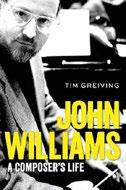
The man behind all those hummable scores.
“Actors may convey love in their facial expressions, or express suffering or panic in their eyes,” Greiving writes about movies, “but the music tells the ultimate truth and provides faith in these make-believe stories. The score—John Williams—is their soul.” In this first major biography of the beloved composer, Greiving, an arts journalist, meticulously traces Williams’ magical career, benefiting from more than 20 hours of interviews with his subject. The Williams family’s move from the East Coast to Los Angeles was life changing: In high school, Williams explored arranging, which laid the foundation for his composing, and in 1956 he secured a position at Columbia Pictures, playing piano on numerous B-movie scores. More orchestration opportunities turned up, including Gidget (1959) and The Guns of Navarone (1961). Live television also called; in 1958 he signed with Revue Studios, writing, orchestrating, and conducting 39 programs a year. Williams scored his first feature film, Daddy-O, in 1959, and later his own series, Checkmate, which led to his first Grammy-nominated album. One of his last studio pianist performances was for West Side Story. “John’s style and craft,” writes Greiving, took “a giant leap into maturity” with Emmy-winning Heidi and Goodbye Mr. Chips, and The Reivers “tapped into one of John’s superpowers: nostalgia.” In 1972 he won his first Academy Award, for Fiddler on the Roof. A year later, he wrote the score for The Sugarland Express, directed by a young new talent: Steven Spielberg. Meeting Spielberg, the composer said, was “one of the luckiest days of my life.” A bounty of successes followed, with Grieving charting the composer’s decades-long collaboration with Spielberg and, of course, George
Lucas. The author provides reams of fascinating inside information about several spectacular scores, including the classics Jaws, Star Wars, Raiders of the Lost Ark, and Schindler’s List Fans of Williams’ music will devour this all-encompassing work.
Hall, Simon | Faber & Faber (400 pp.) | $34.95 September 9, 2025 | 9780571367153
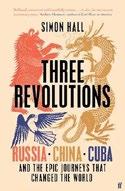
Present at the revolutions. Hall, professor of modern history at the University of Leeds, England, divides his history into six “epic journeys”: Lenin’s 2,000 miles to Petrograd from exile in Switzerland, Mao’s 6,000-mile “Long March” across China in 1934-35, Fidel Castro’s 1956 return to Cuba from Mexico, and three American journalists’ travels to track them down. Socialist activist John Reed (1887-1920) arrived in Russia in August 1917. He had little sympathy with the March revolution that overthrew the czar because its leaders were conventional liberals, but Bolshevik rhetoric thrilled him. Witnessing the October revolution, he not only admired Lenin but participated in his government. His 1919 account, Ten Days That Shook the World , received a great deal of attention despite its politics and remains a journalistic classic. With the Chinese civil war raging and a rebel army newly established in the distant northwest, journalist Edgar Snow (1905-1972) wangled permission to enter the area. Aware that Snow was an establishment figure, Mao and his cadre welcomed him with open arms; his flattering portrayal, Red Star Over China , released in 1937, was a worldwide bestseller and revelation at a time when almost no one knew anything about its subject. Herbert Matthews (1900-1977) was a middle-aged New York Times editor in
1957 when Castro, an obscure figure leading a purported rebellion against Cuba’s dictator, let it be known that he would welcome an interview. In an odd parallel with Snow’s experience, Matthews was conducted into a wilderness, and his articles launched the popular image of Fidel as a romantic revolutionary committed to bringing justice to his people. The reporters’ reputations suffered after their subjects took power—rebellions against unpopular governments usually get good press until they succeed. A captivating account of three revolutionaries and the intrepid journalists who brought their stories to the world.
Hercules, Olia | Knopf (288 pp.) | $30 August 12, 2025 | 9780593537480
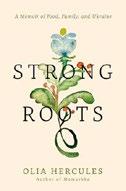
A Ukrainian long-term resident in Britain reflects on her embattled homeland. “Call this book a complicated grief response, if you like.” So writes Hercules, whose parents lived in the besieged Kherson region of Ukraine, less than 45 miles away from Russian-controlled Crimea and the center of savage fighting over the past three years. One way of reaching back to her birthplace was to speak to the spirits of her deceased grandmothers, for, as she writes, “to me, a non-religious person, my family—including, maybe especially including, my deceased ancestors—has always been the most important, most sacred thing in the world.” Another means of connection over the miles was to cook traditional dishes, not always successfully; when she reunites with her refugee parents in Italy, offering them a meal of borsch, her father, disappointed with precooked beetroot and the lack of dill, grimly says, “Mum should give you some tips.” A forgiving Hercules goes on to explain key points of Ukrainian
history and culture, knowledge of which, in her parents’ childhood, had been suppressed by the Soviet state in a process locally called movchanka, “the great hush,” in which there was, she writes, not just “The Unsayable” but also “The Unthinkable.” Fortunately, if daringly, her father rebelled against a system in which, Hercules’s mother explains, the state seemed impossibly huge, and the people—“a blurry, intangible concept”—seemed tiny. That process of subjugation, Hercules notes, did not begin with Lenin or Stalin but with Catherine the Great, whose army seized Crimea, deported native Tatars, and began the process of Russifying a region whose language is different enough from Russian, she adds meaningfully, that “the thing is, we Ukrainians understand Russians, but they don’t understand us.”
A thoughtful, valuable testimonial to what it means to be Ukrainian in a time of torment.
Hiller, Jeff | Simon & Schuster (272 pp.)
$28.99 | June 10, 2025 | 9781668031858

Queer actor and comedian Hiller reflects on his long road toward eventual success in Hollywood. Most notable and recognizable for his work on the HBO series
Somebody Somewhere, Hiller gets candid about the lean years prior to the upswing in his popularity and desirability as an actor. With passionate candor and humorous self-awareness, the author discusses the midlife crisis that made him consider purchasing a toupee and then seriously contend with an unhealthy relationship to food and his feelings of career underachievement and low self-esteem. As a “middle-aged homosexual,” Hiller, 49, confesses to being a voracious reader of Hollywood actress memoirs, adoring the salacious secrets
A comic “clawed, scraped, and fought their way to the lower-middle rung of the ladder.”
they spill, and conceding that “there is only so much fighting it before you just have to lean in and admit that you can’t get enough of Candice Bergen talking about her life.” This love of celebrity autobiography lends itself to the book’s chapters, all named for bestselling celebrity memoirs (e.g., My Life So Far by Jane Fonda), and celebrates the pitfalls of an openly gay struggling improv comic and television actor who “clawed, scraped, and fought their way to the lower-middle rung of the ladder.” After having moved to Los Angeles in 2011, Hiller, armed with lofty career goals, soon realized the ill-fated struggle of endless auditions and the humiliation of low-paying bit parts, but his hysterical depiction of a Pilgrim in a Snickers commercial proved surprisingly lucrative. He describes the exasperation in trying for decades to score an agent to represent his talent, and the jobs he took in the meantime to make ends meet, like being the awkward “Naked Guy” standing on Manhattan’s bustling Fifth Avenue in the 2008 film Ghost Town. Elsewhere, Hiller is raw and real in his gushing gratefulness to actress Bridget Everett for recommending him for the career-uplifting role of Joel in Somebody Somewhere. Suffused with charm and sparkling real-life anecdotes on the grueling Hollywood machine, Hiller’s book is a must-read for any performer trying to make it in the entertainment industry.
A chatty, hilarious, effervescently entertaining autobiography anchored by self-deprecating humility and humanity.

Hogan, Chuck | Random House (336 pp.) $32 | July 29, 2025 | 9780593733226
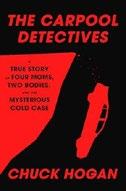
A n amateur crime-solving collective blows open a 15-yearold doublemurder mystery. In the summer of 2005, the bodies of a Los Angeles–area businessman and his wife, who had been missing for a month, were discovered 300 feet above a car graveyard in the Angeles National Forest, where their Ford Explorer had tumbled over a steep cliff from the highway above. In 2019 a young mother named Marissa (only first names of the principles are used, and all others are given aliases for reasons that eventually become clear), hoping to start a new career in TV journalism, happened to see video of the Explorer being pulled from the gorge by a California Highway Patrol helicopter. She recognized the location and almost instantly became obsessed with the idea that she could solve this unsolved mystery. In the winter of 2020, during the Covid-19 pandemic, Marissa, naïve and lacking in confidence, assembled a team of three other moms of young children who were as excited by the challenge of the case as she was. Each brought unique strengths, keen intelligence, sharp humor, and a healthy dash of chutzpah. Hogan, who wrote Prince of Thieves (the basis of Ben Affleck’s film The Town), has crafted a
A photo editor ventures into the archives for a look at the early days of the medium.
BY JOHN M c MURTRIE

THE ELEGANT DARK-BLUE walls of Anika Burgess’ home office in Westchester County, New York, are enhanced by framed black-and-white photographs. One is a 19th-century image of a gaslit street, another is a Tina Modotti print of a typewriter, and there’s a shot of a plane landing at Kai Tak Airport in Hong Kong, where Burgess, who holds Australian and British nationalities, once lived. The photos are a glimpse into Burgess’ love of the art form—a passion that shines through in her first book, Flashes of Brilliance: The Genius of Early Photography and How It Transformed Art, Science, and History.
“A scintillating history that’ll have you looking at photography in a new light,” according to our starred review, Flashes of Brilliance digs deep into the practice’s little-known origins. Burgess, a former visual editor at Atlas Obscura, writes of the pioneers Louis Daguerre, Eadweard Muybridge, and Nadar, among others, but she also tells of obscure figures who made advances in underwater photography, lunar photography, microphotography, spirit photography (manipulated images that featured “ghosts”), rocket photography, pigeon photography (“The pigeon is the first bird to become a photographer,” wrote the New York Tribune in 1908), and kite photography (a quieter—if less controllable—precursor to today’s drone photography). As Burgess found, early photography could be a perilous undertaking, with chemicals and explosions injuring and killing numerous people. “I don’t think I was prepared for it to be as dangerous as it was,” she says. “I think people might be surprised to learn the death count in this book.”
Burgess spoke to Kirkus on a video call from her home, the framed photos behind her. Our conversation has been edited for length and clarity.
What made you want to turn away from the present and look at the early days of photography?
We’re constantly barraged with images, and we can take photographs at any moment. I think that by
looking back at what photographers had to overcome—and looking at all of the difficulties and the innovations and the experiments—helps bring a renewed appreciation for what we’re now able to do.

When did your fascination with photography begin? Pretty early. I remember I got a DSLR [digital singlelens reflex] camera in the mid-’90s, which I love—an old Minolta, which I still have. I always loved taking photographs, and I was always interested in historical and archival photography. And then when I started reading about the people involved in its earliest days—that was when my interest became really piqued in terms of telling it as a history.
There are so many great details in your book. For instance, more than a century ago, some people had photographs printed on their skin and fingernails. Where did you find that?
I first read about it in Cyanide & Spirits , by Bill Jay, which is a great book. And then I did some
subsequent research through 19th-century photographic journals, which is how I did a lot of my research. It seems to have been a trend that kind of came and went and came back again. I love this idea of it being like a temporary tattoo, basically.
Kite photography was a thing in the late 19th century. I love the story you include about how it was used to solve a crime. Tell us about that.
William Eddy—his name kept coming up in these journals in the 1880s and 1890s. He was a kite photographer of some note. And according to local newspapers, he had had some ice cream delivered to the porch of his house for—I think it was his daughter’s birthday. And when he realized it had gone missing, he sent up
his kite camera to take photographs. And lo and behold, the plate revealed an empty ice cream tub under a tree, which he subsequently located—although the perpetrators were no longer there. I think it is fair to say that was probably the one and only time that kite photography was used for crime-solving purposes.
Has writing this book turned you into a gearhead? Do you own any old or obscure cameras?
I have an old Argoflex, which I would love to put into action. I think it’s from the ’50s. What it has done is really put me onto very old historical books. Some friends gave me a 1909 American photography annual. There’s just something so lovely about
turning over pages of an original magazine or journal.
Have you experimented with any of the old cameras you wrote about?
I haven’t, but I have tried my hand at a couple of the genres, you could say. I have a telescope, and I’ve tried taking photographs through it. It’s surprisingly difficult. I found myself confounded by mist and imperceptible tiny movements. I’ve also experimented with cyanotypes, which are really fun to do because they’re a camera-less process, and the most important part is to keep the paper in the dark until you’re ready to expose it. And also to find an interestingly shaped object because it captures the shape of the object rather than the photograph of the image. I used things like flattened
plants. I tried some of my son’s Lego pieces—anything I could find in the house, just sort of seeing how it worked.
What can some of the earliest methods of photography teach us about photography today? You had to take all of your equipment with you to whatever you wanted to photograph. And you didn’t have a light meter—you had to judge the light. And you had to judge your own exposure. And now we can put a burst function on our phone and take a thousand tiny snaps in a minute. So from those early techniques, I think a sense of patience is something that we could take from it.
Of the photographers you profile, who would most likely be big on Instagram?
People might be surprised to learn the death count in this book.
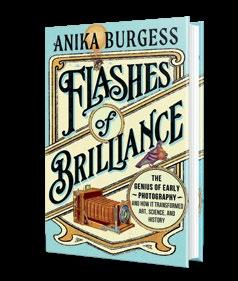
Burgess, Anika
Nadar, without question. He sounds like he would have been very entertaining and very much full of life. I mean, here is a man who was so fascinated by flight, he built this enormous balloon. And maybe Muybridge. He was a big self-promoter who was so good at heralding his own genius.
We’re drowning in digital images, but sometimes I wonder how many printed photos from our time will survive into the future. Is this a concern for you? It is, as someone who has worked a lot in photo archives. I love working in an archive. It’s such a tactile, evidentiary place where you can see a photograph and touch it and get more information from the back of it. Today, with everything being digital, what are the archives of the future going to look like for the photographers of today? I don’t know what the answer is.
Where do you see photography headed in the next century?
I get worried about AI images, of course. I get really concerned about the ability of people to recognize what is and isn’t an AI-generated photograph. I would hope that in the future it continues to evolve with integrity— photography as a whole, I mean. But I think we need some considerable guardrails—better than what we have now. Because not only is it easier to fake an image with AI, it’s also so much faster to share it. Those two things combined really challenge the integrity of actual photography.
page-turning true-crime thriller about this unlikely band of investigators, who reconstructed from scratch the complicated web of financial misdeeds, family treachery, and investigative dead ends that had rendered the official case against the prime suspects un-prosecutable. Hogan writes, “Their ability as women to get people to trust and confide in them things that they would not share with law enforcement figures was their superpower in investigating and breaking this case.” Riveting read about real-life Nancy Drews that seems destined for the big or small screen.
Kirkus Star
The Beast in the Clouds: The Roosevelt Brothers’ Deadly Quest To Find the Mythical Giant Panda
Holt, Nathalia | One Signal/Atria (288 pp.) $29.99 | July 1, 2025 | 9781668027745

A story of a starcrossed scientific expedition by two sons of Theodore Roosevelt. Holt, a journalist who has written several books about overlooked women in history, here turns her attention to an odd gap in the world of natural history—namely, the lack of any formal record of the giant panda, “whose whereabouts, habitat, and behavior were still unknown” other than by anecdote outside China. Indeed, when Kermit and Ted Roosevelt traveled to China in quest of the panda in the late 1920s, it was widely assumed that it was a kind of polar bear, so that “researchers expected the animal to be extraordinarily fierce…and likely one of the most aggressive animals in the world.” As the brothers, working under the aegis of the American Museum of Natural History, venture into country that no non-Chinese visitor has ever
seen, they face howling winter storms in 16,000-foot-tall mountains, endure starvation, and lose half of their pack mules and supplies. Such might be the dangers of travel in the wilderness under the best of circumstances, but, Holt clearly establishes, the brothers both lacked the intrepidity of their famed father and sometimes took unnecessary risks. The story becomes grim when members of the expedition kill a rare golden monkey, leaving its baby an orphan that does not live out the night: “They skinned the tiny creature for the museum,” Holt writes, “but its death hung heavily round their heads.” After they finally catch up with a giant panda, their bad luck becomes worse still: The expedition ends in serious illness; both brothers survive but become estranged from one another, with Kermit descending into alcoholism, and both nursing the knowledge that the blustery adventures they report to the public on their homecoming are only part of the story. Holt’s narrative brims with missteps and tragedy, but it’s a worthy addition to the history of scientific exploration.
Jackson, Joe | Farrar, Straus and Giroux (816 pp.)
$35 | October 14, 2025 | 9780374191900
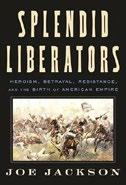
A searching account of the Spanish-American War, which made Spain’s empire America’s. Jackson, an accomplished historian and journalist, begins his long, richly detailed narrative with Clara Barton, the founder of the Red Cross, who was in Havana investigating conditions endured by Cubans whom the Spanish government had herded into concentration camps, with
an estimated 425,000 dead of disease and starvation. While she was there, the American warship Maine blew up in Havana’s harbor, providing the pretext for an American invasion. As Jackson writes, the Cuban campaign inaugurated the United States as a Pacific power “and created beliefs that America was a stern yet benevolent country tasked by Destiny to enforce peace and bring prosperity to the world.” That comforting thought was soon disproven, especially in the Philippines, whose people discovered that they had merely substituted one colonial power for another and then endured a vicious war that saw an estimated 600,000 Filipino deaths. Whereas the Cuban campaign brought glory to Theodore Roosevelt at San Juan Hill, “the Philippine War would be America’s most quickly forgotten war, the one least celebrated in song or legend, the one least memorialized.” And for good reason, Jackson recounts: American soldiers committed countless atrocities while being felled right and left by disease and starvation themselves; many soldiers committed suicide, and others deserted to join Filipino rebels, while the American leadership attempted to control the news—unsuccessfully, as it turns out, although one senior officer said to a reporter, “If you should hear of a few Filipinos more or less being put out of the way, don’t grow too sentimental over it.” Those who are today insisting on American exceptionalism and attempting to whitewash history will no doubt be angered by Jackson’s revelations and his somber conclusion that “U.S. history is haunted by a ruthlessness often shackled to professed idealism.” A splendid book, if centered on one of the most shameful episodes in American history.

Even the most privileged of people could be ensnared in prejudice and persecution.
NINETTE’S WAR
Jay, John | Pegasus (352 pp.) | $29.95 September 2, 2025 | 9781639369614
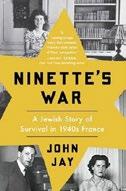
Exodus and exile.
Young Ninette Dreyfus had it all: social status, financial ease, a beautiful Paris apartment that once belonged to Claude Debussy, a loving family. As happened to so many upper-class, secular European Jews, the truth came late. But unlike many of their peers, the Dreyfus family had luck as well as great resources. With the outbreak of World War II and the capitulation of France, the family decamped to the south. There, amid the shadows of the Riviera, the teenage Ninette hid in plain sight with her family. They changed their names. They faked their passports. In 1944, they found a way out, spirited across the Spanish-French border by Basque smugglers. Ninette sat out the rest of the war in Madrid, only returning to France after the Allied victory. Her life is told by a master storyteller, himself a child of Jewish survivors, based on her diaries and the conversations that the elderly Ninette had with her biographer. Jay’s book focuses on a young woman’s coming of age in a time of trauma. It writes an inner, psychological narrative of getting by, getting along, and not getting caught. It illustrates how even the most privileged of people could be ensnared in prejudice and persecution. Ninette’s life does not have the tragic poignancy of Anne Frank’s, and her diary and reminiscences carry little of the existential weight of Frank’s famous journal.
Ninette ages into what her biographer calls “une grande dame from central casting.” What we learn from her story, though, is how family gets you through the worst of times—how parents and children bond and bear the terror of a knock on the door, a casual encounter with a man in uniform, and the foreboding sense that, irrespective of your importance, they may come for you too.
A tale of grit and girlhood, set against a time of deportation.
Jones, Saeed & Maggie Smith | Washington Square Press/Atria (128 pp.) | $22 September 9, 2025 | 9781668207024

Facing hard times.
After the election of 2024, poets Jones and Smith looked to their “mentors, siblings on the page, and friends” for hope and solace, strategies and commiseration. Their collection of 27 essays, poems, and artwork honors that diverse community of writers and artists who share their reflections on how to cope with oppression and how to move forward. “I started typing up my own Project 2025,” Smith texted to Jones. “First item: no self-abandonment.” By self-abandonment, she meant pretending “you don’t know what you know, don’t hear what you hear, don’t see what you see.” And not abandoning others, as well. Several contributors consider forms of resistance. “I think the act of resistance I take the most pleasure in is raising my sons to be
good men,” writes illustrator Aubrey Hirsch. For Chase Strangio, simply being a transgender person signifies resistance: “Part of what makes trans people so central in this small and toxic moment is the power we wield by being insistently ourselves.”
Disability justice activist Alice Wong considers the challenge of countering fascism: “the fear, chaos, and danger many of us live in changes our relationship with time. To fight, to provide mutual aid, to listen, care for, and love our people, to nourish and sustain yourself—all of these things take time and energy. We must give ourselves space, grace, and time if we are to fight fascism.” Some pieces exude anger; others, sadness; all face the future with more questions than answers. As scholar Imani Perry puts it, “Today I ask: How do we raise the young in the face of deportations, expulsions, captivity, abandonment and targeted cruelty? How do we feed those writhing with hunger pangs for freedom?” All underscore the crucial power of community.
A stirring anthology.
Kalli, Bitter | Amistad/HarperCollins (176 pp.) $22 | August 19, 2025 | 9780063371750
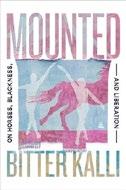
Riding toward freedom. As a young equestrian, Kalli spent their youth deeply connected to horses. Drawn in through popular “pony books,” novels that depict girls who build their lives around horses and each other, Kalli found a community of riders that more or less matched up to their novels—and where they were a solitary Black person in a predominately white space. Yet, as Kalli describes in these interconnected essays, the history of Black people in the United States and the history of horses are deeply intertwined. From
the early days of American plantations, enslaved people were categorized with horses and other animals as “assets and living engines of the plantation economy,” dehumanized in the process. Although horses were their companions in labor, at times they enforced their oppression. Kalli explores how horses have been and continue to be used against Black people by police forces and, in earlier times, slave catchers. There is space for joy in these pages, too, as Kalli follows the ways in which horses have trodden a path for liberation in symbolizing freedom— with runaway enslaved people on their backs, as part of Jamaican cowboy culture, in the Afro-Cuban modernist Wifredo Lam’s horseheaded women, and in Beyonce’s album Cowboy Carter. In recent years, there has been a reclamation of the Western genre by Black artists. Kalli’s contribution brings a new voice to the table, one that is smart, well articulated, and bighearted. Combining critical thought and little-known history, Kalli reminds us “of the slippery boundaries between ‘animal’ and ‘human,’ the ways the figure of the beast haunts our intimate lives.” Essays on Blackness and horses, at turns funny and poignant.
Kirkus Star
Goliath’s Curse: The History and Future of Societal Collapse
Kemp, Luke | Knopf (304 pp.) | $30 September 23, 2025 | 9780593321355

Giants are usually hard to fell—but when they fall, they fall hard.
“The average lifespan of a state is 326 years,” writes international relations scholar Kemp. “The largest states…are more fragile, lasting on average just 155 years.” What Kemp calls “Goliath states,”
including Russia, China, and the U.S., “can be surprisingly fragile,” even though underlying all of them is the threat of violence via police, army, and other government agencies. In some instances, Kemp observes, the collapse of a state is a good thing: Somalia was better off without its dictatorship, even as warlords contended for power. Often, collapse is incremental, so that a peasant in the Italian countryside might not have been aware that the Roman Empire was falling apart. But just as often, collapse is cataclysmic, as Kemp fears it might be given multiple converging threats, including climate change, inequality, the rise of AI, and nuclear war. Societal collapse may then ensue, but, as Kemp notes, that is largely “about the fall of great power structures,” with elites standing the most to lose. Much of Kemp’s book is about the evolution of the state, revisiting anthropological views of Paleolithic societies as happier and more egalitarian than modern ones; archaeological evidence, he notes, suggests that moderns are about twice as likely to die violently than people 10,000 years ago. As humans acquired “lootable resources” unknown to their forebears, motivations for impersonal violence increased. Kemp’s book is wide ranging and full of useful and provocative theses, such as this one: “The more strongly states subjugate women, the more likely they are to be both autocratic and prone to failure.” Just so is his set of prescriptions for nations and people to survive the possibility of a catastrophic downfall: for states, for instance, the mandate to “make the world equal again”; for individuals, “Don’t be a dick.”
An invigorating look at big picture history across continents and millennia, and a survival manual to boot.
Kuehn, Christine | Celadon Books (272 pp.) $29.99 | December 2, 2025 | 9781250344465
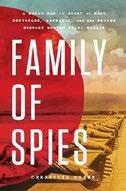
A spy’s granddaughter tells her story.
The is the first book by journalist Kuehn, born and raised in the U.S., who only learned the story in 1994 when a screenwriter, researching a World War II script, wrote to ask help in locating her father, Eberhard Kuehn. Shocked, she hurried to a local bookstore, where several histories revealed that Eberhard’s father, Otto, was a Nazi intelligence agent sent with his family to Honolulu to spy in 1935. Paid generously by the Japanese, he rented a house overlooking Pearl Harbor and gathered information on the ships and defenses. The author’s father, born in 1926, was a boy during this time. No professional, Otto spent money wildly despite having no obvious source of income, visiting Japan and the local Japanese consulate regularly (often when his money failed to arrive). His wife and daughter spied with more good sense. All this quickly caught the attention of neighbors as well as the FBI, who, aided by a small army of informers, kept a close watch on them. Otto was arrested and sentenced to death after the attack of Dec. 7, 1941; the sentence was commuted, and he was deported after the war. His wife and daughter were never tried but interned and then deported. Eberhard, now of college age, refused to join them and concealed his family history until pressed by his daughter. Japanese from the local consulate also
The largest states, including Russia, China, and the U.S., “can be surprisingly fragile.”
GOLIATH’S CURSE
spied, and scholars still debate the value of all this intelligence, although fringe writers happily describe light signals from the Kuehns’ dormer window directing Japanese planes to their Pearl Harbor targets. Despite the impression given by Hollywood, Nazi spies were largely ineffective, and their efforts in Hawaii do not contravene this. Absorbing niche history about a grandfather’s secret Nazi identity.
Community, Power,
Lee, Joseph | One Signal/Atria (256 pp.) $28.99 | July 15, 2025 | 9781668087251

A Wampanoag journalist looks at what it means to be Native American.
Over the course of U.S.–Native American relations, too few people have remembered that the East Coast once abounded with Indigenous settlements. In the case of the Wampanoag, famed for their generous role in the first Thanksgiving, writes Lee, “we, the Aquinnah Wampanoag people, only own a small piece of the smallest town on…what is now Martha’s Vineyard—one of the most expensive and exclusive vacation destinations in the country.” Owning land, Lee observes, is one of the principal ways that one can claim sovereignty over a place, and it is just for that reason that, centuries ago as now, white newcomers to Martha’s Vineyard have labored to displace Native people, whether by violence or by property taxes too high for them to afford, “victims of a rigged capitalist system no one bothered to explain.” As Lee, of mixed Asian, European, and Wampanoag descent, explores the issue of sovereignty, he necessarily opens the door to the question of who qualifies to be Native American: Some nations have a “blood quantum,” by which Black people whose ancestors were
formerly enslaved by the Cherokee were long denied membership in that tribe, and which, Lee writes provocatively, can be a species of “creepy race science.” More inclusive tribal identity, he suggests, “is best rooted in community and events like the Native market, not tribal government and council policies.” Given that tribal membership is often a criterion for the distribution of federal grants, revenues from casinos and natural resources, and the like, the question is fraught. Lee travels widely across the U.S. and visits with Indigenous peoples from Oceania and South America to look at how such matters are addressed, concluding that “there are different ways of being Wampanoag and what works or is meaningful for someone might be different from the way I approach things.”
A searching and timely exploration of indigeneity and its many interpretations.
Lennon, John J. | Celadon Books (368 pp.)
$29.99 | September 23, 2025 | 9781250858245

True stories of homicide from the perspective of the perpetrator.
Lennon, a journalist whose pieces have appeared in the Atlantic, New York Review of Books, and elsewhere, is a convicted killer who has been incarcerated in some of the most infamous prisons in New York state, including Sing Sing and Attica. Here, in his first book, he turns the true-crime genre inside out, taking a close look at the complicated lives and tragic consequences of the bad choices that convicted killers like himself have made. In addition to his own story, he explores the lives and crimes of three fellow convicts, all of whom he interviewed in person at length, all of whom committed headline-grabbing homicides: Michael Shane Hale, whose impulsive murder and dismemberment of his abusive lover became a
controversial test case for New York’s brief experiment with reviving the death penalty in the late 1990s; Milton Jones, convicted for his part in the shocking murders and robberies of two priests in separate incidents in Buffalo in 1987; and Robert Chambers, the notorious “Preppy Killer” whose strangulation of Jennifer Levin in Central Park came to epitomize for New York media the excesses of the go-go 1980s. Among the details of his peers’ stories, Lennon finds echoes of his own experience growing up in Brooklyn and Hell’s Kitchen on a path to crime. The language is direct and unsentimental, reflecting the grim reality of prison life. But Lennon does elicit and share the flawed but poignant humanity of his subjects. Each struggles in his own way to live up to social justice activist Bryan Stevenson’s mantra, “Each of us is more than the worst thing we’ve ever done.” Thoughtful, enlightening, and truth-seeking personal journalism.
Lynch, David J. | PublicAffairs (416 pp.) $32 | September 9, 2025 | 9781541704060
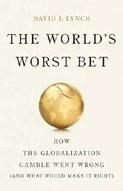
A new world order. As the last century ended, a popular Washington consensus held that the market had all the answers and that bringing China into the global trading system would cement a peaceful future. That seemed to work out until it didn’t. It’s a discouraging story skillfully told by Lynch, global economics correspondent for the Washington Post He reminds us that America’s industrial production has been declining since the 1950s and that automation, not foreign competition, remains the biggest factor. Obsessed with cutting costs, American businesses were already moving to Mexico and other nations, but everyone
thrilled to China, which had discarded “Maoist idiocy” to open a titanic market to world entrepreneurs. The world was getting richer, and the world’s richest nation could only benefit by trading in this immense, supposedly free market. Giving President Clinton most of the credit, Lynch describes his 1990s crusade for globalization. Business leaders and congressional Republicans were enthusiastic. Labor unions and Democrats were not, but many were won over by promises of government benefits and retraining for laid-off workers. This never happened. Almost everyone agreed that a free market would bring democracy to China; increasingly prosperous citizens would demand it as they had in other nations (Spain, Taiwan, South Korea, Chile). This also didn’t happen, but globalization did make the U.S. wealthier. From 2000 to around 2015, inflation and prices were low, but the 2.4 million jobs lost created great resentment, along with the feeling that China was playing dirty and muscling in on our status as world leader. The political climate soon turned uniformly anti-China. Lynch dismisses President Trump’s solutions, which emphasize tariffs and jingoism. Lynch’s own proposals for international cooperation and a generous safety net are political poison today.
A painfully convincing history of how both political parties decided that worldwide free trade was a good thing.
Mahler, Jonathan | Random House (464 pp.)
$32 | August 12, 2025 | 9780525510635

Troubling times in Gotham. As he did in the bestselling Ladies and Gentlemen, the Bronx Is Burning, Mahler scrutinizes a tense moment in New York’s recent past, showing how the divisions that “consumed” the city under Mayor Ed Koch shaped its future
and foreshadowed broader discord in the U.S. Mahler’s focus on exhaustively covered figures who held power, or were trying to get it, results in a solid if not revelatory book about four extraordinarily “convulsive and consequential years.” Koch, popular as his third term began in 1986, was soon damaged by his perceived mismanagement on numerous fronts. Corruption scandals undermined his administration. Homelessness surged, due in part to federal funding cuts, reductions in mental health in-patient care, and local government failures. AIDS was killing thousands of New Yorkers. With City Hall slow to act on the latter, playwright and activist Larry Kramer tried to out the closeted mayor and lambasted federal health officials like Anthony Fauci. Conservative writer William F. Buckley Jr. said people with HIV should be tattooed to prevent its spread. Meanwhile, crack decimated poor neighborhoods, as “an inherently biased law” imprisoned many Black users and spared white users of powder cocaine. Violent crime and racial conflict stoked by tabloids made Al Sharpton famous and fueled international interest in Spike Lee’s Do the Right Thing. Rudy Giuliani’s profile rose as he prosecuted Wall Street crooks. And Donald Trump, after making some bad business deals, “was now refashioning himself into the city’s white id,” Mahler writes. When Trump made inflammatory statements after five Black and Latino teens were accused—falsely, it turned out—of raping a woman in Central Park in 1989, famed columnist Jimmy Breslin wrote that he had “destroyed himself” as “all demagogues ultimately do.”
A creditable look at a troubled metropolis and its publicity-hungry power brokers.
Malkoff, Mark with David Ritz | Dutton (474 pp.) $35 | October 21, 2025 | 9780593472552

Anecdotal glimpses of the late-night TV icon, from the host of The Carson Podcast. For eight years, Malkoff has hosted a podcast dedicated to Carson’s three-decade run on The Tonight Show, and this book is nicely stuffed with quips, quotes, observations—and the occasional gripe—from guests and staffers. He sketches out Carson’s professional biography, from early days hosting the game show Who Do You Trust? in the early ’60s to his retirement in 1992. But though Carson was a fixture in American bedrooms and living rooms, he was also a sphinxlike figure, steering clear of stating overt political opinions and keeping a tight lid on his personal life. Malkoff’s portrait is of a generous figure who took his kingmaking powers seriously—he launched the careers of countless stand-up comics, from Joan Rivers to Drew Carey. But he could also be prickly, for example, holding a long grudge against sidekick Ed McMahon for upstaging him and freezing out guests who had, the host believed, crossed a line. (Ellen DeGeneres was banned from the show after telling a religious joke.) He outsourced touchy subjects, tapping Harry Belafonte to host for a week in 1968, bringing in guests like Martin Luther King Jr. And as the years pressed on, he weathered more
Divisions in Gotham shaped its future and foreshadowed broader discord in the U.S.
THE GODS OF NEW YORK
criticism that he was out of touch. No question, Old Hollywood and Rat Pack swagger was his sweet spot; he declined to have counterculture figures like Andy Warhol on (“has no talent”), and when the show made a bid for hipness by having Morrissey perform in 1991, he fumed at feeling upstaged. Credit Malkoff, with the help of seasoned author Ritz, for showing Carson in his complexity while still retaining his admiration for the showman. In their reckoning, Carson was a flawed performer who knew his lane—soothing Americans looking for a laugh before bedtime—and jealously guarded it. Well-curated glimpses of the complex man beneath the shiny talk-show surface.
McCarthy, Tom | Notting Hill Editions (80 pp.) | $14.95 paper September 9, 2025 | 9781912559671

A dizzying invitation to explore the poetry and prose of German author Ingeborg Bachmann. Originally conceived as an academic lecture and later expanded into a lengthy essay, McCarthy (The Making of Incarnation, 2021, etc.) has crafted a crackling literary investigation that will captivate with its close readings. He begins with Bachmann’s poem “Salt and Bread,” an elegiac, post–World War II enigma that features in its wistful imagery the “threshold” and “ledger” of his essay’s title. “This book,” McCarthy writes, “will be a slow unpacking” of the poem and involve “a set of digressions, of departures and returns.” Grappling with themes of interiority and liminality, McCarthy jumps, in search of clues, from Greek tragedies and the poetry of Anne Carson to David Lynch’s film Lost Highway. He revisits an early work of his own, a high-concept play inspired by both Aeschylus’ Oresteia and artist Douglas
Gordon’s seminal video installation 24-Hour Psycho. McCarthy’s play is reprinted in this book’s appendix, as is Bachmann’s “Salt and Bread,” in both English and German. Reveling in the subtle delicacy of Bachmann’s wording, the author investigates particularly potent etymologies and scans multiple translations in tandem. Invocations of works by Kafka, Dostoevsky, and Shakespeare add to McCarthy’s storm of citations, all of which usher in a short study of Bachmann’s 1971 magnum opus, the novel Malina. McCarthy’s work is an invigorating and inspiring incantation: Readers will not only marvel at how the author reads but also at his ability to articulate that experience into something both erudite and accessible. Eventually, Bachmann’s importance feels secondary to the journey: McCarthy resists guiding readers to a comprehensive closing statement and instead chooses to create a framework for the reader with a foundation of literary ideas. Ending on “the threshold of both Malina and the poetic event-field, all the books-to-come, to which Bachmann’s masterpiece opens the door,” McCarthy invites readers through, toward revelations of their own. An impressive and inspiring critical reading.
Morris, David B. | Empire State Editions/ Fordham Univ. (224 pp.) | $34.95 October 7, 2025 | 9781531511647

An examination of New York’s Central Park and its history, set in the context of global climate change. Any history of Central Park necessarily spotlights Frederick Law Olmsted, who (with Calvert Vaux) did much of the design work for the park and was its first superintendent. Olmsted’s early career as a farmer, travel writer, and magazine editor gave no hint of his eventual
calling. But when Vaux recruited him to enter an open competition for designing the park, the two men shared a vision of a park open to all the city’s people, mixing meadows, woodland, and more formally designed parkland. Their “Greensward” design was selected, and today’s park still strongly reflects its origins. In addition to the park’s early history, the author explores its role in the city as a whole. Despite its designers’ intention to make it a place for all classes of New Yorkers, it was necessary to expel an established community of largely Black homeowners from Seneca Village, which sat on land designated for the park. In the early years, access was easiest for upper-class residents, but the park soon became everyone’s playground. Brown, the author of The Culture of Pain (1991), includes anecdotes from his own walks in the park, tales of the wildlife that has made it a home—including the occasional exotic bird such as Flaco the owl—and snapshots of historical events that have taken place there. As the subtitle indicates, he sees the park as a model for municipalities nationwide to emulate—creating green space to help offset carbon emissions and other environmental problems. The author too often starts on an interesting bit of lore only to go off on a tangent—a distraction in an otherwise enjoyable book. A multifaceted exploration of one of the first great public works projects in America.
Narbonne, Christophe | Black Dog & Leventhal (288 pp.) | $39.99 September 9, 2025 | 9780762488643

T he latest compendium of essays about a unique cinema stylist. Stanley Kubrick fans who love books about directors are among the luckiest bibliophiles in the world. One could easily fill a couple of bookshelves with volumes
about him. Wes Anderson fans are on their way to being equally lucky. Anderson’s style, like Fellini’s, is instantly recognizable, provokes strong reactions, and provides juicy material for literary works. Narbonne, a French critic, is the latest to present a series of essays on Anderson’s cinema. This work doesn’t say anything original, but an excursion through familiar countryside with a new guide still has its pleasures. In the book’s foreword, Cannes Film Festival director Thierry Frémaux rightly refers to Anderson, who has lived in Paris for two decades, as “someone who lives comfortably both inside and outside the system and who explores territories that clearly escape the Hollywood norm.” Narbonne covers the director’s work through 2023, from the Bottle Rocket short that was a hit at Sundance in 1993, to commercials for Prada and other companies, to Asteroid City, the semi-sci-fi play-within-a-filmwithin-a-TV-show inspired in part by the theater of Sam Shepard. Like all books of this type, this one has stills and behindthe-scenes photos, along with synopses, critical reactions, and technical details, such as the various lenses Anderson has used, from the “rare short focal length: 27 mm” he used for the 1996 feature-length Bottle Rocket to the “wide-format anamorphic lenses and a strong color palette” he has employed on every film since Rushmore (1998). Narbonne tries too hard to intellectualize Anderson’s cinema, as when he writes, “Symmetry is the ideal backdrop for the characters’ psychorigidity” or notes Anderson’s use of “visual pleonasm.” Fans probably won’t mind, however, and will enjoy stories such as that in the Rushmore scene where the protagonist releases bees into a hotel room, “Anderson insisted that real insects be released into the room and that no one wear face protection.”
For Wes Anderson fans who can’t get enough books about him, what’s one more?

From logging time at a McDonald’s to founding a famous chain of restaurants.
I’M
Nieporent, Drew with Jamie Feldmar Grand Central Publishing (288 pp.) | $30 September 23, 2025 | 9781538765579

A restaurateur’s amiable memoir of being mostly in the right place at mostly the right time.
red or an egg cream, is some well-placed name-dropping, with the likes of Robin Williams, Ruth Reichl, partner Robert De Niro, Bruce Springsteen, and Spike Lee popping up at turns. The takeaways are many, but perhaps the most memorable is one that anyone who’s worked on the line will know: If you’re in the restaurant business, your life is not your own.
For more about Wes Anderson, visit Kirkus online.
Nieporent got his first taste of restaurant life by accompanying his father, a liquor inspector who “would make a buck on the side by taking a restaurant’s application from the bottom of the pile and moving it to the top” and dined free to boot at storied places like Dubrow’s Cafeteria and Paul & Jimmy’s. Lacking the money and the academic record to go to a top-flight hotel school in Europe, he enrolled at Cornell—but not before logging time at a McDonald’s, of which he writes, “To this day, it’s one of the greatest gigs I’ve ever had.” Other great gigs followed, from waiting tables on a Scandinavian cruise ship to founding the legendary Nobu chain of restaurants. Along the way, very much in the spirit of Anthony Bourdain (albeit with fewer hangovers and parallel lines), Nieporent dishes out secrets of the trade: If you have a small kitchen, then have a small menu, which allows you to “control food costs, prep work, and the timing of cooking and service”; don’t ask a customer whether everything is all right, which “implies that something might be wrong”; don’t do a deal with Donald Trump (“I could barely get a word in edgewise”); and, above all, “Just do your job, and do it well.” A bonus in this lively memoir, which pairs well with a robust
Foodies and celebrity watchers alike will enjoy Nieporent’s culinary adventures and misadventures.
O’Brien, Phillips Payson | PublicAffairs (288 pp.) $30 | October 28, 2025 | 9781541606975

Disturbing insights on how wars are won.
O’Brien, professor of strategic studies at the University of St. Andrews in Scotland and author of The Strategists (2024), points out that months before Russia invaded Ukraine, American military leaders and political advisors agreed that Russia would quickly crush its neighbor, so any military aid to Ukraine would be wasted. They had been expressing this view for years. These experts were “parroting…the great power paradigm that has been in wide-scale operation since the nineteenth century.” O’Brien emphasizes that that paradigm was always wrong, but it remains a universal belief that great nations defeat small nations and that wars are won by great armies that win battles. Over a century of Britain’s hegemony, it was defeated by the American colonies, failed
to conquer tiny Ireland, and almost lost to a collection of Boer farmers. After the U.S. became the world’s superpower, it failed to win wars in Korea, Vietnam, Iraq, and Afghanistan. O’Brien argues that decisions of national leaders, not geopolitical issues, cause wars that are won by resources and persistence, not battlefield victories. Germany invaded Poland in 1939 because Hitler ordered it. Lincoln knew that Union defeats were not decisive. Finally, major wars are generally won by coalitions of allies willing to fight. The world wars are examples. Germany’s allies (AustriaHungary and then Italy) were a positive burden. O’Brien adds that President Trump regularly denigrates our allies. That national leaders behave irrationally and that wars rarely turn out as planned are not news, but the author argues that avoiding war is preferable to winning because even glorious victories regularly turn to ashes.
Astute revisionist geopolitics—if not more cheerful than the conventional version.
Potter, Will | City Lights (352 pp.) | $21.95 paper | July 8, 2025 | 9780872869141

A charged investigation into industrial agriculture, a vast machine made up of a handful of gigantic players.
Think of farms, and if you can picture them at all they’re likely to include the little red barns of yore, scattered innumerably over the countryside. Not so, writes investigative journalist Potter: “A landscape of small farms has morphed into a monoculture of big business.” The numbers are telling: As Potter notes, four companies control three-quarters of the world’s beef-packing plants and slaughterhouses, while another four companies “control 99 percent of the global chicken breeding market,” just one-ninth the number of firms that did that work four decades
ago. The conditions animals endure in factory farms are shockingly hellish. As Potter chronicles, baby cows have metal spikes inserted in their nostrils “so that it is too painful for mothers to nurse them,” while chickens lay their eggs in tiny cages surrounded by chicken corpses and “covered in the feces of birds stacked above them.” That this is not everyday news has a devious reason: Big Ag, working through a lobbying group called ALEC, has pushed through laws across the country to declare whistleblowing a species of terrorism, with “ag-gag laws” threatening journalists with lawsuits and even imprisonment for detailing the truth about how animal agriculture is conducted. Moreover, writes Potter, “like Big Oil, the factory farming industry has wielded their deep pockets and government ties to skirt emissions reductions, undermine and rewrite environmental legislation, and absolve themselves of responsibility for climate change.” Under the current administration, things are certain to get worse, which prompts Potter to conclude that telling the truth about Big Ag is a form of resistance not just against corporations but also against “the rise of fascism.”
A book that ought to set its readers to pondering an all-plant diet.
Quinones, Sam | Bloomsbury (384 pp.) | $28.99 September 30, 2025 | 9781639735488
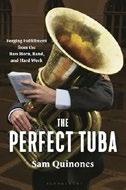
The story of a musical instrument born out of the circus and brass bands. In his latest book, Quinones, author of the award-winning Dreamland: The True Tale of America’s Opiate Epidemic, turns his attention to a lively search for the perfect tuba—and so much more. In the 1930s two tubas, the “almost mystical” Yorks, were made in Chicago. Quinones seems to have interviewed everyone who’s someone in the tuba
A sprightly, entertaining hodgepodge of all things tuba.
Rensch, Danny | PublicAffairs (368 pp.) $30 | September 16, 2025 | 9781541703285

Mastering the game—and more.
Author Rensch, international chess master, chess broadcaster, and chess commentator reminds readers that chess is a worldwide obsession—not unlike soccer.
>>> world. He profiles Bill Bell, the first to record an album with the tuba as lead instrument and who became a member of John Philip Sousa’s band. He describes the famous “Tuba Woodstock” of 1971, when legions of tuba players descended on Indiana University, where the Tubists Universal Brotherhood Association was born. Readers meet Fred Marrich, who tried to corner the tuba market with his Tuba World store near Detroit. Quinones provides an in-depth profile of the celebrated music teacher Arnold Jacobs, owner of a prized York, who possessed “one of the most illustrious careers in American tubadom” and who played in the Chicago Symphony. He visits Roma, Texas, a “speck of a town” with a statewide-contending high school marching band directed by the illustrious Al Cortinas with young J.R. Trevino proudly holding forth on tuba. The author introduces us to Jim Self, who built a tuba hall on his roof. Then there’s Zig Kanstul, a “lone wolf among U.S. brass instrument makers,” and New Orleans’ Tuba Fats, a “mythical mountain of a man.” Sadly, steady tuba jobs, Quinones writes, are painfully scarce. The horn “can provide a living for only the tiniest fraction of the young people that its promise inspires.” And yet the instrument brings immeasurable joy to its players. He writes, “What is the tuba, anyway, if not a 12- to 18-foot tube for channeling imagination?”


A trio of memoirs takes listeners into worlds of power, ego, and mass influence.
BY MARION WINIK
FOR 25 YEARS , Graydon Carter reigned over the media palace that he built at Vanity Fair magazine, as famous for its Oscar gala as for its Annie Leibovitz covers and juicy exposés. He begins When the Going Was Good: An Editor’s Adventures During the Last Golden Age of Magazines (Penguin Random House Audio, 12 hours and 30 minutes) with his rough-hewn Canadian roots: hockey, wood chopping, and workin’ on the railroad. This was the Kirkus reviewer’s favorite part of the book, but for me the real fun began after he moved to New York, landed and then escaped a job at Time, and co-founded the
epic snarkfest that was Spy magazine, where he dubbed Donald Trump the “short-fingered vulgarian” and gave many other power players reason to be pissed off. Most came back around in the years after he succeeded Tina Brown at VF in 1992, transforming it into an Olympus of beauty, power, and excellent writing. For a working journalist, listening to Carter tell these stories is the next best thing to five bucks a word and a bottomless expense account.
Matthew Specktor is the son of Hollywood agent Fred Specktor, the latter still working today in his 90s. Specktor fils grew up in a world where Jack Nicholson,
Warren Beatty, or Morgan Freeman might pop up in the living room or on the next chaise longue at the pool. The Golden Hour: A Story of Family and Power in Hollywood (HarperAudio, 11 hours and 35 minutes) covers the classic material of his unorthodox childhood (quaaludes at age 10) and his early career on the edges of the film business in LA and New York, richly larded with analysis of Hollywood’s culture and history. Borrowing techniques from autofiction, Specktor frequently inhabits others’ points of view, including those of his father, superagents Lew Wasserman and Michael Ovitz (Fred’s sometime bosses), James Baldwin (the author’s professor at Hampshire College), and, most surprisingly, 9/11 hijacker Mohammed Atta. In a starred review, our critic deemed it “literate and liberal with huge scoops of dish…a sometimes shocking pleasure from start to finish.”

The author’s reading is smooth and professional, à la Golden Age movie voiceover, making the emotion that creeps in when he recounts his mother’s difficult trajectory—a frustrating
career, alcoholism, divorce— all the more affecting.
Once you get your jaw off the floor, you’ll have no question in your mind as to why Meta (formerly Facebook) tried to block publication of Sarah Wynn-Williams’ memoir of her employment there from 2011 to 2017. Careless People: A Cautionary Tale of Power, Greed, and Lost Idealism (Macmillan Audio, 13 hours and 15 minutes), as read by the author in her charming New Zealand accent, is the gripping account of how an idealistic young woman, then working in the foreign service for her country, had a vision of the incredible influence Facebook might someday wield in global politics. After she eventually convinced the company to hire her, she became a witness and at times an accessory to her worst nightmare—the platform’s functioning as a tool of repressive governments in Myanmar, China, and elsewhere, and then abetting if not ensuring the election of Donald Trump in 2016. Along with outrageous stories of sexual harassment during her pregnancy, she leans into some truly eyebrow-raising dish on former COO Sheryl Sandberg. Don’t miss it.
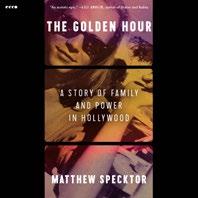
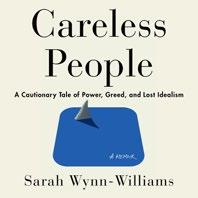

The New Jersey Democrat’s Stand will expand on his history-making Senate-floor speech.
U.S. Sen. Cory Booker will adapt his history-making Senate-floor speech into a new book.
St. Martin’s will publish the New Jersey Democrat’s Stand in the fall, the press announced in a news release. It calls the book “a celebration of the Americans who chose to get up in the face of injustice, who championed the uniquely American values central to making our nation a more perfect union, despite seemingly insurmountable obstacles.”
Booker was the mayor of Newark, New Jersey, before he was elected to
the Senate in 2013; he has since been reelected twice. In March, Booker delivered a speech to the chamber, in which he criticized President Donald Trump’s administration. The speech lasted 25 hours and five minutes, breaking the previous record set by Sen. Strom Thurmond in 1957.
Tim Bartlett, the executive editor of St. Martin’s Publishing Group, approached Booker about adapting the speech into a book, the press says.
“This book is about the virtues vital to our success as a nation and lessons we can draw from generations of Americans who fought for them,” Booker said in a statement. “Now is not the time to surrender to cynicism or abandon our most noble ideals. Now is the time to defiantly declare like our ancestors before us: I too stand for America.”
Stand is slated for publication on November 11.—M.S.

For more books on U.S. politics, visit Kirkus online.

Cory Booker

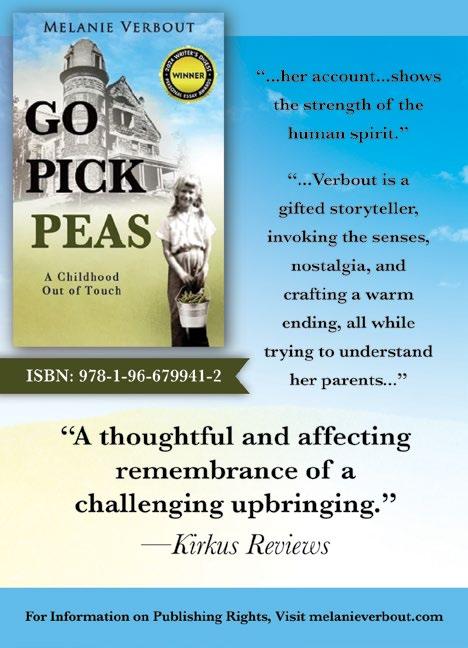



The journalist and activist was known for her landmark book Against Our Will.
Susan Brownmiller, the journalist and activist whose 1975 book, Against Our Will: Men, Women and Rape, is considered a landmark feminist work, has died at 90, the Washington Post reports.
Brownmiller, a Brooklyn native, studied at Cornell University for two years before a brief stint as a stage actor. She then worked as a journalist for Newsweek, the Village Voice, NBC in Philadelphia, and ABC in New York.
In 1970, she published her first book, a biography of Shirley Chisholm, the first Black woman elected to the U.S. House of Representatives. Brownmiller published Against Our Will in 1975. The tract argued that rape was more than just a crime but rather “a conscious process of intimidation by which all men keep


all women in a state of fear.” The book is considered one of the most influential nonfiction books of the 20th century. Her other books include Femininity, Waverly Place, Seeing Vietnam: Encounters of the Road and Heart, In Our Time: Memoir of a Revolution, and My City High Rise Garden. On the social platform Bluesky, political scientist and sociologist Janet Gornick posted, “Today, it’s fitting to remember Susan Brownmiller, a warrior who exploded myths and catalyzed legal reforms. I had the opportunity to work with her on several occasions over 40+ years. She was relentless, complicated, bold. RIP. The cause endures, the work goes on.”—M.S.

For a review of Against Our Will, visit Kirkus online.
It’s also a complex passion that requires intense study. Readers awaiting the delights of the Netflix show The Queen’s Gambit (which duly appear) will not regret the wait, as Rensch begins with his childhood. He was raised in a religious cult. Although it lacked lurid qualities, its members lived under oppressive leaders. When in 1995 a group of boys interested in chess won local contests, the cult leader decided that chess fit perfectly with his teachings and aggressively encouraged it. Within a few years, the team, with Rensch the most successful member, was winning national contests and making headlines. Rensch was separated from his parents (a feature of the cult), and his isolated adolescence was dominated not just by chess but by alcohol and drugs. Rensch detours regularly to deliver a history of chess and the contemporary game largely controlled (i.e., financed) by the USSR until the 1990s, when even celebrity grandmasters barely earned travel expenses. Then came computers, the internet, and more media attention, which produced bigger prizes, plus the rise of cell phones, which facilitated cheating. Readers will sympathize with the author’s struggles but likely perk up when in 2008 he encounters two entrepreneurs operating an early internet chess site whose knowledge of serious competitive chess remained at the amateur level. He persuaded them to add features, programs, competitions, and the technology that ultimately promoted chess.com to its dominant position. During these years, the author writes of victories in his personal life, too, overcoming marital problems and escaping the influence of the cult.
A chess professional’s winning memoir.
Rinehart, Lorissa | St. Martin’s (352 pp.) $33 | November 4, 2025 | 9781250353047

A trailblazer’s career.
Rinehart, host of the podcast The Female Body Politic, chronicles the life of Jeannette Rankin (18801973), the first woman in Congress, a tireless advocate for women’s suffrage, a social progressive, and a Republican. A lifelong pacifist, Rankin voted against participation in both world wars and lobbied against the Vietnam War, convinced that “imperialism formed the cause and purpose” of war. A Montana native, as a young woman she worked in a settlement house in San Francisco, which opened her eyes to poverty and need. At 28, she attended the New York School of Philanthropy, then returned to Missoula, where she mounted a grassroots protest to improve conditions in a women’s prison. After a dispiriting job at an orphanage, she enrolled at the University of Washington, taking courses in political science, economics, and public speaking, all serving her well in her campaign for women’s voting rights. As field secretary for the National American Woman Suffrage Association, she traveled the country, lobbying with “dogged tenacity.” Success in California and Montana inspired her to run for Congress on a platform of national women’s suffrage, Prohibition, government regulation of business, ranked-choice voting, and direct election of presidents rather than the Electoral College. In
The first woman in Congress, a tireless advocate for women’s suffrage, and a Republican.
1916, in Montana’s first election in which women voted, Rankin won. Rinehart examines Rankin’s unyielding pacifism, even when forced to ally with antisemitic and racist isolationists. Rankin, the author asserts, practiced politics “as the art of the possible and often overlooked the ethical failings of her allies to achieve her own ends.” After one term, Rankin continued her political activism outside of Washington until, in 1940, she made another successful congressional run. Drawing on Rankin’s many interviews, Rinehart imbues her narrative with her subject’s passion and voice.
A well-researched biography of a memorable woman.
Roach, Mary | Norton (288 pp.) | $28.99 September 16, 2025 | 9781324050629

A lively treatise on the human body as an endlessly interchangeable set of parts. It’s an old saw (and, these days, canard) that British teeth are bad. All the same, Roach, an indefatigable researcher, turns up a gem at the start of her latest book: Paul McCartney’s father once suggested that Paul “have all my teeth taken out and false teeth put in,” since he’d likely lose his original set soon enough. Her catalog of cut-and-paste body parts goes on, corporeal trivia mixed with solid, elegantly written scientific journalism. One such part is the nose, none too easy to craft a replacement for, as witness the eminent Danish astronomer Tycho Brahe, who lost his original proboscis in a duel. “Occasionally,” Roach quotes one biographer as saying of its substitute, “it would drop off.” Other appendages await, not least the male member. Given that cataract surgery is now almost assembly-line common, Roach wonders, what about elective surgeries to replace underperforming parts? No, not that
part; rather, Roach tells the story of a former Marine who had suffered an injury that led to his toes dragging and thus arranged (by shooting himself in the afflicted foot) for an amputation and refitting with a prosthetic that allowed him to walk more easily. Roach wanders through the hallways of eldritch laboratories where pigs are grown to provide organs that are transplantable to humans, and she visits cadaver labs to look at another source of carefully inventoried parts (“As much time is spent on documentation and shipping of a donor’s tissues as on their removal. You’re expecting The Jeffrey Dahmer Story but it’s closer to UPS”). She interviews researchers on cures for type 1 diabetes and advances in “in vitro gametogenesis” and generally has a grand time looking into areas where few writers—especially squeamish ones—have ventured. An amiably entertaining, endlessly intriguing stroll through the stuff of which we’re made.
Ronson, Mark | Grand Central Publishing (256 pp.) | $29 September 16, 2025 | 9781538741115

A pop music star reflects on his early days as a New York DJ. Songwriter and record producer Ronson is no stranger to the top of the charts. He produced Amy Winehouse’s blockbuster album Back to Black and scored an inescapable megahit of his own with the 2014 single “Uptown Funk.” (Movie fans might know him from his early cameo in Zoolander and for co-writing the earworm “I’m Just Ken” from Barbie.) Before all that, though, he was (and still is) a DJ, and his debut book focuses on his rise from a kid with a set of turntables he got as a high school graduation present to one of the country’s most in-demand record spinners. Ronson recalls his early life as a child in London, the son of parents who
“were good people, but not good together,” and his move to New York, with his sisters, mother, and her new partner, Foreigner guitarist Mick Jones. He talked his way into DJ gigs, writing of one event, “I already had advantages that most others didn’t. My mother bought me the gear. I was raised by a musician with a home studio. But this was an absurdly lucky break, even for me.” Ronson writes beautifully about the allure of the nightclub: “For someone who grew up amid chaos and uncertainty, the DJ booth was the perfect refuge—a one‐man command center, where every fader and dial bent the world to my will.” His chronicle of his rise to success is entertaining, funny, and humble; while he allows that he’s good at his job, he remains well aware of the role that chance played in his career. You don’t have to love dance music to enjoy this thoroughly charming memoir. An endearing memoir from a musician who’s more than just Mark.
Rosenberg, Göran | Other Press (400 pp.) | $19.99 paper October 7, 2025 | 9781635425772

If I forget thee, O Jerusalem… This book, originally published in Swedish in 1996, is reissued now in English—with a new preface and final chapter—in the wake of the Oct. 7, 2023, attack on Israel. The author grew up in a Swedish Jewish family after World War II. After the early death of his father, he moved with his mother and siblings to Israel in the early 1960s. There, he came face to face with the founding ideologies of the state of Israel and with the everyday realities that challenged them. The author’s “personal history” of Israel is as follows. The early-20th-century Zionist impulses for a Jewish homeland morphed into what he calls a “messianic frenzy.” The founders of the state were largely Ashkenazi, European, secular
men, committed to a communitarian philosophy of pastoral labor and social health. Challenged by the influx of Mizrahi and Sephardic Jewish immigrants, this group found itself an elite in retreat—still in power over the major cultural and political institutions of the country but out of step with families that came not out of principle but out of need. The rise of the ultra-Orthodox communities in the late 20th and early 21st centuries similarly challenged the hegemonies of this communal, laborbased, secular group, which, the author argues, never fully accepted the Palestinian Arab population as its peers or even as cohabitants. For the author, these fissures in the modern state of Israel have created what he sees as an impossible condition. Explicitly defining the current situation as a “genocidal war in Gaza,” the author concludes that “the choices made have led Israel into a dead end; its geopolitical vulnerability has increased, its security has weakened, and the prospects for a peaceful sharing of the land have been actively shattered.” This book is unlikely to change minds or hearts, even as it chronicles the author’s own change of both.
A personal story of disillusionment with the state of Israel, told by a Swedish immigrant.
Sacco, Joe | Metropolitan/Henry Holt (144 pp.) $27.99 | October 14, 2025 | 9781250880260

Graphic journalist Sacco delivers a searing account of religious conflict. In several villages in the state of Uttar Pradesh in 2013, a caste called the Jats, presumed to be kin to the Roma, clashed with their Muslim neighbors in a series of riots, and in the end 63 people lay dead. “A good riot needs something on which it can hang its righteous hat,” writes Sacco, “some specific outrage at some specific time and place to serve as the first definitive marker on the road to no return.” Two
young Jats, it seems, had killed a young Muslim man and were in turn beaten to death by a vengeful crowd of Muslims. The Jats are Hindu—though, says one depicted here, “very liberal in our social customs”—and the riots called up the specter of the sectarian war that divided India and Pakistan in 1947, in which an estimated 1 million people died. In Sacco’s account, Hindus and Muslims alike recall that the Jat and Muslim communities of Uttar Pradesh were friendly before the initial killing, attending each other’s festivals, but tensions elsewhere in India finally reached the state, whipped up by disinformation (a supposed video of the lynching of Jat boys was actually “years old and from Afghanistan”) and exploited by the Hindu nationalist government of Narendra Modi. Indeed, the multiethnic, multireligious Indian state, said to be the largest democracy in the world, is swiftly declining, Sacco writes, with laws being promulgated to prohibit the consumption of beef and banning conversion or requiring governmental permission for it; meanwhile, a famed mosque in Uttar Pradesh was razed, which “pushed India into its modern era of violent sectarianism,” and a Hindu temple erected in its place.
Graphic in all senses, Sacco’s tale of sectarian hatreds in India is a sobering warning to the world.
Kirkus Star
38 Londres Street: On Impunity, Pinochet in England, and a Nazi in Patagonia
Sands, Philippe | Knopf (480 pp.) | $35 October 7, 2025 | 9780593319758
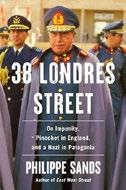
38 LONDRES
STREET
An international law scholar and practitioner points to the loopholes that allowed a tyrant to evade prosecution. Sands’ title comes from the former Chilean
Socialist Party headquarters that, in a cruelly ironic turn, became a center for the interrogation and torture of leftists after the military coup that overthrew the government of Salvador Allende in 1973. A second irony is that Augusto Pinochet’s coup was coordinated with the Nixon administration courtesy of Henry Kissinger, who at the end of World War II had been on the trail of the de facto head of Chile’s secret police. That man was a Nazi named Walther Rauff, inventor and administrator of the mobile gas truck of Holocaust infamy, who had escaped from Europe after the war and later managed a crabmeat cannery in Patagonia. When Pinochet was arrested in London for crimes committed during his reign, the linkages between his government and Nazis residing in South America became clearer. In a complicated series of trials to determine whether Britain could extradite Pinochet to Spain to be tried on charges of genocide— under, ironically again, a law promulgated during the Franco dictatorship—Pinochet’s attorneys claimed that the Chilean leader enjoyed immunity from prosecution as a head of state. Spanish attorneys conversely argued, as Sands writes, that “Pinochet was directly involved in the physical elimination, disappearance, kidnapping and torture of thousands of individuals.” Sands establishes a trail of evidence that links Pinochet to Rauff through a long acquaintance that began when both men were living in Ecuador. A final irony, perhaps, apart from the fact that after 17 months Pinochet was allowed to return to Chile, was that a journalist who helped find Rauff for execution by Israeli
intelligence agents—which never took place—was none other than Gerd Heidemann, the con artist behind the Hitler Diaries scam.
An extraordinary exposé of the collusion of Nazis with the Pinochet dictatorship in Chile.
Sebba, Anne | St. Martin’s (400 pp.) | $32 September 16, 2025 | 9781250287595

Eyewitness accounts of survivors’ sufferings.
The musicians of the women’s orchestra in the AuschwitzBirkenau extermination camp were required to play marches as exhausted, starving female prisoners left for and returned to camp after a day’s hard labor. They also played concerts for the infirmary, guards, and visiting Nazi dignitaries. Thus, they were forced to provide the aural backdrop to the ghastly murders of 1.1 million (mostly) Jews, gassed or dead from torture or starvation. Sebba, a British author, delves into the biographies of the musicians and their conductor, Alma Rosé, “descended from German musical royalty,” based on memoirs and survivor interviews conducted by the Shoah Foundation. Crucially, she tells the story not only of the players, but also of their audience of fellow prisoners. “How could we play light music here, against the background of the flames and black smoke that billowed day and night from the crematoria chimneys?” reflects one survivor. The author leaves open the
question of whether the music helped prisoners or intensified their suffering. She makes clear, however, that the orchestra did not play during the “selection” of poor souls sent to the gas chambers. The players’ musical skills saved at least their own lives, exempt from the work squads, though they themselves were exhausted and starving, and Jewish orchestra members were always vulnerable to “selection” for gassing. Their resident block was mere meters from a crematorium, and human ashes settled inside some of their instruments. They experienced the “scandal of music at Auschwitz on a daily basis,” as the Nazis’ abuse of music was itself “a form of torture.” Their playing was an “effort to claw back something of what it meant to be human.”
An important and heartbreaking contribution to Holocaust history.
Shallow, Parvati | Dial Press (256 pp.)
$27.9 | July 8, 2025 | 9780593730577
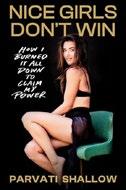
A reality television star and cult survivor bounces back.
Shallow’s parents first attempted to escape from a commune run by a cruel and abusive religious zealot when Shallow was 2 months old. They finally left for good when Shallow was in elementary school. The author believes that in adulthood, the chaos of her early years fueled her instinct to constantly flee any and all difficulty and to hesitate to find stability. She writes, “I would gloss over pain, bounce from relationship to relationship, move constantly, often donating everything I owned to Goodwill, and never settle in one place for long.” This affinity for change follows her into her stints on
the television show Survivor, where she wins the Fans vs. Favorites season and, a few years later, is cast as a villain in the Heroes vs. Villains season, a characterization that took her by surprise. The pressures of these shows, the intense emotions surrounding her short marriage, and her brother’s untimely death as a result of his struggle with addiction all tax her nervous system. As a result, Shallow commits to somatic therapy, a healing practice that helps her find love in a new, queer relationship with a nonbinary comic and allows her to reenter reality television—as a cast member on The Traitors —without losing her sense of self. Shallow’s narratorial voice is intimate and honest and feels like she’s in conversation with a close friend. The prose is sometimes unpolished, but the book’s fast pace and clear narrative arc make this a quick read.
A reality star’s enjoyable memoir about finding healing.
Stuart, Toby | Simon & Schuster (288 pp.) $29 | September 2, 2025 | 9781668001875

How a particular social phenomenon shapes our lives, prospects, and futures. In modern society, according to UC Berkeley business professor Stuart, “anointment” refers to “a ubiquitous process in which a person or institution
of high regard confers status on something or someone else explicitly or simply by association.” (The author readily acknowledges that he is one of the anointed himself.) A Rembrandt painting is considered magnitudes more valuable than an almost indistinguishable reproduction by a no-name artist. This is an example of the “Big Shift,” a term Stuart uses to describe one of the mental shortcuts that anointment allows us to make: We evaluate the worthiness of a person or object by the status or prestige of its affiliations rather than its inherent quality. Unfortunately but unsurprisingly, anointment contributes to inequality. Graduates of a particular elite institution may favor candidates with the same credentials when considering potential job applicants. Individuals who earn reputations as visionaries, such as Elon Musk and Steve Jobs, are often protected from the consequences of their bad behavior and are granted far more benefit of the doubt about their failures. People with low status, frequently members of underserved racial and social groups, lack the networks of anointed individuals that would allow them to gain higher status. However, the myth of American meritocracy persists among individuals of all status levels despite overwhelming evidence to the contrary. In a passage describing humans’ proclivity for rankings, Stuart writes: “Tripadvisor ranks hotels and restaurants. People magazine seems to rank everyone.” The author’s boxed summarizations of key points and his academically tinged sense of humor contribute to the approachability of this slim but thorough work. Given his thoroughness,
How “visionaries” are often protected from the consequences of their bad behavior.
Stuart’s rosy predictions in the closing chapter about how artificial intelligence will revolutionize and democratize human decision-making feel relatively underbaked. Still, his book on the whole ably outlines the necessity for deeper understanding of an intuitive and powerful human behavior. An informative and highly engaging exploration of an influential social status dynamic.
Taseer, Aatish | Catapult (240 pp.) $27 | July 15, 2025 | 9781646222797
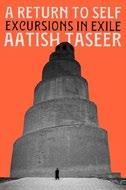
Life in exile. In 2019 journalist Taseer wrote a cover story for Time magazine calling Indian Prime Minister Narendra Modi “India’s Divider in Chief.” Months after the article’s publication, the Modi administration revoked Taseer’s immigration status, forcing him to leave India, where he had lived most of his life after being born in Britain. Losing his legal status in the country leaves Taseer emotionally adrift. His exile prevents him from visiting his beloved grandmother in the days before she dies. It also forces him to confront the tenuous relationship he has had with the place he calls home. Being a gay man and “the illegitimate son of a Pakistani” yields what the author describes, in these essays, as a lifetime spent in “the crucible of all anxieties related to belonging.” In response, Taseer uses his travels around the world to interrogate the idea of home. In Mexico, he reflects on the origins of rice to ponder the idea of authenticity. In Sri Lanka, he explores how the symbolism of the lotus became associated with political parties built on hate. In Bolivia, Mongolia, and Iraq, he attends pilgrimages in search of “the great metaphors for the ties that bind and those we are prepared to shrug off.” Taseer’s work is
lyrical, heady, and vulnerable, expertly weaving memoir with research and reflection. He writes, “I woke up one day to find the bars of my prison had magically disappeared, and, far from being scared, I felt a new vein of intellectual curiosity had opened for me.”
A queer Indian journalist travels the world in search of home in this poetic, insightful travelogue.
Tatum, Beverly Daniel | Basic Books (368 pp.) $30 | September 2, 2025 | 9781541606616
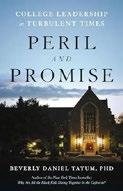
Who wants to be a college president today? After the challenges of the Covid-19 pandemic, the increasing suspicions about higher education in America, the assertions of student protest, and the oversight (or overreach) of politicians into university management—after all of this, who wants the job? Tatum thinks you should. The former president of Spelman College and Mount Holyoke, she is the author of a classic study of race relations on campus, Why Are All the Black Kids Sitting Together in the Cafeteria? Her new book, part memoir, part manifesto, and part memorandum, makes the case for leadership in higher education as a matter of interactive listening and shared governance. Tatum offers a series of case studies of conflict resolution to come up with some ways of balancing free speech and personal respect, community participation and executive decision-making, and faculty academic freedom and scholarly standards. What is her answer? Listen to as many voices as you can. Never make a decision that comes as an absolute surprise. And don’t call the police. Tatum translates DEI into ABC: affirm the
identity of all students; build a shared sense of community; nurture the leadership capacity of the students. This recipe may not work for everyone. The author acknowledges that leadership in any institution is not so much a matter of following a script as cultivating character. “Institutions must rely on the quality and character of leadership to think clearly, communicate effectively, and make hard decisions in a timely manner, providing calm and reassurance amid communal anxiety.” Tatum is someone with great judgment and sagacity, patience and persistence. It will be left to the next generation of college leaders to see if her example can translate into their own success.
An eloquent, personal case for college leadership based on building communal governance and institutional trust.
Wade, Francesca | Scribner (480 pp.) $31 | October 7, 2025 | 9781982186012

A life after death. British biographer Wade was a fan of Gertrude Stein, “intrigued— and confounded—by her contradictions… her indefatigable self-mythologising, her wry probing of genre and gender. Above all,” she admits, “I was drawn to her work—even if, at first, I didn’t know what to make of it.” Her inspiration for writing about Stein came when she found, at Yale’s Beinecke Library, a trove of notes made by a literary scholar, Leon Katz, newly opened to researchers after Katz’s death in 2017. Drawing on Stein’s unpublished texts, private jottings, and months of interviews with Alice Toklas, Katz documented significant facts about Stein that suggested a more complex image of the self-proclaimed genius and her diffident companion than what was widely known. Wade decided to structure her book in two parts: the first, an overview
GERTRUDE STEIN
of “the narrative she crafted carefully”; the second, her afterlife: “the years in which her posthumous legacy was constructed, celebrated and contested, by all with a stake in the evolving legend— chief among them, Alice B. Toklas.”
Drawing judiciously on archival material, Stein’s autobiographies, recent scholarship, and biographies of Stein by Brenda Wineapple, Linda Wagner-Martin, and Janet Malcolm, to name a few, Wade creates a lively account. She astutely handles controversial issues, such as Stein’s politics, and she dives bravely into the tangled web of Stein’s afterlife: family discord, frustrated efforts to see all of Stein’s works published, Toklas’ financial troubles, and, of course, her disclosures to Katz, which complicated “the public image of mutual devotion” that Toklas insisted on throughout her widowhood. Nevertheless, while Wade’s revelations contribute to a nuanced portrait of Stein, Toklas, and their relationship, they fall short of elucidating the hermetic, insular writing that continues to confound Stein’s readers.
A probing examination of an enigmatic writer.
Rehab: An American Scandal
Walter, Shoshana | Simon & Schuster (336 pp.) $29.99 | August 12, 2025 | 9781982149826

Examining failures of the addictiontreatment industry through real-life stories.
Journalist
Walter takes readers on a tour of what addiction treatment looks like in the United
States. We meet Chris, a white Louisianan who works 80 hours a week and has no time or energy for counseling; April, a Black Philadelphian who struggles to get herself straight and her children back; Larry, a white doctor in Indiana who builds a practice around a newly approved medication for addiction; and Wendy, a white Californian whose son died at a recovery center. The book’s chapters rotate among the four narratives, walking the reader through the harrowing and the hopeful. Their stories are as compelling as they are hard to read, because Walter scrutinizes a largely hidden world that over-promises and under-delivers. The book is well written and strikes a good balance between the personal narratives and the broader racial and political contexts in which they play out. Readers are faced with a litany of ironies, such as 28-day programs, which can help people detox but also put them at higher risk of death should they relapse. Prescribing rules allow doctors to dole out Oxycontin, a pain medication that has contributed to the addiction crisis, to any number of their patients but drastically limit dispensing Suboxone, a treatment drug. The Affordable Care Act helped boost the recovery industry, which was sorely needed, but also allowed rapid growth of for-profit treatment centers that were more focused on making money than on making people better. Walter examines practices that are at odds with research evidence, such as the fact that most people go through multiple attempts at recovery before they reach lasting sobriety, suggesting that intakes should be easier and that efforts to boost post-treatment
care, including housing and employment, should be part of the mix. A nuanced and deeply reported exposé of America’s $53 billion addiction-treatment industry and how it harms all of us.
Weinstein, Emily Meg | Simon Element (288 pp.) $28.99 | September 2, 2025 | 9781668047859
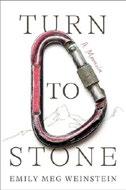
A woman heals from heartbreak via her newfound obsession with the sport of rock climbing. Weinstein is no stranger to risk and adventure, having traveled widely and rather daringly, frequently with her best friend, Leila, at her side. But following a particularly brutal breakup with a manipulative and violent boyfriend, she flees Brooklyn and its punk rock scene for refuge in the outdoors culture of the West Coast. She finds her way to climbing at the invitation of “dirtbag” campground buddies and quickly finds herself on the fringes of legendary climbers, drawn to the focus and persistence that the sport demands and the potential perilousness of its brushes with failure. She takes to the sport with urgency and desperation to escape the “sorrow and shame” chasing her. The vulnerability that Weinstein shows in early chapters that recount her breakup gives way to a collection of rocks and routes, climbing and romantic partners. At the heart of her story is a self-transformation facilitated by her confrontations with danger and death’s possibility while ascending the rock. She discusses a range of influences, desires, and expectations that she has tried for decades to reconcile: the caution and fear of her parents, her longing for a partner and family, and the comparative conventional success of her peers. Additional commentary
on sociopolitical issues and occasional judgments about her new hobby’s participants pepper the text. The depth of her metamorphosis occasionally becomes muddied by the technical jargon and frequent marijuana use of her new sport, with moments of insight and understanding periodically poking out between vertical conquests and descriptions of otherworldly surroundings. While the less vertically inclined reader may leave thirsty for a more thorough and deliberate reflection, Weinstein nevertheless makes a case for stepping radically outside of one’s physical and philosophical comfort zones to find strength and purpose.
A spirited, if at times scattered, story of self-preservation and discovery.
Winner, Reality | Spiegel & Grau (336 pp.)
$30 | September 16, 2025 | 9781954118843

Whistleblower/ leaker (depending on your POV) Winner writes of a fateful decision that earned her years in jail and prison.
“The world’s biggest terrorist has a Pikachu bedspread.” So a reporter learned from former National Security Agency analyst Winner’s mother. In this matter-offact narrative, Winner, who “helped the United States government kill people,” opens on May 9, 2017, when she downloaded and printed a
five-page document of Russian cyberattacks on U.S. election officials and a company that makes software for voter registration. Why she did so, she allows, was a subject she pondered often as she served out a five-year prison term, part of a sentence that was the longest incarceration for any single-incident leaker. (By contrast, Edward Snowden leaked 1.5 million pages.) Winner’s crime was to send those printed pages to an online site that specialized in national security matters. As she writes, astonishingly, a staffer described the pages to a source who in turn notified the FBI; meanwhile, the staffer also called the NSA and sent photographs of the printed pages, violating “standard Reporting 101 protocols for journalists who need to confirm the authenticity of leaked documents.” Traced to her by virtue of a printer code, the document occasioned her arrest and conviction under the terms of the Espionage Act of 1917, meant as a legal tool against German secret agents during World War I. After 15 months in jail, a plea bargain earned her a spot in federal prison, “a vacation, filled with activities and amenities,” compared to where she’d been. Winner writes candidly about the hellish nature of incarceration in America, from constant violence to boredom and the challenge of contending with conflicting and arbitrary rules, with her fellow prisoners more often than not less dangerous than the staff: “these weirdos, outcasts, and criminals loved me, and I loved them back.”
A sobering but evenhanded account of punishment meted out for leaking classified information.
“The world’s biggest terrorist” tells of the hellish nature of her incarceration.
Witt, John Fabian | Simon & Schuster (656 pp.) $35 | October 14, 2025 | 9781476765877
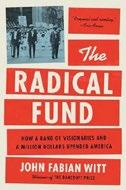
How a young man “launched a most unusual experiment in democratic change.”
“The opportunity presents itself once more,” reads the final sentence of Witt’s account of the American Fund for Public Service, which worked to reshape American democracy and civil rights between 1922 and 1941. It’s a perfect coda. Then as now, the U.S. interwar years saw the post-pandemic election of a president who promised to “restore the greatness of an imagined Anglo-Saxon past” amid vast and widening wealth inequality, racial unrest, and a public-information environment where “critical political thinking,” as ACLU founder Roger Baldwin put it, “[was] dead.” Launched through the inheritance of Charles Garland, a reluctant heir who subscribed to H.G. Wells’ vision of a “society based on a ‘spirit of service’ rather than a ‘spirit of gain,’” the fund would go on to punch well above its relatively modest weight. It gave away less than $2 million across 19 years and nevertheless managed to finance a range of transformative legal causes, including those spearheaded by the likes of the ACLU and the NAACP. It also financed less-well-known organizations, such as the Brotherhood of Sleeping Car Porters, one of the country’s first influential Black labor unions. This is a book to admire and read deliberately. A Yale law professor, Witt effortlessly switches between sharp profiles and nuanced portrayals of landmark decisions. Casual readers, in their efforts to keep up, may find themselves paging back in sections. Elsewhere, the book’s unflinching accounts of race and labor violence leave a mark. So does
its call to action. About 150,000 Americans, Witt writes, have “assets worth more than $30 million, roughly equivalent after inflation to the amount given away by the American Fund’s directors.” While the American Fund made gains in building a better world, “its triumphs were not final.” This book urges: Let’s keep going.
An important and meticulous look at the impact of a forgotten fund’s revolutionary work.
Creative Freedom as an Act of Resistance
Younge, Gary | Faber & Faber (45 pp.) | $10 paper | September 23, 2025 | 9780571396610
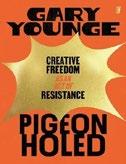
Exposing racism in society, in the newsroom, and on the printed page. In this slim volume, Younge tackles an enormous question: How does a Black journalist navigate the white-dominated world of British media? Younge speaks from long experience. At the Guardian for almost three decades, he covered stories as far-ranging as police brutality, Nelson Mandela’s presidency, and Hurricane Katrina. Though less than half of his pieces were about race, he was dubbed by one columnist as “the Guardian ’s black journalist who writes ‘black stories.’” Ironically, his first column for the paper, about Bosnia, was spiked because the editor wanted him to add an “ethnic sensibility.” Born in Hertfordshire to Barbadian parents, Younge knew very few Black people. “When I entered a pub in most Scottish cities or any rural area in Britain, there was always this fragment of silence as I single-handedly integrated the space.” Starting out in journalism, he says, felt like going into one of those pubs. Two decades later, Black journalists made up only 0.2% of staffers at British outlets. Younge is highly critical of
A former model faults a cultural milieu that degrades Asian American women.
FETISHIZED
mainstream media that have few Black decision-makers but put Black journalists in front of cameras, mistaking photo opportunities for equal opportunities. Invoking wisdom from James Baldwin, Langston Hughes, and Shonda Rhimes, he acknowledges that while he aims to speak to the Black community in a relevant voice, “I hope I am never deluded enough to think I can speak for it.” He insists that though he may not represent Black people, “it’s important that I don’t misrepresent them. For it would also be reckless to contribute to an atmosphere in which relatively vulnerable people were made more vulnerable by my work.” After all, being Black in Britain means one is more likely to be stopped, searched, arrested, incarcerated, unemployed, underpaid, or homeless. By honestly reflecting on the complex challenges of his career, Younge hopes “to broaden the space for what we all might write.” A frank and necessary look at being a Black journalist in mainstream media.
Yu, Kaila | Crown (256 pp.) | $30 August 19, 2025 | 9780593728017

A former pinup model analyzes how her Asian American identity has affected her life and career.
Yu, a Taiwanese American, wanted to become part of the entertainment industry at a time when Asian American role models were few and far
between. Some who were successful catered to tropes that fetishized Asian women in service to white male “Asiaphiles” invested in the “myopic, generalized belief that Asian women inherently embody traits of submissiveness and obedience.” Yu longs to embody the opposite of these traits but feels that her sexuality is the only tool she has to become the person she longs to be. She writes, “I felt the straightest path to empowerment was through courting the white male gaze.” Yu’s pursuit of success within a cultural milieu that degrades and fetishizes Asian American women traumatizes her on multiple levels. Most notably, as an up-and-coming model, she ends up at a photo shoot where the director sexually assaults her, films the encounter against her will, and releases the video publicly without her consent. The unprocessed trauma follows her through her successful career as a model, a coveted cameo in the movie The Fast and the Furious: Tokyo Drift, and a member of the all-girl Asian American rock band Nylon Pink. Yu struggles with addiction, an issue that she connects with her desire to escape both the memories of her assault and the compromises inherent in pursuing a career dedicated to appeasing the white male gaze. This is a raw memoir, and Yu expertly balances visceral, emotional scenes from her life with trenchant social criticism.
A disturbing but well-told memoir about the true costs of Asian fetishization.





Haley Cohen Gilliland
Molly Jong-Fast



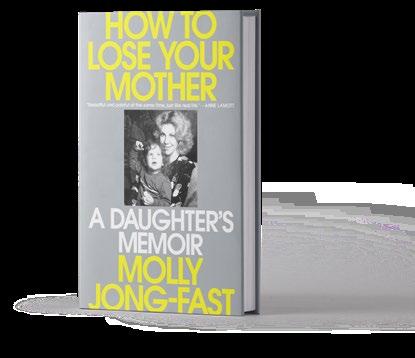
Amanda Hess
Sarah Spain & Deland McCullough
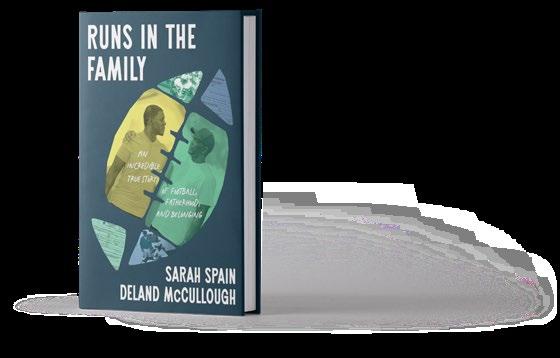


WHEN I WAS a child, works such as The Diary of Anne Frank , Lois Lowry’s Number the Stars , and Bette Greene’s Summer of My German Soldier gave me a far more nuanced understanding of World War II than textbooks alone. But with so many titles devoted to this topic, especially lately (a recent Wall Street Journal article speaks to the trend), is there still more to say about the Second World War?
My answer is a resounding yes. I recently revisited Safiyyah’s War by Hiba Noor Khan (Allida/HarperCollins, 2024). Inspired by actual events, the novel— a Kirkus Prize finalist—centers on the Grand Mosque of Paris, which sheltered Jewish people during the Nazi occupation. I was moved by the work—and shocked I hadn’t known about this powerful act of resistance. The war affected millions, and there are countless stories we have yet to hear, especially those involving people of color.
As they so often do, kid lit authors are leading the way. Pearl , a graphic novel by Sherri L. Smith,
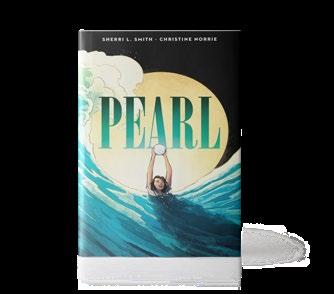
illustrated by Christine Norrie (Graphix/Scholastic, 2024), follows a teen who travels to Japan to visit her great grandmother; stranded in the wake of Pearl Harbor, she’s still in Hiroshima years later when the atomic bomb ravages the city. While the bombings of Hiroshima and Nagasaki are covered in history curricula, many young people remain woefully uninformed about their impact. (Michigan State University historian Naoko Wake, for instance, notes that before taking her class, most of her students had never seen photos of the aftereffects of the bombs.) A potent counter to U.S. centric WWII media, Pearl eschews gruesome depictions in favor of searing visual
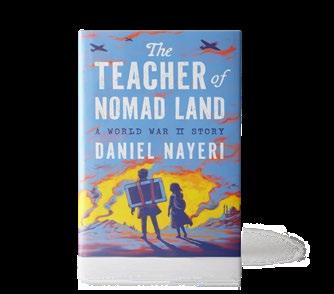
metaphors that nevertheless impart a devastating truth: War is indeed hell.

the most vulnerable can make a difference.
Daniel Nayeri’s The Teacher of Nomad Land: A World War II Story (Levine Querido, August 26) finds two orphans fending for themselves in the mountains of Iran after their father is killed during the AngloSoviet invasion of their country. Setting his tale in a neutral nation under the domain of the Allies, Nayeri explores a side of the war rarely seen in children’s literature (or adult, for that matter) as the siblings— seemingly mere pawns at the mercy of forces beyond their control—manage to protect each other, a young Jewish boy they encounter, and a tribe of nomads on their annual migration; this tale demonstrates how even
With The Sky Was My Blanket: A Young Man’s Journey Across Wartime Europe (Farrar, Straus and Giroux, August 19), the late Uri Shulevitz tells the story of his uncle Yehiel Szulewicz, a Jewish Pole who in 1930 left home at age 15 in search of adventure and found turmoil and upheaval. Bearing witness to the rise of Nazism and the emergence of fascism in Italy and Spain, Yehiel fought authoritarianism every chance he got. This is both a remarkably wideranging and cogent view of history and an account of a hero whose acts of courage feel all too relevant today.
Mahnaz Dar is a young readers’ editor.
Artistically minded rodents fight back against their feline terrorizer in Tonatiuh’s prescient fable.
On a dreadful, starfilled night, a looming shadow (“¡Un gato!”) falls over the bustling, effervescent town of Mousetepec, and everything changes. As the cat uses its terrible claws to frighten the residents, Mousetepec loses its colorful spirit: The mousefolk stay home, the mercado closes, the fiestas stop, the plaza remains quiet, and the raspado cart stands abandoned. To bring cheer back into their lives, Vida and her brother, Máximo, start painting household objects—containers, jugs, bottles—in kaleidoscopic
colors while transforming old buckets and cereal boxes into vibrant masks. When Máximo wanders outside in an illtimed attempt to bring color back to the town, Vida rushes to his aid, donning one of their frightfully colorful masks to scare the lunging cat away. The confrontation spurs Vida to dream of a large neon creature called an alebrije, which inspires a plan to scare away the creature that’s been menacing Mousetepec.
Tonatiuh expertly maintains a brisk pace that engages and tickles. His familiar pre Columbianflavored artwork beautifully complements this simply told yet moving fable of collective resistance,

Tonatiuh, Duncan | Abrams | 48 pp. | $18.99 November 11, 2025 | 9781419764592
boasting bursts of color and provocative shadows across splendid doublepage spreads. Insightful backmatter on alebrijes—folk art sculptures— and the tale’s origins draw incisive parallels between the art
form’s history in Mexico and the increasing violence that has afflicted the country over the past few decades. Utterly mesmerizing. (glossary and pronunciation guide, bibliography) (Picture book. 4-8)
Kate Messner; illus. by Christopher Silas Neal
103
By Daniel Miyares
Bright in
By Eureka O’Hara & Dan Poblocki; illus. by Ricardo Bessa 108 Seven Ways Through the Woods By Jenn Reese; illus. by Devin Elle Kurtz 108
Around a Year By Mariana Ruiz Johnson; trans. by Avi Silberstein
By Duncan Tonatiuh
Kirkus Star
A Sea of Lemon Trees: The Corrido of Roberto Alvarez
Águila, María Dolores | Roaring Brook Press (304 pp.) | $17.99
September 16, 2025 | 9781250342614
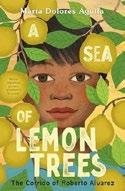
Based on the true story of Roberto Alvarez and the 1931 Lemon Grove Incident court case, picture book author Águila’s middlegrade debut follows unsettling changes that upend and galvanize a community. Over winter break, Roberto’s classmate Socorro’s cousins arrive in San Diego, driven away from Oklahoma by deportation raids on Mexican families. When break is over, Roberto, an eager student who excels in his studies, is barred along with other Mexican American students from Lemon Grove Grammar School. They’re told to attend the new Olive Street School, which is housed in a renovated barn. Roberto knows this is wrong. The barrio residents quickly organize as el Comité de Vecinos de Lemon Grove and take legal action. Twelve year old Roberto becomes the lead plaintiff in what will become a life changing desegregation case—the first successful one in the U.S. Despite threats and the looming fear of retaliation, the community stands firm. Families raise legal funds, face truancy charges, and suffer the deportation of loved ones. Ultimately, the court rules in their favor, but the victory is bittersweet after the losses they’ve endured. This evocative novel in verse
is beautifully crafted with both gravity and heart. Roberto’s voice is powerful and lyrical, capturing feelings of fear and solidarity. An informative author’s note provides historical context about the Lemon Grove Incident and the Mexican Repatriation of 19291939, making this an especially timely and poignant read.
A moving portrait of community resistance and a young boy’s quiet courage. (historical note, bibliography) (Verse historical fiction. 8-12)
Alary, Laura | Illus. by Ana Eguaras Beaming Books (40 pp.) | $18.99 September 30, 2025 | 9798889830153

An ice storm that dashes a young boy’s holiday plans also helps him find a connection to the first Christmas. Paleskinned
Aiden’s been counting down on his Advent calendar—one more day till his grandparents arrive, two more until the church Nativity play (he’ll be playing the Star of Bethlehem), and three more until Christmas! But that night, it snows. The icy roads mean Grandma and Grandpa can’t travel. Worst of all, downed power lines mean no electricity or heat—and no play. But the family members fill their days with quiet merriment: reading stories, eating meals by candlelight. On Christmas Eve morning, Aiden and his father brave the icy urban sidewalks to buy coffee and doughnuts and spend the day delivering the treats to neighbors in their diverse community
before the whole family heads to a spontaneous Christmas Eve potluck dinner. As the night winds down, Aiden’s mom retells the story of the Nativity, and Aiden finds special meaning in the tale: Were Joseph and Mary scared? Hungry? Cold? Did they appreciate the kindness of their newfound community? Filled with warmth and joy, Aiden hears the voice of angels: “Don’t be afraid. God is with you.” Alary caps her earnestly told narrative with an author’s note about her own stormy Christmas experience. Richly colored cartoon illustrations capture the silvery ice of the storm and bathe Aiden’s shadowy world with a tender glow.
Awash in the true Yuletide spirit. (activities) (Picture book. 4-8)
Allen, Ryan | Illus. by Zoe Persico Little Bee Books (32 pp.) | $14.99 September 23, 2025 | 9781499817461
Series: Kind and Caring Kids

Gentle parenting suggestions to help kids curtail the temptation to physically lash out at others. Many youngsters go through a hitting phase; addressing the causes of this behavior is crucial. As Allen, a licensed therapist, advises in the backmatter, “If you can figure out why your child is hitting, then you can teach them a healthy replacement.” As his story opens, Laila’s mother is chaperoning a class trip to the zoo—and her annoying little brother, Reggie, must tag along. Three different scenarios— Reggie hogging the window on the bus, a classmate monopolizing the playground slide at the zoo, and Reggie taking too long to eat his cotton candy—result in frustration; Laila’s body tenses, her face gets hot, and her hands itch to hit or shove. Motivated by anger stemming from limited patience, struggles with emotional regulation, and lack of problem solving skills, she reaches a
breaking point each time. Caring adults swoop in with ways to help her calm down. Hazy, darker colors swirl around clenched fists to depict Laila’s mounting irritation, while redhot flames suggest her extreme rage. Purple hued clouds at the end signify that Laila has learned to control her actions. Though the narrative is on the preachy side, the advice is valuable; the appended note to parents and caregivers further explores the impetus to hit. Laila and her family are brown skinned; her class is diverse.
Useful strategies for kids attempting to get a handle on big emotions. (Picture book. 3-6)
Aung Than, Gavin | Scholastic (24 pp.) | $8.99 paper | September 2, 2025 | 9781546138426
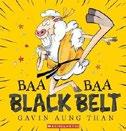
A haughty sheep has a misconstrued view of his martial arts abilities. With hooves flying in a sprightly jump and a toothy, proud smile on his face, a bipedal sheep shouts out his nickname: “They call me… // Baa Baa Black Belt!” With a deadpan look, another sheep on the farm retorts, “We never call him that.” The martial arts master shows off some of his incredible techniques, accompanied by his reluctant student, a pig named Pork Chop. Alas, when Baa Baa Black Belt attempts to break a piece of wood, he winds up injuring his hoof (immersed in Hamlet , Pork Chop scarcely looks up), and his “spinning BACK KICK” causes a pile up of cows, each knocking the other over like a row of dominoes. Perhaps Baa Baa Black Belt’s skills aren’t quite up to par, but that doesn’t stop him from striking a winning pose and basking in imagined glory—even if the cows aren’t so amused. Filled with giggle worthy asides from peripheral farm friends, silly happenstances that play directly against the protagonist’s ego, and
goofy, exaggerated cartoon art, this Australian import will have storytime audiences rolling in the aisles (but hopefully not kicking and chopping). A laugh-inducing look at a puffed-up personality. (Picture book. 3-6)
Bailey, Catherine | Illus. by Fiona Lee Union Square Kids (40 pp.) | $18.99 August 12, 2025 | 9781454948551

One mild, sunny day, a town slowly awakens.
“Empty sidewalks doze. / Tree boughs gently sway. / Main Street blinks awake, quiet, still, and gray.” Minimally detailed, purplish drawings of two story houses with subtle facial features move across the gutter in the foreground, while in the background, yellow sunbeams shine down on trash bins with sleepy smiles. “Soft light slowly spreads, / bin by sleepy bin. / Flag scoots up the pole. / Produce van pulls in.” Bailey’s text continues its easy rhythm and rhyme, combining charming whimsy such as a lamppost standing up straight and eggs that “scramble onto plates” with realistic, everyday events including workers opening shops, cleaning clock faces, and scrubbing sewer covers. Onward to flowers that “primp and preen” (Bailey makes rich use of vocabulary) and street market tents that smile! Lee’s naïve artwork perfectly complements the verse, planting subtle smiles on all manner of things living and nonliving. Keen observers of the art will notice a ubiquitous red cat that’s finally called out in the text toward the end. A diverse human population appears throughout; a bird’s eye view of the town square is especially noteworthy. This book is best shared in an intimate setting so readers can spend time poring over the illustrations— crucial to the appreciation of the warm, lulling words.
Sweetly affirming and quietly clever. (Picture book. 4-8)
Benatar, Pat & Neil Giraldo | Illus. by Tiffany Everett | Sourcebooks Jabberwocky (40 pp.) $18.99 | September 9, 2025 | 9781728298023
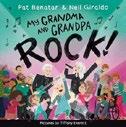
Rock legends, husbandandwife team, and proud grandparents Benatar and Giraldo present an upbeat ode to families.
A youngster with long blond hair confides conspiratorially, “This might come as a bit of a shock, // but my grandma and grandpa…ROCK!” The silverhaired duo—who resemble the coauthors—jam out in a practice space; Grandpa strums an electric guitar, while Grandma belts out a tune, microphone in hand. (All three are paleskinned.) Jagged star strokes burst from the amps, reverberating across the page. As the young narrator sings the praises of these hip, artistically minded grandparents, the illustrations depict many varied, diverse families making music. One grandparent strums a ukulele, another prefers the drums, and an especially eclectic granny croons everything from lullabies to Led Zeppelin while cooking. There’s no wrong way to share joy with grandparents. Benatar and Giraldo acknowledge that you don’t have to be a musician to rock (“Anyone can rock! / It’s a state of mind, / like feeling happy or being kind”) as they speak to other passions and occupations (“They can be a plumber, a chef, a pilot, a teacher”). One spread showcases other names for grandparents, both colloquial and cultural, presented without disrupting the text’s rhythm. As expected, this pair lays down a steady beat with a smooth flow. Everett’s energetic art, with musical swooshes and swirls, buoys the text.
A fresh, melodic take on family harmony. (Picture book. 3-6)

Bolling, Valerie | Illus. by TeMika Grooms
Charlesbridge (32 pp.) | $17.99
September 16, 2025 | 9781623545826

A civil rights activist began her quest for justice as a child.
Growing up in segregated South Carolina, Marian Wright Edelman was admonished for drinking from a fountain meant for white people—an experience that left its mark on the then 4 yearold. Her hero, the abolitionist Sojourner Truth, once responded to a white man’s dismissive remarks (“Why I don’t care any more for your talk than I do for the bite of a flea”) with an equally determined retort (“Perhaps not, but Lord willing, I’ll keep you scratching”). Calling herself a “flea for justice,” Marian fought injustice any way she could: As a child, she switched the signs on segregated water fountains, and while in college, she participated in protests at restaurants that refused to serve African Americans. As the first Black female lawyer in Mississippi, she defended activists arrested for helping African Americans register to vote. She marched with Dr. Martin Luther King Jr. and, after he was killed, channeled her efforts into young people’s education, establishing the Children’s Defense Fund and Freedom Schools. Bolling writes in a lively, even playful tone, frequently posing questions to her young audience, returning often to the flea metaphor, and leaving readers with a final challenge: “What will you do to make someone scratch?” Closeups of faces—Marian’s, Sojourner Truth’s,
and King’s, as well as those of the students whom Marian touched—dominate Grooms’ vivid digital art. A spirited account of a life devoted to service. (timeline, additional information, author’s note, additional reading, source notes, bibliography) (Picture-book biography. 6-9)
Bowling, Dusti | Bloomsbury (240 pp.)
$17.99 | October 7, 2025 | 9781547616060

A 13 year old bull rider unpacks masculinity, selfinflicted expectations, and finding one’s purpose. Canyon Cress wants to win the Junior Bull Riding World Championship to impress his longtime rodeo friends, Dakota and Tate, garner a life changing $10,000, and (he believes) return his alcoholic father to the great man he was before Canyon’s mother died in an accident. In the meantime, Canyon watches over little sister Josie and resents the trappings of their lowincome life, including a tornup couch, mac and cheese dinners, and free school lunches. He finds muchneeded adult support from Grandma, Uncle Ty, and bullfighter Ray, all of whom worry each time Canyon climbs onto a bull. Canyon wrestles with living up to his father’s legacy as an accomplished bull rider and with the “cowboy up” mindset that means never quitting. Canyon’s mother was a gifted fiddler, and his own regular playing brings him the healing, calming power of music—and, perhaps, a concussionfree alternative to his
Captures the hard work and patience it takes to grow one’s own food.
TALES
favorite sport. The story cites realworld fiddle songs and rodeo champions, lending credibility and immersive authenticity to Canyon’s interests. Early emotional beats pay off in big, earned tearjerker moments by the end, and secondary characters’ backstories develop in a satisfying way over the course of this story, which will hold appeal for fans of Gary D. Schmidt’s Orbiting Jupiter and Jupiter Rising. Most characters are coded white, and Ray is Black.
An empowering story about boys and men learning to reinvent themselves in the wake of pain and tragedy. (Fiction. 8-13)
Buckley, Michael | Illus. by Forrest Burdett Little, Brown (288 pp.) | $14.99 | August 26, 2025 9780316572699 | Series: The Weirdies, 1

Three children seek acceptance and love through peculiar means. Tenyearold triplets Barnacle, Melancholy, and Garlic “decided to be as weird as possible” to get the attention and affection of their rich, eccentric, and neglectful parents. When this ploy fails and their parents abandon them, they push away their adoptive mother, Miss Emily, so she can’t disappoint them, too. But sunny Miss Emily refuses to give up—even when the kids’ biological parents, Mr. Weirdie and the Enchantress, return to claim them as part of a scheme to get their hands on more money. The parents are terrible, and the children have a taste for destruction and violence. They’re also impossibly odd: Barnacle doesn’t have a skeleton, Melancholy collects “bones and teeth and the occasional ear,” and Garlic naps with ticks and poison oak. The book contains two stories—“In Which Misery Rains Down on Innocent People” and “In Which Tragedy Runs Amok”—and the ending of the second one feels unsatisfying and designed to set up a sequel. The plot is fairly
simple, and the characters lack depth; the narrator speaks directly to readers, but much of the humor is likely to sail over younger audiences’ heads. The Mad Libs–esque weirdness is the whole point, but it comes across as window dressing, overpowering the messages about trust, love, and fitting in. The Weirdies are “so white you [can] almost see through them,” and Emily is cued white. Final art not seen. All weird whimsy but little heart. (Fiction. 8-12)
Burks, James | First Second (128 pp.)
$12.99 | September 16, 2025
9781250341938 | Series: Box Tales, 1

Two friends cultivate a sweet snack. Bea and BFF Box (a sentient cardboard container) are so excited for strawberry season that when they get their hands on the delectable fruit, they devour it all in one sitting. Although they beg for more, Mom refuses to purchase additional strawberries; the fruit is expensive. She will, however, support them in growing their own strawberries. Bea and Box set off optimistically, planting green strawberry tops and watching their pile of dirt obsessively. Nothing sprouts, but after a little research at the library and a lot of guidance from their neighbor Mrs. Gomez, a knowledgeable gardener, they plant seedlings that ever so slowly begin to bear fruit. Blending a gardening primer with a buddy comedy, this graphic novel smartly captures the hard work, patience, and luck it takes to grow one’s own food and, by extension, encourages readers to appreciate the sweet treats they gobble up. Burks’ agreeably overthetop cartoon artwork leans into the drama; Bea and Box’s gungho partnership is infectiously enjoyable. These two have a lot to learn, but they’re ready to meet the challenge. Bea and her mom have brown hair and
olive skin; Mrs. Gomez welcomes them in Spanish and is cued Latine. A playful, fact-filled adventure in gardening. (Graphic informational fiction. 5-9)
Cameron, W. Bruce | Illus. by Richard Cowdrey | Starscape/Tor (272 pp.)
$17.99 | August 26, 2025 | 9781250815620 Series: Dogs With a Purpose

A small dog with a big heart takes charge of sheep, goats, and a very special boy on a struggling ranch in the latest entry in the Dogs With a Purpose series. As a corgi puppy, Stella may not look the part of a sheepherding dog to those who aren’t in the know—but she’s smart and descended from a breed originally designed to herd livestock. Stella comes to Raging River Ranch with all the self confidence she needs to guard a woolly flock and learn the special commands her beloved new boy, 13 year old Mateo Schmidt, teaches her, including “Come Bye!” “Away to Me!” and “Drop!” Detailed, dog’s eye views of training and ranch life lend the book a strong air of authenticity. Cameron intertwines a human tale of a family troubled by devastating losses, including the death of Mateo’s mother when he was four, with a doggy coming ofage story that features challenges including a rambunctious new herd of Angora goats, a grass fire, flash flooding, and coyote attacks. On the way to an upbeat ending, the author even folds in an ecological lesson: The goats provide both an alternative to herbicides and a muchneeded new income stream by avidly consuming a neighbor’s aggressively invasive knapweed patch. Mateo, like most of the human cast members, is racially ambiguous. Final art not seen. Exciting, poignant, and thoroughly doggy. (reading and activity guide) (Fiction. 8-12)
Kirkus Star
Campbell, Scott | Tundra Books (88 pp.)
$13.99 | September 30, 2025 | 9781774885055
Series: Cabin Head and Tree Head, 1
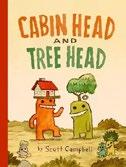
The sweet and strange intersect in these comics about two pals with a lot on their minds. The premise is simple: In this world, everyone sports something on their head. Our protagonists are best friends Cabin Head and Tree Head (vaguely humanoid creatures with little people inhabiting the worlds atop their noggins). Six main stories (with three bonus tales) take this concept and run higgledypiggledy with it. Readers are treated to tales of terrible “leafcuts” (Garden Head attempts to give Tree Head a new ’do, with hilarious results), treasure hunts with selfmade maps, and even a wildly outofthisworld adventure that reveals that the Earth itself is on someone’s head. Kids will revel in locating and naming all the different “heads” in Campbell’s beautiful watercolorrendered scenes, even as they chuckle over his delightfully absurd dialogue (“I feel a case of the HELLOS coming on.” “Uhoh. The HELLOS are nothing to be trifled with”). The primary lures are the humor, the nutty concept, and the detailed depictions of a cheerfully surreal world where everything from clouds to mountain is gently anthropomorphized, but the heartfelt friendship between the two heroes is what will have children and parents coming back again and again.
A wildly original tale with the buddybased charm of Frog and Toad but imbued with a wacky energy all its own. (Graphic fiction. 6-10)

An ode to books and the heroes who make them available to those in need.
BOOKS ON BIKES
Campoy, F. Isabel & Theresa Howell
Illus. by Brizida Magro | Clarion/ HarperCollins (40 pp.) | $19.99 September 2, 2025 | 9780063285125

A voracious young reader meets a bike rider giving away books—and becomes inspired by his good work. Lía reads all day, every day: “sitting down, upside down, and before bed almost every single night.” Though summer offers ample time to read, sadly, Lía’s access to books is limited; school is closed, and she lives far from the library. But at a nearby park, she meets Gabriel, a cyclist who rides around making books available to the public. With Gabriel busy visiting other parks, Lía decides to outfit her own bike with baskets filled with books. She recruits other kids, and before long, their idea has spread—across the neighborhood and then to cities all over the world. A plucky hero in the mold of climate activists Xiye Bastida and Greta Thunberg—both referenced in the text—Lía works hard to create the change she wishes to see in the world. Campoy and Howell’s childfriendly testament to the power of collective action concludes with backmatter explaining the reallife inspiration for the tale. Magro’s eclectic art conjures up a setting certain to enchant bibliophiles; various elements, from the roofs of houses to a red tent in which Lía holes up reading, resemble oversize books, while scribbly linework and the use of collage set a whimsical tone. Lía and Gabriel are brownskinned; Lía’s community is diverse. Publishes simultaneously in Spanish.
An inspiring ode to books and the heroes who make them available to those in need. (Picture book. 4-8)
Carlson, Caroline | Candlewick (480 pp.)
$17.99 | October 7, 2025 | 9781536230505
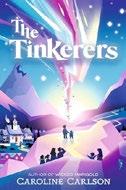
In a seemingly idyllic village, a precocious 12 year old finds himself entangled in mysterious magic that might upend the whole Belvederean Empire
The Huckaby Green family leads an exhausting but happily full life as innkeepers in Stargazers Valley, a quaint, isolated village reminiscent of Northern Europe where people use horses and carts and aurora borealis–like lights appear in the sky. Peter, an enthusiastic perfectionist, is helping raise his 3 year old brother, Ollie, vying to win an empirewide essay contest, and desperately trying not to come in last place in clambering, the empire’s central sport. Enter the Tinkerers, two guests at the inn who take Peter under their wing but whose goals and magical gadgets are mystifying. As Peter starts to unravel the history and relationships around him, he confronts opposition from the powerful empire and its clandestine forces. Carlson’s often humorous prose captures the big feelings of a boy on the precipice of adolescence. The book, which is framed as a dossier by the empire’s spy forces, alternately presents excerpts from Peter’s essay, the mythology of his culture, and transcripts of surveillance footage,
effectively building a rich world and underlining the omnipresence of its colonizing force. The central themes include learning from mistakes, eschewing blackandwhite morality, and recognizing the harms of colonization. Main characters read white, and names and physical descriptions cue ethnic diversity in the background cast. A warmhearted fantasy tale about discovering the world’s complexity and finding one’s place in it. (Fantasy. 8-13)
Cham, Jorge | Amulet/Abrams (256 pp.)
$15.99 | September 16, 2025 | 9781419764066
Series: Oliver’s Great Big Universe, 3

A boy’s wacky mishaps, boundless enthusiasm, and eager friends (plus many dinosaurs) enliven the third in this STEM centered graphic novel series.
Neighborly retired paleontologist and “cat lady” Dr. Bertha helps 11yearold Oliver, who has paperwhite skin and tousled black hair, learn how a common ancestor gave rise to sabertoothed cats, lions, and today’s domestic cats. When Oliver, saving up for a gaming computer, wants to write a book, his friend Ana suggests that he write about evolution. Guided by Dr. Bertha, he does—from (primordial) soup to incidents that are pure nuts. Once again, the humor (including groanworthy puns, farting, and mentions of poop) is matched to a middle schooler’s DNA, and the droll blackandwhite line drawings reduplicate the fun (and convey information). The language is largely accessible: Words like paleontologist, domesticated , and fossils are defined in the text. A pronunciation cue is integrated for fungi (Dr. Bertha: “It’s pronounced ‘funguy.’” Oliver: “Yes, I am!”) but not for harder vocabulary (e.g., eukaryotes, haikouichthys, and Chicxulub). Cham explains scientists’ various theories for potential sources of life (such as lightning hitting
the primordial soup or asteroids bringing “the right ingredients”). He also describes natural selection and mass extinctions. The book gets down to the microbe level, but there’s no mention of genes (even in the explanation of mutations), and evolution comes across as largely occurring in the past; nevertheless, this is an entertaining overview of the basics. Amusing, enthralling, and informative. (bonus comic, resources, fun facts, index) (Graphic nonfiction. 8-12)
Kirkus Star
Charles, Tami | Illus. by Bryan Collier Orchard/Scholastic (40 pp.) | $18.99 September 16, 2025 | 9781338752052
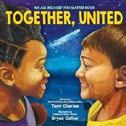
In celebrated creators Charles and Collier’s latest collaboration, affirmations abound and differences transform into points of connection. The newest title in this series—which includes All Because You Matter (2020) and We Are Here (2023)—opens with a diverse group of schoolchildren on a field trip to the planetarium. As they marvel at the celestial bodies above them, Charles weaves spellbinding verse about the Big Bang: “A mighty, mighty force… bringing us / feet bound to the ground… together… // You and me— / born of stars, / stories, / and dreams / big enough / to shake up / and WAKE UP / the whole universe!” Shifting between secondperson, firstperson singular, and firstperson plural points of view, her propulsive words assure readers of the power of their voices, their capacity for stirring up “good trouble,” and their myriad talents—and emphasize that while we individually possess great abilities, we are all better together. Mesmerizing as always, Collier’s signature collage illustrations underscore that muchneeded message, depicting the exuberant kids romping amid sumptuous planetary backdrops and
gazing down at a map of the Earth. As in the other titles in this empowering series, overlapping leaves featuring colorful patterns or slivers of people’s faces appear throughout, creating an eyecatching visual motif.
A lushly illustrated, uplifting work that beckons us to unite around our common humanity. (author’s and illustrator’s notes, glossary) (Picture book. 4-8)
Clendenan, Megan | Illus. by Brittany Cicchese | Charlesbridge (32 pp.)
$17.99 | October 14, 2025 | 9781623544805

In Svalbard, Norway, lies buried treasure. Worries about climate change, war, and extinction led to the construction of the Svalbard Global Seed Vault. Here, on an Arctic island, in “the belly of a mountain,” duplicates from seed banks around the world are stored, preserved for the future, should the need for them arise. Clendenan carefully outlines the purpose and creation of this protected collection. Her relatively simple text is accompanied by sidebars offering more detail on the challenges of transporting seeds, the difficulty of constructing the vault (workers had to be vigilant for roaming polar bears), and more. Cicchese’s appealing illustrations signal the Arctic cold with shades of blue; a diverse workforce is bundled up against the frigid temperatures. In scenes depicting warmer climates, reds, greens, and browns abound as an equally diverse set of humans collect seeds, plant them, and enjoy the crops. Clendenan stresses that this is a truly international project: “Inside the vault, a walk down the aisles becomes a walk through the world.” Younger readers may not entirely understand the need for the collection but will surely be engaged by the process; construction enthusiasts will
especially appreciate the spreads focusing on the machines from around the world brought to this isolated place to bore into the mountain. Even the seed packets are designed to be nearly indestructible. A fascinating tale of conservation at its most creative. (more about seeds and seed banks, author’s note, resources for kids, selected bibliography) (Informational picture book. 6-9)
Cooper, Morgan Stevenson | Illus. by Geneva Bowers | Kokila (32 pp.) | $18.99 November 11, 2025 | 9780593858301

Norah Rose is determined to make movie magic from scratch, but where to start?
Norah Rose’s grandfather isn’t feeling well, and she’s disappointed that their beloved movie nights have been put on hold. That’s when she has the brilliant idea to make a film of her own to share with Grandpa. She begins by writing the script, a gripping story about treasure hunters set right in her hometown of Kansas City. Casting her cousins in the lead roles and relying on a $25 costume budget from Mom, Norah Rose steps behind the lens of a smartphone, and then…lights, camera, action! With determination, creativity, and a lot of quick thinking (how can she shoot her final scene amid a surprise rainstorm?!), Norah Rose eventually makes a movie she’s proud of. She invites the whole neighborhood for a special screening, with Grandpa as the guest of honor. Colorful digital illustrations move the story along, showing familiar Kansas City landmarks and featuring an enthusiastic Norah Rose hard at work. Norah Rose and her family and community are Black. Some longer passages of text slow the story, but practical tips and tricks featured in the backmatter will be of interest to aspiring movie makers. From script to spotlight, a playful glimpse into the world of moviemaking. (author’s note) (Picture book. 5-8)
Costello, David Hyde | Farrar, Straus and Giroux (32 pp.) | $14.99 | October 14, 2025
9780374391348 | Series: I Can Help
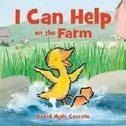
Friendly creatures lend a hand (or a paw, a hoof, or a wing).
Mimicking the pattern set up in previous works—I Can Help (2010) and I Can Help in the Neighborhood (2024)—Costello follows a string of farm animals as they help each other out of various sticky situations. A duckling patters curiously after a butterfly and gets lost. A dog bounds in to offer aid: “I can help.” The pooch flattens out the tall grass, clearing a path and allowing the duckling to reunite with family. Modeling appropriate manners, the duckling happily quacks, “Thank you, dog!” But now the dog is itchy. A sharpnailed chicken scratches the dog’s back (“I can help”). The dog appreciatively barks, “Thank you, chicken!” Short, repetitive phrases, along with simple acts of kindness depicted in the artwork, make it clear to readers that they, too, can always be of assistance. Chicken coops, hay bales, and rolling meadows dot the farm setting, with each animal thickly lined in black in the foreground to highlight the predicament they have found themselves in. Coming full circle in the end, the little duckling returns the favor when another animal requires help. Cooperation and community at its finest. (Picture book. 2-5)
crave…the perfect lap.” Nevertheless, Lap Cat (who uses they/them pronouns) persists, chanting the word lap over and over. When the journey brings them to a local park, they try out a bucket belonging to a squirrel—“NOT a lap”—and, oops, they break it. Next, they visit a diner, where they make a sticky mess out of pancakes: “NOT a lap.” A sand castle at the beach? Nope. A whoopee cushion? No. Each new “lap” brings only chaos, and soon, Lap Cat’s reputation precedes them. When, at last, Lap Cat finds a “lap store,” the shop’s owner starts to kick them out. A new quest is born: If they make amends to the animals they’ve slighted, will they finally get a lap to call their own? Cull’s latest combines childlike cartoon humor with a medieval style and tone, resulting in comedic gold. Lap Cat’s bardlike dialogue, presented in speech bubbles and set in a Gothic typeface, contrasts hilariously with their mundane world. Careful readers will pick up on many details in the colorful illustrations, though they can be easy to miss, given the breezy pace. In a brilliant metafictional moment, an advance copy of the book appears in the joke store Lap Cat enters.
A rousing, rib-tickling tale. (Picture book. 4-8)
DiCamillo, Kate | Illus. by Sophie Blackall | Candlewick (160 pp.)
$17.99 | September 30, 2025 9781536225525 | Series: Norendy Tales
old widow, setting off a series of adventures. Through it all, searching father and lost daughter meet a host of strange characters—an immensely selfpossessed marmalade cat, a nasty sideshow proprietor—as they attempt to find one another. Will they? In true DiCamillo fashion, the ending is suffused with the gentlest melancholy, allowing readers to either believe in their reunion or dismiss it entirely. Illustrator Blackall once more joins forces with DiCamillo to bring the more fairy tale–like elements of the book to gentle life, softening some of their harsher aspects. There are no easy answers in a Norendy tale, but there is great courage, even when it comes in the smallest of packages. The characters are paleskinned.
A tender tale featuring a young protagonist who possesses equal parts yearning and spunk, to great effect. (Fantasy. 7-10)
Easton, Grace | Thames & Hudson (32 pp.) $19.95 | September 30, 2025 | 9780500653494
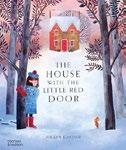
Cull, Joren | Penguin Workshop (48 pp.)
$19.99 | October 28, 2025 | 9780593659267
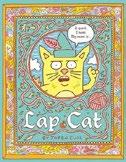
A feline’s quest for a lap reaches epic— and disastrous— proportions. Even on day 222 of searching, our hero still hasn’t found “the warm, soft comforting sensation many cats

Like a Thumbelina with agency, a tiny girl winds her way through a great, strange world.
DiCamillo’s latest Norendy Tale opens on a poor cobbler who’s always dreamed of going to sea. One day, he discovers a minuscule baby in the toe of a boot and raises the girl, whom he names Evangeline, as his own. The two dream of setting sail someday, but before that can happen, the child is stolen away and sold to a rich
Amid a winter storm, a young girl and a rodent find friendship. Olivia resides in a house with a little red door, while Mouse lives in a big oak tree at the bottom of the yard. Both have cozy homes but long for something more. When it begins to snow one day, they venture outside and meet. Olivia shows Mouse all the fun things they can do in the snow, from sledding to making snow angels. But the snow doesn’t stop, and the heavy winds soon knock over the oak tree, destroying Mouse’s home. Olivia helps him set up a new house out of a flowerpot, but it still doesn’t feel quite right. Mouse heads for the little red door; he finds a welcoming friend waiting and, what’s more, a true home. This lifttheflap story includes plenty of beautiful details: the various rooms in Mouse’s treehouse, the insides of wouldbe new homes for Mouse, and
even the reveal of Mouse’s silhouette at the door in the snowy night. Paleskinned, brownhaired Olivia makes a sweet friend for the adorable, big eared, beady eyed rodent. The illustrations evoke a strong sense of place and season, thanks to the carefully chosen details and wellcaptured outdoor elements. Readers will love poring over these richly depicted scenes and slipping into Olivia and Mouse’s inviting world. A touching tale with a relatable message: Home is where our loved ones are. (Picture book. 3-6)
Fernández Vázquez, Eugenio | Illus. by Mariana Villanueva Segovia | Trans. by Kit Maude | Tapioca Stories (48 pp.) | $19.95 September 9, 2025 | 9798988749943
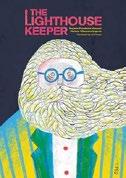
No need to fear—the lighthouse keeper is here!
Alone amid a sea of restless waves and pitchblack nights, a lone lighthouse keeper rescues those in need. Snazzily dressed in round blue spectacles and a yellow and green striped suit with wide lapels, the keeper “embraces everyone he finds lost and alone, // and they leave feeling better / eager to get back home.” His most loving and complicated relationship is with the moon, the very entity controlling the vast waters he safeguards. He works on building their bond through waters calm and stormy, and eventually they form a genuine connection. This is a stunning look at the power of compassion and resilience, as well as the need to respect nature. Maude’s fantastic translation of Mexican author Fernández Vázquez’s original Spanish text is playful, with a rhyme scheme that scans well. Villanueva Segovia’s textured illustrations are beautifully scaled, capturing the awe of the quiet yet sometimes violent activity of the oceans—showcased in harrowing
Sympathy for the poisonous—an empathetic glimpse of a much-maligned beauty.
DON’T
spreads of sailors caught in a shipwreck and waves crashing against rocks in bright pastel tones set against a deep rich black backdrop—while still maintaining a sense of whimsy throughout (the lighthouse keeper’s beard is composed of hundreds of small fish that lovingly wrap themselves around the people he saves). The keeper is paleskinned; those caught up in the waves are a ghostly white.
A remarkable look at the importance of selfless acts. (Picture book. 5-8)
Finney, Kate | Illus. by Esmé Shapiro Enchanted Lion Books (56 pp.) | $19.99 October 14, 2025 | 9781592704347

Adaptation and survival take a front seat in this intriguing tale of a forwardthinking flower. This intriguing bit of informational fiction follows the personal journey of a plant from delicious to deadly. Belladonna might be beautiful, but to the animals of the forest, she’s a 24 hour snack bar. Gnawed on by any number of hungry critters, she seeks guidance from Raspberry (who deters unwelcome visitors with thorns but allows little birds and mice to feast—and thus scatter raspberry seeds), Oak (who explains that the animals who gather acorns allow more oak trees to thrive), and Fungus (whose relatives use poison to ward off voracious animals). Determined to protect herself, Belladonna vows to change. Slowly, over “thousands of years,” she makes her insides
poisonous. All is well and good, except that upon completion, she acquires a new fear: What if no one will eat her berries and spread her seeds now?
Fortunately, just as Belladonna has changed, the local pheasant population has adapted right alongside her. As the author’s note is quick to point out,
“Every single species on Earth, from plants to people, has developed its own adaptive strategy.” The story will leave readers with an understanding of why some plants can’t be eaten—at least not by most creatures. Accompanied by lush art that imbues the various flora with expressive faces, the book also gets a great deal of comic mileage out of the different animals munching on Belladonna with gleeful abandon. Sympathy for the poisonous—an empathetic glimpse of a muchmaligned beauty. (Picture book. 3-7)
Florence, Melanie | Illus. by Matt James Tundra Books (40 pp.) | $18.99 October 21, 2025 | 9781774882665
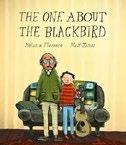
A boy’s relationship with his grandfather’s guitar—and his grandfather— changes over time.
“For as long as he could remember, Jack had lived in a house that was alive with music.”
The music comes from Jack’s grandfather’s facility with various instruments and from the man’s vast record collection. When Jack expresses an interest in learning to play the song “about the blackbird” on guitar, his grandfather starts by teaching him the basics. Jack eventually masters the instrument. As time goes by, he grows bigger, and the
guitar seems to shrink. Eventually, Jack becomes a successful musician, “playing for crowds of people all over the world.”
One day, when the adult Jack returns home with his guitar for a visit, he finds that his grandfather’s memory is slipping; now it’s Jack’s turn to be the guitar teacher. Matureenough elementary schoolers should be touched by this understated heart tugger, but readers of any age will appreciate James’ mixedmedia art, centered on a couple of longlimbed, tanskinned guys who share, along with a love of music, unkempt hairstyles across the decades. Although Florence largely keeps her twoperson cast at home (that Jack doesn’t seem to have parents goes unremarked upon), readers won’t tire of looking at them; James sets them against a range of inviting backdrops, including a porch with a scenic view and a living room with shelves of records whose jackets seem to glow. A hymn to intergenerational ties. (Picture book. 5-9)
Frankel, Erin | Illus. by Jasu Hu | Calkins Creek/ Astra Books for Young Readers (48 pp.)
$18.99 | October 14, 2025 | 9781662680823
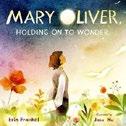
A young Mary Oliver (19352019) is entranced by the natural world and the many questions it evokes.
How would it feel to fly? Do flowers ever get sad? Might rocks be living things? These questions and many more awaken a sense of wonder in Mary, prompting her to write in her notebook wherever she finds herself (even if that
means stowing pencils behind trees on her regular route through the woods). Mary finds joy and solace in poetry, both in writing her own verse and reading that of others. When Mary meets photographer Molly Malone Cook as a young adult, she’s thrilled to gain a life partner who asks the same questions of the world as she does. Mary becomes well known, even winning a Pulitzer in 1984, but she continues to lead the quiet existence she loves. Frankel’s gently flowing, lyrical prose mimics some of Oliver’s work in its pacing and rhythm. More discussion of Mary’s sexuality or feminism might have rounded out the story, though the writer’s personality comes through strongly. Hu’s digital illustrations have an ethereal watercolor feel, highlighting the natural world in muted hues. Lets young readers tiptoe through the wild, wonderful life of a celebrated poet. (author’s note, timeline, a note on the craft of poetry, bibliography) (Picture-book biography. 6-9)
Gardyn Levington, Rebecca | Illus. by Dinara Mirtalipova | Barefoot Books (32 pp.) | $17.99 September 9, 2025 | 9798888596623

A child discovers that there are multiple ways to act, feel, and be. In defiance of static definitions, the book’s young narrator explores a wide range of emotions through a series of natural metaphors: “Some days I’m the wind, / a cyclone, a whirl, / dizzy, giddy, wild. // Some days I’m the wind, / a whisper, a breeze, / gentle, mellow, mild.”
Sometimes the child feels like a tree or
A moving conversation starter on what it means to be an ally—and a friend.
MORE CHAIRS
the rain—experiences that are similarly varied; all are enthusiastically celebrated. Parallelism and satisfying rhyme lend Gardyn Levington’s rich verse a gentle rhythm, echoed in the playful placement of the text on each page. Mirtalipova’s bright gouache illustrations connect the child’s inner world with reality and reflect the youngster’s vivid imagination. On one spread, a laundry basket transforms into a ship on calm waters as the protagonist quietly looks out to an island made up of piles of laundry. On another, a rug becomes an undulating river, with the child raucously sliding down it. The text resolves with a final loving affirmation to readers: “And just like the wind, / or the sun, / or the sea / on some days / I’m some ways, / but all days // I’m me.” The child is brownskinned with long dark hair. Backmatter includes information on emotions, with discussion questions and activities written by a child development specialist. A lushly illustrated, imaginative ode to a child’s rich emotional landscape. (author’s and illustrator’s notes) (Picture book. 5-8)
Kirkus Star
Gill, Dan | Illus. by Susan Gal Little, Brown (40 pp.) | $18.99 July 1, 2025 | 9780316552691
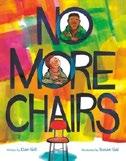
On the first day of school, Mr. Gill’s students ask about the empty chair in his classroom. In response, Mr. Gill, a white man, tells a story from his childhood in New York City. Mr. Gill (referred to here as Daniel) and his friend Archie, who is Black, are excited to attend their friend Steve’s birthday party. Dressed in suits and ties, they arrive at Steve’s fancy apartment building, ride the elevator up to the seventh floor, and ring the doorbell. Steve’s mother invites Daniel in but tells Archie that he must leave; there are no
more chairs. When it becomes clear that Archie isn’t welcome because of his race, Daniel refuses to enter: “We’re going back to my house, where there are always enough chairs.” The chair in Mr. Gill’s classroom serves as a reminder that there’s room for everyone here. The author—who shares a name with the protagonist—based his tale on an event from his own childhood. Acknowledging that there are times when it isn’t safe for those from marginalized backgrounds to speak up, this potent story reminds those with privilege that they can—indeed, must—take a stand. For powerful discussions, pair this heartfelt friendship story with narratives of brave Black characters. Gal’s scribbly mixedmedia illustrations are a visual feast, using richly saturated colors to emphasize emotion.
An affecting and moving conversation starter on what it means to be an ally—and a friend. (author’s note) (Picture book. 3-7)
Nine Moons of Han Yu and Luli
Glaser, Karina Yan | Allida/ HarperCollins (432 pp.) | $19.99 September 16, 2025 | 9780063284432

A boy in China in 731 C.E. and a girl in New York in 1931 face separate hardships and adventures but are connected by common threads.
Elevenyearold Han Yu lives a simple life in Chang’An. He’s seen as unusual because of the various animals that are drawn to him—even a tiger, which has earned him the nickname “Tiger Boy.” But Han Yu enjoys ordinary activities, like making steamed buns to sell with his father at the busy market. Elevenyearold Luli Lee has a modest and happy Depressionera existence in New York City’s Chinatown. She’s been helping her immigrant parents run their restaurant in the building they’re saving up to buy. But disaster strikes both
children’s lives: Members of Han Yu’s family contract a mysterious, deadly respiratory illness, and Luli’s family business and home are at risk of foreclosure. Both young people summon their courage, creativity, and determination as they go on adventures to help their families. As two exciting parallel stories of family, friendship, and community unfold, they bravely confront a variety of challenges, supported by loyal animal companions. While their storylines are distinct, they’re connected through cultural elements that reverberate through their historical eras. The alternating thirdperson chapters following Han Yu’s and Luli’s story arcs are strongly paced and highly suspenseful. Detailed descriptions make this a vibrant love letter to Chinese culture, food, history, poetry, and art. Final art not seen.
Thrilling, heartwarming adventures highlight commonalities that span centuries. (maps, author’s note, bibliography) (Historical fiction. 8-12)
Goldberg, Alison | Illus. by Selina Alko Barefoot Books (32 pp.) | $17.99 August 12, 2025 | 9798888596487

On the anniversary of Grandpa’s death, a Jewish family observes the tradition of yahrzeit by lighting a candle to honor his memory.
The candle burns over the next 24 hours while everyone shares stories about Grandpa, creating new memories as each reminiscence connects to an activity he used to enjoy. As the family members use a telescope to gaze at the night sky, the nameless young protagonist recalls Grandpa explaining how to find the constellation Orion; sitting down at the piano is a reminder of how Mom used to play with Grandpa. The candle remains a constant throughout, burning a little more with each page turn and allowing readers to feel as though they’re part of the story. By book’s end, the candle’s extinguished, but the family keeps
Grandpa’s memory bright. Goldberg’s poignant and beautifully crafted tale tackles the weighty issue of losing a loved one in a thoughtful and accessible ageappropriate way. Alko blends vibrant paintings and creative collage illustrations. A motif of white dots, hearts, and stars sprinkled throughout the book suggests the stars that Grandpa loves and invokes feelings of love for him. Some readers may wonder about the omission of the Kaddish, the Jewish prayer that is said over the dead. Still, few picture books explore yahrzeits, making this tale an especially welcome addition on the topic. The family members vary in skin tone. A meaningful and sensitive celebration of life. (author’s and illustrator’s notes, information on yahrzeit and Jewish mourning traditions, explanation of the Jewish calendar, sources) (Picture book. 4-8)
Gonsar, Brian | Illus. by Keenan Gaybba Oni Press (224 pp.) | $14.99 paper August 12, 2025 | 9781637158401

If there’s one thing that can bridge the human/undead divide, it’s donuts. Upon returning from a successful “worldwide jelly donut tour,” Count Dracula, vampire and worldclass baker, is outraged to learn that his humaninclusive brunch club has been overtaken by the towering, glowering vampire Constantine, who’s banned people. Worse, Dracula’s entire store of “the crimsonred, blood orange jelly all vampires crave” has been raided. Local farmers have no blood oranges—a blight has destroyed the crops. This proves disastrous even as Dracula tries to regain his brunchhosting ground—kale is no substitute for delicious, energizing fruit jelly. The shortage also jeopardizes his standing with his crush, the human Elena, since he’s promised to donate a year’s supply of jelly donuts to her charity auction to help sick children.
How two award-winning illustrators collaborate on a picture book.
BY BETSY BIRD





| July 22, 2025 | 9780823456475
WHEN A CALDECOTT MEDALIST asks a Governor General’s Award winner to illustrate a book, you can bet that there’s a good reason. Brian Floca, who works out of a Brooklyn studio shared with other great children’s book creators, is perhaps best known for his awardwinning picture books Moonshot (2009) and Locomotive (2013). After completing an illustration fellowship on Peaks Island in Portland, Maine, he was inspired to write a story of wind, weather, and siblings facing down the elements. But with other projects vying for his attention, he didn’t know when he’d be able to get to the book: “I just saw this thing dying a slow death on my hard drive, as many things do,” he says.
But when Sydney Smith, the awardwinning Canadian creator of such books as I Talk Like a River (2020) and My Baba’s Garden (2023), visited Brian’s studio in June 2022, Brian saw an opening, and asked Sydney to illustrate the story. As Sydney puts it, “I’d never collaborated with someone who was already a visual thinker, so that was really interesting. I don’t know how Brian feels about it, but if I had something that I was working on, I would definitely want to see how others would approach it, because the results are always different than you would expect.”
The result is Island Storm, in which two small children venture out into the world before being chased by inclement
weather back home to the arms of their mother. In a starred review, Kirkus calls the book a “phenomenal tale of pushing limits,” for which Floca and Smith drew on memories both personal and literary. We spoke with them about their unusual collaboration over Zoom; our conversation has been edited for length and clarity.
When you two work on a book together, you’re doing so as co-creators. Are you kept separate, as many authors and illustrators who make picture books are, or is it a collaborative process?
BRIAN FLOCA: We had a couple of conversations
about things that might have impacted the story line and the characters’ motives, but beyond that it was Sydney. Sydney had it.
SYDNEY SMITH: There were definitely certain things that I was exploring visually, like, was there space to bring in another aspect of the story, some sort of subtext or plot, or something that deals with the human experience in a different way? But we found that it was not necessary to go too deep. So much of it was there in the text already. Just following these two characters was enough to see the connection and
bond that they have. They’re siblings, but there’s also this friendship and care that they have for each other.
FLOCA: Sydney brought to the book so much of the warmth of the relationship. And then the way the mother character comes into the book at the very end is all Sydney. It’s such a lovely way to end the book. When you’re both the author and the illustrator, there’s a tendency to tie everything up and make it an airtight thing. But that’s the beautiful thing about this collaboration. There’s enough space between the text and images that you have the possibility of different readings.
Brian, what did you think when you saw the finals here? What were your impressions?
FLOCA: The first thing I saw was the cover image. I literally was laughing and shedding tears of joy. It’s so strange and powerful to have written something and hand it off to someone, and then it comes back to you as this totally different, much richer, thing. Sydney did beautiful work. He filled it out and brought it to life.
SMITH: It was really important that I was able to tell my kids that they’re in the book. There’s an older and a younger sibling, and I wanted to base the way that they looked on my two kids. They modeled for me a little bit at the very beginning. I wanted them to see themselves in this book.
FLOCA: That was a conver sation, right? Because the manuscript
doesn’t necessarily make clear who is taking this walk and going out in the storm.
SMITH: That was an interesting thought exercise. How would it change if it was a parent and a child, or a child and a pet? But I thought of my experience growing up. I have an older brother who would take me hiking through the woods. He was eight years older than me, but it meant that he
was allowed to go on his own, and he could just drag his younger brother with him. We would get lost and get stuck, and there were moments where I’d be worried, but he would always bring us back. And I wanted to put that theme of sibling dependence into the visuals.
Brian, when they do go back, the mom is there, and you have this moment:
It’s so strange and powerful to have written something and hand it off to someone, and then it comes back to you as this totally different, much richer, thing.
“Home to towels, dry clothes and dinner, home to warm beds and blankets.” Were you consciously making a reference to Where the Wild Things Are?
FLOCA: Yeah—you’ve gotten in trouble, but there’s that moment of forgiveness. When Max comes back, he comes back to the dinner, but he doesn’t come back to the mother. The mother’s not there, and that’s a significant difference. There is something a little stark about that last scene of Wild Things . Just the soup and no parent.
SMITH: There’s that spread in the book where the mother is holding the kids, but then opposite that, the mother is kind of wildly running toward them with a flashlight in her hand. I, as a parent who reads picture books, think that it’s really important to include this. It’s perilous for the children, but it also represents how scary it is for the parent, and for parents to recognize that and see themselves represented as well.
FLOCA: I will say the kids were in a little bit more trouble until that painting of Sydney’s with the embrace. I went back into the text and shifted and cut a couple of things, because it’s such a powerful moment, and I didn’t want the text to undercut that. They were in a little more hot water origin ally. Sydney bought them an extra dose of forgiveness.
Betsy Bird is a librarian and writer in Evanston, Illinois.
The iconic activist is collaborating with Leymah Gbowee on a children’s picture book.
Gloria Steinem and Leymah Gbowee, winner of the Nobel Peace Prize, are collaborating on a new children’s picture book.

Scholastic will publish Rise, Girl, Rise: Our SisterFriend Journey. Together for All, illustrated by Kah Yangni, next year, the press announced in a news release.
Steinem, the feminist activist and co-founder of Ms. magazine, is the author of several previous books, including Outrageous Acts and Everyday Rebellions, Revolution From Within, and My Life on the Road. Gbowee, the Liberian peace activist, co-wrote the book Mighty Be Our Powers: How Sisterhood,

Prayer, and Sex Changed a Nation at War with Carol Mithers. In 2011, she was awarded the Nobel Peace Prize jointly with Ellen Johnson Sirleaf and Tawakkol Karman for their work to promote women’s rights and safety.
“This beautiful and empowering story was inspired by Gloria and Leymah’s friendship, letting us in on their ‘kitchen table talks’ about the principles of equality, progress and hope for a new generation,”

Scholastic says. “This picture book will help young people feel motivated and inspired by their own agency and power to change the world.”
Rise, Girl, Rise is scheduled for publication on February 3, 2026.
—M.S.


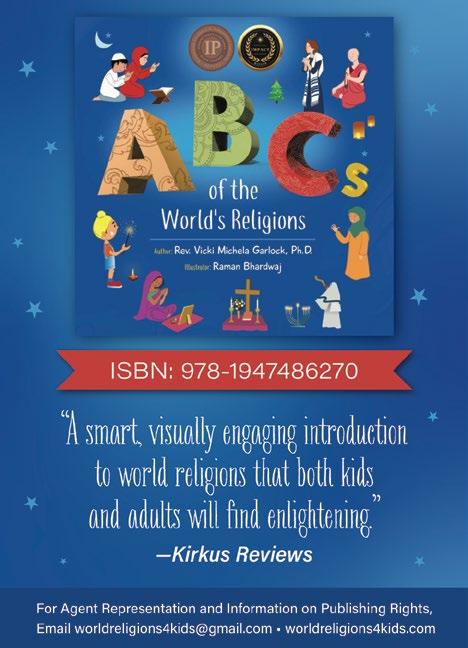

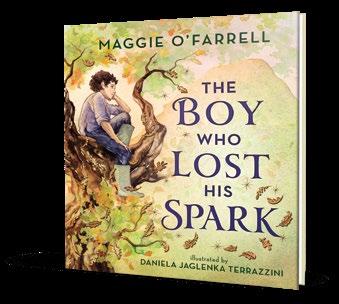

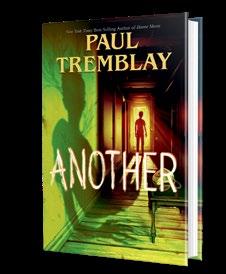


Something must be done—and it might just involve blood. After all, Count Dracula is a vampire. This book will greatly appeal to young readers looking for comics with a little edge: The gore is mild and cartoonsilly, and there are plenty of jokes to lighten the mood. The story moves at a measured pace, and the fun, kidfriendly artwork adds depth to the narrative. Gaybba’s color palette predominantly contains cool, moody tones that make the occasional spots of red—mostly jelly and blood—pop. Human and vampire characters have skin in varying shades of blue and purple. A friendly, funny vampire story with a little bit of bite. (recipes, evolution of a page, alternate covers, character development) (Graphic paranormal. 9-13)
Kirkus Star
Mr. Lemoncello’s Library Olympics: The Graphic Novel Grabenstein, Chris | Illus. by Douglas Holgate Colors by Marta Todeschini | Random House Graphic (256 pp.) | $13.99 paper October 14, 2025 | 9780593709818
Series: Mr. Lemoncello’s Library, 2

A second round of bookish riddles and rebuses leads to a stout battle against the forces of intellectual repression in this graphic remake of the popular series’ second entry. With teams of avid young readers from around the country descending on eccentric Mr. Lemoncello’s fabulous library to compete for a glittering first prize—a full ride to college—it looks like Kyle Keeley and his three compatriots have their work cut out for them.
They must also contend with chicanery from slimy Charles W. Chiltington, his even more reprehensible mother, and a squirrelly new bookburning nemesis. Are they up to the challenge? “On your mark. Get set. Lemoncello—GO!” Holgate’s fluidly drawn assemblages of actively engaged contestants, expertly colored by Todeschini, capture the 2016 novel’s narrative vim while highlighting the young cast’s racial diversity. Though some of the 12 games (like a book cart relay race) are tests of physical agility, most of them lean on mental acuity as well as a working knowledge of the Dewey Decimal System, basic research skills, and wide reading knowledge. The abundant book references have been updated to include worthy titles published since the original’s appearance. A love for libraries and those who value them shines here more brightly than ever, from the very first poser—a rebus with a message that bookworms will delight in—onward. The dynamic graphic format will draw new fans to this timeless manifesto for library lovers. (Graphic fiction. 9-13)
Gundersheimer, Ben | Illus. by Marcos Almada Rivero | Nancy Paulsen Books (32 pp.) | $18.99 September 30, 2025 | 9780593624845

Gundersheimer— an awardwinning children’s musician who performs under the name Mister G— follows a young gray whale on her first migration. Though Juana was—literally—born yesterday, in the warm waters of a Mexican lagoon, she’s ready to meet the world. As she and her pod head
A satisfying account of a marine mammal’s first forays into the world.
BABY BALLENA
north toward Alaska, where they’ll spend their summer, she observes rocky mountains, landmarks such as the Golden Gate Bridge, and animals including bears, walruses, dolphins, and seals. Dangers lurk, too, from orcas to big ships. Guided by her everwatchful mother, Juana grows bigger and stronger; arriving in Alaska, the whales are ravenous (“I can eat a thousand shrimp. Good thing I have a big mouth!”). She knows it’s time to head south again when the water in their summer home turns icy. When the whales arrive in Mexico once more, Juana meets her new baby cousin, José, and the cycle starts anew. Bathed in a calming glow, Almada Rivero’s inviting illustrations depict Juana as a wideeyed, curious youngster with a winsome smile, surrounded by equally cheerylooking animals. Soothing, upbeat text presented in both English and Spanish makes for a comforting read. A few basic facts, mostly related to whale size and diet, are gently woven in (“I drink fifty gallons of milk a day”), though Gundersheimer doesn’t delve too deeply into the topic; additional information is included in the author’s note.
A satisfying account of an endearing young marine mammal’s first forays into the world. (Picture book. 3-8)
Handy, Bruce | Illus. by Julie Kwon Chronicle Books (44 pp.) | $17.99 October 14, 2025 | 9781797215044

Featuring just a single word throughout, Handy’s latest picture book centers on a small boy with big feelings about his new balloon. A Black adult and a toddler— presumably parent and son—are strolling through an unmistakable Central Park; he’s delighted by the orange balloon (“Balloon!”) that he’s just gotten from a park vendor. During an altercation with a pigeon,
the boy involuntarily lets go of the balloon’s string and watches his treasured memento float away (“Balloon…”). As he and his parent continue their walk, the boy keeps mistakenly spotting his beloved possession (“Balloon?”): in an assembled crowd (the orange object is really a musician’s beanie), peeking out from behind some park denizens’ blanket (it’s actually an orange Frisbee), and so on. The last time the boy thinks he spies his balloon, it turns out to be the curved back of an orange kitten at a pet adoption event. He accepts the kitty as a salve for his balloonpining heart—his persistence has paid off!—but his loyalty compels him to honor his lost keepsake: “Balloon. That’s your name,” he tells the cat. Handy has nimbly blended a sweet story tailormade for the tenderhearted with a Where’s Waldo?–esque activity suited to more fidgety types. Working with digitally tweaked pen and ink in blooming springtime colors, Kwon inserts the book’s visual game into invitingly bustling scenes that give the big city the feel of a communal gathering. Handy’s few words speak volumes. (author’s note) (Picture book. 3-5)
Harper, Janelle | Illus. by Charlot Kristensen | Viking (32 pp.) | $18.99 September 23, 2025 | 9780593526330
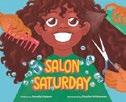
A Black girl chooses a hairstyle. The unnamed young narrator’s grandmother, mother, and big sister go to the salon every Saturday, and today the protagonist is joining them for the first time. As they head down the street and board the bus, she worries about selecting the right style. The people on the street have their own unique ’dos, as do the women in her family; they each have advice on how to decide (“Think about ease,” advises Momma, while Sissy says, “Think about
personality”). “What is my kind of beautiful?” wonders the protagonist. After a tingly shampoo and a spell under the hair dryer, she’s inspired by her loved ones and makes her decision before happily joining “the parade of styles marching down the street.” While the story structure feels a bit formulaic, the relationships are warmly and thoughtfully portrayed; this is a joyful depiction of a milestone in a child’s life. Reminiscent of animation, Kristensen’s illustrations use abstract settings and spot art to showcase different hairdos. The combination of bright colors and pastels gives the setting an eclectic appearance.
An upbeat introduction to a beloved rite of passage. (Picture book. 4-8)
Hays, Anna | Illus. by Mary Kate McDevitt Bright Matter Books (240 pp.) | $18.99 September 9, 2025 | 9780593712559

This finely researched volume introduces readers to seven trailblazing American women from the Golden Age of Magic (1860 1930) who have since faded into obscurity.
At a time when they had few professional options beyond teaching, domestic service, or nursing, these women bucked convention. Many had similar trajectories—coming from modest beginnings, they entered the theater before enjoying successful second innings as illusionists and conjurers. Anna Eva Fay began as a medium, moving from private parlor sittings to the stage. Dancer Adelaide Herrmann brought dazzle to the magic shows she performed with her husband. Dixie Haygood rose to fame as strongwoman Annie Abbott, while Mary Ann Ford was skilled at sleight of hand; she reinvented herself as Talma, Queen of Coins. Beatrice Houdini was
a charismatic performer—and pivotal to her husband Harry’s meteoric success. Margaretha Gertz (Snelling) dubbed herself Minerva, the Queen of Handcuffs, becoming a formidable escape artist who challenged Harry Houdini himself. Ellen Emma Armstrong, the only Black magician featured among the white women, endured segregation in the Jim Crow South but carried on her father’s legacy as a traveling magician and educator, using her platform to educate and uplift Black audiences by showing the science behind her many tricks. Each profile is accompanied by photographs and ephemera. McDevitt’s fullpage color depictions of each subject’s signature tricks are a delightful highlight. Hays does a commendable job of entertainingly chronicling the highs and lows of the magicians’ professional and personal lives. Informative and inspiring. (epilogue, bibliography, photo credits) (Nonfiction. 8-12)
Healy, Kay | Neal Porter/Holiday House (208 pp.) $16.99 | $9.99 paper | September 30, 2025 9780823456512 | 9780823462483 paper
Series: Casey’s Cases
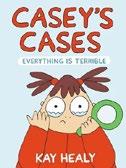
Casey can’t catch a break. Between running for class president, figuring out how to ask AJ to the dance, finding homes for her cat Ms. Muffin’s kittens, and uncovering her parents’ secret, Casey is one busy fifth grade detective! When classmate and bully Dina tries to blackmail Casey with an embarrassing baby photo, she’s distraught. Worse, she learns that Dina got the photo from Casey’s friend Jan. It’s one awful thing after another for Casey, and figuring out why everything is so terrible might just be her toughest case yet. Once again, pigtailed, paleskinned Casey is a delight. Her mini cases are more often
than not solved by someone else or require little to no effort, but her enthusiasm is constant and the story is satisfying, driven by humor and character dynamics. Her crush on AJ and her friendship with Jan ring true; knowledgeable Jan often serves as a gentle voice of reason, while Casey’s gaps in knowledge (like not being entirely sure what a vacuum looks like) make her a refreshingly downto earth hero. Simple art that depicts racially diverse, geometrically shaped characters who always wear the same clothes makes the tale approachable, while their exaggerated expressions add to the hilarity.
This kid detective may be having a dreadful time, but readers will have a ball experiencing it with her. (Graphic mystery. 7-11)
Huh, Jungyoon | Illus. by Myungae Lee Trans. by Aerin Park | Eerdmans (40 pp.)
$18.99 | September 23, 2025 | 9780802856494
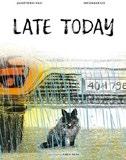
An everyday hero comes to the rescue of a frightened feline. It’s rush hour in Seoul, and bumpertobumper traffic has turned passing lanes into parking lots and drivers into drones. A kitten—tiny, frazzled, and soaked through by lashing rain— wends her way through the gridlock, desperately dodging disaster as passersby look on. The onlookers tacitly make their attitude clear: This situation is cause for concern but not worthy of anyone’s bother—a problem certainly, but someone else’s to solve. Yet when the frantic feline disappears from sight, one commuter resolves to act, shaken from the apathy of diffused responsibility and undeterred by the symphony of honks that resound from neighboring vehicles. A nameless driver screeches to a halt, dashing from a sedan’s dry warmth and nabbing the
imperiled animal just in time for the clouds to break and traffic to dissipate. This small act of heroism—and the inconvenience it entailed—was well worth the delay. Understated and straightforward, Huh’s narrative, translated from Korean by Park, brims with profound truths about the outsize impact of everyday braveries in the face of normalized inaction, while Lee’s illustrations, in doodlelike pastels and colored pencil, complement the message beautifully. Dynamic compositions—closeups, overhead shots, use of panels—convey drama and tension.
A quiet yet masterfully rendered reminder that decency is always worth the hassle. (Picture book. 4-8)
The Fib
Iniguez, Pedro | Illus. by Nathan Kwan Gloo Books (32 pp.) | $19.95 October 7, 2025 | 9781962351300

In an effort to stave off embarrassment during show and tell, a young boy tells a lie that gets out of hand.
As brownskinned, darkhaired Pepe watches his diverse classmates share fascinating hobbies and toys, he’s ashamed of the item he’s brought in, a handdrawn comic book he’s worked on all summer. Instead, he talks up his special pet (in reality, a tiny ball of lint), which he describes as a creature that hails from Mexico, with “horns like a ram, claws like a bear, wings like a bat, eyes like an owl, and a tail like a lion’s.” As one little lie feeds into another, the aptly named Fib grows bigger and more menacing. Pepe’s teacher, Mrs. Apple, explains that there’s only one way to tame a fib: by telling the truth. And just like that, with each truth Pepe utters, the Fib gets smaller until it’s gone entirely. The Fib itself is rightfully the most compelling part of the bold, simple artwork. It starts off looking like a harmless, puffy green creature but grows more intimidating with each page turn. Iniguez and Kwan offer a
meaningful visual demonstration of how lies grow and can get out of hand. Pepe’s very real emotions ring true, from the discomfort he feels about his comic book to his relief at coming clean.
An effective and sympathetic exploration of lies—and the importance of telling the truth. (Picture book. 4-8)
Johnson, Bee | Henry Holt (48 pp.)
$18.99 | October 7, 2025 | 9781250901231
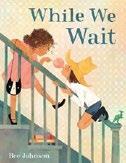
Two kids entertain themselves throughout a day of errands. An image of a short todo list on the refrigerator opens this tale that follows a pair of siblings as they run around town with their parent. Though the list contains just a few items, like buying flowers and a dress, the kids nevertheless seek creative ways to keep from becoming bored: befriending another child at the post office, playing dressup (and making a mess) at the thrift store, and counting the spots on a puppy while their parent chats with an acquaintance. Occasionally, impatience—or hungry bellies—leads to less productive ways to pass the time, but there are always puddles to splash in after waiting out a quick rainstorm, a warm and welcoming home to come back to, and books to read while dinner is prepared. Bright but mellow illustrations create a calm, engaging domestic environment, with just enough clutter to feel lived in. Simple rhymes keep the story flowing from place to place until the day is done as the kids model both realistic and more idealized, wholesome ways of occupying their time while out and about. Parent and children are brownskinned; their community is diverse.
A cozy tale of youngsters discovering ways to have fun while also learning the importance of patience. (Picture book. 3-6)
SEABIRD
Joyce, William | Caitlyn Dlouhy/ Atheneum (48 pp.) | $19.99 October 21, 2025 | 9781665959902
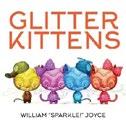
Faced with a terrifying enemy, a group of perky felines and their pals discover what it really means to shine brightly. The four Glitter Kittens wake every morning believing that the world is drab and sad without their sparkling presence. They skip off to brighten the days of their Best Best Friends—a decidedly unsparkly bunch that includes a cracked bottle, a monoclewearing potato, and a lone shoe. The selfaggrandizing kittens never notice that their friends, feeling annoyed and jealous, are avoiding them. As soon as the kittens depart, a GlitterEating Monster arrives to hunt for its favorite feline snack. The Best Best Friends hesitate but ultimately decide to rescue the kittens. Eventually, the cats sacrifice their glitter to defeat the monster, and glitter rains down on everyone. The kittens don’t mind sharing, and everyone dances off to light up the world together. With its lessons of humility and friendship symbolized by sharing literal sparkle, the tale feels like a more nuanced Rainbow Fish. But important moments tend to rely heavily on body language and subtext, and the youngest readers may miss some of the subtleties. Despite the text’s tonguein cheek, saccharine overload of kitties, rainbows, and glitter, the kittens aren’t all that cute. They have beady eyes, pronounced bone structures, and scraggly whiskers. Though the juxtaposition keeps the story from becoming cloying, the overall effect is slightly unsettling.
Kadarusman, Michelle | Pajama Press (224 pp.) $18.95 | September 16, 2025 | 9781772783490

A daughter of Javanese nobility fights colonial oppression and the subjugation of girls in this work inspired by the life of Raden Adjeng Kartini (18791904).
At 12, Kartini begins living in pingit, the traditional home seclusion imposed on Javanese girls of high birth until they marry and a fate that feels deeply unfair. Unlike the freely soaring seabirds she sees overhead, Kartini feels like a “caged bird.” Her father, Regent of Jepara, educated his daughters at the Dutch school, where Kartini spent joyous days with her best friend, Lesty Claasen, daughter of the Dutch Colonial Resident. But Lesty has returned to Amsterdam, and Kartini’s confinement precludes going to school. Over the years, she and Lesty communicate via letters that bring a deeper understanding of each other’s cultures and of the harm caused by both colonialism and patriarchal traditions. A visiting Dutch writer, a woman named Marie OvinkSoer, encourages Kartini to hone her writing talent, which gives her wings to soar. When she’s invited to read aloud an essay that she published in a Dutch women’s magazine under a pseudonym, Kartini bravely uses the opportunity to call for freedom and equitable educational access for Javanese girls. Kadarusman beautifully brings Kartini to life with clarity and empathy in a story that’s
educational without being preachy and is a superb pick for readers interested in history and activism.
A well-realized story that shines a spotlight on an early feminist struggle. (biographical and historical notes, author’s note, glossary) (Historical fiction. 9-13)
Kalb, Bess | Illus. by Erin Kraan | Random House Studio (40 pp.) | $18.99 | September 30, 2025
9780593810309 | Series: A Buffalo Fluffalo Story

A buffalo is disconcerted when his daily routine is disrupted by a newborn. Kalb begins with the playful rhymes and rhythms she employed in Buffalo Fluffalo (2024). Fluffalo, having learned a lesson in cooperation in his earlier outing, happily cavorts with Ram, Crow, and Prairie Dog before enjoying some thoughtful alone time and then settling down to sleep at dusk. A loud wailing sound wakes him at dawn and continues into daybreak. “‘What could that be?’ huffed tired old Fluffalo. / ‘I’ve said it before—I’ve had enuffalo!’” When he discovers that the sound is coming from a tiny buffalo, he becomes both irate and alarmed. Fortunately, his friends show up and assure him that the little one just needs some time to learn and grow. Fluffalo calms down and admits that the baby is a bit cute— something readers will have already realized, thanks to Kraan’s sweetly imaginative art. In the ensuing pages, Fluffalo mentors the loving Puffalo, including the baby in his daily activities and fielding (some of) Puff’s many questions. Readers with younger siblings will appreciate the subtle acknowledgment that Fluffalo’s new role can be taxing, but overall, the tale affirms the joy of mentoring, while the colorful, stylized art perfectly complements the upbeat verse. It’s easy to imagine an older child reading this story to a younger one at bedtime. An endearing ode to big siblinghood. (Picture book. 4-8)
Lacika, Jenny | Illus. by Anna Bron | MIT Kids Press/Candlewick (32 pp.) | $18.99 September 23, 2025 | 9781536230123

How a student prank became an official form of measurement.
As part of an annual practical joke with an engineering twist, in 1958 a group of MIT students decided to measure the Harvard Bridge, which connects Boston and Cambridge, using an unusual unit of measurement—a student named Oliver Smoot. At 5’7,” Ollie was the shortest among them. To determine the bridge length in “smoots,” Ollie lay down on the bridge at one end, and his friends made a mark in paint; then he pushed himself up and lay down again, and again, and again. “About 100 smoots in, he had done about 100 pushups.” He did this 365 times until the students determined that the bridge measured 364.5 smoots and one ear. Along the way, Ollie tired out, and his friends had to carry him: “Heave ho! One smoot. Heave ho! Another smoot.” What might have been a quirky student prank became legend, with students repeating the challenge each year; today, it’s a silly, STEMinspired way for young readers to see themselves as a form of measurement. Lacika stretches an amusing anecdote about the origin of the “smoot” as a unit of measurement into a picture book–length story, while Bron’s quiet, methodical illustrations incorporate numerical symbols, use the bridge design as a type of ruler and frame, and
have some fun with perspective. The students are racially diverse. A fun way to introduce a nonstandard form of measurement. (more about smoots, information on pranks at MIT, fun facts about other people who have become measurements, bibliography) (Informational picture book. 5-9)
Larsen, Andrew & Bells Larsen | Illus. by Tallulah Fontaine | Kids Can (32 pp.)
$21.99 | October 7, 2025 | 9781525311352
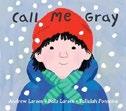
A queer child comes out amid a family tradition. Every winter, Gray and Dad build an ice rink together. But this year, something feels different. As the duo work side by side, the young protagonist shares feelings of hurt and confusion stemming from an incident at school, when best friend Zena didn’t invite Gray to her “girls only” sleepover. Gray delicately guides the conversation, asking if Dad ever feels “mixed up about who you are” or “different than the way you look.” When neither question gets the answer Gray hoped for, the child takes the direct approach: “I look like a boy but sometimes I feel more like a girl.” Gray continues to open up as Dad listens. Though the two adhere to beloved traditions—like enjoying soothing hot chocolate after their first skate of the year—the child feels empowered to make a big change: asking to go by a new name. Fontaine’s gouache artwork sweetly homes in on key moments in this gentle, slice oflife tale; closeups on Gray’s face capture the child’s thoughts and emotions. The slow, methodical activity of building the ice
Warmly and quietly affirming; young queer readers will feel seen.
CALL ME GRAY
rink provides an ideal framework for this difficult conversation. A welcome counterpoint to lessaccepting masculine figures, Dad may not always know the right thing to say, but he’s clearly a supportive presence who’s trying his best. Both characters are paleskinned and darkhaired. Warmly and quietly affirming; young queer readers will feel seen. (Picture book. 4-8)
Layton, T.Z. | Sourcebooks Young Readers (306 pp.) | $10.99 paper | September 2, 2025 9781464267109 | Series: The Academy, 1

Challenges on and off the field await a 12yearold Ohio boy who’s unexpectedly invited to attend an exclusive soccer camp in England. Leo K. Doyle may be a star forward on his YMCA league team, but after accepting a surprising invitation from a roving scout to attend a month of highly competitive tryouts for a Premier League youth development program, he finds himself far from home and, at best, in the middle of the pack. At the London Dragons camp, Leo, who’s cued as biracial, with a white dad and brownskinned mom, makes friends with fellow players from around the world. He also wins an antiAmerican bully’s grudging respect and even helps his 19year old coach with a sweet gesture of apology for his girlfriend. But from the outset, the focus is on “the Beautiful Game.” Without letting up on the breathless pace for a moment, Layton packs Leo’s narrative with clear descriptions of skills and techniques both basic and advanced, sapient coaching, game strategies, and intangibles (such as team chemistry) that ultimately come together to set Leo apart from his bigger, faster, stronger rivals. Following a series of hardfought elimination matches
culminating in a highstakes final in the big stadium under the eyes of the godlike professional team, Leo flies home in time for a dizzying final twist that sets up the sequel to this first entry in Layton’s popular British series. A page-turner for soccer-mad readers, whether fans or players. (Fiction. 8-13)
Lee, Kristen | Illus. by Martin Stanev Magic Cat (64 pp.) | $22.99
September 9, 2025 | 9781419779725

With this alphabetically arranged overview of the U.S.’s 50 states, Lee and Stanev wheel out distinctive vehicles, bridges, roads, geographical features, tourist attractions, and local events.
Lee promises “trains and planes, trucks and cars” but delivers much more as Stanev spills kinetically posed images in exuberant profusion across each state’s onepage entry. Iconic destinations from the Statue of Liberty to the Golden Gate Bridge appear. In this parade of wonders, Lee has interpreted the “things that go” theme loosely enough to roll past 10 lighthouses (including one in Nebraska), as well as races involving cars, horses, turkeys, funeral caskets, outhouses, toilet bowls, and mattresses in diverse locales. Also included are a drivethru museum in Alabama and the world’s biggest truck stop (Iowa), drivein restaurant (Georgia), rubber duck (Minnesota), and hotair balloon festival (New Mexico). Generic figures paddling down waterways or riding carousels, skateboards, and the like join a select but reasonably inclusive cast of inventors, aviators, and other notable movers. The general impression that there’s always something going on nearly everywhere in the country turns this quick flyover into an epic sweep. Fun to browse, and on track to excite an interest in any vacation trip. (index) (Informational picture book. 6-8)
Leigh, Lindsey | Penguin Workshop (96 pp.) $17.99 | November 25, 2025 | 9780593889657
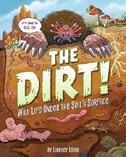
A vigorous dig into the interconnected lives of the denizens of our planet’s soil, from microbes to meerkats.
Focusing on fauna but also offering a few glances at flora and fungi, Leigh shovels quips and wisecracks into the rich factual loam that fills her crosssectional and inset views of the biota that mostly live their lives just out of sight while busily making nutritious “humus” (“No, no, not hummus!”) from sterile dirt. The author/ illustrator works her way up from bacteria and nematodes to the memorably named screaming hairy armadillo and hog badger. Nematodes, she notes, make up some 80% of all animal life on Earth and serve as a “bountiful noodley buffet” for many predators. Along the way, she convincingly underscores the fundamental notion of interdependency, from the “wood wide web” on. And though Leigh urges readers to love their teeming terrestrial neighbors underfoot, she also presents a remarkably nuanced picture. She explains that though earthworms are beneficial, some are invasive to North America and potentially harmful (“Earthworms: Forest Frenemy”). All of this chewy grit is sandwiched between closer looks at soil itself as medium and habitat, beginning with its composition and layers and ending with the effects of erosion, pesticides, and acid rain. Burrows brilliantly into its topic with a will and a wink. (index) (Graphic nonfiction. 8-12)

Long, David | Illus. by Jamie Coe Faber & Faber (224 pp.) | $26.95
November 4, 2025 | 9780571382941

For more by Lindsey Leigh, visit Kirkus online.
A brisk, globetrotting collection recounting over 150 years of daring reallife escapes. British historian Long delivers highstakes adventure steeped in historical insight. From downed pilots to enslaved people in 19th century America and humanitarian workers fleeing conflict zones—as well as some whose “lives were hardly heroic” yet showed “extraordinary cunning and imagination”—the subjects make their bids for freedom. Some stories, like that of Indian aviators lost in Pakistan following the Indo Pakistani War of 1971 or a Japanese man who repeatedly escaped after being imprisoned for robbery and murder in the 1930s, read like fastpaced thrillers. Others highlight inventive wartime tools—maps hidden in playing cards, compasses concealed in false teeth—designed to help prisoners of war escape. Of the 32 chapters, about a third center on women and/or people of color. Many of the subjects—Harriet Tubman and Winston Churchill excepted—may be new to readers. Long’s prose is lively, and the swift pacing within each fiveto sixpage vignette offers accessible entry into history. Some of his subjects endured horrific treatment, such as Yazidi human trafficking survivor, activist, and Nobel Peace Prize recipient Nadia Murad, although Long’s middle grade–friendly language hints at atrocities without being excessively graphic. Unfortunately, the book doesn’t contain sources. Coe’s stylized, fullpage color portraits open each chapter, breaking up the text and visually enhancing the book’s momentum.
An energetic read, rich in details and suited for readers drawn to unusual tales of resilience and ingenuity. (Nonfiction. 9-12)
Kirkus Star
Maillard,
Kevin | Illus. by Rafael López
Roaring Brook Press (40 pp.) | $18.99 October 14, 2025 | 9781250821980

A child grapples with the strange largeness of grief. Where do our loved ones go when they walk on, and what does that mean for those who miss them? This poignant meditation on loss centers on the household that a grandmother leaves behind as life goes on. As the family packs up her home, each chore offers an opportunity to ponder what she’s doing elsewhere, earthly tasks made magnificent by the wonders of an unknowable beyond—perhaps she waters a garden, growing titanic sequoias or herbaceous jungles; perhaps she’s fishing, nabbing a dinnertime catch with the help of a friendly whale. All the while, her grandchild moves through their previously shared space, navigating death’s contradictions and confronting tensions between the permanence of loss and the material proof of life interrupted. The narrative’s conclusion leaves readers with a vital reminder: Mortality unifies humanity, but remembrance and the momentum that it inspires suggest an afterlife without end. The text’s treatment of grief is masterful and accessible, exploring the experience of loss with affirmative nuance, while captivating visuals emphasize the permeability between life and what lies ahead; the windy tendrils done in rainbow colors are especially affecting. Maillard (Seminole Nation) and Mexican illustrator López hail from cultures with distinct death traditions, each of which is touched on individually in informational backmatter. The protagonists are brownskinned, and references to both creators’ heritages are woven into the artwork. Supporting characters are racially diverse. Stunning and essential. (author’s and illustrator’s notes, recipe) (Picture book. 5-9)
A gorgeous, reverent celebration of a cherished symbol of African tradition.
KENTE FOR JOJO
Mandin, Christy | McElderry (40 pp.)
$19.99 | October 28, 2025 | 9781665960588
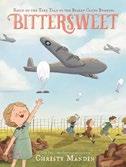
Hungry children in postwar Berlin see candy float down from the sky in this re creation of a historical incident. Aside from a fictive point ofview character, Mandin’s account reflects historical records. In a divided country, in a divided city, paleskinned young Hilda and other children wander through bombed out streets, subsisting on scarce rations. When an American airman named Gail Halvorsen sees the reverence with which a group of youngsters shares two sticks of gum, he heads back to base, ties small bundles of chocolates and other sweets into parachutes made out of handkerchiefs, and adds them to the provisions being dropped by the Berlin Airlift—secretly at first, but then with official and volunteer support after reports of a clandestine “candy bomber” hit the papers. “Operation Little Vittles” went on to provide an amazing 23 tons of sweets—“key ingredients in the recipe for healing,” writes Mandin in a lyrical close. If her tidy illustrations of freshfaced, neatly turned out young people living in broad streets strewn with cleanlooking rubble veer on the treacly side, they do reflect the sweetness of both the episode and the altruistic impulse behind it. Scenes of service people and volunteers include some dark skinned figures.
A satisfying salute to a little-known act of kindness. (author’s note, bibliography) (Informational picture book. 6-8)
Mantchev, Lisa | Illus. by Taeeun Yoo
Paula Wiseman/Simon & Schuster (32 pp.) | $19.99 | September 16, 2025 9781665962766 | Series: The Pet Club
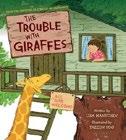
A tanskinned, ponytailed youngster describes the challenges of caring for a very tall pet giraffe. Mitigating their differences in size, child and pet adapt and compromise, because “that’s what friends do: they find ways to meet in the middle.” The park’s treehouse, where the young narrator and a group of diverse friends gather with their own unusual pets, is inaccessible for Giraffe: He must poke his head through the window to participate. One day, the narrator literally goes out on a limb with an umbrella to protect Giraffe from the rain. The next page depicts the child in a cast and using crutches. “For days and days, everything is just a little bit harder than it used to be.” And now, the clubhouse is inaccessible to the child, too. But the protagonist has an idea, and after the youngster explains and the club members have a vote, everyone pitches in to move the “Welcome Back” party, and the clubhouse’s contents, down to ground level. Mantchev takes inclusion a step further from in her earlier book Strictly No Elephants (2015), demonstrating that removing barriers to physical access can transform a nominal “All are welcome” policy from good
intentions to committed practice. Yoo leavens the message with winsome doublepage spreads that cheerfully accentuate the diversity of both children and pets (including an armadillo, mininarwhal, skunk, and more).
A kid-friendly look at the multifaceted work that underpins true inclusivity. (Picture book. 4-8)
Marianayagam, Maria | Illus. by Geeta Ladi | Astra Young Readers (40 pp.)
$18.99 | October 28, 2025 | 9781662620294

Unsure about the definition of curry, a young girl of South Asian descent discovers that this term encompasses many things all at once. Shirin goes outside to play, floating in a fragrant cloud of the curry she loves. Her friend Charlotte, who’s paleskinned with light brown hair, asks about the “spicy smell” surrounding her, so Shirin brings her home to show her. Shirin’s Amma (mother) begins by tempering spices in hot ghee, then shows the two girls how curry is cooked, step by step. Together, the children sniff and smell, touch and taste the different ingredients. Finally, Shirin adds her own twist to her mother’s chicken curry. Under Amma’s guidance, the girls discover that a curry can take on different forms, depending on the mix of ingredients and the cook’s creativity. This book affords a dual reading experience; sensoryrich text styled in a bold font reads like a poem (“Curry was a bead, popping and swirling,” “Curry was art—vibrant and magical”) accompanying the main narrative. Read together, both texts complement each other. This tale will especially appeal to readers of South Asian heritage, who will welcome this authentic representation of the lingering fragrances of a complex food, although others will, too. Evoking the enticing aroma of beloved foods, Ladi’s swirling illustrations extend Marianayagam’s words nicely,
while the backmatter uses apt comparisons to further define what curry is. A clever stew of poetic words spiced up with joyful illustrations. (recipe for chicken curry, glossary) (Picture book. 4-8)
McCarty, Peter | First Second (288 pp.) $24.99 | October 14, 2025 | 9781250170620
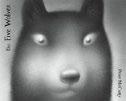
Five wolves create and discuss art during their adventures in this streamofconsciousness narrative.
The format defies easy categorization. Its episodic structure, roguish characters, and philosophical commentary suggest a picaresque tale; the page turns and abundant illustrations evoke a picture book. The verbal storytelling, spun from dialogue and an offstage narrator, unfolds in handlettered sentences that form swirling, mostly blue wavy lines filling compact spaces on the white pages. Larger, darker text demands to be read first. Highly textured ink renderings, many in gray (among other colors, used monochromatically), punctuate the pages of text. An early scene portrays the wolves on a Vikinglike ship, painting on canvases. A shark leaps to steal the portrait the wolf has drawn of it, activating the plot, which involves five competitive, artistic cats, who fire their vessel’s cannon, as well as a shipwreck, flying creatures, a fiery encounter with a dragon regarding an impromptu mural, a princess in a hanbok, and a climactic battle. Many of the remarks and asides deal with the nature of art: what can be seen, what role identity plays, if serious art is superior or some subjects are unworthy, the role of permission in creating art, and whether some artists can be considered failures. McCarty pulls some lines from children’s books and popular culture, including The Runaway Bunny and Star Wars. This utterly original book respects its readers, asking them to display patience, have comfort
with ambiguity and rereading, and exercise the ability to construct meaning. Striking and provocative.
(Illustrated fiction. 10-adult)
Kirkus Star
Mensah, Bernard | Illus. by Elizabeth Zunon | Knopf (32 pp.) | $18.99 June 3, 2025 | 9780593567128

A Black child chooses a special cloth for a new baby brother. The day has arrived to select little Jojo’s kente, a Ghanaian cloth known for its striking patterns. Kente has a rich cultural history; as Daddy says, it all began many years ago, when, according to lore, two hunters saw the spider Ananse spinning a beautiful web and asked him to teach them. Mummy, Daddy, baby Jojo, and the story’s nameless young narrator enter a brick building filled with cloth and weavers hard at work at their looms, “moving their hands to an invisible beat.” One of the weavers asks the protagonist what story the cloth should tell, and the child points to the rainbow peeking through the windows. “Ah, Nyankonton,” the weaver says, “the story of God’s eyebrows.” Guided by the master weaver, the youngster gets to work on the loom: “We move…and sway, with hands and feet. Dancing.” As they “weave to the beat,” the child slips. Oh no! But the weaver is reassuring: “Kente is about love.” Zunon’s characteristic collage and mixedmedia illustrations, radiant with bold color, practically leap from the page, conveying the richness of the fabrics. The layered images reflect the complexity of kente—textural, intricate, and deeply symbolic. Mensah’s lyrical text, infused with onomatopoeia and cultural detail, captures the rhythm of weaving, creating a narrative as vibrant as the cloth itself. A gorgeous, reverent celebration of a cherished symbol of African tradition. (more information on kente and its patterns, examples of patterns) (Picture book. 5-8)
Kirkus Star
Over and Under
the Coral Reef
Messner, Kate | Illus. by Christopher Silas Neal | Chronicle Books (60 pp.) | $18.99 | August 26, 2025 9781797225357 | Series: Over and Under

Another triumph for two masters of picturebook nonfiction. Having taken readers everywhere from the rainforest to the desert, it was only a matter of time before this dynamic authorillustrator pair invited us somewhere even more tropical. To say that the experience was worth the wait is an understatement. This latest installment of the bestselling series features a brownskinned father and child as guides into the vibrant world of the coral reef. The book is a harmonious marriage of text and illustration; Neal has composed a symphony of color that makes for utterly immersive settings that also offer opportunities to learn more. As schools of blue tangs swirl and dance in concentric circles around bright red coral, the effect is so lush that even the Little Mermaid would long to return to the sea. Messner’s perfectly chosen prose advances the story, introducing the protagonist to various nooks and crannies of the reef while allowing readers to feel the sensations of floating, diving, and breathing underwater as they turn the pages. Taking youngsters to the inky depths alongside great barracudas and spotted eagle rays, then back to the water’s surface in time for a breathtaking
sunset, this engaging book renders the reef mesmerizing.
An enchanting work that will delight young readers and undoubtedly spur requests for Caribbean summer vacations. (author’s note, more information on the animals featured) (Informational picture book. 4-8)
Meza, Estelí | Rocky Pond Books/ Penguin (40 pp.) | $18.99 October 7, 2025 | 9780593859148
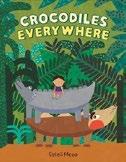
Big life changes bring unexpected emotions.
After the protagonist’s best friend, Ana, moves away, the child experiences a whirlwind of feelings. The days seem to stretch on forever, and school feels different. Quietly, the crocodiles arrive. The brown one is loud, leaving overturned toys and household objects in the wake of her tantrums; the gray one’s sobbing fits keep the youngster from reading. Only the child can see them, and though the protagonist attempts to ignore them, they continue to intrude. Finally, on a family vacation, the youngster confronts both crocodiles: The child hugs the gray one (Sadness) and cries with her, then screams with the brown one (Anger) until their rage subsides. Having achieved catharsis, the young narrator feels much better and looks forward to spending a day with Ana in the future. Meza’s straightforward, compassionate text is firmly rooted in children’s natural—at times seemingly irrational—emotions. Created with paper, colored pencil, and Photoshop, her
naïve, earthtoned illustrations make use of geometric shapes, complementing the story well. Sharpeyed readers will spot Sadness and Anger lurking in the background of numerous spreads early on—underscoring the idea that complex feelings are always with us, even if we aren’t consciously aware of them. The protagonist is tanskinned; other characters vary in skin tone.
An empathetic tale, ideal for helping little ones ride out the storm of turbulent emotions. (Picture book. 4-7)
Miles, Brenda S. | Illus. by Monika Filipina | Magination/American Psychological Association (32 pp.)
$18.99 | October 7, 2025 | 9781433847424

An anthropomorphic s’more has an identity crisis. Graham—a campfire treat made of chocolate and marshmallows sandwiched between two crackers—leads a comfortable life, going to school, doing chores at home, and playing soccer. But as he grows bigger, he begins to wonder if he should do more with his life. At first he tries to emulate his fellow sweets, but lollipop swirls are dizzying, and cupcake sprinkles make him itchy. Graham reads, travels widely, and attempts hobbies, from kayaking to karate. Then he has an epiphany. By celebrating joy, sharing love, and exploring different possibilities, “you become more and more like the YOU you’ve always wanted to be.” Brief descriptive statements with a didactic, earnestly selfhelp vibe are brightened by charming portrayals of cheerylooking foodstuffs that add humor and emotion. Confusingly, readers are told that “Graham started off small,” then “doubled in size” before becoming a s’more, but he’s visually depicted as a s’more right from the beginning. Wordplay (“as a s’more, what more could he be? What more should he be?”) will likely be lost on the young audience, as will Graham’s rather existential yearnings. Miles concludes with an author’s
note aimed at adults, a dense and heavy dissertation on child development. Imaginative, but overdone and pedantic. (Picture book. 5-8)
Milusich, Janice | Illus. by Chris Raschka Anne Schwartz/Random (48 pp.) $18.99 | October 7, 2025 | 9780593308172

Readers follow blind narrator Neveah through the four seasons and experience the year’s cyclical beauty through the youngster’s sensory world. Milusich, who works with visually impaired preschoolers, and twotime Caldecott Medalist Raschka have crafted a text that unfolds with gentle lyricism, each season introduced through specific sensory markers: winter’s “scruunnch” of boots in snow and the “soft tap of flurries” on cheeks, spring’s sweet hyacinth scent and buzzing bees, summer’s sandy grains between toes, and autumn’s “scritchscratch” of raked leaves. The onomatopoeia throughout is particularly effective—from the bee’s “buzzz” to the squirrel’s “chutchutchutter” and the satisfying “plop!” when Neveah dives into the leaf pile—creating an immersive auditory landscape. Milusich brings authentic understanding to Neveah’s perspective, treating the protagonist’s blindness not as limitation but rather as a gateway to richer sensory awareness. The firstperson narration feels natural and joyful. Raschka’s watercolor and oil pastel illustrations complement rather than dominate the text—swirling, impressionistic spreads that suggest movement, temperature, and texture through color and gesture. The art wisely avoids literal representation, instead creating emotional landscapes that mirror the sensory experience described in words. Young readers will discover that closing their eyes while listening to this story enhances rather than diminishes their understanding, making this an ideal choice for developing sensory awareness
and empathy. Neveah and Mommy have skin the color of the page.
A thoughtfully crafted celebration of the rich sensory world that surrounds us all. (Picture book. 4-8)
Miyares, Daniel | Anne Schwartz/ Random (240 pp.) | $21.99
September 30, 2025 | 9780593568293
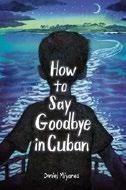
In the late 1950s, a boy’s life is turned upside down by the Cuban Revolution. In this touching graphic memoir, Miyares depicts his father Carlos’ childhood before and during
dictator Fidel Castro’s ascent to power. Affectionate interactions between Carlos and his mamá and abuelo and vibrant shades of green and blue portray the joy Carlos felt growing up in rural Ceiba Mocha. So, when his hardworking papi won the lottery and relocated the family to the city to launch his dream of owning a woodshop and selling furniture, the move was a huge adjustment for nature loving Carlos. At school, kids teased him for being a “country kid,” but nothing compared to the fear Carlos experienced when the government was overthrown. Miyares intersperses brief, digestible political updates in blackandwhite throughout, forming a stark contrast to the vivid color palette of Carlos’ daily life. Suddenly, men with guns seized Papi’s business. Food was rationed. Neighbors spied on each other to see who didn’t support the revolution—and they had their eye on Papi. Rumors abounded that those who opposed communism or Castro were being shot. Worst of all, one day Papi disappeared. But even when things were at their bleakest, Carlos and his family found hope in the possibility of making one more move—to America and freedom. The expressive art in this powerful work has
a nostalgic feeling while also conveying emotional immediacy.
A heartfelt, suspenseful story about family and resilience. (author’s note) (Graphic memoir. 8-12)
Morales, Yuyi | Neal Porter/ Holiday House (32 pp.) | $18.99 September 2, 2025 | 9780823447541

A band of young naturalists leap forward for change in Morales’ ecoconscious appeal.
“How shall we begin?” The inquiry comes from three diminutive “rebeldes” (Spanish for rebels)—one with basaltcolored skin, one with rich brown skin, and another with vitiligo of the skin. Morales pulls various streaks of inspiration—an Olmec head, a blue land crab—together to weave earthtoned artwork that amazes. So what does it mean to be a little rebel? Apart from appearing in “all colors and forms,” little rebels “take the time we need to find each other,” ask questions, use words to “shape the world we want to live in,” and dream big. The three youngsters merrily travel across the land, joined by a dog, butterflies, and a small bird, before one suggests playing with agüita (water). Arriving at the lagoon, the rebels instead find a driedup bed of cracked soil, much to their dismay. And then, “KEEEK.” Their little feathered friend falls through a crack. Calling on their older brethren—las abuelas rebeldes— for guidance, the little rebels rise to save the day. Sprinkling a few Spanish words among the predominantly English text, Morales wistfully invites readers to consider their relationship with nature, encouraging selfreflection and creativity in equal measure. Though overstuffed with narration, speech bubbles, and occasional comicsstyle phrases, this rallying cry nonetheless beckons all dreamers. Publishes simultaneously in Spanish. Gently radical. (guidance on being a “little rebel”) (Picture book. 4-8)
Gus
DRAGONBORN
Murray, Liz | Illus. by Walid Serageldine Berbay Publishing (40 pp.) | $18.99 February 4, 2025 | 9781922610720

In this Australian import, a shared birthday leads to a relationship that lasts a lifetime. Gus the crocodile loves performing for the zoo’s many visitors, “splashing and snapping for the cameras,” but his favorite guest is paleskinned young Edward. While visiting the reptile enclosure on his birthday, Edward witnessed Gus hatch from his egg, and since then, he’s returned each year so the two can celebrate their big day together. When he grows up, Edward becomes a zookeeper who works at the reptile house, and he continues to visit on their birthday even after he retires. Though both are slowing down in their old age (Gus often feels “too tired to splash and snap,” while Edward complains of his aching hip), their bond endures. Until the day Edward fails to show up on their birthday. Worried, Gus sets out for Edward’s retirement home and discovers that his pal hasn’t forgotten about him, but he’s physically unable to make the trek to the zoo. An understanding nursing home attendant offers a solution, bringing Murray’s quiet friendship tale to a satisfying close. Serageldine’s soft, hazy illustrations anthropomorphize the title character with aplomb; bigeyed Gus sports a diaper after hatching and wears orange swimming trunks as an adult. Sight gags—Gus getting tangled in a retirement home resident’s knitting as he surreptitiously attempts to find Edward, Edward’s crocodilecovered jammies— infuse this sentimental tale with humor.
A tender tribute to birthdays and friendship—two things that only get better with age. (Picture book. 3-7)
Murray, Struan | Illus. by Devin Elle Kurtz | Dutton (384 pp.) | $19.99 October 14, 2025 | 9798217113217
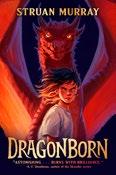
A lonely and anxious English girl discovers a family secret in this series opener from acclaimed Scottish author Murray. Twelveyearold Alex Evans, who presents white, lives a cloistered life with her controlling mother. Her only escape is the nearby forest, which reminds her of her deceased father. There she meets Oliphos, a kind (and oddly dressed) Black man with a Scottish accent, who tells her something surprising about her heritage. Oliphos introduces Alex to Dr. Archibald P. Puppinsworth, a Dragon Scholar who knows all about the Otherworld, the magical dimension where dragons live. Alex realizes that she possesses a special power that might help locate the Phylactery, a longmissing magical object sought by the villainous Drak Midna, a terrifyingly manipulative—and enormous—ancient dragon. Along the way to Skralla, one of the last dragon refuges, with Oliphos, Alex meets Erik, an orphan with “chestnut curls” who understands what it’s like to feel like an outsider. Both young people are battling unknowns and deep loneliness, and their complex characterization feels realistic even though fantasy worldbuilding forms the backdrop of their friendship. Coming from a highly sheltered background, Alex may be naïve at first, but she grows in
maturity and bravery as the book progresses. The well executed worldbuilding includes portals called waypaths and dragons with creative features. Murray explores themes of intolerance through the world’s history of human dragon conflict. Come for the dragons but stay for the suspenseful reveals and relatable characters. (Fantasy. 8-12)
Mutch, Kevin Fraser | Fantagraphics
Books (428 pp.) | $29.99 paper
August 12, 2025 | 9798875000751
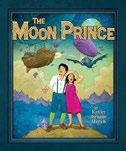
Siblings living in New Jersey during the reign of Queen Mathilde become embroiled in lunar politics. Twelveyear old Max and his younger sister, Molly, are orphans who spend their days toiling away in a quarry. When an older Black man appears, the two learn they have a mystical heritage. He directs them to seek a special map and follow it—and the map ultimately sends them all the way to the moon. There, they find many strange and wonderful creatures, who are embroiled in conflicts of their own. Max and Molly might be the key to saving the moon and the Earth—if they can uncover the secrets of their past in time. The siblings, who have lightbrown skin, black hair, and unusual turquoise eyes, are biracial, something that’s established by the racial slurs the white quarry manager flings at them. Their earthly society is deeply divided by race, and when they reach the moon, they find there are other ways that beings divide themselves and perpetuate inequalities. Both the illustrations and episodic plot evoke a retro storytelling aesthetic. This adventurous tale is bizarre, entertaining, and grounded in relationships: Molly searches for kindness, and Max fights to protect her. Although this is a satisfying story without the adrenalinefilled incidents or lengthy worldbuilding that the
genre often contains, there’s a mismatch between the protagonists, whose behavior feels very young, and some of the more mature content. An imaginative take on galactic empires with relevant social commentary. (map) (Graphic science fiction. 11-14)
Myers, Alison Green | Dutton (208 pp.) | $17.99 September 23, 2025 | 9780593325704

Twelveyear old Reilly Rhoades discovers that finding happiness isn’t as simple as it sounds. After her grandfather’s death, Reilly watches her family’s Pennsylvania amusement park crumble—along with their fragile unity. Explosive fights erupt between Reilly’s mother and aunt, and the tension only escalates when they find out Grandma needs a heart bypass. Living in trailers behind the park, the family faces further strain when Reilly’s aunt and her beloved cousin abruptly leave, and the financial burden of Grandpa’s unfinished ski lift project threatens everything. When 12 year old Alex, who’s staying at a nearby campground, splashes into her life with endless questions and great enthusiasm, Reilly finds an ally who shows her that sometimes it’s OK not to be OK and helps her find a way to pay tribute to her grandfather. Throughout, Reilly grapples with the “Rhoades Family Way”—the expectation of constant hard work and selfreliance that defined her grandfather’s legacy. Myers offers an unvarnished depiction of a genuinely flawed family. She weaves in themes of addiction recovery through Barnett, the wise park manager whose guidance helps both Reilly and her recovering mother navigate their struggles while learning that happiness isn’t always “just around the corner,” as the park’s billboards
promise. Reilly and her family are cued white; Alex is Taiwanese. A thoughtful story about honoring the past while building bridges to new possibilities. (author’s note) (Fiction. 10-18)
Nelson, Colleen | Illus. by Peggy Collins Pajama Press (136 pp.) | $18.95
October 14, 2025 | 9781772783483
Series: Mystery at the Biltmore, 3

Accompanied by best bud Oscar Delgado and sharp nosed Carnegie the terrier, 11year old gumshoe Elodie LaRue takes on an especially sticky case. Elodie, who lives at the Biltmore—an opulent apartment building on New York City’s Upper West Side—already has two solved mysteries under her belt, so she’s sure she can help when she’s approached by Sebastian. A young man from Coney Island with bleached blond hair, piercings, and tattoos, Sebastian has an urgent case. His binder of recipes has gone missing—including one for a “cruffin” (a pastry/ muffin mashup) he believes will guarantee the success of his nascent bakery. Detection again proves an exercise in careful observation and logical thinking, and attentive readers will spot the clue that helps Elodie figure it all out. In this installment, Elodie becomes more self assured, and Oscar takes on more of the detecting work, with Elodie’s proud approval. Nelson’s lively writing and expert pacing sustain justright tension while adding vocabularyfortifying words like bravado and doppelgänger Sprinklings of wisdom flavor the text: Vulnerability is normal, failure is OK, and life’s essential ingredients are self confidence, friends, and imagination. Collins’ colorful art is
as delicious as ever, depicting racially diverse, distinctive characters old and young. References to Manhattan institutions such as Zabar’s, as well as the inclusion of the Pawtographer—a pet photographer based on the reallife social media account the Dogist—make for a readily recognizable depiction of a modernday New York City. A toothsome treat for mystery fans. (author’s note) (Mystery. 7-11)
Nordqvist, Sven | Trans. by Polly Lawson | Floris (32 pp.) | $19.99
September 16, 2025 | 9781782509288

Fantastically detailed paintings depict a young boy’s encounters with a variety of quirky characters as he travels through unfamiliar territories in this Swedish import. Paleskinned, towheaded Sam wakes to find himself in a forest. A number of friendly “small folk” surround him and offer assistance. A wise woman tells him to take the “yellow road” to get back home. As he walks, climbs, rides, sails, and even parachutes, a magical backpack gifted by the small folk holds an apparently endless supply of just what he needs at any given moment. As in previous works, Nordqvist’s ink, watercolor, and acrylic illustrations reward close attention; the artwork contains myriad items not referred to in the straightforward text. Miniature farms with insect livestock, fancifully built houses, the wise woman’s cluttered room, and an artist’s studio are particularly intriguing. A spontaneous dip in a soup pot pool, an amusing underwater scene, and a frantic chase by assorted animated toys add humor to Sam’s journey. Encounters with (slightly) menacing trolls and talking animals contribute to the fairytale feel. Reminiscent of Remy Charlip’s Fortunately (1964), the episodic tale sees Sam experiencing both setbacks and serendipitous events. Once reassured by Sam’s arrival in
and warm. Following Nanna’s talk, the pair eat the rich chocolate cake as the evening fills with fireworks, driving home the contrast between the country’s past and present. Where the book succeeds most is in its intergenerational bond and its subtle reveal to children that their grandparents may have stories to tell. A recipe for the cake is included, as well as an author’s note delving further into Malta’s history. Sweet and savory all at once; a lesser-known history gets its due. (glossary) (Picture book. 4-7)
Popova, Maria | Illus. by Sarah Jacoby Enchanted Lion Books (44 pp.) | $19.99 November 4, 2025 | 9781592704378

An exploration of tranquility and solitude, glimpsed from a snug nook in the moon. Re, a blue, hedgehoglike critter, wakes on a July morning, feeling lonely. The only solution? To go to the coziest place on the moon, of course! At precisely 7:26 (“a pretty number, a pretty hour”), Re hops a beam of light and in a mere 1.255 seconds is there. Immediately Re begins searching for the perfect spot, but what’s this? Someone’s already there, and for the same reasons as Re. Now the two can live in parallel tunnels, coming together once in a while but only when they like. Popova takes exquisite care to clarify to young readers that being by oneself can be a positive, even healing, act (“that feeling which feels like hearing your own voice singing back to yourself”).
Evocative language punctuates the book in unexpected ways—the author notes that the coziest place on the moon is “a tube of a nook, as deep as a skyscraper is tall.” Backmatter explains that in 2022 NASA found tubes on the moon where the temperatures are around 63 degrees Fahrenheit. Jacoby’s dreamlike art gives all characters an
inner glow of their own, staving off the impenetrability of space in favor of light, warmth, and fuzz.
A loving acknowledgment of the joys of being “happy-alone,” told with care and delicious language. (Picture book. 3-6)
Rajan, Rekha S. | Illus. by Ken Daley
Beach Lane/Simon & Schuster (48 pp.)
$19.99 | October 14, 2025 | 9781665957038

Celebrated musicians’ lives unfold in parallel before a fateful duet launches their legendary friendship. Young Ella Fitzgerald “felt the music.” She “danced everywhere” and “dreamed of her chance to be onstage,” ideally at Harlem’s Apollo Theater, where she could often be found in the audience. Meanwhile, young Louis Armstrong “dreamed of being a famous musician” and sang his way through New Orleans before picking up the trumpet as “hiphopping, toe tapping, finger snapping beats thumped inside” him. Ella’s distinctive scatting and Louis’ soaring brass skills eventually led both musicians to L.A.’s Hollywood Bowl, where “they took the stage together” and combined their talents with a swinging “push and pull” that kickstarted not only their lasting friendship, but also musical collaborations around the country. Daley’s bustling digital illustrations with bold brush strokes in rich jewel tones radiate joy and anchor the performers amid immersive, detailed landscapes with dramatic perspectives. Stealing the show are swaths of musical notes that cut, curve, and sway across the primarily double page spreads and complement the swinging phonetics of the musicians (“Ba da da da,” “snap pa snap”), the latter set apart from the appreciative and onomatopoeic text in a bold, prancing font.
A zippy and tuneful dual biography of innovative jazz collaborators. (author’s and illustrator’s notes, sources, recommended reading) (Informational picture book. 4-8)
Ramirez, Ainissa | Illus. by Setor Fiadzigbey | MIT Kids Press/Candlewick (40 pp.) | $18.99 | October 21, 2025 9781536225280 | Series: Black Innovators
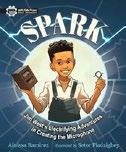
A warm salute to an undersung Black scientist. Budding inventors could do worse than to pick Jim West as a role model. Growing up a farm boy with a compulsion to take things apart to see how they worked and—thanks to an encounter with a live wire he was lucky to survive—a fascination with electricity, West went on to study science in college, where he was one of only two Black students. He supported himself by repairing TVs and eventually built a career from a summer internship at Bell Labs. There (generally posed as a solitary figure with an intent look in Fiadzigbey’s illustrations) he worked on an improved design for headphones and discovered a new way to make microphones using Teflon and other “electrets,” or substances that hold electrical charges, that consequently don’t need to be connected to a source of power to work. Today they can be found everywhere, Ramirez writes, in toys, cell phones, and computers. Her explanations of the science are indepth and sure to appeal to STEMminded kids like West. In her biographical afterword, the author also points to West’s continuing efforts to draw more people of color into scientific fields—a theme the illustrator underscores by adding colleagues and students with darker skin tones to group scenes. Unusual in both subject and its gratifying level of technical detail. (author’s note, timeline, information sources) (Picture-book biography. 6-8)
Reese, Jenn | Illus. by Devin Elle Kurtz Greenwillow Books (40 pp.) | $19.99
September 9, 2025 | 9780063356269

When the forest beckons, pick your path with a pinch of magic. At the edge of the woods, you peer into darkness and prepare to choose the best way through. Perhaps you’ll stick to the wellworn path; it’s lovely, though somewhat dull. If instead you want to ride a griffin, don’t forget to offer it a gift first. Or perhaps stowing away on a moss giant is more your style? Tuck yourself into her lush green hair and enjoy the slow ride. You could always take the sprite tunnels (they’re great fun, but the journey will last a century or more). Readers can take six whimsical ways through the forest, but only the most adventurous of travelers might want to seek a seventh. “You do? Excellent. I knew I was right about you.” The real wonder is found within the woods, not on the other side, notes the unseen narrator, who invites readers to stay awhile. Reese’s spare, secondperson prose in playful conversation with the audience adds an interactive element to the story, numbering and describing the different ways forward. Kurtz’s gorgeous and positively glowing painterly digital illustrations steal the show. Her expert use of light and texture creates a rich, magical world of wonder within the forest. Among the adventurers are children with various skin tones and hair textures; one child has a cochlear implant.
Mossy, majestic, and marvelously meandering, this lush forest labyrinth is brimming with magic at every bend. (Picture book. 3-6)
Ricardo, Mat | Faber & Faber (224 pp.) | $14.95 paper | October 7, 2025 | 9780571383962
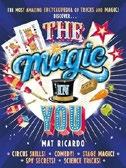
An acclaimed English variety artist shares the secrets of his magic tricks and his positive attitude toward life.
Organizing his work into five chapters, beginning with the titular “The Magic in You” and going on to cover “The Funny in You,” “The Circus in You,” “The Science in You,” and “The Hero in You,” Ricardo offers far more than an entertainer’s guidebook. He encourages young readers to confirm facts (especially those found online) and to be themselves (while allowing themselves room to grow and change). They’ll also learn how to do “stupid” tricks, tell a funny joke that doesn’t hurt anyone, juggle, pick a lock, say “I don’t know,” and put themselves forward even when they’re afraid. Readers will discover that sharing ideas “is how the world gets better.” They’ll encounter repeated reminders that practice is key. The text layout is inviting, with plenty of white space, varied fonts, and bullet points. The narrative is chatty, often humorous, and presented in short segments, with small flip book illustrations in the bottom righthand corners. Unfortunately, there are no other pictures or diagrams to support readers who
It would be hard not to be happier after reading this entertainer’s guide.
struggle with following directions based on text alone, although the book contains a link to the author’s website, where they can locate links to videos of him performing. “Comedy is about spreading happiness,” Ricardo proclaims. It would be hard not to be happier after reading this entertainer’s guide.
Encouraging, instructive, and completely charming. (Nonfiction. 9-12)
Ruiz Johnson, Mariana | Trans. by Avi Silberstein | Greystone Kids (52 pp.) | $19.95 September 16, 2025 | 9781778402425

An anthropomorphized, multigenerational rodent family experiences highs and lows over the course of a year. “When this story ends, it will begin again. That’s how it works.”
Readers initially drawn to the book’s cute and quirky comic aesthetic might be surprised by the unexpected poignancy of this tale, translated from Spanish. Directly and affably addressing its audience, the story’s narrator invites young people to reflect on cyclicality, special events that punctuate each season, and the way small changes can add up to big transformations. Starting with winter, each season transitions into the next, accompanied by wryly humorous descriptions of the shifting weather. Sure, spring means that “butterflies and bees will start partying all day long,” but it also brings “sneezes of all kinds.” Mice with delightfully oversize ears participate in seasonal activities such as building a “yeti out of snow,” attending a rustic, energetically illustrated fall festival, and indulging in a “voracious and inexplicable need for…ice cream!” Brief, relatable moments sprinkled throughout—such as an exasperated mother fitting a “too itchy” sweater on a reluctant child or a terrifying but triumphant leap into the pool—will inspire nods of solidarity. Big
changes, including Mom’s progressing pregnancy, reiterate the book’s theme: By year’s end, “some things will be different….That’s just how it works.” The offbeat animals, outlined in dark ink and digitally colored in muted tones, brim with personality and charm. Publishes simultaneously in Spanish. Nuanced and touching. (Picture book. 4-10)
Salomon, Nadia | Illus. by Nabi H. Ali Versify/HarperCollins (40 pp.) | $19.99
July 8, 2025 | 9780063249042

Two South Asian siblings resolve a conflict during Raksha Bandhan, a Hindu holiday devoted to celebrating the bond between brothers and sisters.
Aashi loves her older brother, Rakesh…most of the time. The two play carrom (an Indian board game), pretend to be pirates, and ride their scooters in the evening as the fireflies flicker. Some days, though, their relationship is harder to navigate— like when Rakesh rips Aashi’s favorite drawing (he claims it’s an accident; she’s skeptical) or when Aashi breaks Rakesh’s toy submarine (“OOPS! That was an accident, too”). But their recent fight clouds their experience of Raksha Bandhan, a holiday they usually enjoy. On this day, sisters tie a rakhi (or bracelet) around their brothers’ wrists, while brothers reciprocate by giving their sisters a gift, but today, neither is in the mood for loving gestures. But when they’re unexpectedly separated after a scooter accident, the children realize how much they love one another. Luckily, they reach a resolution in time to exchange both a rakhi and a gift. Though some Hindus have critiqued Raksha Bandhan for its patriarchal roots (the act of tying a bracelet is said to signify a boy’s willingness to safeguard his sisters or other female relatives), the story avoids mention of protection. Ali’s bright, detailed illustrations rely on
dramatic perspectives and angles and expressive characters, pairing well with Salomon’s clear, efficiently told text. A tender tale of siblings making amends. (more information on Raksha Bandhan, glossary, online resources) (Picture book. 3-8)
San Miguel, Samantha | Union Square Kids (304 pp.) | $17.99 | September 9, 2025 9781454960614 | Series: Spineless, 3
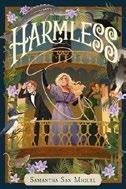
In this trilogy closer set in the Gilded Age, Florida sisters Frankie and Lulu Davenport and their best friend, Algie Emsworth, once again find themselves embroiled in danger. Frankie is laserfocused on becoming the most famous naturalist of her day, eager to best her adversary (and former mentor), the wicked Professor Champion. Seeing an ad for a paddleboat river trip and feeling guilty over an event in the previous book in which she sabotaged her father’s commercial fishing fleet, she decides the trip is the perfect way to bring the family together—and, not incidentally, to investigate rumors of a strange aquatic monster. Accompanied by Algie, his mother, and his older brother, Everett, the Davenports set off on the paddleboat tour. The trip becomes filled with tension after Everett encounters a former classmate from Chicago with whom he has a contentious relationship. Meanwhile, the kids hear an eerie call—is it the mysterious creature? The thirdperson narrative, following 13 year old Frankie’s point of view, skillfully highlights the prickly and confusing early teen years even as Frankie confronts internal clashes between ambition and responsibility. After Lulu experiences a near tragedy, Frankie is forced to take a hard look at her decisions, but she doesn’t, thankfully, lose her gritty edge. Earlier entries
established the siblings as white and Cuban American and Algie as white. Expertly combines an intricate adventure plot with an authentic coming-of-age story.
(Historical adventure. 9-14)
Sass, A.J. | Illus. by Noa Kelner Little, Brown (40 pp.) | $18.99 September 2, 2025 | 9780316446716

A look at the rituals that make Shabbat special to a wide variety of communities. Three families each observe the day in their own way. One child walks to temple with Mommy and Daddy. Another watches a sibling’s basketball game with Mama and Mommy; the family then shops and cooks a meal while singing along to their favorite songs. A third child gathers with a large extended family for a meal and games at home. Each family is different. Some are big, while others are small. Some observe traditional religious practices; others make their own. Featuring cheerful colors and patterns, smiling faces, and moments of quiet connection, Kelner’s thickly outlined artwork has a scribbly, intimate feeling, reinforcing a sense of joy in rituals that include eating, dancing, and reading Torah. Characters vary in skin tone and hair style and texture. Some wear kippot (skullcaps) and tallitot (prayer shawls), including some who present female or who are nonbinary. One Shabbat finds all the families gathered at the synagogue to celebrate a b’nai mitzvah— notably, a gender nonbinary celebration rarely represented in picture books. Sass’ flowing text is punctuated by the refrain “Shabbat is unique and beautiful for every person”; this loving message is made abundantly clear throughout and echoed in the author’s note. A uniquely inclusive celebration of the Jewish day of rest. (glossary) (Picture book. 4-8)
Schwarzenegger Pratt, Katherine | Illus. by Petra Brown | Penguin Workshop (32 pp.)
$18.99 | November 4, 2025 | 9780593385838
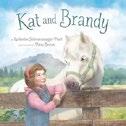
With her third picture book, Schwarzenegger Pratt tells a story about a girl’s life changing love for a horse, inspired by her own childhood.
Kat, a pigtailed, white presenting girl who wears a pink headband, watches wistfully as her mother takes riding lessons. She makes “it all look so easy.” Kat’s love of horses conflicts with her fear of them; when she was younger, she was thrown from a startled pony. Kat wants to try riding again, “but the fall [keeps] replaying over and over in her head.” What will it take for Kat to face her fear? The answer is Brandy, a rescue pony who has a skittish personality that Kat can relate to; they gradually develop a rapport. There’s good stuff here on the benefits of an animal companion and on the rewards of patience, but will readers have the endurance to get there? Low on action, the story drags, hampered by dull, cliched writing (“giddy with excitement”). It’s hard to imagine the narrative holding the interest of a kid who, unlike Kat, isn’t already smitten with horses. Brown’s delicate digital paintings show a steady hand, and her art has a determinedly bucolic look that would be at home in an American Girl book. For hippophiles, and probably only hippophiles. (author’s note, national resources to help horses) (Picture book. 3-7)
Shah, Amar | Illus. by Rashad Doucet Graphix/Scholastic (304 pp.) | $24.99
August 5, 2025 | 9781546110514

In this graphic memoir by sports journalist Shah, a ninth grader pursues his passion in the face of familial expectations pushing him toward a medical career, while also navigating the perils of high school social life.
It’s 1995, and Indian American Amar is desperate to meet the Chicago Bulls—Michael Jordan, in particular—when they stop by his Orlando, Florida, school. A lucky break leads him to his first sports interview, with Phil Jackson, and his tenacity takes him further, leading to multiple conversations with Shaquille O’Neal. But Amar’s luck in journalism doesn’t spill over to his relationship with his crush, blond Kasey Page (“like a mixture of Cameron Diaz, Tinkerbell, and heaven”), or his efforts to remain close with best friends Rohit and Cherian, who start spending more time with other classmates. The work relies on captions as much as plot developments to propel the story. It also follows a broad cast of characters—close and former friends, antagonists, supportive adults, and famous athletes—who appear in multiple storylines. The story accurately depicts the complexities of life as a young teen, though overlapping life challenges pull it in multiple directions, leaving some threads underexplored and hastily wrapped up. Doucet illustrates the characters
A celebration of reading that’s equal parts charming and gently spooky.
using loose, disjointed outlines that give the artwork a sense of movement, and the colorful backgrounds use patterns and action lines to indicate a wide array of emotions. A tighter focus would make this fascinating life story even more intriguing. (author’s note, photographs) (Graphic memoir. 9-12)
Sica, Rafael | Trans. by Bruna Dantas Lobato | Tapioca Stories (40 pp.) | $18.95 September 30, 2025 | 9798988749967

In this Brazilian import, a child soothes her relatives with the power of stories. Little Kooky lives in a house with her large extended family. At night, the whole household is restless; everyone is too afraid to sleep because of the ghost who haunts their home. But Little Kooky, unwilling “to let fear ruin her day,” grabs a good book. Traveling from room to room, she reads to her various family members to help them fall asleep—even the neighbor’s dog is lulled. The tale ends with the child finally going to bed: “With no fear to be found / with her book on her chest, / She climbed into her mom’s bed / And let her body rest.” Blackandwhite images reminiscent of Edward Gorey’s work and spare, occasionally rhyming text translated from Portuguese set a ghostly yet somehow reassuring tone from the very start. Illustrations full of intricate details and textures rely on thin lines and crosshatching. An offbeat sense of humor occasionally peeks through: One of Little Kooky’s relatives reclines in an upturned chair; the baby of the house sleeps in a crib with a mobile featuring bizarrelooking creatures. Readers will be intrigued by this simple story that offers a radical departure from typical picturebook art. Characters have skin the white of the page.
A quiet celebration of reading and family that’s equal parts charming and gently spooky. (Picture book. 3-5)
Sima, Jessie | Simon & Schuster (56 pp.)
$19.99 | September 16, 2025 | 9781665966085

Move over, Frosty, it’s time to get existential. In a wintry wonderland, a diverse quartet of children construct a snow kid (who’s described with they /them pronouns) with stick arms, stones for eyes and mouth, a carrot nose, and a top hat. Delighted with their creation, the youngsters dub the snow kid Twig but soon depart to warm up with hot chocolate. Their story is over, but Twig’s is just beginning. When the wind carries off Twig’s hat, the snow kid cries out, making their first sound. Twig wonders: What else can they do? They take their first steps but then confront a conundrum: Is Twig still Twig? Has the loss of the hat and the discovery of these new abilities transformed Twig into something else? “It seemed like the only way to go back to being Twig was to keep moving forward.” As Twig journeys farther, encountering new obstacles, their body transforms—they accumulate more snow, they lose their carrot—which provokes further questions. Savvy educators and caregivers will delight in introducing kids to this wholly original wintry tale that’s both a creative contemplation of identity and a sweetly snowy metaphor for the maturation process. Sima’s delicately hued, cartoonish images uplift the text, creating a visual story that enhances Twig’s tale. A snowy delight guaranteed to melt hearts. (Picture book. 4-8)

Slate, Laken | Illus. by Bindy James Charlesbridge (32 pp.) | $17.99
October 7, 2025 | 9781623545789

What waits in the shadows of a whale fall?
A huge skeleton becomes a haunted house in this spooky description of what happens after a whale dies and sinks to the bottom of the ocean. A pair of colorful fish venture within, encountering a variety of dangerous creatures: hagfish slime, a goblin shark, a vampire squid, a female anglerfish dangling her light bait, octopuses, and even zombie worms. But wait, there’s more: “pinching crustaceans” and, finally, creatures such as clams that help finish off the bones entirely. Slate’s eerie exploration covers the same ground as Melissa Stewart’s Whale Fall (2023), but with more atmosphere and less depth. James’ digitally created illustrations support the sense of menace. Unusual hues and strange sharp shapes against a black background suggest the darkness and otherworldliness of the ocean’s midnight zone (between 3,000 and 13,000 feet below the surface; once a dead cetacean reaches this level, it’s considered a whale fall). The text operates at two levels. Simply phrased sentences follow the fish through the decaying bones, with language that reads aloud well: “Dart through ribs! Duck beneath the backbones!” Text in a more expository voice adds information about the creatures and the threats they pose to the tiny explorers. This would be an entertaining, enlightening selection for a Halloween storytime; it will also nicely round out existing collections of whale fall books. An appropriately spooky dive into a mysterious world. (author’s note, information on the midnight zone and whale falls, resources, bibliography, QR code linking to a website about a whale fall site) (Informational picture book. 4-8)
Kirkus Star
Sloan, Holly Goldberg | Rocky Pond Books/Penguin (208 pp.) | $17.99 October 7, 2025 | 9780593530252
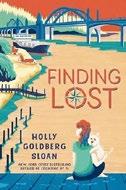
A young girl discovers that sometimes the things we need most find us first.
Middle schooler Cordy, short for Cordelia, feels as though she’s carrying an invisible backpack filled with sand—the weight of grief, two years and four months after losing her fisherman father to “The Accident.” Cordy desperately seeks signs of good luck while trying to hold her fractured family together. Then a hungry, foul breathed stray follows her home to her family’s rental, an old, leaky boathouse on the Oregon coast. She names the pooch Lost; the dog’s dental issues introduce the family to Pakistani American Taj, a veterinarian whose kindness extends far beyond animal care. Sloan populates her story with well realized adult characters who genuinely show up for children, among them a heavy metal–loving librarian who gifts Cordy a backpack and elderly Mrs. Crowley with her vintage Polaroid camera. The Oregon setting isn’t mere backdrop; Cordy’s fascination with marine life, from molting crabs to a rare pink dolphin, is woven seamlessly into her emotional journey. While there’s “always a chance of rain” both literally and figuratively, Sloan’s gentle wisdom shines through: “So much stuff is how you choose to see it.” Young people will recognize Cordy’s fierce protectiveness and her struggle with change, even if they’ve never experienced a life altering loss themselves. Redhaired Cordy presents white.
Heartwarming and hopeful—readers will treasure this story of family and resilience. (author’s note) (Fiction. 9-12)
naturalists will be utterly absorbed by the tiny delights here.
Snyder, Laurel | Illus. by Leanne Hatch
Clarion/HarperCollins (40 pp.) | $19.99 September 16, 2025 | 9780063278141
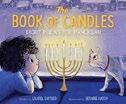
One family’s observation of Hanukkah, told through eight poems, one for each night. This unusually realistic and detailed window into a contemporary family’s celebration provides a mirror for Jewish children and a window for readers of other backgrounds. In addition to engaging in commonly depicted traditions like lighting menorahs and sitting down to a meal with extended family, these characters order pizza, untangle decorations, and use a hair dryer to melt last year’s cakedon wax off the menorah. And when an unexpected flat tire delays them, they make do by sticking candles into a banana balanced on the car hood. (The author’s note dubs this a “bananukkiah.”) Notably, overt giftgiving isn’t depicted, which will be especially appreciated by the many Jewish families whose traditions deemphasize presents or don’t include them at all. Most of Snyder’s poems are told in second person; both the art and the sweetly simple language suggest that the narrator is the youngest child. Accordingly, the verse focuses on the child’s observations and sensory experiences. Each poem is followed by an informational sidebar covering a loosely related topic. These eschew basic facts and vocabulary for richer explorations such as rabbinic discourse and what time to light Hanukkah candles on Shabbat. Hatch’s cozy illustrations lovingly render scenes of home and family with the feel of handdrawn oil
pastel. The main characters are lightskinned and darkhaired.
Like a menorah shining in the window, a true Hanukkah treat. (author’s note) (Picture book. 4-8)
Snyder, Marker | Holiday House (304 pp.) $22.99 | September 2, 2025 | 9780823457021

A humanloving vampire wrestles with friendship, identity, and bodily changes when he loses his baby fangs. For most vampires, fangs define who they are, but Ivan secretly hopes he’ll keep his harmless baby fangs forever, so he can stay with his human friends at Day School, the only place where he feels like he belongs. Around other vampires, Ivan never knows what to say or how to act. But on the first day of eighth grade, Ivan’s worst nightmare becomes a reality. As his adult fangs start growing in, Ivan struggles to hide them from his family, who don’t fully accept his attachment to humans, and his human friends, who must never learn he’s a vampire. Every day, he fights against his new sensitivity to blood, but he keeps fainting in class, and for reasons he doesn’t understand, he’s drawn to the heartbeat of new kid Damien, his lab partner in biology class. Snyder effectively uses color to create contrast between the human and vampire worlds, casting humans in sunny yellows (with skin tones in a spectrum of grays) and vampires in moody blues, which emphasize Ivan’s feelings. Although Ivan’s love for humans is taboo, his attraction to
another boy creates no conflict. The worldbuilding (particularly the divide between vampires and humans) lacks depth and consistency, but this background weakness doesn’t overshadow the sweet and relevant comingofage story. A sincere and insightful story of personal growth and acceptance. (Graphic paranormal. 9-12)
Soloy, Lauren | Tundra Books (72 pp.)
$19.99 | October 7, 2025 | 9781774887202
Series: The Hidden World of Gnomes
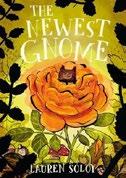
The characters introduced in The Hidden World of Gnomes (2023) embrace a new addition, who makes an exciting selfdiscovery. A mushroom circle forms, and Grolly Maru (who uses they /them pronouns) emerges through the parted moss. The gnomes of the Pocket, a warm and welcoming bunch, take it upon themselves to teach the newcomer about their love of their natural world and to explain their individual jobs. Cob Tiggy shows Grolly Maru some of his favorite hats, from a raspberry to a dandelion puff. Merry Pip schools Grolly Maru in animal sounds and “animal quiets.” When Grolly Maru’s belly rumbles, they join Bonnie Plum in baking a fruit treat and later get a lesson in “gnome numbers” from Puckle Swift. The gnomes stop by Mrs. Spider’s place as the arachnid takes a page out of E.B. White’s Charlotte’s Web and spins an inspiring message: “Life is as mysterious as ever!” A gnome named Minoletta delivers a day’s end paean to the oneness of the world. And finally, as the new inductee stands up to share their thoughts, they find themselves waxing rhapsodic about the moon— turns out Grolly Maru is a poet! Beginning readers might trip over the lengthier passages, but for the most part, this is another sweet immersion in a whimsical world populated by
endearing residents who vary in skin tone. Soloy’s lovely, intricate vignettes, rendered in muted watercolors, brim with warmth. Young naturalists will be utterly absorbed by the tiny delights here. (Picture book. 3-7)
Spiotto, Joey | Graphix/Scholastic (128 pp.)
$24.99 | September 2, 2025 | 9781546169468

An uncertain amphibian receives an education.
Max’s habitat is under attack, and as his story begins, the little axolotl is swept up to safety, taken to the Aquarium of the Bay, and placed into an enclosure with other aquatic animals including turtles, fish, snails, and shrimp. They have a school (get it?), and Max begins his marine education, nervously trying to fit in. While playing, he accidentally kicks a ball into a spooky cave, where a water monster is rumored to keep all who enter from leaving. Though ominoussounding, the creature turns out to simply be another shy axolotl. This older, wiser amphibian educates Max on the mythical Aztec heritage of their species, and the two find kinship while educating fellow aquarium dwellers about what makes axolotls unique. Bubble eyed Max is adorable, but long stretches of dialogueheavy panels with little variation in page composition or layout make for a tedious reading experience, though Max’s foray into the inky dark cave and a stylized recounting of Aztec legend offer greater visual interest. The premise—a newcomer encountering anxieties as he attempts to adapt to a strange environment—is relatable, and the axolotl facts will intrigue animal lovers, but on the whole, the narrative drags. Cute but clunky. (author’s note, axolotl facts) (Graphic fiction. 6-9)
Springer, Lisa | Harper/HarperCollins (256 pp.) $18.99 | July 29, 2025 | 9780063288782
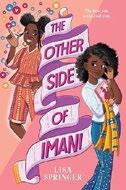
Eighth grader Imani James loves all things fashion and aspires to be a designer one day, drawing most of her inspiration from her family’s Caribbean and West African heritage.
While her brother can easily make friends with anyone he speaks to, and her sister is an outspoken activist, Imani is shy and has a harder time talking to people. After her family moves from South Los Angeles to Brooklyn to explore new business opportunities for their food truck, the Calypso Grill, Imani is excited to be in the “fashion capital of the world.” She’s even more excited to learn that her new school will be hosting a fashion competition. The grand prize is a scholarship to her dream school, DeKalb Art and Design High School. But after someone steals her contest design and she’s accused of plagiarism, Imani goes undercover with a secret alias on social media to take on the person who stole her work. She also uses her account to share new designs, messages of positivity, and insights on cultural inspiration versus appropriation. The story moves at a brisk pace, immersing readers in Imani’s colorful world of bold designs, cultural pride (her father is from Barbados, and her mother is from Ghana), and artistic expression. It’s a heartfelt exploration of identity, creativity, and the courage to be seen and to stand up for yourself. A creative, culturally rich look at self-expression. (author’s note, glossary) (Fiction. 8-12)
Steve and Maggie | Illus. by Sr. Sánchez Candlewick Entertainment (32 pp.) | $14.99 September 2, 2025 | 9781536246650
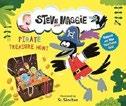
A story of found treasure, based on the popular YouTube series for children.
Steve and his magpie pal, Maggie, are headed to a pirate party. Both sport pirate hats, and they have a map to guide them on their journey. The map offers a clue, presented in the form of a rhyming challenge: “Look along your street. What’s got leaves up high and roots at your feet?” Gazing up at a nearby tree, they spot a piece of paper in its branches—the next clue! As the intrepid pair continue on their way, they uncover tantalizing new hints at various locations, among them an aquarium, a statue, the park, and their ultimate destination—the pirate party ship, where, according to the map’s “X spot,” they discover a treasure hoard. This jolly tale, first published in the U.K., provides plenty of entertaining diversion. The puzzlelike format not only adds an engaging element to Steve and Maggie’s adventure but also, importantly, heightens readers’ learning— by enhancing criticalthinking skills, spatial and directional awareness, and vocabulary development. The cartoonish digital illustrations capture the expressive protagonists’ fastpaced exploits and incorporate lots of strategically placed boldfaced type into the artwork for dramatic effect. Steve is pale skinned, like his YouTube counterpart.
Ahoy, mateys! A cheery tale for pirate fans. (Picture book. 4-7)
Like a menorah shining in the window, a true Hanukkah treat.
THE BOOK OF CANDLES
SPEAK YOUR HEART
Stott, Apryl | Beach Lane/Simon & Schuster (40 pp.) | $19.99 | September 16, 2025 9781665921664 | Series: Coco and Bear

A young girl and her ursine pal learn to listen. Brownskinned, curlyhaired Coco and Bear have been BFFs their whole life. Today, Bear proposes building a snow castle; Coco says she loves the idea of a snow fort. Bear corrects her (“Well, actually, I said castle ”), but Coco doesn’t listen and enlists their friends’ assistance in constructing her fort. Bear offers suggestions, but Coco tunes him out. Frustrated at not being heard, Bear explodes (“Listen to me, Coco!”). Quilber the porcupine urges the friends to take a timeout, but Bear’s too steamed to pay attention and storms off. Baby Deer has a hearttoheart with Bear, letting him vent but telling him that he needs to practice his own listening skills—she points out that he refused to hear Quilber out. Meanwhile, Quilber tells Coco that her bossiness has alienated the others. Eventually, Bear and Coco apologize to each other—and to Quilber and Baby Deer—and everyone devises a useful communication strategy before resuming their snow play. Stott’s thoughtprovoking story about friendship conveys a fine message about listening patiently and respectfully. The protagonists are well realized, with relatable flaws, and learn and grow from their mistakes. Stott’s graceful illustrations, rendered in watercolor paint
and digital ink, portray endearing characters who value each other.
A sweet, well-told story with important lessons on navigating friendship tensions. (Picture book. 4-7)
Street, Lynn | Illus. by
Anne Hunter Margaret Quinlin
Books/Peachtree (48 pp.) $18.99 | August 5, 2025 | 9781682636046

It takes an avian village to raise an oak tree.
The problem? Acorns must travel out of the shadows of the oaks that produce them if they are to thrive, but they’re too heavy for the wind to blow them away. Enter the blue jays, for whom acorns are both a treat and pre winter fuel. Street explains how the “blue crew” carry so many at once (“a few stowed in the throat pocket… / one in the mouth, another in the beak”). Other animals are hungry, too, so “the jays must work quickly,” gathering acorns and stashing them for later. The birds search for the buried acorns under snow, and the ones they miss sprout in spring. Nestlings eat insects; summer passes. Soon, “a scold of jays” begins collecting and burying acorns again. And over time, a new forest of oaks thrives. Active verbs ( pries , hammers) and elegant imagery (“a flash of sapphire in the sun— blue white”) add resonance. A half dozen final pages explain the science behind the mutualism of oaks and blue jays, both keystone species, and describe several jay species. Hunter’s
soft and subtle pen, ink, and colored pencil illustrations, both close ups and from a distance, and from high and low perspectives alike, are as lyrical and lovely as the text. An eloquently told story of symbiosis. (bibliography) (Informational picture book. 4-8)
Sullivan, Annie | Illus. by Paula J. Becker
Random House Studio (40 pp.) | $18.99
August 19, 2025 | 9780593709603
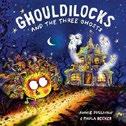
A familiar tale gets a spooky twist. While playing in the woods, Ghouldilocks, a wide eyed, wildhaired, yellow skinned creature, discovers an abandoned mansion. Inside she finds three chairs of differing degrees of hardness, three bowls of—what else?—“ghoulash” of varying temperatures, and three beds of disparate sizes. The tale matches “Goldilocks and the Three Bears” beat for beat as our protagonist sits in every chair and breaks the littlest one, samples all the ghoulash and devours the smallest bowl’s contents, then falls asleep in the smallest bed. When the mansion’s ghostly residents return, they discover Ghouldilocks still slumbering. Mistaking her for a mummy, they’re terrified, and the hubbub awakens the interloper, who, in turn, becomes scared of them. Everyone scrambles for the door. Outdoors, the ghosts realize their error and explain that they’re friendly but that they believed Ghouldilocks wanted their sheets for her wrapping. Mistaken identities are now resolved—with a couple of funny visual and textual puns thrown in—and new relationships are forged. Ghouldilocks is invited to stay, learns to cook ghoulash, becomes besties with Baby Ghost, and promises never to enter anyone’s house uninvited. Children who enjoy the source material will
giggle over this humorous take, which emphasizes friendship and goofy antics rather than scares; they’ll pore over the comedically energetic cartoon illustrations and appreciate the satisfying ending. An entertainingly ghostly story with a decidedly gentle tone. (Picture book. 4-8)
Tabor, Corey R. | Illus. by Dalton Webb Greenwillow Books (32 pp.) | $12.99 September 2, 2025 | 9780063434912

A sled race spirals out of control.
It’s race day for a trio of Ice Age sledders, and while competition between Wolf and Otto the great auk heats up an otherwise frigid morning, Wally Mammoth is just happy to have been invited. Clad in a fuzzy pink turtleneck and giddy with gladness to slalom with pals, the contented Wally truly believes it’s not about who wins or loses. The threesome take off as the referee waves a green flag. But competitive ambitions soon prove ruinous as unwieldy speed sends Wolf and Otto swerving. In the crash’s slapstick fallout, the two are swallowed by a steadily speeding, ever growing snowball. Wally’s now in the lead, and as Otto and Wolf tumble down the hill, they pepper their friend with requests to share the victory spoils (“If you win, can I hold the trophy?” “If you win, can I have a cupcake?”). The snowball gains momentum, closing in until the pachyderm, too, is enveloped with a “SHOOOP.” All three friends roll over the finish line together, tying for gold and learning a valuable lesson about pride along the way. Tabor’s text is accessible for new readers—deftly balancing narrative tension with requisite simplicity— and Wally proves a rootfor able foil
to the other two competitive compatriots. Webb’s art appealingly complements the silliness of the trio’s plight, rendering characters with a delightful cartoonish expressiveness. Frothy fun. (Early reader. 5-7)
Temple, Jol & Kate Temple | Illus. by Rebel Challenger | Scholastic (32 pp.) | $15.99 September 16, 2025 | 9781546159582
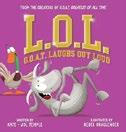
The creators of G.O.A.T. Greatest of All Time (2024) return to wring humor out of yet another initialism. Reading a copy of G.O.A.T., Goat exclaims, “L.O.L.!” Literal minded Duck objects: Goat isn’t actually laughing, much less out loud. Duck proposes many other interpretations: L.O.L. could mean “Lizards on Logs,” “Lobsters Overheating Lasagna,” “Lemurs Ordering Lattes,” “Lambs Opening Locks,” “Lucky Orangutan Lamp,” and a half dozen other examples—each more strained than the last and none of them the slightest bit likely to elicit a chuckle, much less an audible laugh from either Goat or readers. Finally, having squashed every bit of Goat’s joy, Duck spontaneously bids farewell to the unamused Goat: “Later, Old Lad.” For whatever reason (relief that Duck is finally giving up?), this makes Goat bust a belly laugh—and unfortunately inspires a few Last Outrageous Lines: “Look Out, Lunkheads!” “Leap Out Left!” Challenger gallantly makes the best of this situation, with more
colorful, wacky, goggle eyed animals striking exaggerated poses, but scenes of Goat gagging over an unappetizing bowl of seeds (“Lumpy Old Lentils”) or a big cat reclining on a throne and eating grapes (“Lion of Luxury”) are unlikely to tickle most kids’ funny bones. Lamentably Overdone Laughs. (Picture book. 4-8)
Thurlow, Setsuko & Kathy Lowinger Illus. by Michelle Theodore Annick Press (72 pp.) | $22.99 August 5, 2025 | 9781773219851

An activist and survivor of the bomb that devastated Hiroshima looks back on her youth—and ahead to the work still to be done.
Born into a privileged samurai family, Setsuko was an honors student and the treasured youngest of seven, but her idyllic childhood came to an end on December 8, 1941, after Japan attacked Pearl Harbor. Years later, Setsuko, now an eighth grader, and several other girls from her school were trained to decode messages from the front lines. On August 6, 1945, she had just arrived at the decoding office for her first day of work when a blinding white flash appeared in the window. When she awoke, she was buried under the building, yet she had survived; many others were not as fortunate. As time went by, angered by what had happened to her—and by
A moving account of the impact of war—and an encouraging call to action.
the U.S. government’s refusal to apologize—she began raising awareness of the bombings and fighting for bans on nuclear weapons. Written in short chapters, Thurlow’s firsthand account is interspersed with maps, drawings, photos, and information on the war, daily life in Japan at the time, the atomic bombs, and more. This compelling tale reveals often untold truths, highlighting experiences that the U.S. sought to conceal and making a tragic event feel deeply personal. Thurlow and co author Lowinger leave readers with words of hope as they suggest steps they can take to help achieve peace. Final art not seen.
A moving and nuanced account of the impact of war—and an encouraging call to action. (timeline, sources, image credits) (Biography. 11-14)
André: André Leon Talley―A Fabulously Fashionable Fairy Tale
Weatherford, Carole Boston & Rob Sanders Illus. by Lamont O’Neal | Henry Holt (56 pp.) $19.99 | November 11, 2025 | 9781250887283
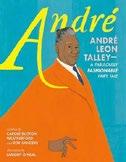
“My story is a fairy tale.” So opens this empowering biography of trailblazing style maker André Leon Talley (1948 2022), the first Black man to serve as Vogue ’s editoratlarge, creative director, and fashion news director. But this fantasy wasn’t born from lucky happenstance or serendipitous privilege; Talley’s talent and tenacity conjured the magic that colors his story. Growing up in Jim Crow–era North Carolina, Talley endured racism, homophobia, and sexual abuse, all the while shrouded in his grandmother’s unconditional love. Fashion offered escape, and Talley took it, doggedly pursuing the work that would eventually land him an (unpaid) gig under Diana Vreeland, former editor for Vogue. Talley rose to prominence, setting trends, challenging
Roughs out a real-life road map for readers who see themselves in the hero.
ANDRÉ
convention, and standing tall against hatred; as he put it, he “scorched the earth” with his singular vision, forever transforming the fashion industry with gifts cultivated under his grandmother’s care. Weatherford and Sanders’ text, interspersed with Talley’s own words, renders a detailed portrait of the legendary figure, offering extensive proof of his initiative and resilience. The beauty of Blackness is named explicitly throughout, but Talley’s sexual identity is broached only obliquely; while the subtlety may elude younger readers, this ambiguity will allow others to recognize their own experiences. O’Neal cleverly evokes sewing patterns of yore, a visual boon. And while the authors and the illustrator pay homage to similarly magical myths—among them Cinderella and Little Red Riding Hood—the narrative roughs out a reallife road map for readers who see themselves in the hero.
Affirming and important. (authors’ note, information on people referenced, glossary, note about HIV/AIDS, sources for quotes, bibliography) (Picture-book biography. 9-12)
Wheeler, Kate | Oni Press (280 pp.) | $14.99 paper | August 19, 2025 | 9781637158050
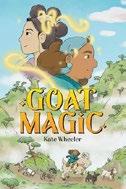
After Princess Alyannu ji Helnassa and goatherd Trill Tenuto cross paths, neither the girls nor their kingdom of Capeya will ever be the same.
Following an attack while she was traveling with her mother, Alya
discovers that she’s been placed under a curse: At sunrise, she turns into a black goat, and at sundown, she returns to her human body. Alya is drugged and abducted but manages to escape from her captors. By good fortune, Trill’s magic power is the ability to communicate with goats. Alya, in her goat form, hides from her assailants among Trill’s herd. The girls get off to a rocky start—sheltered Alya has some high handed ways that make Trill bristle—but ultimately, Trill agrees to help the princess. The girls must move quickly, however: AuntU, a friend of Trill’s mother whom they seek out for help, informs them that if they don’t destroy the talisman used to place the curse within a month, Alya will remain a goat forever. This fantasy story reads like a classic fairy tale and explores themes of trust in oneself and greater awareness of others. The friendship and love that blossom between Alya and Trill feel natural and endearing. The cartoonlike illustrations employ warm colors that match the tone of the story. Wheeler’s worldbuilding emerges organically from interactions between the characters, sustaining a fast pace and avoiding lengthy explanations. Alya has tan skin, and Trill has medium brown skin. Thrilling, sweet, and so much fun. (map, bonus content) (Graphic fantasy. 8-12)

For more great graphic fiction, visit Kirkus online.
Tulip’s Mess
Wilder, Anden | Knopf (40 pp.) | $18.99
October 28, 2025 | 9780593704769

Small clutter adds up over time.
Tulip, a pale skinned, darkhaired child, has a knack for creating mess. What starts with an errant candy wrapper or two and a loose sock quickly becomes utter chaos. Her “little Mess,” personified as a swirling cloud of gray scribbles with eyes and a mouth, feeds off the constant trail of food, pencil shavings, and dirty clothes. The Mess grows bigger as time passes and soon becomes unmanageable. When Tulip’s favorite plush cat, Ta, gets lost in the overwhelming disarray, she dives in to retrieve her friend, emerging with Ta—and the realization that cleanliness and order are important. Writing in short, staccato sentences, Wilder avoids the preachiness of similar tales, acknowledging how easy it can be to let mess take over one’s life but reassuring readers that, step by step, the chaos can be conquered. Happily, she makes clear that a little messiness is OK; the tale concludes with an image of Tulip drawing while smiling down at a beaming, much smaller Mess. Wilder’s expressive gouache illustrations, many set against stark white backgrounds, use scale and perspective to convey the Mess’ increasingly intrusive presence. A satisfying primer on staying organized that, refreshingly, gives kids the space to still be themselves. (Picture book. 4-7)
Worsley, Justin | Flamingo Books (32 pp.)
$14.99 | September 16, 2025 | 9780593695043

An artistic dog gets his day. This book is about dog poop. Nothing more, nothing less. Well, maybe a bit more, if you view it in the right light. Henry is a tan, floppy eared pup who’s trotting through an urban park wearing a jaunty red collar and a grin. He appreciates art, gazing upon a Keith Haring–style mural, and then admiring a garden of abstract sculptures. One sculpture is wavy and brown, foreshadowing the book’s premise: Henry makes sculptures of his own—his droppings. Readers may be a bit unenthused by Henry’s art; so is his owner, who quickly tosses his waste into the trash. But the park’s bugs know better. A coterie of ladybugs, ants, snails, and pill bugs transport Henry’s efforts to the surprisingly cosmopolitan, bustling Bug Hotel, where they can admire them further. The book raises humorous questions that it declines to answer: How can one consider poop sculpted? Is this artwork preserved in its current state or permitted to decay naturally? But the story will find a ready audience among those readers with a love of potty humor (and they are many). Beyond the gross out factor, Henry’s happy go lucky energy calls to mind Harry the Dirty Dog and that classic canine Clifford, while Worsley’s expressive watercolors, painted broadly and simply, are
A visually appealing and carefully told tale that will linger.
perfectly lovely. Henry’s owner is tan skinned, bespectacled, and bald. Scatological humor and eye-catching images make for a delightfully oddball tale. (Picture book. 3-7)
Youngwolf, SD | Illus. by Shonto Begay Lee & Low Books (32 pp.) | $19.95 September 2, 2025 | 9781643790848
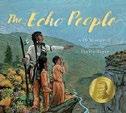
Two Indigenous cousins learn valuable lessons while visiting their grandfather. After preparing a blessing, Grandfather, the village chief, tells Aiyanna and Little Wolf that today they’ll meet the Echo People, who live in the river gorge and who have much to teach the children. He takes each of them to separate areas of the gorge and instructs them to introduce themselves to the Echo People, who can’t be seen. Impatient Little Wolf cries out, and his frustrated words (“You are just repeating everything that I say!” “I feel like a fool!”) are echoed back. “Those Echo People are terrible people,” he complains to Grandfather. But when the two check on gentle Aiyanna, she’s had an entirely different experience; her words of love and tenderness reverberate back to her, and she tells Grandfather how kind the Echo People are. True to traditional Indigenous teachings, Grandfather shares his wisdom about life (“Your actions, your words, even your thoughts all come back to you”) but lets his grandchildren make meaning from their experiences. Begay’s (Navajo Nation) magnificent, earthtoned illustrations establish a dreamy setting, supporting each word of Youngwolf’s (Tsalagiyi Nvdagi) inviting story. Small brush strokes enhance the action, suggesting clouds moving across the sky or smoke rising from the fire as Grandfather gives his blessing.
A visually appealing and carefully told tale that will linger. (author’s note) (Picture book. 5-8)

IN HER 1986 essay, “Through the One-Way Mirror,”
Margaret Atwood wrote that people in the United States “are rarely aware that they are even being watched, much less by the Canadians” and that “Americans don’t really see Canadians as foreigners.” As a U.S. citizen who’s been lucky enough to travel overland from Sault Ste. Marie, Ontario, to Yellowknife, Northwest Territories, and to live in areas as diverse as Gjoa Haven, Nunavut, and Vancouver, British Columbia, I can attest to Atwood’s point—and to the greater awareness that Canadians have of the States.
One way to learn more about the rich culture and history of Canada is to read Canadian books, many of which emerge from a publishing ecosystem that’s
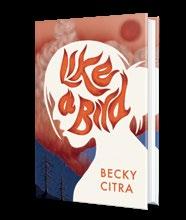
designed to preserve artistic integrity and bold experimentation.
I recently emailed some prominent Canadian publishers to get their perspective on the field there.
David Caron, co-publisher of Annick Press, a longestablished independent press for young readers, explains that relying solely on commercial revenue can make publishers “unambitious, publishing books that don’t stray too far from books that have proven to sell.” Robust public funding—from provincial and national sources such as the Ontario Arts Council, the Canada Book Fund, and the Canada Council for the Arts—allows Canadian publishers to support a book because they “believe strongly in its potential, without being hamstrung by the

overwhelming fear of not selling enough.” Caron argues that this is why “Canada has produced a wealth of truly original, sought-after books that have captured the imagination of both Canada and the world.”
Peter Phillips, a YA editor at Tundra Book Group, writes that “our Canadian middle grade and young adult fiction lists have significantly more titles from exciting new Indigenous creators. These books have a much larger presence here in Canada than in the United States…which is fantastic and helps promote great diverse voices.”
As we think about global literature and exposing young readers to diverse viewpoints, let’s include vibrant, worldclass Canadian literature like the following 2025 releases— just a small sampling of the wealth available.
Like a Bird by Becky Citra (March 4), from feministoriented Second Story Press, is a beautifully written story about a teen coping with the


loss of a parent, adult responsibilities, and wildfire threats in rural British Columbia. Readers who love character-driven contemporary stories will savor this one.
Romance fans will adore Jackie Khalilieh’s emotionally rich sophomore novel, You Started It (May 20), from Tundra Books, Canada’s oldest Englishlanguage young readers’ publisher. A fake-dating scheme between Jamie, who’s white and Palestinian Canadian, and Axel, who’s Lebanese Canadian, leads to sweet true love.
From Inhabit Media, an Inuit-owned independent publisher that amplifies Arctic voices, we have The Haunted Blizzard (June 2), a spooky, atmospheric graphic novel by Inuk author Aviaq Johnston with dramatic artwork by Athena Gubbe. Inu, home alone after bad weather closes school early, wonders what lurks in the shadows.
Ours To Tell: Reclaiming Indigenous Stories (April 29) by Eldon Yellowhorn (Piikani Nation) and Kathy Lowinger comes from Annick, and presents engaging, broadranging profiles of Indigenous people, highlighting historical and contemporary heritage through rich visuals and accessible text.
Laura Simeon is a young readers’ editor.
In this duology opener co-authored by sisters, a brave young woman must challenge a tyrant to obtain her freedom.
Deina, an indentured servant from the House of Hades, can sever the body from the soul. It’s a useful skill to help the dying enter the Underworld, and performing these services subtracts years from her 40-year servitude. However, Deina dreams of buying her freedom and that of her best friend, Chryse. In this reimagined Orphic myth, Orpheus arrives in Iolkos with an offer to members of the House of Hades who passed his trials: Enter the Underworld and bring
back his wife, Eurydice, in exchange for freedom and gold. Deina, who accepts the challenge, is ready to face her fate, but far from being a sweet, tortured musician, Orpheus is self-obsessed and cruel. In this brutal, patriarchal ancient Greek world, Deina survives genderbased harassment and injustices. Despite it all, she proves her resilience under pressure. In the Underworld, she encounters a mysterious m an who helps her in her tasks, little suspecting that she’ll discover much more about him—and herself—while she’s there. Even with the familiar Greek mythological storytelling trappings,
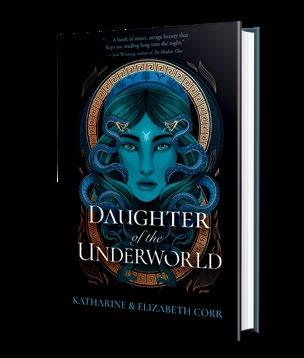
Corr, Katharine & Elizabeth Corr | Candlewick 448 pp. | $19.99 | September 2, 2025
9781536244533 | Series: House of Shadows, 1
the worldbuilding is unique, featuring the epic qualities of a heroine’s journey and many unpredictable reveals. Misogyny and power plays permeate the storyline, contributing to themes that are both dark and
empowering. The characters reflect the diversity of the regions of Greece. Strong character development and jaw-dropping reveals make this intense, feminist fantasy a mustread. (authors’ note) (Fantasy. 14-18)
Arnold, Marie | Little, Brown (304 pp.)
$19.99 | September 9, 2025 | 9780316582872

After foreseeing a boy’s death, a 15-year-old cellist tries to alter destiny.
Laveau “Lala” Russell is tired of racism. She lives in Davey, Texas, a sundown town with a hard line separating the Black south side residents from the white people on the north side. The two groups have maintained a veneer of tolerance—until plans for an affordable housing development heighten long-simmering racial tensions. Lala is also reminded of Davey’s bigotry at her prestigious music school, where Confederate flags line the display cases, and she’s one of just six Black students in her program. Rather than protest or join the school’s Black Alliance, Lala focuses on getting into Juilliard. But her detachment is rattled when she has a Flash, a vision of the future—an ability that runs in her family. She sees an unarmed Black boy fatally shot by a white man. Before Lala can warn the victim, her grandma has a Flash in which she sees the teenager’s murder sparking nationwide change. Suddenly facing a moral dilemma, Lala must reckon with the personal sacrifices that pave the road to collective justice. Anchored by a compelling lead, Arnold’s novel captures the exhaustion of living with everyday racism. Lala’s character arc is filled with compassion, and the first-person narrative deftly wields aspects of speculative fiction to show how history informs the present. The author approaches other themes,
like interracial dating and colorism, with incisive honesty.
A profound reminder that social revolutions are never bloodless or linear victories. (Fiction. 12-17)
Arnot, Zanni L. | Scholastic (304 pp.) $18.99 | September 2, 2025 | 9781546138440

Two teens in Murwillumbah, Australia, struggle to find their footing in life and cope with the long shadow cast by the death of the mother of one of them.
Ambitious
actor Vinnie has her heart set on moving to New York with her friend Lilah and attending Juilliard. Focusing on this specific future helps her avoid thinking about her mother, Aggie, whose death by suicide after a multiple sclerosis diagnosis devasted Vinnie and her dad, as well as her best friend, Roo, and his mother, who was a close friend of Aggie’s. Roo, a talented photographer who’s secretly in love with Vinnie, dropped out of his final year of school for a photography apprenticeship that wasn’t the learning opportunity he anticipated, and he constantly feels he’s disappointing his single mum, whom he wants to help financially. In a compelling, introspective dual narrative that alternates between Vinnie’s and Roo’s first-person perspectives, Vinnie’s plans go awry, and Roo is compelled to make decisions about what he’d like to do.
The story, which is split into three
parts, follows Vinnie and Roo on a vividly imagined road trip through New South Wales in Vinnie’s mum’s old turquoise Kombi Volkswagen van, setting the stage for their quirky, poignant romance. Vinnie and Roo present white, and there’s some diversity in ethnicity and sexual orientation among the cast members. An emotionally rich meditation on people finding their way. (author’s note) (Fiction. 14-18)
Kirkus Star
Åstot, Moa Backe | Trans. by Agnes Broomé | Levine Querido (192 pp.)
$19.99 | October 14, 2025 | 9781646145751

Michael L. Printz Honoree Åstot (Sámi) returns with a sophomore novel that explores grief, identity, and life in the digital age. In this translated title from Sweden, Vilda is missing her best friend, Alma, who’s off on a summer holiday. Shy, artistic Vilda, 13, feels vulnerable: Her body’s changing, and her sense of self is in flux. Her mom is Sámi, and her dad is Swedish. Longing to connect with her Sámi heritage, Vilda persuades Áddjá, her beloved maternal grandfather, to teach her to speak Sámi, but then he dies unexpectedly. At his funeral, a bereft Vilda notices handsome Sámi pallbearer Samuel, who’s a few years older than she is. She’s thoroughly smitten—plus, a Sámi boyfriend could help validate her Indigenous identity, which her Swedish classmates have questioned. Feeling emboldened, she posts a photo of herself wearing her late áhkko’s Sámi wedding dress. Samuel comments, and she’s thrilled when they start texting. Vilda is also excited to garner flattering likes and comments from people other than Alma and her paternal grandfather. But there’s
discomfort too: “To think that a piece of clothing and some makeup can make that kind of difference.”
Watching mercurial Vilda figure out who she wants to be and how to get there is a delight that’s bolstered by Broomé’s sparkling translation. From emotional depths to a healing, triumphant resolution, Vilda is an Everygirl for our time. Limns the volatile peaks and valleys and emotional quicksand of adolescence with compassion and wry humor. (Fiction. 12-18)
Azar, Kiera | Storytide/HarperCollins (464 pp.) | $15.99 | September 2, 2025 9780063427792 | Series: Thorn Season, 1
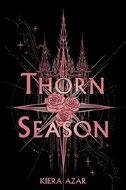
In a kingdom where wielding magic is treason, a girl must conceal her dangerous truth—or risk her life.
Lady Alissa Paine, the olive-brownskinned daughter of the ruler of the province of Vereen, lives in the kingdom of Daradon, where Wholeborns (those without magic) hunt Wielders (those born with powerful, sentient forces called specters). The Capewell family is infamous for producing those Wholeborns known as Hunters, though Alissa’s father—whose mother was a Capewell—is protected by his title from having to go after Wielders himself. Few know Alissa’s deadly secret: She’s a Wielder, too. Tradition demands she swear loyalty to the crown at the end of this year’s Rose Season, her 18th. Her father, fearful that her identity will be discovered, encourages her to retreat from the social events of the season. Despite this, Alissa is kidnapped by Wielders and thrust into the center of a political game—one with high stakes that could cost her everything. Azar’s trilogy opener is a deft blend of romantic tension, political
intrigue, and magical suspense. The writing is lyrical and emotionally evocative, exploring themes of identity, persecution, and the fine line between love and betrayal. The pace quickens after a quiet start, and Azar deftly delivers a story set in a multiracial world that feels both intimate and epic. Alissa’s journey is heart-wrenching and complex, particularly as she navigates relationships. A gripping, gorgeously written debut that refuses to play it safe. (map) (Fantasy. 14-18)
Kirkus Star
Azzam, Sheryl | DCB Young Readers (240 pp.) | $16.95 paper October 18, 2025 | 9781770868069
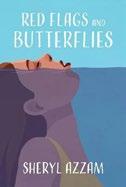
Balancing multiple expectations is never easy—and sometimes doing it all feels impossible. Lexie, a gifted Canadian 10th grader, is caught in a whirlwind of competing demands: striving for a sports scholarship to prestigious Sunridge High’s Fine Arts and Music program, grieving a beloved mentor, juggling swim team obligations, and navigating her parents’ post-divorce tension. While her mother and friends are supportive, her father—who’s charming but controlling—undermines her plans. He launches a renovation business and demands help from Lexie and her brother; he gets Lexie a dog she never asked for as a birthday gift and then complains she doesn’t care for it when she’s at her mom’s house. Lexie, who’s volunteering at a retirement home, dating lifeguard boyfriend Rhys, and dealing with anxiety (with help from a therapist), feels the pressure building until something has to give. Told with clear-eyed emotional insight and a sharp ear for teen voices, Azzam’s posthumously published novel gently but powerfully explores the costs of people-pleasing, the subtleties of
emotional manipulation, and the strength required to set boundaries. Lexie’s journey toward recognizing healthy love and support is as rewarding as it is resonant. The lyrical prose, tight pacing, and strong supporting cast shine, and amid the emotional tension, many scenes show warmth and nurturing from those around Lexie. Most characters are cued white. A tender, heartfelt, and intelligent coming-of-age story that celebrates quiet strength and trusting your instincts. (editor’s note, relationship red flags, resource) (Fiction. 12-18)
Cerilli, Matteo L. | Tundra Books (400 pp.) $19.99 | September 2, 2025 | 9781774882337
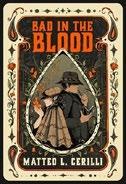
A pair of estranged stepsiblings become unwillingly entangled in a mystery that could destroy their family’s reputation and future.
Three hundred people died in the Summer Fayre tragedy, when Hàzell Stregoni succumbed to the overwhelming madness of Faerie Disorder. The victims included Hàzell’s mortal husband, Senan Maxim. Hàzell and Senan left behind two children, both just 11 cycles old, who miraculously survived the blast. One septennial later, dark-haired Hawthorne Stregoni, who has “tanned skin,” and brown-skinned, green-eyed Gristle Senan Maxim Junior can’t escape their late parents’ shadows. Except for when she’s sneaking out with her girlfriend, Hawthorne devotes herself to suppressing her fey powers so she can have a normal life. Gristle stands beside his aunt by supporting her political campaign and taking over Maxim & Maxim Private Detectives. When Hawthorne loses control at a fey-owned nightclub, the owner threatens to expose the incident unless Gristle agrees to help them uncover the truth about some suspicious activity.
Gristle and Hawthorne have no choice but to investigate. This noir-inspired mystery unfolds in vivid and atmospheric prose from the perspectives of the two complex and dynamic leads. News articles, diary entries, and other evidence interspersed between chapters adds another lens for understanding the setting, history, and intricately intertwined political conflict. Cerilli’s use of Faerie Disorder as an extended metaphor for neurodivergence is rich with nuance, and the world is infused with queerness and racial diversity. A cinematic and enthralling flare of fey magic. (map, family tree, author’s note) (Paranormal mystery. 14-18)
Cottingham, Kayla | Delacorte (416 pp.) $19.99 | September 23, 2025 | 9780593814017

A failed mage who’s been dumped by his boyfriend must find a magical cure-all.
In the last six months, 17-yearold Kieran Pelumbra has broken his family curse, moved in with his sister and her girlfriend, and begun dating a handsome apprentice librarian named Ash Bartelle. Everything should be coming up roses—but for some reason, Ash is avoiding him. When Ash asks for some space, Kieran writes some deeply angsty poetry, in the process accidentally afflicting his erstwhile love with a curse. Now, in a manifestation of his feelings, Kieran is literally invisible to Ash. Aghast (and terrified of the Witches’ Council), Kieran and friends travel by aeroship on a quest for a panacea to break Ash’s curse. Once Kieran acquires the cure, Ash will love him again, right? With the help of Sebastian Feng, a gorgeous, bisexual 18-year-old, Kieran races against an evil CEO who’ll happily kill them all if he gets to the panacea first. Gloomy and businesslike, Sebastian is like catnip to Kieran, a talkative boy
who wears ruffles and sweater vests. With so much going on—constant attempted murder, lustful efforts at curse alleviation, lots of side quests— it’s impressive that Kieran has time to discover his magical talent. Kieran is cued white, Ash has “warm brown skin” and “tight curls,” and Sebastian is from a fantasy analogue to East Asia. A trope-packed queer romance with a satisfyingly happy ending. (map) (Fantasy. 14-18)
D’Amato, Jamie | Wednesday Books (336 pp.)
$20 | August 26, 2025 | 9781250321206

As if being a depressed college student weren’t hard enough, one day Brennan wakes up as a newly turned vampire. After a suicide attempt in his freshman year, white 19-year-old Brennan did a lot of therapy and is now back at Sturbridge University. Becoming a vampire wasn’t part of the plan, but the self-sufficiency he honed in childhood still runs strong, so he tries to figure out what this new life means and how to obtain what he’ll need—namely, blood. With no interest in harming anyone, he steals donated blood, only to be caught in the act of drinking it by Cole, the cute white student library worker who’s known for his skills in comforting others. Surprisingly, Cole agrees to keep Brennan’s secret and even wants to help him. Their flirtatious friendship blossoms into more, but navigating a new relationship is tricky while Brennan is dealing with a memory
gap and questioning if he had anything to do with a student who’s been missing since the day Brennan turned. An overarching plot about a vampire clan provides drama but sometimes feels shoehorned in alongside the more compelling romance arc, which is full of adorable moments and relatable uncertainty. While Brennan’s pretentiousness can be off-putting, Cole is incredibly charming, and their mutual support is lovely. Brennan’s anxiety and depression are thoughtfully and gently interwoven in this ultimately hopeful story. An uneven yet cozy queer paranormal romance with moving mental health representation. (content notes, author’s note, discussion questions) (Paranormal romance. 14-18)
Dennard, Susan | Tor Teen (304 pp.)
$22.99 | August 26, 2025 | 9781250334664

Creepy supernatural executioners roam the woods at night in Dennard’s latest. On the cusp of the year 2000, Freddie Gellar, a high school senior and self-proclaimed Answer Finder, untangles a plot worthy of a professional detective. After she reports hearing screaming in the woods and accidentally gets students from rival school Fortin Prep arrested, Freddie becomes a member of the Berm High Prank Squad. Suddenly, popular classmates—like the attractive Kyle Friedman and class president Laina Steward—notice her. With her best friend, Divya Srivastava, by her side, Freddie navigates teen life and her unexpected physical attraction to Theo
A mix of dark humor, gory kills, and high-stakes action keeps the story moving.
Porter, who’s Fortin’s prank master. Meanwhile, grisly goings-on ensue as murdered bodies with deep ties to village lore appear in the woods. Freddie, a fan of The X-Files, channels her inner Scully and Mulder to solve the mystery—but as she seeks answers, she finds more than she bargained for. Allusions to the ’90s, including Nokia phones and boy bands, realistically frame the gory content within the setting. Sensual scenes add romantic appeal, and Freddie’s narrative voice echoes the emotionally intense refrains of adolescence as she navigates comingof-age themes. Freddie and Theo are cued white, and the supporting cast contains broad ethnic diversity as well as queer representation. This high-suspense thriller hits all the marks with its slow reveal and cross-genre appeal. (map) (Supernatural thriller. 14-18)
Dunmore, Scarlett | Union Square & Co. (352 pp.) | $19.99 | September 9, 2025 9781454963332
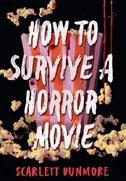
A horror fanatic is forced to put her movie smarts to the test when a killer starts picking off students at her new school.
Charley Sullivan is looking for a fresh start and an escape from her checkered past when she transfers to Harrogate, an all-girls academy located in a former Franciscan monastery on a remote island in the Irish Sea. She quickly bonds with her roommate, Olive, over their shared love of horror films, a connection that proves useful when they stumble across a classmate’s dead body. The body count starts to rise, and all the deaths are ruled suicides. But Charley knows better. The dead students are haunting her, and they won’t rest until she finds their killer. With slasher movie tropes as their guides, Charley and Olive launch their own investigation while trying to avoid
becoming the next victims. Charley and her crew of ghostly tagalongs make for a hilarious, offbeat team. A mix of dark humor, gory kills, and high-stakes action keeps the story moving at a brisk pace. The book doesn’t take itself too seriously while still delivering solid scares. Dunmore keeps readers on edge with a full roster of suspects and a twisty reveal at the end. The main characters present as white, and Charley is queer. Fans of Lily Anderson’s novels are sure to enjoy this debut. Wickedly funny and suspenseful; tailor-made for horror fans.
(Horror. 14-18)
Elizabeth, De | Holiday House (352 pp.) | $19.99 September 23, 2025 | 9780823459384

There’s something in the ocean, and it wants blood. Briar Winters has been haunted all her life—by the drowning death of her twin brother when they were six and by a voice in her head that says she’ll one day join him. It’s almost the end of summer, and soon Briar’s three closest friends— Kai Baisho, Astrid Hoffman, and Finn Adler—will disperse to various colleges, leaving her behind in their hometown of Loch Creek, Massachusetts, where tragedies seem to strike repeatedly. Finn is logical and math-oriented, but he’s nevertheless been researching occult matters that just happen to involve both quantum physics and Loch Creek’s strange happenings. He and Briar are friends, found family, and maybe more? But the day after the summer carnival, Finn vanishes—and only Briar, Kai, and Astrid remember that he ever existed. As Briar’s 19th birthday party approaches, odd events in town, rumors of witches, and her own seemingly pending demise won’t stop her from finding Finn and bringing him back home. Debut author Elizabeth’s narrative is littered with moody purple prose that establishes the melodramatic
atmosphere, perhaps inspired by the Edgar Allan Poe poem “The City in the Sea” that’s quoted at the beginning of each of the book’s six sections. The lead-up to the climax will enthrall readers who are willing to wade through a few confusing detours along the way. The leads present white, and both are bisexual.
Seductive if somewhat overdone. (Horror. 14-18)
Fitzgerald, Bea | Sourcebooks Fire (464 pp.) | $12.99 paper September 2, 2025 | 9781464243080
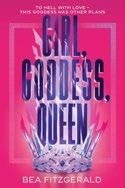
Persephone willingly descends into the Underworld to escape an arranged marriage. This retelling of the Hades and Persephone myth from Greek mythology focuses on Kore, a goddess frustrated from childhood by the trivial role assigned to her: goddess of the flowers and of beauty in nature. Facing an unwanted marriage arranged by her parents, Demeter and Zeus, Kore chooses to escape by throwing herself into the Underworld. There, she uses xenia, the rule of hospitality, to secure her temporary safety, despite Hades’ reluctance. As Kore explores the Underworld, she takes an interest in improving conditions for the dead and begins challenging the established order of Olympus. Her relationship with Hades evolves from wary tolerance to mutual trust; Hades is portrayed as a wounded but kind figure. Kore eventually adopts the name Persephone, claiming her new identity. As Demeter and Zeus come closer to finding Persephone, Persephone and Hades agree to marry to prevent her being forced into a marriage with another god and to protect Hades from the rumor that he’s stolen Persephone against her will. While some readers may find the modern-sounding dialogue
distracting, others will appreciate the banter that gradually builds into a slow-burn romance. Characters like Styx and Tempest provide needed levity and add personality. Overall, Fitzgerald’s debut offers a fresh and appealing reimagining that emphasizes Persephone’s agency in a satisfying way. An entertaining and engaging reinterpretation of a classic myth. (author’s note) (Fantasy. 14-18)
Flip
Fraser, Rebecca | Rhiza Edge (128 pp.)
$11.99 paper | September 9, 2025
9781761112898 | Series: Rhiza Shorts

A new kid in town navigates tragedy and change in this accessible Australian import. High schooler Denim Davies hates living with his dad in a caravan park in the small coastal town of Driftwood. He’d rather be back home in Melbourne, but his mother’s death and his family’s economic hardship have forced his father to seek new opportunities. Only Denim’s new friendship with Mina, a goth girl with a heart of gold, helps him put up with obnoxious class bully Tyler. Outside of school, Denim browses in local secondhand shops to find items he can sell online. By flipping vintage and collectible pieces, he hopes to help his dad afford a permanent home for them. But Denim must figure out what to do when one of his discoveries presents him with a moral dilemma. Realistic, well-written dialogue that includes some Australian slang and bite-size chapters that welcome reluctant readers support Fraser’s exploration of rich and meaningful themes related to family losses, grief, and compassion. The dynamic characters, who largely present white, deal with tragedies maturely, bonding as they metaphorically flip their difficult circumstances into personal growth. Denim admirably navigates
self-management under pressure, and his interactions with his father reflect refreshingly positive male relationships. Overall, this work challenges stereotypical assumptions and promotes hopefulness and empathy. The appealing, open-minded protagonist radiates resilience in a complicated teenage world. A thoughtful, optimistic, and highly engaging novel with a strong sense of place and robust characterization. (Fiction. 12-18)
Gray, Jordan Stephanie | Little, Brown (384 pp.) $19.99 | September 30, 2025 | 9780316588430

A newbie wolf from St. Augustine, Florida, is out for revenge. Vanessa and her best friend, Celeste, are out celebrating Vanessa’s 17th birthday when Celeste is murdered by a werewolf and Vanessa is bitten by another one. After her transformation, a heartbroken and angry Vanessa is presented at the Wolf Queen’s Court, which is ruled by the cunning Queen Sybil of the North American Court. These magical wolves possess powers beyond the ability to change at will between human and wolf bodies. Vanessa turns out to be the first known wolf to have purple eyes, and the queen is very interested in how she can use her powers to the court’s advantage. Even as Vanessa tries to solve the mystery of which wolf is responsible for Celeste’s death, she develops a budding romance with Prince Sinclair Severi, the queen’s son. But his interest in her could be dangerous to Vanessa: His engagement to “mean girl” Princess Evelyn Lee of the Asian Court is in the works, and Vanessa must
determine whether there’s anyone she can trust in the brutal inner circle of the royal court. Debut author Gray’s worldbuilding is layered and intricate, and the action moves at a brisk pace although some of the dialogue is repetitive and stilted. Vanessa’s single-minded vengeance reverberates throughout, and while some of her choices may frustrate readers, the story is utterly enjoyable. Vanessa and Sinclair read white.
An intriguing paranormal thriller. (hierarchy of the seven werewolf courts) (Paranormal. 14-18)
Guron, Ravena | Sourcebooks Fire (448 pp.) | $12.99 paper September 2, 2025 | 9781728296876
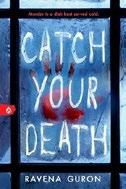
Three teenage girls end up snowed in at an English mansion where a murder takes place—and the killer is one of the few people trapped there. One wintry evening, someone poisons wealthy Emily Vanforte in her ancestral home, the gothic Vanforte mansion on the remote, rural Bramble Estate. The prime suspects include those she shared her final meal with—her politician husband, Charles; her daughter, Lottie; Lottie’s boyfriend, Douglas Treefair; and her nephew, Tate Astur. But a snowstorm stranded three other people under the same roof: Devi Mistry, a 17-year-old Londoner of Indian descent, who was driving to her grandmother’s home; Lizzie Newton-Hill, who was delivering a diamond necklace to Emily on her jewelry store owner mother’s behalf; and housekeeper’s assistant Jayne Faraway, who was instructed by Emily to
tend to the two unexpected overnight visitors. As darkness falls, the three young women, who are acutely aware that Emily’s killer is lurking around the mansion, wander through passageways exploring as they investigate the Vanforte family’s dark secrets. Divided into five parts—“The House,” “The Murder,” “The Truth,” “The Revenge,” and “The Trial”—the narrative alternates among Devi’s, Lizzie’s, and Jayne’s points of view and includes police interview transcripts. The evocative setting and isolated pool of suspects create a classic mystery feeling that’s both cozy and chilling. The shifting timeline and surprise reveals ramp up the suspense. Most characters are cued white. An enthralling and twisty locked-room mystery that will keep readers guessing. (Mystery. 14-18)
Kim, Hyun Sook & Ryan Estrada Illus. by Ryan Estrada | Colors by Amanda Lafrenais | Penguin Workshop (208 pp.)
$24.99 | $17.99 paper | October 7, 2025 9780593521328 | 9780593521335 paper
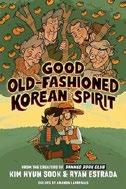
A group of young people in South Korea in 1985 come together for a traditional holiday and learn they have more in common than they knew.
College student Taehee isn’t getting along with her dad. She isn’t allowed to date; he barely even trusts her with her friends. Still, she manages to have a secret boyfriend, Kiwoo, who’s very supportive—even when she brings up the idea of tricking the members of their masked folk dance team into participating in her grandmother’s eerie Daeboreum full-moon holiday ceremony. Taehee’s mom forces her to take part in the old tradition, which involves spending the night at Halmoni’s “haunted persimmon farm”—and facing some sort of sacrifice. The setting is rich and immersive; against a backdrop of everyday interpersonal angst and misunderstandings, the story covers political events, such as protests
against the book-banning military dictatorship. One team member’s father deems the dance club insufficiently manly, there’s a shaman exorcism, and a transracial Korean American adoptee experiences cultural clashes. Daeboreum becomes more than just a tradition about scaring away evil spirits that Taehee’s grandmother and her friends pull the young people into—it’s also a time for found family to persevere and confront past horrors. The colorful, cartoonlike illustration style is attractive but at times feels dissonant with the story’s themes and doesn’t quite do justice to the strengths of this touching book. A hopeful and entertaining exploration of a difficult era. (creators’ note, sketches) (Graphic fiction. 14-18)
Kisner, Logan-Ashley | Delacorte (336 pp.) $19.99 | September 30, 2025 | 9780593814789

After Hunter, a white-presenting transgender boy in the Chicago area, survives a werewolf attack, he and his friends plot to kill the monster that infected him before he loses his humanity.
One night, Hunter runs out into the dark in search of his missing dog; a creature ambushes him, tearing into his arm and leg. His protective best friend, Korean American Gabe, comes to the rescue, fighting off the monster just as he stands up to the bullies who persecute Hunter at school. The bites heal at a supernatural speed, so Hunter doesn’t need medical treatment. But then his period returns in full force for the first time in two years, and his body starts reacting to contact with silver. As Hunter’s body begins to change, he and Gabe join forces with Hunter’s other close friend, Mars (who’s white and Filipino American), to figure out a way to kill the werewolf and cure Hunter before it’s too late. Hunter is a moody protagonist, weighed down by toxic gender norms and internalized transphobia that
cause him to make self-destructive decisions. Along with the imminent threat of the werewolf, bisexual Hunter grapples with emerging romantic feelings for Gabe and Mars and transphobic harassment from his former best friend’s boyfriend. Overall, the conflict and resolution lose emotional impact due to the haphazard construction of the lore around the rules for werewolves, which undermines the characters’ choices. A grim and brooding story weakened by inconsistent worldbuilding. (author’s note) (Horror. 15-18)
Len, Vanessa | Harper/HarperCollins (416 pp.) | $19.99 | August 19, 2025 9780063024748 | Series: Only a Monster, 3

Trapped in a world where monsters have subjugated humans, Joan Chang-Hunt and her friends desperately search for a way to fix the timeline in this third series entry following 2023’s Never a Hero When Eleanor reshaped the timeline, Joan managed to protect herself and a few others from being erased from existence. Joan, Ruth, Nick, Aaron, and Jamie emerge into a twisted version of London where, under the reign of Queen Eleanor, humans must give 50 years of their lives to monsters either in service or by shortening their lifespan to power monsters’ time-travelling ability. While chasing rumors of a human resistance group, Joan uncovers a chilling secret: Eleanor’s timeline is rapidly decaying, and once it’s sufficiently weakened, Eleanor will be able to assume control and establish it as the one true timeline. The narrative leans into the series’ overarching theme of fate versus choice by putting the characters in a position to witness versions of themselves in an alternate reality. Joan, who was previously established as having a Chinese human father and English monster mother, is again torn in loyalty and affection as she finds herself
How does a bestselling fantasy novelist with more than 30 books to her name keep creating new worlds?
BY CHRISTINE GROSS-LOH
JULIE KAGAWA’S PRIMARY source of inspiration for her fantasy novels is a bit unconventional. “I love video games, and a lot of my characters and the weird, surreal landscapes in my books all come from them,” she tells me.
We’re chatting about her new book, Fateless, the first novel in a new trilogy by the bestselling YA author. Seventeen-yearold Sparrow, an orphan and trained thief living in the desert city of Kovass, is tasked with a new assignment that causes her to unwittingly resurrect a terrifying, evil force bent on total destruction. The world of Fateless is indeed as vividly wondrous and immersive as any game, with two suns that converge at Demon Hour, a vast Dust Sea traversed by giant beetles, and a glittering Tapestry of the World that determines one’s fate. The stakes are high—save the world or die trying—and Sparrow and her loyal companions are deeply compelling, not just for the momentous task before them but for the emotional bonds that tie them to one another.
Kagawa is a multitalented creative who, in addition to having a passion for video games and writing more than 30 fantasy novels, used to sell handcrafted miniature dragons on Etsy that were eagerly snapped up by fans and readers. Kirkus spoke with her by Zoom from her home in Versailles, Kentucky. Our conversation has been edited for length and clarity.
You are such a prolific writer—did you always intend to become a novelist?
I’ve just always loved reading and making up stories. But before I became an author, I was a dog trainer.
A dog trainer! Say more. Well, I grew up on a oneacre farm in Hawaii. We had chickens, rabbits, dogs, and cats. I had a horse, and I had goats. There were all these
animals just stuffed into this little farm. Growing up surrounded by animals, I wanted to become a veterinarian. But then I hit high school and discovered that to be a veterinarian, you kind of had to know science and math, which weren’t really my thing. I abandoned that dream, and that’s when I decided I wanted to become a writer.
While I was writing and hoping to get published

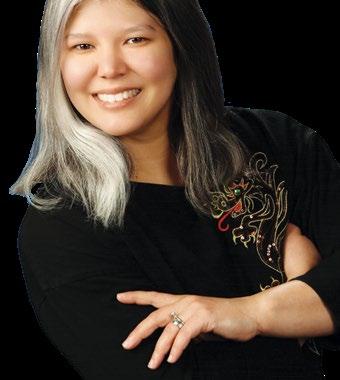
one day, I took on a bunch of placeholder jobs. I worked at a vet’s office, I worked at bookstores for years, and then I started working at a pet store. This pet store needed dog trainers, so I applied to become one because I thought that would be so neat (though if you look at my two dogs now, they’re terribly ill-behaved).
Finally, I got my first book published and stopped training dogs to pursue writing full time.
Reading Fateless, one is instantly transported to the universe you’ve created. Your characters are so alive and appealing and your worlds so rich and vivid. Young adult fantasy seems to be a natural match for you. Fantasy has always been my favorite genre. When I was little, I started with
Where the Wild Things Are.
Then I read all of Madeleine L’Engle’s books and graduated to The Lord of the Rings and the Dragonlance series. I would read anything with a dragon on the cover!
And I’m drawn to teenage protagonists because they’re at an age of discovery. It’s an age of firsts. First taste of freedom, first job, maybe first car, and of course, first love.
What do you draw upon as inspiration for all the worlds, characters, and stories you’ve created throughout your writing career?
Lots of books and lots of movies. Anime, too. But what I keep going back to, over and over, are video games. My favorite video games, like Assassin’s Creed, have inspired many a story of mine. The games that I love all have great
stories as well as great visuals. Fateless, by the way, was inspired by Prince of Persia and Assassin’s Creed.
Are there any large themes in these games that we’d find reflected in your books? What I hope people glean from my stories are the tropes of heroism, selflessness, giving up something for the greater good. Being a hero, being the good guy, standing up to your friends, sacrificing yourself when it needs to be done. All the good tropes like that.
I think the best video games tell a story and are inspirational. My favorite video game of all time is Final Fantasy X. It has this beautiful story running through it, with themes of
sacrifice, love, and courage. The ending was so emotional, with one character sacrificing himself for the greater good of the world, it made me sob. I love an ultimate noble sacrifice, so noble sacrifice is woven into my books as well.
What is a typical workday like for you, and how do you allow for the time and space to come up with new ideas? Have you ever been interested in doing any other sort of writing beyond YA fantasy?
My typical workday is what you see here: me sitting at my desk in my office, just typing away. I set myself a quota of 1,000 words a day, unless I’m up against a tight deadline, and then that
word quota jumps a little bit, but I try to get that 1,000 words a day.
Evenings are my relaxation time, when I’ll play video games and watch anime. Right now I’m not really playing anything but Minecraft, which I’ve played before. In fact, all these video games that I’ve mentioned are ones I’ve done over and over in the past. But they’re still with me. They still inspire me. If I want a quick refresher, I can go on YouTube and look up gameplay. I’ll watch videos of Assassin’s Creed or about the new version that’s coming out soon. That’s a typical day for me.
I do take on side projects, and I also have a folder of ideas. If some idea won’t
leave me alone, I’ll go to that folder and just write it down. Right now, I’m working on a side project that’s just for me. It’s something that inspired me, and I want to get it out. Now, I did that before, and that side project actually became a new series in the end. But as to other genres, I’ve realized, for example, that I can’t do nonfiction. I’ve tried to write nonfiction, and suddenly I have vampires and fairies showing up. So I’ve accepted that I am fully a fantasy author. I have to have fantasy or sci-fi creatures in my writing. No matter what I write, it has to be weird somehow.
I’ve tried to write nonfiction, and suddenly I have vampires and fairies showing up.

Kagawa, Julie
|
pp. | $19.99 July 15, 2025 | 9781335448804
What have been some of your favorite reader responses? It’s always fun when I’m talking to readers and telling them my favorite video games, and then they turn out to be familiar with the games, too. They’ll say, “I could totally see that in this one, how that influenced this book.”
And I’ve been quite pleased with how I’ve ended a few books, like The Iron Queen and Night of the Dragon. I wanted to make people cry, and I achieved it. The best responses I get are when people told me, “Oh my goodness, I sobbed at the end of your book.” That’s what I was hoping for! Your readers are attached to the characters. They’re attached to the story once they cry for your characters. Those characters have now become real to them.
Christine Gross-Loh is the author of Parenting Without Borders and The Path.
drawn to Nick, the hero with whom she shares an unbreakable bond, as well as Aaron, who has chosen to aid and protect her despite his monster family’s influence. A smoldering romance, gripping action sequences, and strategic plot twists will keep pages turning until the end.
An absorbing trilogy closer featuring high stakes and emotions. (Fantasy. 13-18)
Lesperance, Nicole | Putnam (362 pp.)
$19.99 | August 26, 2025 | 9780593856338
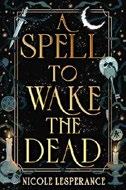
After a spell goes awry, two Cape Cod girls find themselves connected to the spirit of a murdered woman. Mazzy and Nora have practiced witchcraft for years with some success. But one day, during the off-season, everything changes. The friends have different approaches: Mazzy likes “to do things by the book (as in, literal spell books)” and Nora “believes the best magic comes from intuition.” When Nora suggests using a spell from the internet designed to uncover hidden things—she says it’ll bring clarity to their lives—Mazzy agrees, despite her misgivings. Under a full moon, they trek to the beach, where they find the mutilated remains of a woman. Nora feels compelled to discover her identity, but while scrying for answers, Mazzy has a vision of hooded figures conducting a ritual. Soon Nora hears the dead woman whispering to her, pushing her to hurry. The friends start to believe the woman’s death is linked to the Hand of Nephthys, a local cult known for human sacrifices and necromancy. As their investigation deepens, it becomes clear they’re in danger, and Nora’s connection to the dead woman becomes all-consuming, leaving Mazzy to chart her own risky path to the truth before more tragedy strikes. Though the plot is deftly woven with escalating danger, both
white-presenting leads feel as if they exist only to propel the plot and never stand out as fully realized characters. Spiked with spooky, menacing moments but lacking in depth. (Paranormal thriller. 14-18)
Littman, Sarah Darer & Cindy L. Otis Scholastic (352 pp.) | $19.99
August 19, 2025 | 9781339038261
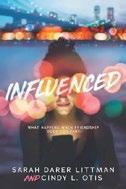
Two 10th graders become entangled in a social media relationship.
Lainey Johnston is reeling from too many changes: Her parents recently divorced; her twin brother, Aidan, is leaving Connecticut to live with their dad in California; her stepmother is pregnant; and her friends are seemingly growing apart from her. Lainey’s anxiety compounds her feelings of being overwhelmed. Fortunately, she finds a supportive friend and confidante online—Elizabeth “Bliss” Batrowny, a TikTok influencer from New York with cerebral palsy. Optimistic and witty, Bliss is confident enough to pursue what she wants, like her school musical’s lead role, Cinderella. But behind the scenes, as her follower numbers skyrocket and paying sponsors come knocking, Bliss feels trapped by objectifying, prying fans, and her financially struggling parents’ strict management of her content. Her experiences vividly illustrate how social media can perpetuate ableist tropes, such as casting disabled people as inspirations or charity cases. When Bliss cracks under the pressure, Lainey rushes to her aid—and everything changes. Lainey’s and Bliss’ alternating firstperson perspectives weave between past and present, building uneasily to a shocking, tension-filled twist. Though somewhat heavy-handed at times, their respective narratives highlight numerous critical issues, including the pitfalls of social media influencing, the psychology of parasocial relationships, disability and
financial concerns, and the complicated aftermath of divorce. Lainey and Bliss are white, and there’s racial diversity among the secondary characters. A gripping cautionary tale.
(authors’ note) (Fiction. 14-18)
Marshall, Brad & Lindsay Hassock | Illus. by Lauriane Bohémier | Magic Cat (96 pp.)
$18.99 | August 26, 2025 | 9781419776984

A comprehensive guide designed to help readers understand and improve their relationship with technology and “make space for joy.”
This engagingly crafted book, written by two psychologists from the Screens & Gaming Disorder Clinic in Sydney, Australia, decodes the mechanisms behind smartphone dependency and offers practical strategies for cultivating a healthy relationship with technology. The authors explain the physiological and psychological feedback loops that shape developing brains and reveal the strategies that tech companies use to manipulate the brain’s reward and warning centers, hooking the user’s attention. Marshall and Hassock divide their material into 10 chapters, each covering one step that’s supported by a toolkit packed with clear questions and advice delivered in digestible, bite-size bullet points. The ideas include tracking time spent on apps, developing emotional regulation skills, and fostering offline connections with friends and family. Infused with warmth and optimism, this approachable, nonjudgmental work blends clinical insights with scientific evidence. Bohémier’s cheerful full-color spot art and background illustrations, which include depictions of racially diverse young people, amplify the friendly tone without undermining its seriousness. This book isn’t anti-technology; it’s a userfriendly guide for teens who are heavily invested in electronic devices and seeking a healthier balance. It will also serve as a
useful resource for adult caregivers who are tackling the challenges of supporting technology-addicted teenagers. Put down your phone and pick up this valuable and accessible read for everyone navigating the digital age. (author’s note, glossary, resources) (Nonfiction. 13-18)
Kirkus Star
McBride, Amber | Feiwel & Friends (224 pp.)
$19.99 | October 14, 2025 | 9781250908087

A 17-year-old guardian of the memories of recently deceased young people questions her purpose in the latest from National Book Award finalist McBride.
The Keepers stay in their Leaving Rooms, ushering Leavers through this liminal space between life and death. Gospel, a Keeper who struggles with following rules, prides herself on providing Leavers with meals made of loving memories and cares for the souls during their precious four minutes with her. Tending to children who have just died, Gospel takes each one’s “best memory,” often involving a meal, and places it in one of the mason jars that line her bookshelves, which are “made from living trees.” Some of the Leavers haunt Gospel, their presences creating lasting memories for her—5-year-old Maple and 8-year-old Suvi, in particular (readers later learn the reason behind their significance). As Gospel struggles with the weight of her role, Melodee, who’s also a Keeper, enters her Leaving Room, breaking another rule. Their connection is instantaneous; “I didn’t know Keepers / could feel love,” Gospel observes—and she wonders whether her existence might hold more meaning. McBride is a master of verse, weaving lines with emotion and character development, articulating pain and hope with an economy of words, and documenting Black lives with
Packed with Black joy, queer love, and feminist defiance.
THE LEAVING ROOM
tenderness. Reverberating with a haunting trauma, this powerful narrative is packed with Black joy, queer love, and feminist defiance. Compelling and evocative: a must-read. (author’s note, playlist) (Verse fiction. 14-18)
Murphy, Cynthia | Delacorte (384 pp.) | $12.99 paper
September 2, 2025 | 9780593805787

Betrayed by her best friend, a young woman at a prestigious British boarding school finds herself at the center of a murder mystery. As they enter their final year at Morton Academy, an elite secondary school founded to provide economically disadvantaged students with a path into the most rarefied circles of higher education, Chloe Roberts is stunned when her friend Nikhita Patel sabotages her bid to become Head Girl. Nikhita also steals Chloe’s boyfriend, Theo, and though Chloe, who’s Deputy Head Girl, is still a member of the secret Jewel and Bone Society, she finds herself adrift. Readers will easily feel sympathy for her plight. Chloe’s new roommates for the 1999-2000 school year, Amari Haddad and Claire Walker, take her under their wings, introducing her to a decadeslong school tradition, The Book of Crime and Punishment : Students write down the name of someone they feel has wronged them, the person’s transgression, and an imagined punishment. Chloe adds Nikhita to the ledger. But when bad things begin happening to people at Morton, Chloe fears there may be more to the book—and possibly to
Nikhita— than she at first imagined. Leaning heavily into boarding school mystery tropes, this whodunit will keep readers guessing, though experienced genre readers may find the ultimate reveal not altogether unexpected. Chloe and Claire are white, Nikhita’s name cues Indian heritage, and Amari has Algerian ancestry. Friend drama expands into something more sinister in this engaging, if somewhat formulaic, thriller. (Thriller. 13-18)
Kirkus Star
Nguyen, Trung Le | Random House Graphic (224 pp.) | $17.99 paper October 7, 2025 | 9781984892669

A teenager struggles to cope in this graphic novel loosely inspired by the Norwegian folktale “East of the Sun and West of the Moon.”
Vietnamese American high school junior Angelica “Jelly” Hoang has had a rough year. Overachieving perfectionist Jelly has burned out and retreated from life. But after she’s awarded an internship at the Log House Theater, Jelly cautiously re-emerges. The theater, a local institution, not only played a seminal role in 7-year-old Jelly’s life when she saw her first performance there, it has also supported her teenage self: Jelly’s been messaging a fan account for Per the Bear Prince, their mascot. What started off as a quick note of appreciation has evolved into open and vulnerable conversations. An internship offers Jelly an opportunity to “feel connected to [her] work again”—and find out who’s behind the bear account, which seems to have
exclusive insider information. Nguyen tenderly explores difficult emotional topics like anxiety and long-lasting grief. The characters and their interactions convey the comfort and acceptance that come from healthy communication and relationships. The delicate, expressive illustrations, executed in a soft color palette, captivatingly capture the heartfelt tone, and design details enhance the storytelling. Elegant picture frames surround panels that show flashbacks, such as of Jelly’s childhood experiences at the theater and memories of her late, beloved grandmother, Bà Ngoại. The supporting cast is diverse in gender identity, race, and body size. Tender, sweetly romantic, and enchanting; an encouraging comingof-age story. (author’s note, sketches) (Graphic fiction. 12-18)
the Stars and Back: Vol. 1
Peglo | Little, Brown Ink (416 pp.) | $21.99 paper September 30, 2025 | 9780316587440 Series: To the Stars and Back, 1
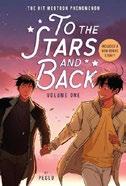
Grumpy meets sunshine in this college slice-of-life romance, originally published on WEBTOON.
Kang Dae has always appreciated his solitude, but when Bo Seon moves into the apartment next door—and into his life—Kang Dae’s quiet existence is immediately disrupted. Bo Seon seems to be made of sweetness and light, and even Kang Dae’s quick temper doesn’t get a rise out of him. Persistently cheery Bo Seon just won’t get the memo that Kang Dae prefers to be alone. There’s a valid explanation for Kang Dae’s antisocial ways, but Bo Seon’s kind and loving nature might just break him out of his shell. As the young men spend more time together, Kang Dae realizes two things: that maybe being alone is overrated and that he may have feelings for Bo Seon. This full-color graphic novel, which features cleanly drawn panels, many borderless or with plain white
backgrounds, follows the young lovers as they navigate college, trauma, mental health, and first love. The storyline includes many funny scenarios that K-drama fans will recognize as classics and heartwarming misunderstandings that feel familiar for the genre. Kang Dae’s journey to accepting his same-sex attraction feels authentic to his character’s arc, and his experience of being taken in by Bo Seon’s friend group is delightful. Hits all the right feel-good notes. (Graphic romance. 15-18)
Smejkal, Kim | Pushkin Children’s Books (272 pp.) | $15.95 paper September 30, 2025 | 9781782695257
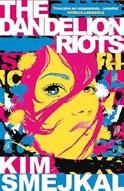
An orphaned teenager who’s imbued with unimaginable power finds community and fights back. Drinn Tryba has spent her life in isolation, moved yearly on her birthday among various carers, overseen by Aunt Melusine, the most powerful of the Aunts, who are “part seer and part witch.” They curse those they perceive as “rotten souls.” Other kids made it clear that Drinn was different, calling her “damned.” She was cursed at birth by Melusine with the seemingly innocuous ability to communicate with the earth. When she’s upset, dandelions sprout from Drinn’s neck, their leaves, stems, and yellow flowers growing behind her ears. But Drinn can do so much more—and when Melusine turns up on her 16th birthday, things turn violent. Drinn flees, guided by a pin cherry sapling through a portal. She finds herself in the eerie, crowded city of Oblison, where she meets a girl named
Story and a boy called Bash. Drinn and Story are drawn into a slow-burn queer romance, but Drinn learns she’s part of a network of girls cursed by the witches and, to her horror, that there are tremendous negative consequences if she ever falls in love. The girls rally together in a terrific display of the power of kindness, unity, and love in all its variety. This narrative is a thrilling ride centering on girls’ and women’s agency. Drinn is cued white, and there’s diversity in skin tone in the cast. A poignant tale of queer love, friendship, and sacrifice. (Fantasy. 14-18)
Ukazu, Ngozi | First Second (320 pp.) $25.99 | $18.99 paper | September 23, 2025 9781250179517 | 9781250179524 paper

After a wish goes wrong, a girl and her crush must figure out how to break a bodyswitching curse. Chi-Chi Ekeh feels invisible. Like her previous crushes, hot varsity swimmer Flip Henderson—yet another rich white boy at her Texas boarding school—seems unaware of her existence. With only weeks until graduation, Nigerian American Chi-Chi’s friends Esther and Yesenia dare her to ask Flip to Senior Festival. But Flip accidentally shows her promposal video to the whole class— and immediately turns her down. Embarrassed, Chi-Chi flees, but her innocent remark—“I just wish Flip Henderson liked me”—has unexpected consequences. After falling and hitting her head, Chi-Chi wakes up in Flip’s body, and he in hers. Freaked out
A thrilling ride centering on girls’ and women’s agency.
THE DANDELION RIOTS
beyond belief and regularly switching bodies, Chi-Chi and Flip work with Esther and Yesenia to break the curse. Meanwhile, forced to see herself through someone else’s eyes, Chi-Chi must confront uncomfortable feelings. There’s much to love about this book. The fully realized and sympathetic characters, sincere and humorous development of friendships, and protagonist’s relatable and bittersweet emotional journey will keep readers engaged, eager to reach the resolution. Ukazu carefully balances tough topics like self-hatred, depression, and suicidal ideation with funny feel-good moments, deftly rendered in her characteristically expressive style. The dynamic and engaging illustrations bring to life a heartwarming story of self-love, acceptance, and true connection. Flipping awesome. (author’s note) (Graphic fiction. 14-18)
Van Draanen, Wendelin | Holiday House (256 pp.) | $19.99 | September 2, 2025 9780823460380
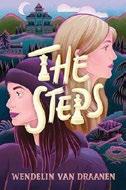
A teen adrift in a sea of loneliness is drawn into a mystery surrounding her dysfunctional family’s fortune. Ruby and her cousin, Sterling, were close until their fathers’ bickering following the death of both their mothers in a car crash created a wall between the girls that neither could cross for fear of triggering paternal wrath. While their fathers (who are brothers) are petty and self-involved, they’re not even the worst that the white-presenting Vossen family has to offer—their grandmother, Oma, plays her family members off against one another and views relationships as transactional, and Ruby’s stepmother and stepsiblings leave much to be desired. Readers will feel a sense of relief when, after a ring of Oma’s that’s worth $3,000,000 is stolen, one of the investigators, Detective Raven
(nicknamed “Nevermore” by Ruby), clearly seems to feel for Ruby and have her back. As the mystery of the stolen ring unwinds in suspenseful increments, Ruby, a skilled chess player, also finds much-needed camaraderie in the school chess club. The members include Izaan, a boy she used to be close to until an awkward dance invitation strained their relationship; through chess, they repair their friendship. She also grows close to Tante Katrina, who was estranged from the family. Plenty of welcome heart is built into this whodunit that imagines a wealthy, backstabbing family that’s so stereotypically horrible that they tip toward the darkly comic.
A fun, twisty mystery with a likeable narrator. (Mystery. 12-18)
Walker, Jessica | Viking (304 pp.) | $19.99 November 4, 2025 | 9780593692677

A 19th-century astronomy textbook connects two isolated teens in this epistolary collection of notes and drawings.
“Copernicus” is grieving their astrophysicist mother’s recent death. Their dad sent them to their grandparents in Green Bank, West Virginia, to complete senior year. A cryptic note their mother left behind leads the San Francisco native to an old textbook in the school library. Since the Green Bank Observatory’s sensitive equipment requires a ban on Wi-Fi in the area, instead of scrolling on their phone, Copernicus spends study hall creating fanciful artwork and writing letters to their mother in the pages of the textbook. After another student leaves a sticky note asking them to stop defacing the book, their exchanges evolve into true dialogue. “Kepler” is only in the school building early each morning, before she’s bussed to a gifted program. While she plans to leave the area for college, she’s proud of her Appalachian roots. The two, who appear white in the illustrations,
ultimately join forces to investigate strange phenomena that occurred when Copernicus’ mother was in high school, referring to themselves and other members of their community through astronomy-related code names. Over the school year, they trade candid exchanges and challenge each other to grow. While their communications are confined to paper, their friendship feels organic and earned. Walker’s clever, eye-catching collages and drawings appear on the pages of a real historical astronomy textbook, incorporating the textbook’s contents in ways that maximize their effect. A wholly original novel that celebrates connection in unlikely places. (Fiction. 13-18)
White, Abby | Levine Querido (344 pp.) $19.99 | August 5, 2025 | 9781646145652
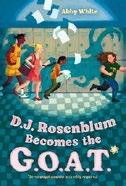
A girl’s death leaves her family reeling with grief. D.J. Rosenblum and her queer single mom (D.J. was conceived via sperm donor) are leaving Indianapolis to move to Briar, Ohio, to live with the Simons: D.J.’s aunt Judy, uncle Jay, and younger cousin, Davey. Fourteen-year-old D.J. used to have an older cousin, Rachel, but she died last year, apparently by suicide. However, D.J. is convinced Rachel was murdered— and she’s determined to find the killer. She’s also supposed to be studying for her upcoming bat mitzvah, postponed due to Rachel’s death. D.J. attempts to balance d’var Torah meetings with Rabbi Flores, Torah chant tutoring with the adorable Jonah Chen, the stresses of middle school, and her ongoing investigation. She makes two friends at her new school who become fellow sleuths—newspaper buddy Char Kumar and gorgeous queen bee Tori Taylor. In this blend of mystery and middle school drama, D.J.’s life is thrown into chaos as she desperately hunts for clues, in the process alienating people and sinking into depression. While a school
newspaper subplot is thinly developed, the engaging, emotionally moving narrative deftly highlights the different ways people navigate the grieving process. The work is steeped in Jewish lifecycle traditions, but readers of all backgrounds will easily identify with the exploration of middle school stresses and friend and family relationships. The core Jewish values of life, learning, and family are well represented and accessible to all readers. A poignant mystery exploring coming-of-age themes. (author’s note, resources) (Mystery. 12-16)
Williams, Jen | Wednesday Books (336 pp.) $21 | September 30, 2025 | 9781250409256

Three lives unexpectedly collide when ruthless gods set them on a course to complete dangerous missions.
Brown-eyed, dark-haired Artair is one of the Sleepless, a monk whose body is occupied by the Other nightly. Black-haired Lucian Prideson, who has skin “the color of cream,” awakens in Artair’s body while the monk sleeps, but his own past remains a mystery. Unsure who he is or why his soul occupies another’s body, Lucian begins to sense a change coming, one that could release him from his captivity. When a mage to the Bloody Claw, a violent god, demands that Artair retrieve a monster from the Jih Forest, which is located in a land controlled by the Queen of Serpents, the monk is forced out of the safety of the monastery and into a world of monsters, both human and otherwise. Elver, a human orphan sacrificed to the Bloody Claw, has been transformed into a monster with poisonous skin by the Queen of Serpents and made to guard the Jih Forest. Ordered to rescue the jih monster that Artair has abducted, Elver, who’s “alarmingly pale,” with white hair and yellow eyes, must leave her familiar forest
and reluctantly reacquaint herself with humans. Elver, Artair, and Lucian navigate complicated relationships as their paths entwine. In this duology opener, award-winner Williams’ rich worldbuilding supports an action-packed fantasy that features original character dynamics and a thoughtful exploration of themes of invisible prisons, lost identity, and belonging.
A complex and riveting tapestry.
(Fantasy. 14-18)
Star
Wilson, Misty | McElderry (352 pp.)
$20.99 | September 2, 2025 9781665975209 | Series: Bramble Falls, 1
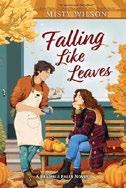
Ellis Mitchell has her whole life planned out. Heading into senior year, Ellis plans to study hard and crush it at the journalism internship her media executive
dad got her, paving the way for her acceptance to Columbia University. But then Ellis’ parents announce they’re separating—and that Ellis and her mom will be heading to Bramble Falls to stay with her aunt and cousin. Furious that her careful plans have been upended, Ellis struggles to settle into the small, charming Connecticut town even as everyone around her gears up for the annual Falling Leaves Festival. Ellis runs into Cooper Barnett—her long-ago summer friend from visits to Aunt Naomi and cousin Sloane—who’s grown up to be very handsome. But Cooper isn’t pleased to see Ellis; he’s cold and curt, and she has no idea why. Wilson’s YA debut is chock-full of charm. Readers will swoon at Cooper’s and Ellis’ developing feelings following their frosty reunion and sympathize with Ellis’ difficulties even as Bramble Falls grows on her. She must choose between small-town community ties and big-city ambitions—between what her dad wants for her and what she
really wants. Ellis’ relationships with her mom, aunt, and cousin are lovely and aspirational. The depiction of Bramble Falls is evocative, and the book contains enough seasonal delights to satisfy even the most devoted pumpkin spice latte lover. Main characters are cued white. A delightfully autumnal smalltown romance buoyed by strong characterization. (Romance. 13-18)
Woolridge, Addie | Delacorte Romance (336 pp.) | $12.99 paper | October 21, 2025 9780593899311
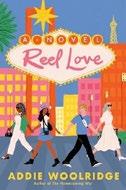
At a glitzy Las Vegas influencer convention, two teens form a secret partnership that could spark chaos on and off camera. Jamie Webb, a “half-Black, half-white” 17-year-old, prefers life behind the scenes of her influencer grandma BamBam’s social media empire. But things get complicated when BamBam’s nemesis, fellow #Granfluencer Buzzy Timmons, shows up with her cute grandson, Ethan Wyatt, who’s cued white. When the TrendCon founder announces a video contest with a $150,000 prize that could launch Jamie’s film school dreams, she’s eager to enter. The catch? She realizes it’s “as much a popularity contest” as about art, and without her own social media presence, she doesn’t stand a chance. Jamie knows she shouldn’t fraternize with the enemy, but Ethan invites her to team up and enter—and sparks fly. They just have to keep their plans secret from their feuding grandmothers. Their covert escapades grow increasingly flirty even as Jamie grapples with her overbearing parents’ expectations that she go to business school and her guilt over keeping secrets from her supportive grandmother. The premise of dueling senior influencers is original and entertaining, and the Vegas backdrop offers opportunities for cinematic flair.
Woolridge deftly balances high-energy hijinks with heartfelt themes of independence and identity. Jamie and Ethan’s chemistry is sweet, and their creative collaboration adds believability to their satisfying relationship. Readers looking for a romance with heart and humor will be thoroughly entertained. (Romance. 13-18)
Yi, Joanne | Atheneum (400 pp.) | $19.99 August 19, 2025 | 9781665972550
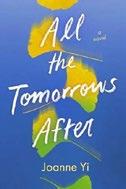
A teenager grapples with the concepts of belonging and loss.
Winter Moon, a 17-year-old Korean American girl, lives with her harsh and self-centered mother and her beloved and caring halmoni; she has only vague memories of the father who abandoned them when she was small. Her grandmother’s love has been the sole nurturing Winter’s known. She’s determined to someday escape her tired Sierra Park, California, life along with Halmoni, and so she works hard, stowing away her meager earnings even as she struggles with her mother’s constant need for money. Everything changes when Winter’s white stepmother suddenly appears on behalf of her father, offering to pay her if only she’ll meet with him. At school, Joon Seo, the new boy from New Jersey, makes her feel seen—like Winter, he craves an elusive sense of acceptance. Amid this emotional turmoil, tragedy strikes. Written in short chapters, the book is a fast-moving and heart-wrenching read. Although a visceral feeling of grief runs through the book, the lucid writing buoys the story, offering glimpses of joyful memories and tender moments as Winter makes sense of her life. Love wrapped up in loss, sharply etched characters, a strong sense of place, and the need to belong— whether with family or friends—makes Yi’s debut an absorbing read. In an
author’s note, she movingly describes her own journey with grief.
A powerful, deftly told story of loss and love that will linger in readers’ hearts. (Fiction. 14-18)
Yu, Catherine | Page Street (288 pp.)
$18.99 | August 26, 2025 | 9798890032331
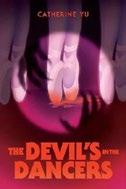
An elite summer dance program holds a deadly secret.
Sixteen-year-old Marianne “Mars” Chang has landed a scholarship to Allegra Academy’s summer program,
an elite ballet intensive that Mars plans to leverage as her ticket out of suburban Clarksville, New Jersey. Her dream is obtaining a full ride to Harvard. Allegra Academy, it turns out, is full of rich girls—really rich girls. Mars’ roommate, Alexandra Bechler, turns out to be a member of the pharmaceuticals family that founded the academy and funds her scholarship. Alex can do whatever she wants, and Mars finds herself caught between jealousy and attraction. As competition for the lead role in the recital escalates, Mars starts to think that something else is going on at the academy, something dangerous and maybe even deadly—and that it involves her roommate. The elite ballet school setting provides opportunities for examining race (Mars is Chinese American), class, and privilege, and provides a backdrop for high-stakes plotlines that parallel the more ordinary dance-world realities of perfectionism and competition. Gory descriptions of injuries come together with dramatic behind-the-curtains plotting to create a tense, foreboding atmosphere with only occasional stumbles as the characters whirl from scene to scene; the author often seems not to trust readers to make connections and instead spells things out unnecessarily.
A lot of scheming and touches of horror unfolding within the intensity of the ballet world. (Thriller. 14-18)
Kirkus Star
Yun, Jihyun | Knopf (400 pp.) | $20.99 October 7, 2025 | 9780593904879

Women in Soojin Han’s family can raise the dead. Korean American Soojin and her sister, Mirae, have typically used their powers to revive roadkill or (on multiple occasions) their family’s beloved pet rat; their mother warned her young daughters against raising humans, citing a tragic example from an ancestor who broke the rules. Seven years ago, Soojin and Mirae’s mother was killed in a car crash, and their bereaved father was emotionally unequipped to handle 10-year-old Soojin and 11-year-old Mirae, leaving parentified Mirae to take care of her sister. But now that Mirae has suddenly died as well in a drowning accident, Soojin decides bringing her back is worth the risk. Soojin is too thrilled to be reunited with her sister to notice the disturbing hints that something isn’t quite right, from the mildewy rot Mirae leaves in her wake to the dark bruises appearing on Soojin’s own skin and the mysterious attacks on some of the town’s powerful residents. In her debut novel, Yun uses foreshadowing and alternating third-person limited perspectives to great effect, slowly unfolding mysteries from Soojin’s mother’s past through poetic, descriptive prose that never feels overwrought. The girls live in the predominantly white coastal tourist town of Jade Acre, which evokes Northern California. Korean language, food, and culture enrich this winning story of sisterhood, self-reflection, and moving on. A beautifully written, grief-filled tale that’s equal parts creepy and heart-wrenching. (Horror. 14-18)

The adaptation of Suzanne Collins’ bestselling novel is expected this fall.
Joseph Zada, Whitney Peak, and Mckenna Grace have joined the cast of the
upcoming film adaptation of Suzanne Collins’ Sunrise on the Reaping, Deadline reports.
Collins’ novel, published in March by Scholastic, is the latest installment in her hugely popular dystopian Hunger Games series, which began in 2008 with The Hunger Games and continued with Catching Fire and Mockingjay. A prequel to the series, The Ballad of Songbirds and Snakes, was published in 2020.

For a review of Sunrise on the Reaping, visit Kirkus online.

Sunrise on the Reaping, another prequel to the original trilogy, has been a runaway bestseller since its March 18 release, selling 1.5 million copies in its first week alone. In a starred review, a critic for Kirkus wrote of the book, “The twists and heartbreaks captivate despite tragic inevitabilities.”
Zada (East of Eden, We Were Liars) will play the role of Haymitch Abernathy, the District 12 tribute played by Woody Harrelson in the earlier films, and Peak (Gossip Girl, Hocus Pocus 2) will play Haymitch’s girlfriend, Lenore Dove Baird. Grace (The Haunting of Hill House, The Handmaid’s Tale) will take the role of Maysilee Donner, another tribute from the district.
The film is being directed by Francis Lawrence, who directed four of the five films based on the Hunger Games novels, and written by Billy Ray (Shattered Glass, Captain Phillips). It is scheduled for release on November 20, 2026.—M.S.


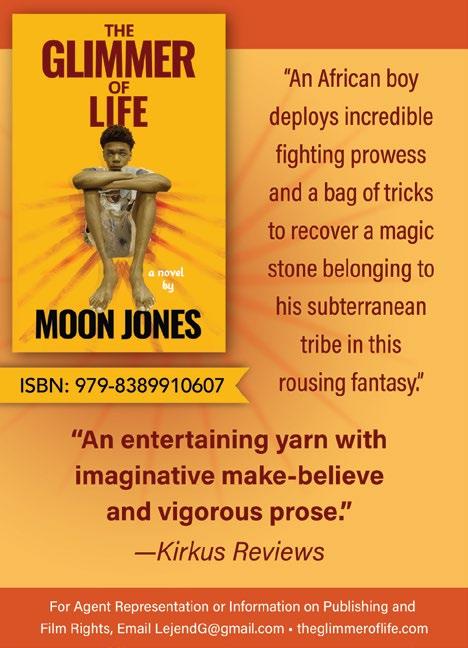
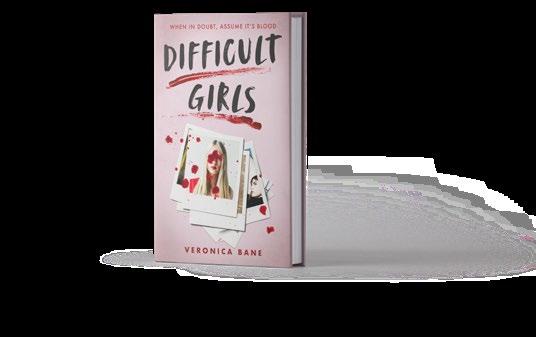




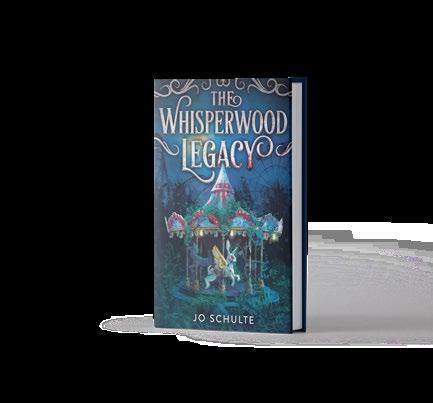

Schulte

Jobs can be fun when they include engaging work, close friendships, and a proper work-life balance, according to this warmhearted business self-helper.
Pushing back on our “shared belief that ‘work sucks,’” Groff, a consultant, argues that work should not be an ordeal of stultifying routine, stressful demands, tense relationships, and endless overwork that robs us of time for our families and souls. Instead, she contends, “most work, most days, should be fun,” with limited work hours, happy collaborations, and the mantra “What work would be the most fun to do?” as the main organizing principle. The author gives managers tips on cultivating fun teamwork: Pay back extra hours worked with extra time off (she
recommends union contracts as an antidote for unreasonable overtime); eschew senseless mandates (“[d]o not under any circumstance ask people to come into an office and then spend the entire time on calls”); hold Do Nothing Days with the team just hanging out and musing on fun ideas; and readjust managerial mindsets. (“As a leader, I’m always trying to maximize the quality of work and minimize the amount of work the team is doing.”) Groff has advice for workers as well, urging them to stop putting work over all other needs, to resist “exceeding expectations” on the job when it depletes them, and to seek jobs that offer a modicum of happiness and room for the joys of life. The author distills her thinking into pithy aphorisms—“shoveling shit is fun if you like your
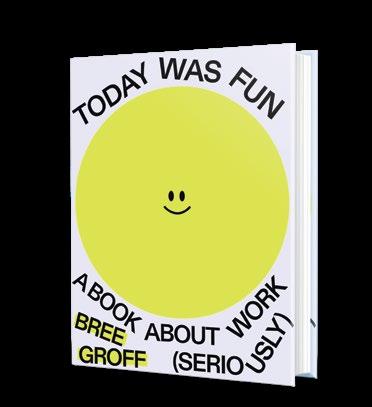
Groff, Bree | Page Two | 246 pp. | $22.95 paper | April 19, 2025 | 9781774585597
co-shovelers”—and tart, humorous sendups of the ethos of self-sacrificing devotion to corporate demands. (“How funny would it be if we expected employers to exceed expectations with their paychecks? Ugh…just the usual two weeks’ pay. I expected more! My company is just not going above and beyond like I hoped.”) Her philosophy of
fun seems tailored to the creative knowledge professions, like consulting; one wonders how it might apply to work at, say, a steel mill or a trauma center. Still, anyone who’s ever had a bad job will find themselves nodding along to Groff’s wisdom. An entertaining and trenchant case for humane workplaces and enjoyable jobs.
Kirkus Star
Mt. Forgotten
Abrams, Kevin Casanova | Self (358 pp.)
$27.99 | June 18, 2025 | 9781647048914
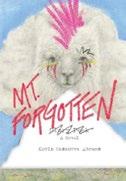
A Pacific Northwest family, founders of a ski resort, struggle with competition and the local Indigenous population in Abrams’ novel.
The Glory Peak Ski Resort is founded in 1966 by Bill Macklemore, a World War II veteran–turned–ski instructor who developed a site near Fortooth into a premier skiing destination (it is said that “Fortooth was one of those towns where reality was far more potent than myth”). His devotion to his business is so allencompassing that his wife, Suzanne, leaves him, taking along their son, Bobby. Fast forward a few decades: Bill is expanding the ski resort, and Bobby is married to a woman named Annabelle. Bobby does not approve of the way Bill is expanding the ski runs, and the local Indigenous Le’Echuwanna people aren’t happy, either. Annabelle and Bobby have a daughter named Clover, who is the company’s presumed heir, but things change when her grandmother, Nanny A, a former professor, strident feminist, and shrewd businesswoman, arrives. Family obligations bring Nanny A to town, but business interests keep her there: She bands together with her daughter’s former lover, Gunther (a German skier and videographer), to take his company Wolfehaus into the stratosphere as Clover’s inheritance (if she even wants it) and the family legacy hang in the balance. Abrams’ small but remarkable cast of characters occupy a world in the Pacific Northwest that is a sight to behold. The towering achievements, business acumen, and grand ambition on display make for an engrossing story about family that is as grounded as it is lofty. All is not perfect at the foot of the mountain, and the difficult
FLASH GORDON: THE GIRL FROM INFINITY
relationships are characterized with compelling emotional detail. Family legacy is key in this novel, but there are some literal cliffhanger moments that keep the story exciting. The narrative is told out of chronological sequence, but the author’s gift for storytelling keeps everything in sync.
An ambitious, earthy novel about family.
Bennett, Marguerite | Illus. by Bev Johnson | papercutz (128 pp.) | $17.99 July 1, 2025 | 9781545818985
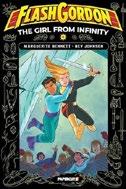
In Bennett’s middlegrade graphic novel, the iconic space adventurer Flash Gordon is reimagined as an amnesiac girl embroiled in revolution on an alien planet.
Dale Arden is the steward of the Ark, a spaceship full of plants, animals, and the (possibly) last human survivors of an uninhabitable Earth (“We had to leave, all of us”). His lonely vigil is interrupted when the ship is struck by an escape pod containing Flash Gordon, a frecklefaced girl with endless curiosity and energy but no memory of her identity. When the Ark crashes on planet Omnia X, the new friends find themselves at odds with the “Merciless Emperor” Prince Azimuth, who dominates the planet’s kingdoms with his rage-powered dark magic. Flash is shocked to discover the tyrant is no older than she is, while Azimuth’s sister, Princess Aura, is even more surprised by the fear her brother has
for their unexpected visitor. Seeking to use this, Aura saves the girl from the gladiatorial arena and takes her to Arboria, a land of rebellious tree-folk and gallant knights led by the honorable Captain Barin. But as the determined Flash readies herself to save Dale and liberate Omnia, she is blind to the princess’s own ambitions and the unsettling reason behind the prince’s fixation on her. Johnson’s illustrations, delightfully influenced by shojo manga, are rich with detailed characters set against simple, colorful storybook-style backgrounds, capturing expressive facial expressions—even during an intense battle with a giant, razor-toothed axolotl. Bennett, who has worked on some of Marvel’s and DC’s biggest properties, displays her talent for inclusive storytelling—this universe is filled with more than just the white and green faces so many space operas feature. The spirit of Alex Raymond’s original creation is here, too; there’s an intoxicating combination of sword-and-sorcery tropes with laser guns and flying saucers. The book never talks down to its audience, and this heartfelt adventure will be great for kids to share with parents, or even for longtime fans looking for a reminder of what made them love Flash Gordon—and comics—in the first place.
A vibrant, inclusive reinvention of Flash Gordon that blends heart, action, and curiosity.

For more Indie content, visit Kirkus online.
Burcat, Joel & David S. Burcat
Milford House Press (281 pp.)
July 1, 2025 | 9798888193297
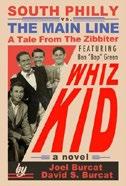
The Burcats’ historical novel follows the exploits of a rabid Phillies fan and aspiring novelist.
In the roughand-tumble
Philadelphia of the mid-1930s, young Benjamin Green is a normal kid whose daydreams of big-league baseball play out on the dusty sandlots of his South Philly neighborhood. At the novel’s opening, Ben is on the mound with his dad watching from home plate, and even though Ben gives up the game-winning hit, his father still surprises him with the best gift Ben could imagine: tickets to the Phillies double-header that day against the infamous Brooklyn Dodgers. Tragically, Ben’s father is killed in a car accident shortly thereafter. The story jumps ahead 15 years to 1950; readers find Ben out of the Navy and married to Debby, a sweet hometown girl pregnant with their first child. They live with Debby’s parents while she works a day job and Ben studies English literature at the University of Pennsylvania. Though Ben dreams of becoming a celebrated novelist—his first manuscript is woven throughout these pages—he is torn between following his dream and more practical concerns. His buddy from college and the Navy, Stan, comes from a fabulously wealthy family who owns an ad agency at which Stan plans to work and where he thinks he can get Ben a job, too. “Look man,” Stan tells Ben, “you need a paying job. Debby’s pregnant, remember? Do you want to be a part-time elevator operator for the rest of your life?” Though the offer is enticing, Ben would have to hide a fundamental part of himself: his Jewish identity. As Ben navigates these competing desires to build a life, his journey is effectively
juxtaposed with the rise of the 1950 Phillies squad, the eponymously nicknamed “Whiz Kids.” Father-andson writing team Joel and the late David Burcat have crafted a novel rich with Philadelphia history and a heavy dose of baseball. Fresh literary ground may not have been broken here, and readers not familiar with the game may not connect as strongly with this work, but baseball fans are sure to hang through to the final out. A fresh, heartfelt take on the American dream and the golden era of the national pastime.
Conway, Kimberly Anne | Dorrance Publishing Company (118 pp.) | $15 paper December 24, 2024 | 9798893410877

Conway looks back at traumatic childhood experiences and discusses moving forward in this intimate memoir.
In her first book, the author reflects on her life, unearthing the motivations underlying patterns of behavior that have exacerbated her lifelong struggles with depression, anxiety, and self-doubt. Conway was born to teenage parents and grew up on a Wisconsin farm in the early 1960s. Two sisters and a brother were born over the next few years and joined the busy household. Horrific childhood events had lifelong effects: At age 6, she was sexually molested by a hired hand on the farm; at a family party, no one listened to her when she tried to alert them that her father’s “around the block” motorcycle ride had gone awry and he was injured; and she felt responsible for a neighboring playmate who was hit by a car after leaving their house. As a result, she felt that she didn’t matter and was not
a deserving person, leading her to focus on helping others at the expense of her own needs. In the author’s late teens, a sexual assault by an uncle, who had a glorified reputation in the family, added self-blame and anger at her own body to her depression. Conway states that she wrote this book “to put my life passengers— depression, anxiety, fear, self‐loathing, and unworthiness—in the trunk of the vehicle. I want to stop letting them steer or be the back seat drivers.” The nonchronological progression of chapters can be confusing, but this reflects her reality of “writing this as a person who struggles with mental illness on a daily basis.” The author’s description of how an incident of unwanted touching that occurred many years after her uncle’s assault sent her “down a rabbit hole [she] hadn’t been in for a while” clearly illustrates how, for a victim of sexual assault, the past is never past. Readers, especially those who have had similar experiences, will find her willingness to describe her progress brave and heartening. A memoir affirming that it is never too late to face childhood trauma and progress to self-acceptance.
Corland, Mai | Entangled: Red Tower Books (512 pp.) | $23.09 | July 15, 2025 | 9781649379153
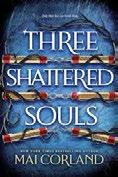
In the final book of Corland’s dark fantasy trilogy, a ragtag band works together to liberate a colony and dethrone tyrants. A group of spies, thieves, and murderers, united by a common goal of ending the treacherous rule of King Joon of Yusan, regroup after a bloody battle claims the life of one of their own—the banished Yusanian prince, Euyn. However, there’s little time for Mikail, Aeri, Sora, and Royo to mourn. Bounty hunters and assassins are after
them, in part because they now possess three of five legendary Relics of the Dragon Lord. Mikail, who’s just found out that he’s the last surviving member of a royal family, wields the Water Scepter of Wei, while Aeri, King Joon’s daughter, holds the Sands of Tim and the Golden Ring of Khitan. The remaining relics—the Flaming Sword of Gaya and the Immortal Crown— remain with King Joon, who’s desperate to have all five to wield a great deal more power. Meanwhile, the cruel Count Seok, who once indentured Sora, has usurped the throne of Yusan. The group has two goals: overthrow the king and liberate the Yusanian colony of Gaya—Mikail’s homeland—so that it can again be a thriving, independent realm. The relics are powerful tools in combat, but using them is adversely affecting Aeri and Mikail’s health. They need allies, but trusting strangers is a dangerous gamble. Corland’s final book in her Broken Blades trilogy is a relentlessly thrilling and action-packed dark fantasy featuring memorable characters, intense battle scenes, romance, and a satisfying conclusion. Alternately narrated by Aeri, Mikail, Sora, Royo, and their long-lost friend, Tiyung, readers benefit from watching the story unfold through the perspectives of each compelling, well-drawn character. The author’s passion for the fantasy genre shines through in the novel’s richly detailed worldbuilding, including vivid descriptions of landscapes and palace layouts, as well as its exploration of magic. Readers will also delight in the sardonic humor sprinkled throughout, as when Mikahil narrates, “Rune thinks he fathered Seok’s son. Truly, the nobility of Yusan has too much time on their hands.”
A compelling and skillfully written end to a thrilling fantasy series.
Dasgupta, Ani | Disruption Books (376 pp.) $29 | September 9, 2025 | 9781633310667
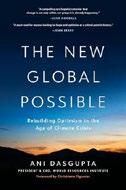
Net zero will require technological innovation, government coordination, urban planning, and steady amelioration of poverty and inequality, according to this far-reaching manifesto on climate policy.
Dasgupta, the president of the World Resources Institute, warns that decarbonization is flagging and urges a systematic transition to a green economy based on several key themes, which he illustrates with concrete examples. New technologies must be created, he asserts, citing WRI’s development of satellite systems to monitor deforestation, a driver of rising emissions. Cities will be “laboratories for change,” Dasgupta forecasts, from rapid-transit bus schemes to crafting “15-minute cities” that provide everything residents need within a 15-minute walk. The author argues that decarbonization must prioritize the needs of Indigenous people, poor communities, the Global South, and displaced workers, and he suggests that rich nations contribute to a climate adaptation fund for developing countries. Dasgupta finally posits that decarbonization can be an economic boon and extols Green New Deal programs like Joe Biden’s Inflation Reduction Act and Walmart’s experiment with stores that lower emissions using LEDs, green rooftops, and auxiliary power supplies, all while improving efficiency and cutting costs.
A richly imagined, lurid love story that’s not for the faint of heart.
ANCILLA
Dasgupta’s treatise is a wide-ranging, ambitious call to action, with many urgent, perhaps impossible, targets. (“To avoid the worst climate impacts, the world must slash emissions 43 percent by 2030…relative to 2019 levels,” he writes—a tall order given that global emissions are still rising.) Fortunately, he makes his case compelling with real-world specifics and stories of leaders who achieved remarkable progress with limited means, like Wangari Maathai, who won a Nobel Prize for her grassroots tree-planting campaign in Kenya. Dasgupta explains it all in straightforward and very readable prose that cuts the wonkery with empathy. (“I understand the helplessness when people ask, ‘Does it really matter if I give up meat?’ or ‘Will switching to an electric vehicle even make a difference?’ And yet the answer is always: Yes, it does matter.”) Readers daunted by the scale of the climate emergency will find much stimulating food for thought here. An incisive, inspiring call to combat climate change.
Drake, Sera Maddox | Staten House (336 pp.) $28.30 | $20.99 paper | January 8, 2024 9798889404323 | 9798889404347 paper
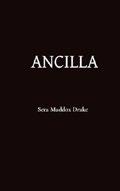
Love is brutal, bloody, and ecstatic in this passionate romance.
This first installment of Drake’s trilogy follows a nameless narrator (she’s often called Ancilla , a Latin word for a female slave) who’s a nerdy, fantasy-gaming, bisexual, red-headed college dropout, disowned by her Catholic parents for her sexual adventurousness and now living in an unnamed rustbelt city. She meets a distinguished librarian twice her age with a taste for occult literature and a BDSM fetish; she dubs him Magister and begs him to make her his submissive. A whirlwind of kink ensues—with informed consent and safe-words carefully established—in
which Magister whips Ancilla with a riding crop, pierces her with needles, cuts her with knives, and performs a traumatic magic ceremony that causes her to black out and dream of the underworld. Ancilla loves the abuse, and the megaton-scale orgasms that follow (“We explode as one, we cry out as one, we burn together and are One”).
Fortunately, Magister isn’t cruel: he’s extravagantly respectful of Ancilla’s desires and insists that she return to college and build an independent life. Unfortunately, her budding dominant side threatens to undo the relationship when he can’t take the kind of pain he’s been dishing out. Drake’s erotic saga is full of graphic sex, detailed BDSM scenarios, and intricate tutorials on occult sex lore (“A lot of it is Thelemic sex magick, with an eye to gnosis through ecstasy and self-perfection, but a good part of the practicum comes from Siberian and Finnish shamanism”). The prose sounds rather academic at times, but at its best it conveys the charged thrill of BDSM and the sense of intimacy and release that flows from Ancilla’s voluntary surrender to sexual torment: “‘I love you,’ I cry, when the third blow lands, burning like fire…. Eventually, the blows stop, and he’s behind me, leaning into me, kissing tears off my cheeks and sweat off my neck.” BDSM afficionados will love it, but normies may find it too much. A richly imagined, lurid love story that’s not for the faint of heart.
Eide, Clark | Self (303 pp.) | $18.95 paper November 6, 2018 | 9781944030063
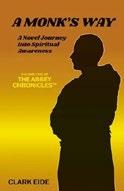
In this novel, a young monk grapples with the complexities of the spirit and the flesh while living in a French monastery. In this first installment of The Abbey Chronicles, readers are introduced to Jean Moreau, who lives as a monk in Kervennec Abbey, a small monastery in modern-day
Brittany, France. In an attempt to “know [him]self—[his] true self,” Moreau dives headfirst into the daily and spiritual rhythms of life at the abbey. He also contemplates some of life’s biggest questions and themes, including humanity’s propensity for judging others (“As exercised by so many organized religions, not just we Catholics, judgment takes an insidious form”) and the presence or lack of “Eternal Life” in the face of death. Intertwined with Moreau’s spiritual reflections are his very human and earthly struggles, including his sexual attraction to a woman he knew at his university. But even as he grapples with temptation in the midst of his desire for spiritual truth, Moreau must weigh his duties and responsibilities when the possibility arises of being bestowed a new position at the abbey. He ends with a promise to continue sharing his personal triumphs and tribulations in a subsequent volume. Eide skillfully imbues Moreau’s voice with warmth and a certain relatability (largely through his nagging sense of self-doubt) that readers will likely admire even if they cannot completely understand the monk’s extreme life path. Despite some of the dialogue being rather clunky in places (“Father, what I am about to reveal to you saddens and embarrasses me considerably”), the calm and unflappable narration easily smooths over any bumps. And while some of Moreau’s observations are quite obvious (popular measures of success, like power, will not “bear the fruit of real contentment”), many others manage to transcend Roman Catholicism (and even Christianity)—such as the very Buddhist-like idea that an individual’s role when emotions arise is to “observe them” and “let them go.” This engaging, memoir-esque spiritual exploration ultimately raises age-old questions in a fresh format. A thoughtful, engrossing rumination on the relationship between organized religion and personal faith.

Flaugher, Janet | Self (137 pp.) | $15.95 paper | March 25, 2025 | 9798308583110

For more Indie content, visit Kirkus online.
A collection of poetry reminiscences about life on a bucolic stretch of farmland. At the outset of Flaugher’s work of prose poetry—termed an “anthem” here—the unnamed protagonist is a young woman who arrives, by virtue of marriage, on a small farm. Totally unaccustomed to the rural lifestyle, she is at first taken aback by the amount of manual labor that she and her husband must undertake to make their new home livable. The duties range from small tasks to the “six inches of manure” that must be cleared from the chicken house, a chore that yields the discovery of a desiccated feline, “frozen forever in a hideous posture of agony or madness. Who can say of what the cat perished, poison, perhaps.” Such experiences with small animals form mostly the entire work. Flaugher’s early chapters center on the eventual menagerie of barn cats with which the protagonist and her husband control the rodent population, with their most notable feline being the aptly named Goliath, a big-headed bruiser who runs the roost on the farm. The couple endure the time-worn difficulties of pet ownership, each bygone friend buried tenderly by the strawberry patch he liked to snack on or the tree beneath which he loved to nap. The cycle of death and rebirth as played out among the farm animals becomes the defining experience of both spouses’ lives and readers’ while consuming the work. In such moments as when the couple’s dog Beau pees on a pal’s leg, readers will understand why the duo goes on to choose the canine and cut the friend out altogether. While the rhythms and realities of Flaugher’s account of farm life eventually become predictable—most of these chapters feel interchangeable—the author displays a deft knack for poetic, lyrical prose that will keep readers going with
its brand of deceptive simplicity. No massive revelations are forthcoming from this book, but readers in search of an honest rendering of American pastoral life will be grateful to have spent their time on the farm. A heartfelt rumination on the touching, often heartrending relationships between farm owners and their pets.
Gogolewski, Mark | OK and More (158 pp.) $19.99 paper | February 18, 2025 9798991873116
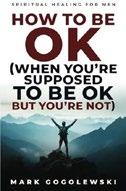
A candid self-help guide offers men a path from feelings of shame to selfacceptance. Entrepreneur, investor, filmmaker, and motivational speaker Gogolewski draws on his own battles with addiction, divorce, and career upheaval to illustrate that the path to well-being isn’t about quick fixes but about aiming simply to be “OK.” In jargon-free prose, he leads readers through embracing the truth of one’s failures, deciding to change, and cultivating lasting compassion for oneself. Overall, it’s a book about deciding to change after recognizing that “life isn’t meant to be only suffering.” Gogolewski urges readers to use their fears as vehicles for change and to try “facing head-on the terrible facts” about their lives—a vital step, he asserts, toward returning to a healthier mental state. Along the way, he weaves in lessons he’s learned from therapists, energy healers, and the personal community that helped him through his most difficult moments, which included his struggle with alcohol addiction, his separation from his wife, and his estrangement from his children. The narrative’s strength lies in its honesty: Gogolewski spares no detail in recounting how his pursuit of external validation—via Silicon Valley career victories and approval from his
father—left him feeling hollow, which adversely affected his personal life. He explains that his own transformation began when he admitted his faults, allowed acceptance to replace selfloathing, and aspired to be “just OK.” His humanistic tone resonates throughout this book, particularly when he recounts how he went through detox four times. Such personal revelations ground the reader in reality and highlight that the healing process is not linear. Exercises throughout the book help to anchor spiritual growth in practical, everyday actions. Although the book’s repetition of core themes (decision versus want, wearing a mask versus embracing one’s true self) may feel insistent, it reinforces the message that authentic progress is ongoing. It reads like a friend counseling you to seek your best self—while tossing around a few swear words along the way. A vulnerable, no-nonsense roadmap that makes a case that aiming for “just OK” can lead to profound change.
Golden, Lamar | Illus. by Liana Golden Self (30 pp.) | $19.99 | April 17, 2025 9781960976635

Two toad pals find the best way to share a hobby together in Lamar Golden and Liana Golden’s picturebook series entry.
Dingo Toad and Penny are best friends who spend all their time together. When they turn 7, they decide that their next adventure will be to join a scout troop so they can indulge their love of nature. However, there’s no local Girl Scouts troop that Penny can join, and Dingo isn’t comfortable enlisting in the Boy Scouts without her. Instead, Dingo finds a third option called the Rangers, a diverse group that allows boys and girls, and includes fantasy creatures. The two friends learn about the Ranger motto, how to earn badges, and embark on their first-ever camping trip. Afterward, Penny is grateful to Dingo
for finding an activity they could pursue together: “I would never do anything without you,” says her friend. In this return to the Dingo Toad series, the authors revisit a pair of characters who exemplify how friends can take care of each other. The narrative feels more like a summary of events, rather than a detailed story, but it presents a clear message about not settling for something unsatisfactory. McGrath’s brightly colored world of vividly illustrated characters shows that some lessons are universal for all creatures. A meaningful tale about the importance of inclusion.
Grieves, Christine | OhG Design (50 pp.) $18 | $10 paper | April 1, 2025 9798992827002 | 9798992827019 paper

Author/illustrator Grieves offers a children’s tale of a dog remembering shared experiences with his absent owner. Otis, who has the appearance of a French bulldog, spends every day with his “best friend”—his human owner, Grace. A calendar page for the month of April reflects their busy schedule and the joy they so obviously find in each other’s company—doing yoga, playing at the park, snuggling, reading, going on walks and picnics, and a host of other activities. Grace is clearly the center of Otis’ world, but, one day, she goes away, and the canine doesn’t know why. Desolate, he drifts around the empty house, missing the fun things that he and Grace would do together, including playing fetch, dancing, having bubble baths, and playing hide and seek. In the forlorn hope that Grace might be playing their hiding game, Otis noses his way into a tote bag: “You can come out now…,” he thinks, dolefully. “Waiting….” However, Grace doesn’t show up; “i still miss you,” Otis concludes, staring out the window. Grieves narrates from Otis’ perspective, writing in a guileless, mostly unpunctuated lowercase,
capturing the simple, unconditional devotion of pets. The text is effectively presented in stark black upon white spaces in two-page spreads. The cartoon illustrations’ color scheme favors soft-inked pastels, and the artwork has a watery aspect, as if to reflect the sadness that Otis is feeling.
The repetition of the dog’s wistful phrase (“i miss…”) emphasizes just how much pets rely on their owners for company. Further lamentations—“it’s no fun without you,” “it’s lonely without you”—give the narrative a mourning quality, which is more poignant due to the fact that readers don’t know whether Grace is gone for good, or just temporarily. The former would be unbearably tragic, of course, but the latter is just as affecting, as it suggests that Otis must feel this way whenever his friend leaves home without him.
A heartrending insight into the inner lives of pets.
Guard, Henry | Self (393 pp.) | $13.95 paper February 8, 2025 | 9798992606508
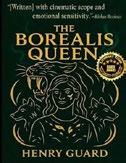
In Guard’s YA fantasy novel, a teenager marked by an ancient prophecy must survive war, captivity, and the wilderness. Nin is a fierce and resourceful girl whose people are slaughtered by Gore and his men; he’s a brutal warlord who senses something dangerous in the pale markings that are etched across her skin. She’s dragged into captivity and branded a threat, and although she endures loss,
isolation, and relentless brutality, she refuses to break. Her connection to the feared Dagger Mouth Demons, and particularly a shadowy beast whom she names Shadow, begins to unlock a deeper truth: She’s tied to an ancient prophecy that speaks of “the Ruler with the skin of shadows” who “will bow to none.” Guard’s world is richly imagined and vividly rendered, with atmospheric detail in every snowy forest, war camp, and mythical confrontation. The book’s emotional power lies in Nin’s unwavering spirit; her trauma is not softened but fully realized, making her transformation into a leader feel earned. Her bond with animals— especially the wolflike Shadow and a rescued dire wolf cub is tender and symbolic, reinforcing themes of loyalty, instinct, and kinship across species: “Perhaps this was how true bonds formed - not through blood or tribe, but through mercy in darkness.” As she forms a pack and finds unexpected allies, her journey builds to legendary proportions, culminating in scenes of visceral battle, moral reckoning, and quiet resilience. The prose is lyrical yet muscular, alternating between action-driven sequences and introspective passages. Some exposition-heavy moments and abrupt perspective shifts may challenge some readers, and the cast is vast, with side players and subplots that sometimes overwhelm the main arc. Still, for readers drawn to survival epics with emotional depth and mythic stakes, this story will resonate. Overall, Guard writes with cinematic scope and emotional sensitivity, offering a hero whose scars become symbols of power. An ambitious and immersive comingof-age survival tale.
Hake, Mary Ann | Elk Lake Publishing (278 pp.) | $17.99 paper | April 29, 2025 9798891343436

Hake’s middlegrade historical novel tells the stories of several generations of a Jewish family, all connected by a remarkable, inherited stone.
In the presentday United States, young Josh Goldberg receives a package from his great-grandfather Samuel. Inside is a “bluish stone,” a family treasure with a dense history. Each successive chapter bounces further back in time, beginning with Samuel in 1930s Germany. Like other Jewish families during the Nazi regime, the Goldbergs face harassment, discrimination, and sometimes violence. Decades and even centuries in the past, Samuel’s ancestors each receive heirlooms: the aforementioned stone, as well as a scroll listing each person who has “safeguarded” the rock. This includes Joel, who celebrates his bar mitzvah in 1710 Poland; Isaiah, who endures a terrifying ordeal with a friend in France in the year 938; and Bartholomew in Jerusalem in the year 98, where he’s born into Roman slavery and lives with his similarly enslaved grandfather. These ancestral families, no matter the time or place, stick by one another as they weather bigotry and harrowing times. Hake’s novel is essentially a set of connected short stories; the main character of each chapter is the grandfather or great-grandfather of the one preceding it. Although there’s more than a hint that the eponymous stone is truly special, the novel’s true essence is its rich sense of history. Characters live through a smallpox outbreak, and through the 17th-century Russo-Polish War; at one point, a “radical young rabbi” stirs up commotion at a Jerusalem temple in 30 B.C.E. The cast, however, doesn’t merely reflect their corresponding eras; they have personal, absorbing stories, involving such elements as a sudden house fire, an agonizing injury, a sister
giving birth, and a Jewish New Year festival celebration. The author’s prose is simple but illustrative (“Surely the Danes would not come this far inland. Big cities like Paris must hold more appeal, and more wealth to plunder”), and it’s sure to appeal to a broad audience. A slow, enlightening journey into a family’s tumultuous past.
Johnston, Christopher | Calumet Editions (220 pp.) | $18.99 paper January 10, 2025 | 9781962834353

A family of fishermen struggles to evolve with the times in Johnston’s debut literary novel. The Brennans of Worland, Minnesota, make their living in two ways. The first is commercial fishing on the Lake of the Woods, where for three generations they have caught walleye and sturgeon using pound nets. The second is mink farming—a complementary business, since a diet of fish is, as patriarch Arthur claims, “low cost and produces lustrous fur” in the minks. In 1960, Arthur’s 21-yearold son, Pete, returns home after his two-year stint in the Army, craving freedom and the open water. Arthur puts him to work on the family fishing boat, but on his very first day, Pete accidentally severs his leg with a cable. Pete fears his whole future has been snatched away from him (“In a matter of days, I’d gone from everything possible to nothing possible”), but his fortunes improve with the arrival of Julia, the lovely nurse who helps him adapt to life with a prosthetic. Pete eventually masters his balance enough to get back on the boat. Arthur’s older son, Wayne, a former hockey player and Air Force vet, has been given control of the mink farm, but his drinking is beginning to cause trouble. When new laws against pound nets threaten their livelihood, both
A
family saga about the passing of a way of life.
WHERE YOU COME FROM IS GONE
Brennan businesses are at risk of capsizing. Into this climate steps the next generation of Brennans in the form of Pete and Julia’s son, Jay, who takes over as narrator from his father about halfway through the novel. When Jay suffers his own fishing boat accident, it seems the family’s fate might finally be sealed.
One gets the sense from Johnston’s plainspoken prose that he intimately knows the setting and the occupations he writes about. Here, Pete shows his sister, Mary, an artist whose marriage to the town’s rival business clan causes interfamily tensions, how to kill a mink: “I shoved the animal headfirst into the shoebox-sized device and held its tail with my right hand. Inside, the animal’s skull was under a steel plate attached to a twelve-inch handle that stuck out the top…A metallic crack bounced off the top of the shed. The animal stopped moving.” The plot’s procession through the decades allows it to nod toward various social changes of the later 20th century (the animal rights movement comes for the mink farm), but in some ways the sweeping time frame works against the book’s dramatic potential—the story ends up being less about the conflicts between its characters than the unsparing passage of time, which comes for all industries and those who work them. When, near the end of the book, a would-be customer asks Pete if he knows where he can get any walleye, Pete replies, with blunt resignation, “I’m the last commercial fisherman on Lake of the Woods and the last walleye fisherman in the United States.” To Johnston’s credit, by the time this line arrives, the reader understands the weight those words carry.
A measured generational family saga about the passing of a way of life.
Kirkus Star
Lam, Porscia | Kind Press (224 pp.) | $25.87 paper | February 25, 2025 | 9781763508323

A mother discusses her son’s dysfunctions and the grueling battle to overcome them in this engrossing memoir. Lam recounts her experiences with her autistic son, Harry, a smart, creative kid with normal-range verbal capabilities who was plagued by severe anxiety, obsessiveness, and a syndrome called Pathological Demand Avoidance, which made him militantly defy every request. Harry violently rejected all dinner-time food except for two specific brands of chicken tenders; refused to wear shoes, then threw fits when his socks got dirty; monopolized Lam’s and her husband Paul’s attention, physically attacking them to end phone calls and Zoom meetings; and required endless hours of ritual cajoling to eat or use the toilet. The demands of caring for Harry, exacerbated by harsh Covid-19 lockdowns in Melbourne, Australia, where they lived, tested Lam’s family to the breaking point; she writes that she “lost the will to live.” But help arrived in the form of “applied behavioral analysis” therapy, a controversial practice that uses painstaking observation of autistic kids’ actions to understand and change behavior—in Harry’s case, by rewarding him with favorite toys and framing lessons as fantasy adventures. Gradually, Harry
added new foods, began tolerating separation from his parents, and— miraculously—started school and made friends. Lam’s prose is evocative and unflinching in conveying the strain of Harry’s condition: “Harry’s desire to control everyone in our household was a source of elemental torment…I despised it, hated it, felt degraded each time I indulged it.” She also provides a fascinating, meticulously detailed psychological analysis of the workings of Harry’s mind: “He was forever observing and taking mental notes, but would not give anything a crack until he was satisfied he could do it with absolute perfection the first time. Then, if he liked it, he did nothing else but that.” The result is a profound and moving family saga that illuminates and richly humanizes the challenges of autism.
An extraordinary portrait of an autistic boy and the fight to help him.
Leparleen, Monique N. & Ann Hendricks Swallow and Quill Literary (286 pp.) | $17.99 paper | February 25, 2025 | 9798992492903
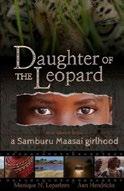
Leparleen and Hendricks document a life caught between cultures in this debut memoir, the first in a series.
Leparleen is a Samburu, a member of the quasi-nomadic, Maa-speaking people who live on the lush highland rim of Kenya’s Great Rift Valley. She grew up in the 1970s and 1980s during an era of transformation in Samburu society, a time when, in the words of co-author Hendricks, “the hammer hit the anvil: when great change came for a culture that had long been seen as, and indeed regarded itself as, unchangeable.”
Leparleen’s father was the first in his clan to receive a modern education, which he parlayed into a position of local wealth and power. Because of this, his
daughters, including the free-spirited and headstrong Leparleen, were sent to school in addition to learning the traditional ways of their people. (“Born with the word ‘why’ in your mouth,” Leparleen’s father said of her when she was a girl. “You’re destined for a beating in this culture.”) Leparleen documents her coming-of-age, which occurred quite early in a culture in which prepubescent sex, forced marriage, and female circumcision are common. In the years covered here, Leparleen’s most pressing problems were an abusive mother, debilitating sickness, and run-ins with Sudanese raiders. The memoir is composed in the third person, which presents Leparleen’s life—and life in her village—in frank, often humorous prose: “It is not possible to adequately describe the role of fashion in Samburu life: it is also not possible to fully illustrate the depth of their relationship with their cattle.” The reader learns much about the “butterfly people,” as the colorfully dressed Samburu are known, as well as the environment inside the traditional Samburu home, the manyatta. Leparleen’s father, who pops in and out of the narrative between “flings” with cars and his studies in America, provides a window into the wider world. Readers will no doubt anxiously await the next volume of Leparleen’s story.
An immersive and informative memoir of a girlhood in Samburu County.
Levitt, Raquel Y. | Acorn Publishing (338 pp.) | $17.99 paper | February 18, 2025 9798885281157

A young woman comes to terms with her psychic abilities and her family’s past in Levitt’s historical novel set in 1890s Missouri. The women in Sarah Richardson’s family all possess the gift of clairvoyance—they can read moods via the color of another person’s “mist” and see into For more Indie content, visit Kirkus online.
others’ pasts and presents. These gifts, and the uncomfortable secrets they reveal, have caused the Richardsons some difficulties. When Sarah’s sister Katherine develops a psychic bond with a woman being abused by her husband, Katherine’s attempt to intervene leads to disaster, and her father sends her to an asylum in St. Louis for her own safety (“Katherine’s pleading eyes were locked on mine as the woman placed the cloth into my sister’s mouth and tied it behind her head”). Years later, Sarah still carries guilt about the role she inadvertently played in the situation and moves to St. Louis hoping to reconcile with her sister. Initially, nothing turns out as Sarah hoped; Katherine rebuffs her, and Sarah develops feelings for a man engaged to a friend of hers. When Sarah encounters a timid woman named Norma, who has a dark mist, she realizes that their fates are intertwined and that she has been given a chance to redeem herself. Sarah is determined to help Norma escape her dangerous husband, no matter the cost. This is a passionate, heartwarming novel that effortlessly imbues its historical setting with elements of magical realism. Sarah goes on an inspiring journey as she tests her character, discovering what she believes in and what she’s willing to fight for. (A prominent thread throughout the story is the bond between women and how much stronger they are when they stand in solidarity with each other.) Moments that could have read as saccharine are conveyed with an honesty and elegance. Levitt draws a clear through-line between women’s political goals and their personal lives as Sarah and Katherine both join the local Women’s Equality Society. The dramatic ending stretches credulity a bit, but it’s emotionally satisfying enough to be forgiven.
An engrossing, touching novel, perfect for lovers of women’s fiction.

London, Mark | Illus. by Karl Mostert
Mad Cave Studios (88 pp.) | $17.99 paper
June 10, 2025 | 9781545816974
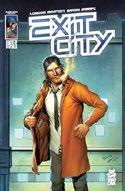
An alternatehistory graphic novel, written by London and illustrated by Mostert, tells the story of an unlikely pair of cops investigating a complicated first case together.
In the 1980s, tech billionaires built Exit City, an “artificial island city-state” in international waters off the coast of California. Its lack of regulation quickly turned it into a hotbed for corruption and unethical experimentation. Curmudgeonly, straitlaced Exit City police Det. McCormick is partnered with loose cannon Eve Miller, much to his dismay; their very first case together is bewildering. The crime scene includes a shredded car with two dead bodies inside, but there’s no CCTV footage to be found—which, to McCormick, makes it feel more like an “operational strike” than a random killing. Miller quickly notices some eccentricities about her new colleague; for example, he talks to his inner coat pocket. She does some digging and learns that he used to be Black Ops; after a mission went wrong, he saved his team members’ neural chips, which lets him converse with their “recorded minds.” As the killing spree continues and bodies pile up—all related to one suspicious building— Miller and McCormick use their expertise to pursue separate threads of the mystery, which reveals a widespread conspiracy. London and Mostert conjure a fast-paced, immersive plot with strong worldbuilding. The narrative explains the complicated inner workings of Exit City and its ultramodern tech succinctly and engagingly, drawing readers in without getting too far into the weeds. The illustration style is well suited to the genre, but some spreads are more effective than others. The images of a killer’s murderous rampage are gory, for instance, but could have used some
adjustment; when a man’s head is ripped apart in a cloud of blood, with eyeballs floating in the air, for example, it lands closer to silly than macabre. Miller and McCormick’s relationship follows a path that will be familiar to anyone who’s seen a cop drama with reluctant partners, but it still feels fresh in the context of the futuristic plot, which ably sets up further installments.
An illustrated SF story with skillful worldbuilding that raises intriguing ethical questions.
MacBride, Michael David | Salty Books Publishing (332 pp.) | $17.95 paper September 9, 2025 | 9781964354033

In MacBride’s novel, a man’s crimes during and after the Second World War cast a long, dark shadow over his family. Vowing to shed the shame of one’s past is one thing; doing so is a very different matter, as Achiel Van Slyck’s family and siblings realize in this complex story of an unhinged man driven by a simple, horrifying motto: “Take all you want. Eat all you take.” It’s a lesson that Achiel learned in World War II–era Belgium, where he was born, and where his disturbing, violent nature found its darkest flowering—first, through various black-market schemes, and ultimately, through rounding up and murdering Jewish people as a German soldier. Given license to do as he pleased, Achiel was untroubled by his choice: “I spoke fluent German, so why not?” he notes at one point. He made an easy transition to
life in the United States after the war, where he shed his Nazi past as easily as a rattlesnake loses its skin. However, his adult children—Sophie, Lucas, Ruby, and Ronnie—find it hard to shake off Achiel’s later murder of a man named Clifford Ellis in 1975. It’s a crime that will leave them buckling under the weight of their own moral compromises, as one character plaintively admits: “I did what Dad told me. Am I going to get into trouble now?” Bit by bit, the story unfolds in a haunting, evocative style, zigzagging with jump-cut logic from their father’s imprisonment in the ’70s to the carefree American 1960s, ’40s-era Belgium, and back again. Readers may find these narrative shifts endearing or irritating, but they’re a feature, not a bug, highlighting how people recall unspeakable crimes in a disjointed fashion. The weight of the tragedy gradually becomes clear via court papers, letters, and even the prayers of Achiel’s wife, Lucia, who finally confesses: “Yes, I can forgive him, but I can’t love him.” Rewards are plentiful for readers who pay sharp attention.
An effective fictional portrait of heinous acts and their consequences.
Moore, Charles | SmallPub (320 pp.) | $25 paper | August 19, 2025 | 9788867496730

Moore interviews 24 artists in 24 hours in this conceptual art book. For this book, art historian and curator Moore staged two dozen interviews with various artists over the course of as many hours, all conducted
An effective fictional portrait of heinous acts and their consequences.
AT THE WAKE
from Miami’s Betsy Hotel. (If that seems like a marathon-level feat, know that Moore is, in his off-hours, a marathon runner.) “Like a puppeteer of dialogues, I had meticulously orchestrated the schedule, balancing time zones, language barriers, and artistic sensibilities,” writes the author in his introduction. It’s an international affair, with artists and curators calling in from London, Beijing, Kyoto, Dubai, Tbilisi, Rio de Janeiro, Milan, Capetown, Bogotà, Berlin, and elsewhere to answer Moore’s questions about inspiration, practice, art-world trends, geopolitics, migration, and what it’s like to care about art in the 2020s. Ceramicist En Iwamura describes what he learned about installations from working with a gardener. Sculptor Miler Lagos discusses the experience of constructing clothes out of paper made from natural plant fibers. Nadya Tolokonnikova, a multidisciplinary artist and member of the performance art group Pussy Riot, muses on the limited, stark color palette she’s used in her work since leaving Russia: “I live in exile. I’m a geographically anonymous person, practically living on the moon, with no home. I think it translates into art and into colors.”
The tone of the interviews gets slightly silly toward the end of the 24-hour period—the sleep-deprived Moore spends part of his interview with the Berlin-based artist Ana Prvački practicing his German—but the questions always lead to intriguing responses by the interview subjects. The time constraint, which necessitates keeping the interviews brief, makes a fun game of the project. Readers will feel as though they are gallery-hopping with Moore across a cosmopolitan city as the conversations build upon one another to create a panoramic portrait of contemporary art.
A free-wheeling and eclectic discussion of creativity.

Nakhle, Djenane | Paradise Palm Publishing (352 pp.) | $14.99 paper December 5, 2024 | 9798990547711

The quest for a sense of home and security takes one woman across four continents in this debut memoir.
In 1951, Djenane Nakhle was 7 years old and living with her parents in Cairo. When the political upheaval of the Cairo Fire erupted in 1952, her father began to question whether the family should leave Egypt. It wouldn’t be until 1962 that the author and her mother followed him to Lausanne, Switzerland. This began a series of moves, taking Nakhle from Switzerland to Lebanon to America to France. Her parents’ plans for her were interrupted by the author meeting and falling in love with Eddy, the older brother of her friend, who swept her off her feet. Her parents had doubts, but Nakhle insisted, at 20 years of age, upon marrying him. The memoir charts the author’s life from her childhood in Cairo across five decades, concluding in 1996 in New York. Early on, she writes, “Our experience as immigrants implanted instability at the core of our beings,” and the short, episodic chapters seem to echo this in their structure as they emphasize the numerous changes Nakhle experienced across her life. With each chapter helpfully labeled with a place and date to enable the reader to follow along, the author recounts her path through a disappointing marriage, another relationship marred by her partner’s self-destructive habits, and the hopeful, joyful birth of her two daughters, Joelle and Sabrina. Her relationship with her daughters, supported by an international network of friends and family, is inspiring, as is Nakhle’s determination to attend school—a journey she began in New York at the age of 37 that eventually led to a career in psychology. Nakhle’s writing is honest, humble, and
empathetic; this is an affecting story about planting roots and making and seizing your own opportunities. An uplifting story of displacement, resilience, and second acts.
Paolantonio, Angela | CreateSpace (300 pp.) | $18.95 paper September 4, 2016 | 9781537410913

Paolantonio recounts her trips to Italy in search of her ancestry and a new life. Born in 1959, the author, the daughter of two first-generation Americans of Italian descent, grew up mostly in Long Island, New York. Her paternal grandfather Nicola first traveled to the United States in 1907 to join his three older brothers there and fell in love with the country so deeply that he enthusiastically pushed his children and grandchildren to thoroughly assimilate; as a result, Paolantonio was raised somewhat disconnected from her Italian heritage. This was a void she looked to fill when she first traveled to his native town of Calitri, an “ancient hilltown” in eastern Campania. She would travel back many times thereafter; delightfully haunted by the “ghostly world of [her] ancestors,” she established relationships with both the paternal and maternal sides of the family. In this sweetly tender remembrance, the author, affectionately nicknamed L’Americana by her family, fell deeply in love with Calitri…and then with Giuseppe Zarrilli, “The Handsome Man from Macchiursi.” She also learned about the secretive life of Angela Maria, her mysterious grandmother, and even bought the home that was once hers in the village, making it and Calitri her own. (“I always felt deep down that someday I would find the spirit of my grandmother. Between my first journey and today there have been several years of discovery in this small mountain
village that I now call home. After buying her house on via Fontana, I had finally found her.”) The author’s rediscovery of her lineage, and the dramatic way in which she embraced it, is related with humor and warmth in endearingly informal, even intimately confessional, prose. The memoir’s tone can veer into the earnestly sentimental (bordering on saccharine), but, in the main, this is an affecting recollection, conveyed with candor and poignancy. A touching memoir that should resonate deeply with anyone yearning to connect with familial roots.
Polcari, B.T. | Wild Rose Press (414 pp.) $22.99 paper | June 23, 2025 | 9781509261420

In this novel, a young sleuth participates in a mystery marathon that feels like a game of Clue, inviting readers to test their skills.
A mysterious package arrives that invites college student Sara Donovan to a gathering at a sumptuous country estate that offers megabucks to the winner of a contest. The nine participants must find and then figure out a series of clues, the victor being the first to do so. For help, Sara has her math genius brother, Matt; her faithful dachshund, Mauzzy; and her best friend, the spirited Zoe Harp. Readers also meet Sara’s boss in her side job as an office/research assistant, Melvin “Finn” Finnegan, a private investigator who is a lot smarter than he lets on, and the very mysterious Sadie Majelski, whose guise as a twinkly older woman hides formidable talents and secrets. Game on. Some participants drop out and at least one is murdered, but Sara and Zoe doggedly press on, cracking both safes and the enigmatic messages they find inside. They finally suss out who is behind the whole thing, an evil genius who is jealous of Sara’s growing
reputation. But the mastermind gives the cops the slip and will remain a lethal adversary. Keep in mind that this is the third installment of a mystery series, so up pops Majelski at the end to hint at unfinished business. Polcari is clearly having a ball here, in what is in most ways typical fare: the likable, if frazzled, hero; her smartmouthed but loyal sidekick; and the nerdy math whiz for backup. The author is a lively writer, as when, after a stressful weekend, Sara rejoices that “Monday finally got off its butt and decided to show up.” There are lots of unnerving, shady characters to speculate about, even better than Colonel Mustard, Professor Plum, and their cohorts. But there is a busyness to the plot (it just keeps shoveling in more clues and twists) that can be overwhelming. The puzzling out of the clues can sometimes seem overdrawn and repetitive, at least for those not into numerology games. But for those who are, this will be grand fun.
An enjoyable, complexly plotted series installment that promises more mysteries and thrills to come.
Poole, Susan | Wild Rose Press (330 pp.)
$20.99 paper | July 28, 2025 | 9781509260515
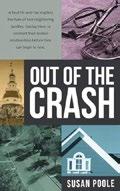
A fatal car accident pits two families against each other and compels both to confront their unresolved emotional issues in Poole’s novel.
Kyle Beasley is an 18-year-old high school senior with a promising future before him—a
spectacular athlete, he has secured a full scholarship to college to play Division One baseball. However, his bright prospects are thrown into doubt by a tragic accident—while driving, he strikes and kills Amy Shawver, the mother of Ethan, one of his schoolmates. In a fit of panic, Kyle flees the scene, but he is quickly arrested and charged with vehicular homicide, a crime for which he could serve considerable prison time. In the aftermath of the accident, the two affected families become adversaries, “kind of like the Hatfields and the McCoys,” and the tension between them spills over into the town at large, now riven by competing loyalties. In this psychologically subtle novel, the crisis pushes both families to wrestle with their own dysfunctions—Ethan’s relationship with his father is fraught with conflict, and he discovers that his mother was once a reckless alcoholic. Meanwhile, Kyle’s parents, Caroline and Jordan, try to repair a marriage left battered after her bout with breast cancer. The portrayal of the accident’s ramifications crackles with emotional power; Poole’s depiction of the split within the Beasley family—between the terror of the prospect of prison time for Kyle and an aching sympathy for the Shawvers—is drawn with artful nuance. One could quibble that the book’s conclusion is too neatly settled, but it never descends into cheap sentimentality. The tale is a rarity in contemporary literature: a novel that revolves around a moral predicament and resists the temptation to issue didactic lessons and simplistic bromides. Here, the author delicately combines terrible loss and a moving hopefulness into one seamless and plausible story.
A haunting story about familial catastrophe.
An enjoyable, complexly plotted series installment.
LUCKY SECRETS
Poppitt, Cara Moeller | Page Two (248 pp.) $19.95 paper | June 17, 2025 | 9781774585580

In this self-help book, choreographer and business coach Poppitt discusses the positive aspects of taking life-changing actions before one feels 100% ready to do so.
Most people have felt stuck at some point in their lives—knowing they should find a new job, leave a broken relationship, or jumpstart their dream career. However, while it’s easy to know what needs to be done, actually doing it can be difficult, as Poppitt points out in these pages. Many feel that they must wait for the perfect moment, yet the author—a successful entrepreneur, accomplished dancer for 20 years, and coach to thousands of fellow dancers and entrepreneurs—argues that “readiness is not a state of being but a feeling that comes after you take action.” In other words, a courageous task must come first, because “you develop confidence through taking action, not before.” She draws on numerous sources, including cited studies and tips from other self-help books, to back up her solid advice. A graphic of her eight-step “Get Unstuck, Cycle of Change Model” appears repeatedly, so that readers can easily follow each step, from “Acknowledge you’re stuck” to “Unlock your confidence” (“Each time you embrace change, your tolerance for it increases, as does your resiliency”). Importantly, the book takes a deep dive into aspects of human nature that, even with the best step-by-step guides, make change difficult, such as feelings of rejection and fear. Her own personal anecdotes are relatable and support every major point, as in a late account of a hike in a storm that taught her the importance of embracing changes in plans. It’s an engaging, fast-paced read, and although
it’s specifically written for an audience of women, all readers can benefit from its message.
A briskly paced guide for those looking to make changes but needing a push to get started.
Salmanowitz, Tina | Self (140 pp.) | $18.99 paper | March 20, 2025 | 9798302410283

A handbook taking a lightly scientific approach to observing nature geared toward inquisitive junior scientists from Salmanowitz. Part of the Little Monsters Universe (a science homeschool curriculum developed by the author, who’s a science teacher), this handbook is a compilation of activity pages and lesson prompts for a general nature education. The book is divided into four parts: nature journaling fundamentals, field sketching, recording scientific information, and a final section called “Putting It All Together.” Part 1 is all introductory activities that are built around using the five senses to learn about the nature in one’s immediate area. Part 2 gives easy-to-read instructions and specifically mentions that when recording nature pictorially, the goal is not to exactly replicate what’s in front of the sketcher. The rest of the journal focuses on recording quality scientific information, and STEM topics are also covered, including how to measure, count, and estimate, as well as other documentation skills. These topics are expertly reinforced by helpful weather charts to fill out before each activity, helping to normalize longitudinal data gathering. The last part encourages the young scientist to connect everything they’ve recorded and reflect on all of their work, likening the end result to a storybook about the natural world. Salmanowitz includes
thoughtful reflection questions rooted in social-emotional learning such as describing how the young scientist feels when observing nature itself or their own scientific illustrations. Included also are clear, concise lessons to give kids: for example, explaining how important drawing to scale is, as well as the importance of spatial awareness, depth, and value. Other well-conceived activities include bark and leaf rubbings, guided writing prompts, and even a lichen hunt. At the end of the handbook is the Green Promise Pledge for Nature, which gives a list of tips to empower the reader to live more sustainably. An expertly crafted science education curriculum developed by an educator for educators.
Scott, Shavaun | Pierian Springs Press (248 pp.) $29 | April 14, 2025 | 9781965784112
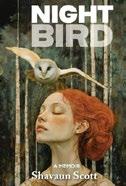
Scott offers a memoir that explores the dynamics and repercussions of suicide and reflects on a history of trauma and troublesome choices.
The author was born in 1958, in the Inland Empire area of California at the edge of the Mojave Desert. She says that her hometown “smelled like exhaust and chorizo. The steel mill and freight trains belched black smoke into the sky.” She was her mother’s fourth child; the first three were almost two decades older than her and lived elsewhere. When Scott was born, her mother returned to work 10 days later and left her with her maternal grandparents. She was a lonely kid, she says, who was teased at school and always felt like she didn’t belong. Years later, she would discover that her family kept many secrets. Inspired by the rigid religious devotion of her Christian grandmother and Aunt Jane, she found comfort in an assortment of churches: At 13, she writes, “[She] regularly attended three different churches each week: a charismatic church on Saturday
An up-to-the-minute thriller that entertains and enlightens.
nights….the youth group at [her] childhood Baptist church on Wednesday evenings; and Sunday mornings at the Pentecostal Assembly of God.” It was at one of the latter gatherings that she met her first husband, who was 10 years older than she was. He told her that God intended for them to marry, and one year later, they tied the knot. Within five weeks, she was pregnant with their first child; they would go on to have two more. Her spouse was the breadwinner, and she settled into their home, determined to be a perfect wife and mother and to create the warm home environment she never had. Eventually, they moved to the lush Central Coast of California. However, her marriage to a cold, controlling, and judgmental man took its toll.
Scott effectively reveals how years of religious indoctrination—which taught her that God sees every sin and that Satan is always lurking—helped to push her into a depression. However, she also shows how she made major changes in her life. The author, who later became a psychotherapist and drug and domestic abuse counselor, begins her memoir with the most dramatically chilling section of the narrative: the moment in 2004 when she entered her house to find her second husband in the dining room, hanging by his neck. He died by suicide, which she saw as a final instance of his ongoing psychological abuse, and she writes of how it left her consumed with guilt. Overall, Scott is a tough and compelling storyteller, with plenty of engaging stories that she shares with sadness, self-effacing humor, and honesty. When she jumps back to her childhood and works her way forward to the opening climactic episode, she effectively draws connections between her early upbringing, her religious traumas, her feelings of unworthiness, and her endurance of her second husband’s behavior—and how her work with survivors of abuse and
addiction gave her a close-up view of red flags that she was unable to identify in her own relationships. A disturbing, poignant, informative, and ultimately triumphant remembrance.
Severin, T.D. | Penmore Press (466 pp.)
$21.50 paper | March 6, 2025 | 9781957851945
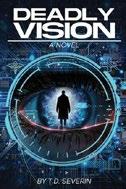
Severin’s debut novel follows a doctor whose cutting-edge research gets him entangled in a conspiracy involving artificial intelligence, an upcoming presidential election, and the use of virtual reality.
San Francisco–based Taylor Abrahms, the lead researcher for the Virtual Heart Project, is preparing to introduce revolutionary advancements in surgical methodology through virtual reality, “a new age” in operative procedure: “Soon, a new breed of doctor will emerge, not in surgical scrubs or white coats, but wearing a virtual reality headset and a sensor suit wired to a supercomputer,” Abrahms says on live TV. However, as he finalizes an upcoming presentation, his own father-in-law—presidential front-runner U.S. Sen. Randolph Henry McIntyre, a Georgia Republican—is preparing to gut the healthcare system, promising to reduce the costs of care nationwide by half. That means putting a moratorium on cutting-edge biotechnology research, such as the VHP, which the senator perceives as wasteful spending. As election day looms, McIntyre and his cronies set out to discredit Abrahms and destroy his groundbreaking advancements at any cost. Thriller fans will be impressed with
the novel’s breakneck pacing and consistently high tension level, as well as its knotty storyline involving the FBI, assassins, and hospital politics. It’s no surprise that the medical setting and terminology feel so authentic, as Severin is a surgeon himself. However, the greatest strength of the book is in the author’s deep character development. Abrahms isn’t merely a cardboard hero with unbreakable ideals—his traumatic childhood, during which he dealt with his mother’s death from heart disease, an alcoholic and abusive father, and his younger brother’s suicide, make him a character that readers will understand, identify with, and root for. The book’s subtle political commentary as it tackles timely issues is a clear plus, as well. An up-to-the-minute thriller that entertains and enlightens.
Sprongl, Ilana J. | FriesenPress (138 pp.)
$34.47 | $19.99 paper | March 31, 2025 9781038330567 | 9781038330550 paper
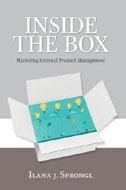
A guide to product management for development within an organization. In this debut business book, Sprongl presents an intermediate-level course in product management aimed at readers who are already familiar with the fundamentals and are focused on overseeing projects that are used within their organizations, like procurement software and financial management tools, rather than those developed for and sold to outside clients. The author outlines key differences between this book’s focus and traditional customerdriven product management. Sprongl then takes readers through the development cycle—identifying internal customers and their needs, developing project objectives, setting priorities, and implementation and evaluation. The author addresses the particular challenges
of navigating organizational politics and balancing the often conflicting needs of different departments using the same tools. Each chapter ends with a series of “points to ponder,” and many include “tales of the product manager,” anonymized examples drawn from Sprongl’s experience that illustrate the relevant topics. The writing in these sections provides the book’s most creative prose (the author describes “a piece of software that was more of a labyrinth than a solution, where users would wander aimlessly, grappling with the Minotaur of confusing features and the Sirens of unnecessary buttons”), adding a touch of whimsy to a generally straightforward text. An appendix provides more details about many of the techniques discussed. Sprongl is clearly knowledgeable and skilled at explaining product management, making the book an effective tool for readers that gets its message across clearly and concisely. The book assumes a level of prior knowledge in its readers without then burying them in jargon, making it an enjoyable as well as informative read. Those who are looking to expand their development leadership skills and raise their internal profiles will find this book a worthwhile resource.
A brief but thorough handbook for developing successful products for organizational use.
Statler, Stephen | Koehler Books (342 pp.)
$29.95 | June 3, 2025 | 9798888247419
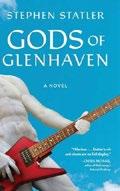
A family’s life is turned upside down when a group of gods moves into their suburban neighborhood in Statler’s comic novel.
High school guidance counselor Christian Orr is having a rough time: After finding out his attorney wife, Sloan Green, cheated on him with his daughter’s swim coach, he’s had to move into what the local teenagers call the “Divorced Dads Apartment Complex.”
On top of that, Christian is struggling
with an ongoing case of impotence, and every day he has to face the swim coach who ruined his life in the hallways at Glenhaven High, where they both work. When Christian welcomes new student Maron and his mom, Ari, he doesn’t think too much of it—even after Ari puts out a cigarette on her arm and the burn seems to disappear before his eyes. With Ari and Maron come other strange occurrences, including rain clouds that appear from nowhere and cheerleaders who suddenly attack football players. Ari’s ex-husband, a man called Dee, turns out to be none other than Dionysus, the Greek god of wine and song. Alternating between the perspectives of Christian, Sloan, and their 17-year-old daughter, Francesca, the story follows the dysfunctional family as they try to figure out why a group of gods has moved into their neighborhood and what they want from the Orrs, all while dealing with their own family drama. Though the novel is largely a comedy, Statler weaves in moments of complexity and heart that allow each character to have depth (“In dark moments, Christian realized that he resented Francesca for growing up”). The short chapters make for an easy read, and while the story starts somewhat slowly, it’s quick to gain momentum and maintain it. Readers be warned: The considerable amount of sexual humor won’t be for everyone, but those willing to get on board are sure to have a good time. A raunchy and fun supernatural comedy with a surprising amount of heart.
Subity, Sam | Scholastic (288 pp.) | $18.99 September 17, 2024 | 9781338885033

Subity’s alternatehistory middlegrade fantasy novel offers a reimagining of World War II’s “Miracle of Dunkirk”—this time with dragons. It’s 1940, and 13-year-old Iris’ small English village used to have a herd
of dragons living in the forest nearby. However, before she was born, humans drove them away, except for one orphan. Iris befriends Galahad, the young dragon who was left behind, bringing him food and trying to teach him how to fly. (“You’re a glorious creature of unmatched beauty and odor,” she jokes.) However, the creature is captured by angry villagers after eating a sheep intended for military rations, and Iris strikes a desperate bargain to save his life: If the British army will spare him, he’ll become a flying messenger for the war effort. Meanwhile, a young Belgian Jewish teenager named Max is forced to flee his village with his grandmother when the Nazis invade. The pair are heading for the Dunkirk evacuation; when they get separated, Max continues to make his way to the coast and runs into a British army regiment in which Iris’ brother is serving. They take Max in and work to harry the oncoming German troops. Iris’ father and the rest of the village’s men take their boats to answer the call to help the evacuation effort, but the girl is determined to get other dragons to help. Later, when Iris finds out her brother hasn’t arrived yet, she heads inland to mount a rescue. Subity’s writing is well suited to a MG audience and maintains a strong sense of narrative tension throughout. Iris and Max are both well-developed characters, and if they’re a little overly earnest at times, it makes sense, given their ages. The alternating third-person perspectives of the two main players work well to move the narrative forward. It’s a bit unclear why, in a world where magic and dragons exist, absolutely nothing else is different from real-life history, but the introduction of such elements into WWII is a fun way to engage young readers with historical content. An adventurous wartime tale that offers a very different version of familiar events.

Sundby, Scott E. | Black Rose Writing (267 pp.) $16.95 paper | January 29, 2025 | 9781685135508

A literary-minded cartel scion hatches a poetry-inspired drug-smuggling scheme in Sundby’s comic debut novel.
Diego Velasquez’s Colombian cocaine empire is on the brink of insolvency—his accountant tells him he has only five or six months left before it all falls apart. Post-9/11 security policies have made it too difficult to smuggle product into the United States, and no amount of bribery can make the border porous again. When Diego shares the news with his two sons, he is surprised that a plan of action comes not from the older, more criminally inclined Carlos—Diego’s anointed heir—but from his younger son, Esteban, the New York–residing grad student who would rather read Romantic poetry than learn the workings of the family business. Esteban’s scheme is to sponsor a conference on the Romantic poets in Colombia—“Wordsworth in Bogotá”—to serve as cover for the most unexpected smuggling operation of all time. For the task, Esteban recruits two unsuspecting colleagues: the distractingly gorgeous Columbia student Moira O’Shaughnessy and the obscure, self-deluding scholar Percy Billings. Unfortunately for Esteban, DEA Northeast Regional Deputy Chief Bronson McArthur Attles has kept a suspicious eye on the young man ever since he arrived in New York, and he’s not so credulous as to take the Wordsworth conference at face value. As professors, cops, and drug dealers descend on Bogotá, the potential for violence is high—and the potential for poetic inspiration even higher. Sundby has a lot of fun with the premise, delivering regular comedic moments, like when Diego struggles to make sense of Coleridge’s “Kubla Khan”: “It had taken four tries, going line by line, and numerous consultations of the dictionary that lay open to his left…The thought crossed his mind of renaming his
compound Xanadu, but he then remembered that one of his hated Medellin rivals had named his complex Xanadu.” The cast of hapless characters and some fun narrative twists make the ride an enjoyable one.
An addictive mashup of campus hijinks and crime-novel tropes.
Anything: . . . Even Pneumonoultramicroscopicsilicovolcanoconiosis: A Guide to Becoming Your Regional Spelling Bee Champion and Qualifying for the Scripps National Spelling Bee
Vukoti, Akash | SmallPub (182 pp.) | $24.31 paper | April 8, 2025 | 9781646871896

Memorize and analyze your way to victory with this no-nonsense guide to spelling bees. Vukoti, a 15-year-old spelling prodigy who made it to the hallowed Scripps National Spelling Bee six times and spelled the titular longest English word on the TV show Little Big Shots, offers tips, tricks, and a systematic approach to spelling exceptionally hard words. He begins with a training regimen based on memorizing the official Words of the Champions list drawn from the half-million entries in the Merriam-Webster Unabridged Dictionary in addition to self-made lists of difficult-to-spell items that, say, begin with silent consonants; he recommends studying at least one hour per day and having parents drill spellers in informal home bees. The book’s heart is a long section on spelling rules and patterns in English—i before e except after c, for example as well as Latin, Greek, French, Maori, and the many other languages that have contributed words to the Merriam-Webster hoard. (Among the challenges bee competitors could face, the author notes, are the Old English fossils fyrd, gesithcundman, and hamsocn, and the German jawbreakers auftaktigkeit, sprachgefühl, and schuetzenfest.) Vukoti
also proffers his list of 206 “roots” that constitute core components of many English words, from able (Latin for “capable of,” as in accountable) to xyl (Greek for “wood,” as in xylophone). He goes on to lay out bee-day strategies on getting over stage fright (“start by taking slow, deliberate breaths”) and asking the eight questions about a word’s dictionary entry that contestants are allowed to pose to judges. (Asking for alternate pronunciations might reveal crucial silent letters, he notes, while asking for the definition can distinguish between homonyms like stationary and stationery.) And should a reader win a regional bee—or the National Bee itself—Vukoti recommends preparing scripted soundbites for the ensuing media hoopla.
Aimed at the younger-than-15 smart and studious reader who is both eligible for the Scripps Bee and serious about it, Vukoti’s book works both as a training manual and as an orthographic study in the translation of sounds into letters. The writing is straightforward, lucid, and practical (“Many words follow straightforward spelling rules, and second-guessing yourself by adding extra letters or using uncommon spelling patterns can steer you in the wrong direction”), but it also has enough erudite insight to allow grown-up linguistics mavens to learn new things as well—in English, Vukoti notes, “when you hear a ‘th’ sound at the end of a word, be very careful as to note whether it ends in th (as in think) or th (as in this). The voiceless th will always be spelled with a -th (wreath, breath, loath) at the end of words, but the voiced th will be spelled with a -the (wreathe, breathe, loathe).” In some grimly lyrical passages, the author’s prose breathes the indomitable spirit of the middle schooler in the arena, a hard-won readiness to fall and then to rise. (“Most people tend to remember their losses for the first few days, the first week, maybe the first month. However, the person who remembers until next year’s bee and has the burning desire to avenge their loss will eventually emerge as the next champion.”) Hardcore spellers will get both know-how and reassurance from Vukoti’s advice. A useful and sometimes inspiring how-to for aspiring bee athletes, full of revealing information and canny tactics.










“ADA TWIST MEETS DEXTER’S LABORATORY” — Booklist
“A WONDERFUL STEM-THEMED ADDITION FOR ALL TWEEN SHELVES.” —School Library Journal
“ENERGETIC . . . BRIGHT AND KINETIC.”
—Publishers Weekly


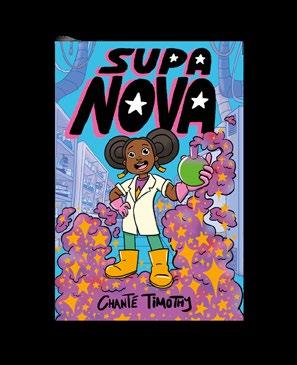


THE DYNAMIC DEBUT GRAPHIC NOVEL BY



